The Wildlife of the Lune Region: A Beginner's Guide
The Wildlife of the Lune Region: A Beginner’s Guide describes a series of outings to explore the
wildlife of the region within the Lune catchment. The ‘beginner’ of the sub-title is me, not you.
A pdf version of The Wildlife of the Lune Region was placed on-line in 2016 but
has been replaced by this html version.
Contents
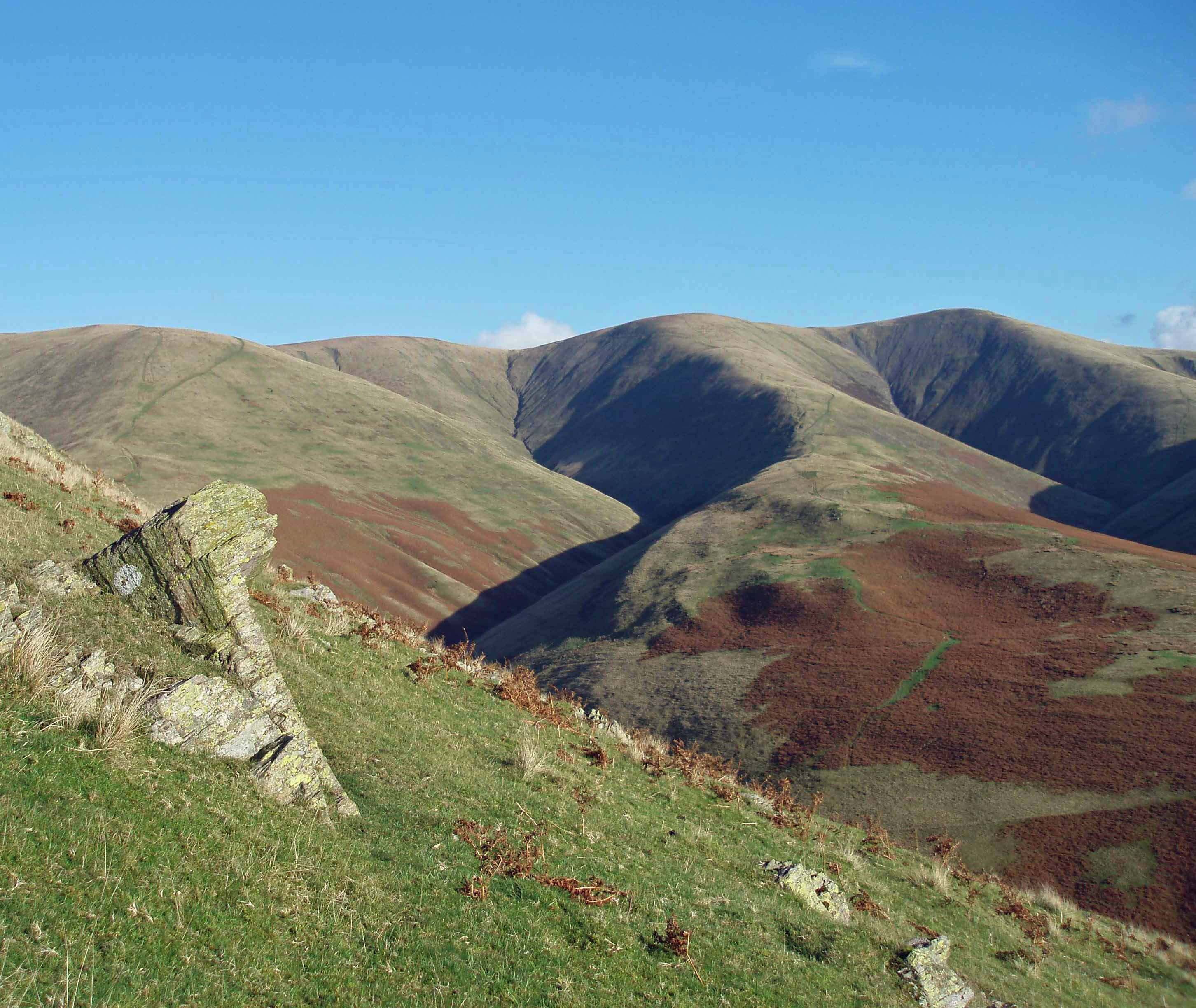 Introduction
Introduction
1. Curlews on Green Bell
2. Snails on Sunbiggin Moor
3. Orchids on Great Asby Scar
4. Trees in Edith’s Wood and Greta Wood
5. Cinnabar Caterpillars near Heysham Moss
6. Marsh Gentian on Keasden Moor
7. Small-Leaved Lime in Aughton Woods
8. Eels in the Wenning
9. Cattle on Fell End Clouds
10. Pink-Footed Geese in the Wyre-Lune Sanctuary
11. Purple Saxifrage on Ingleborough
12. Sand Martins by the Lune
13. Fell Ponies on Roundthwaite Common
14. Cuckoos in Littledale
15. Small Pearl-Bordered Fritillaries on Lawkland Moss
16. Kingfishers by Bull Beck
17. Himalayan-Balsam on the Upper Lune
18. Juniper on Moughton
19. Wolf-Spiders by the Lune
20. Hen-Harriers in Roeburndale
21. Sitka-Spruce in Dentdale
22. Dippers in Barbon Beck
23. Alpacas in Rawtheydale
24. Hares at Winmarleigh Moss
25. Lesser-Black-Backed-Gulls by Wolfhole Crag
26. Red-Deer in Wasdale
27. Buzzards at Wandale Hill
28. Ferns on Leck Fell
29. Yellow-Horned-Poppies at Middleton Sands
30. Badgers in Lawson’s Wood
31. Salmon in the Lune
32. White Stoats on Caton Moor
33. Rhododendron at Kitmere
34. Lapwings on Swarth Fell
35. Belted-Beauty-Moths at Sunderland Point
36. Bluebells on Middleton Fell
37. Swifts on Gragareth
38. White-Clawed-Crayfish and Red-Squirrels around the Upper Lune
39. Red-Grouse at Ward's Stone
40. Wrens in Our Garden
Introduction
The Wildlife of the Lune Region is a sort of sequel to
The Land of the Lune.
The Land of the Lune provided a general review of Loyne, which is
the shorthand I use for the region within the watershed of the River
Lune in northwest England (shown in the map below).
The Wildlife of the Lune Region is focussed more narrowly, as the
title says, upon the wildlife of this region. It is not concerned only
with the wildlife of the River Lune itself. It considers the wildlife of
the rivers, fells, moors, woodlands and valleys of the whole region
within the Lune catchment.
In The Land of the Lune I included topics that I found interesting,
in the hope that any reader would find some of them interesting
too. Consequently, the text flitted between the history, geology,
flora, fauna, people, buildings and so on of the region. This had the
virtue that if a reader was not interested in one particular kind of
topic then they could be assured that another kind would be along
very soon.
A reader of The Wildlife of the Lune Region has no such assurance.
If you are not interested in the flora and fauna of the region then,
apart from the occasional diversions, you will find little relief in
the following pages. However, if you consider yourself relatively
uninterested at the moment then perhaps you will persevere and
become more interested. I was not so interested myself until
recently. Like most people, I appreciated the wildlife that I saw but
did not think too much about it.
As a result of writing The Land of the Lune I became aware that
there were people who had spent a lifetime becoming expert in the
various topics that I glibly skated over. I felt a fraud writing about,
say, the bog bush cricket when I wouldn’t recognise one if it came
up and bit me.
I became involved in the activities of the Lune Rivers Trust, a
group of volunteers with the enthusiasm and expertise to oversee
the ecology of the Lune river system. I was humbled by the little
that my ignorance could contribute.
I therefore embarked upon The Wildlife of the Lune Region not
as an expert but as a newly-enthused amateur. This document is
a description of my attempt to find, understand and learn about
the local wildlife and the conservation issues that arise. It is not a
detailed, technical, academic description of that wildlife. It describes
a learning journey that I am happy to share with any other enthused
amateur that may wish to accompany me.
I began writing these words in 2013. I envisaged slotting the
words into the structure that had served me well in The Land of
the Lune, that is, one based upon an imaginary journey down the
River Lune, interrupted by journeys down its major tributaries. I
embarked upon a series of expeditions, starting at the headwaters of
the Lune, intending to write about the wildlife that I encountered.
However, I soon found that my expeditions should not be based
upon the details of the Lune river system. The seasons dictated
where I needed to be, in order to see what I hoped to see. Also, I
needed to tackle first those elements of the local wildlife that my
ignorance allowed me to.
So, in the winter of 2013 I re-organised the words into a more
straightforward, chronological narrative - or diary, if you will. I
dated those words according to the original expeditions. And
then I resumed the narrative in early 2014, aiming to write about a
suitable wildlife topic every once in a while.
As a result, I hop, seemingly at random, around Loyne. Maps
after twenty sections and at the end of this document
may help you to determine where we are. If more information is
needed on the places themselves then I cannot do better than refer
you to The Land of the Lune!
As will be obvious, the comments and opinions expressed in
this document are mine alone. As always, if any reader has any
comments on or corrections to anything please let me know (at
johnselfdrakkar@gmail.com).
A Note on Pronouns
I hope that the switches between ‘I’ and ‘we’ are not too
disconcerting. The ‘we’ includes my wife Ruth, who joined in
on some expeditions (and encouraged me out of the house for
the others).
Photograph Acknowledgements
In The Land of the Lune I got away with amateur photographs
taken on an ordinary digital camera. The photographs were,
in fact, an afterthought. All that I had written before The Land
of the Lune were academic papers and books, where photographs
were a rarity. It was an eye-opener to me that the photographs in
The Land of the Lune impressed readers much more than the text. It
was also somewhat deflating, as many more hours of labour had
gone into the latter. Clearly the photographs created a reader’s first
impression - and, I suspect, in some cases the only impression.
Therefore in a document on wildlife I must include photographs.
Unfortunately, wildlife photography demands expertise and
equipment that I do not have. Fortunately, there are many fine
photographers keen to share their photos via on-line photo-sharing
systems such as Flickr.
I have in The Wildlife of the Lune Region liberally borrowed (or
stolen) from such sites. I hope that I haven’t violated the spirit of
these open access sites by including their photographs here. If any
photographer should come across any of their photographs here
and disapproves then I will gladly offer them a percentage of the
income from this free publication. If that is insufficient mollification
then I will offer my fullest apologies and remove the offending
photographs forthwith.
The captions of all stolen photographs refer to
the photographers, most of whom have excellent
portfolios of wildlife photographs that can be seen at the web
address indicated. I am very grateful to them all.
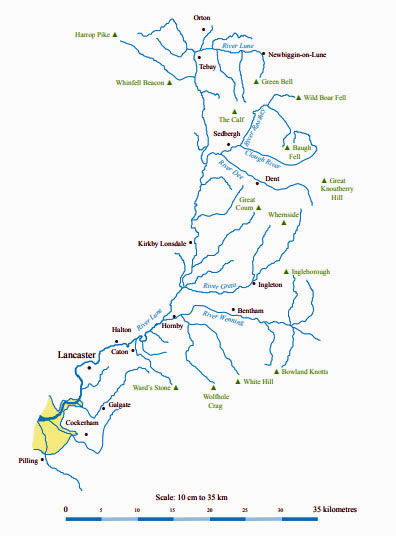
1. Curlews on Green Bell
April 2013
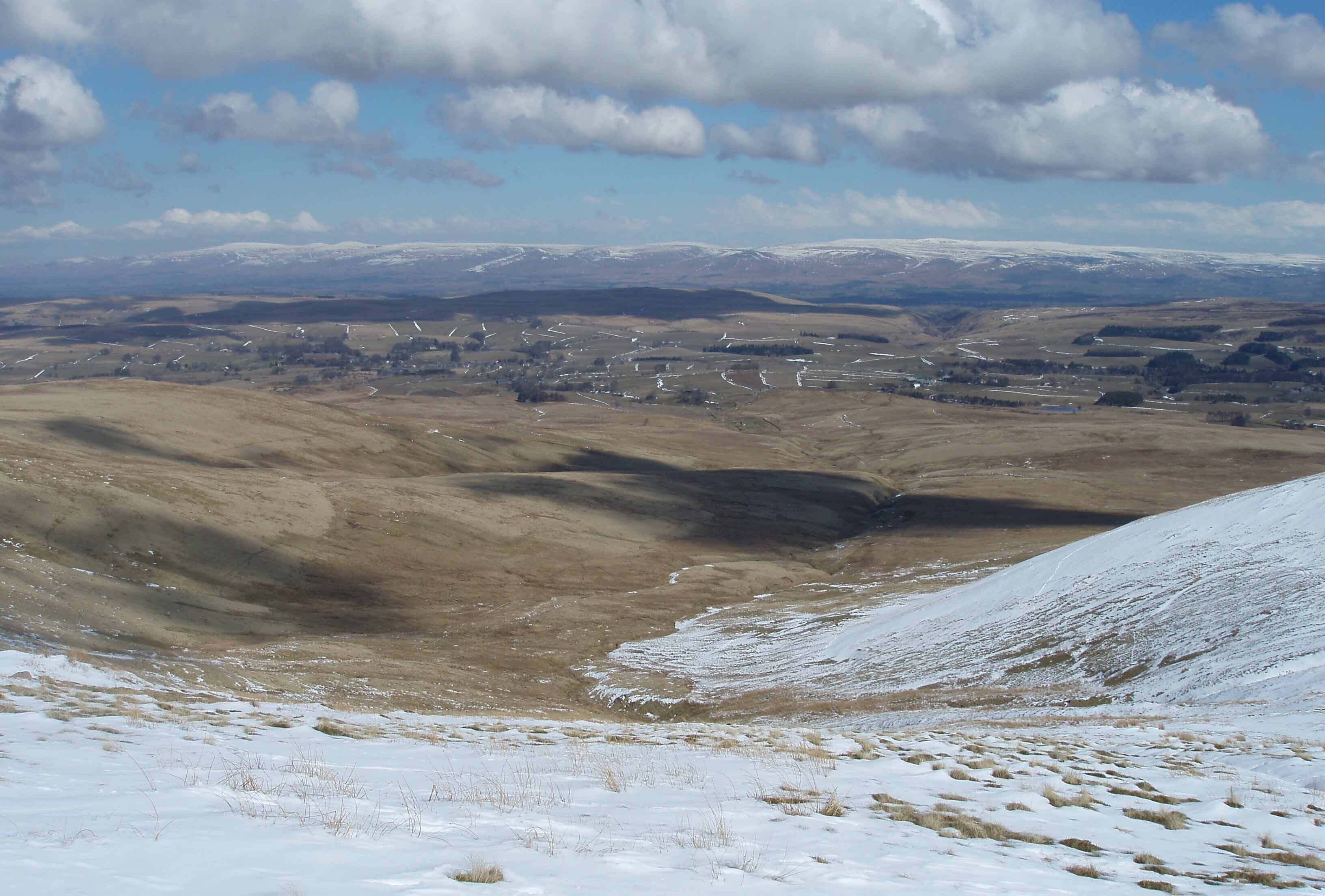 Right: The view from the source of the Lune on Green Bell
Right: The view from the source of the Lune on Green Bell
This was not a promising start. My search for the wildlife of
Loyne began with a view of a vast expanse of dull khaki-coloured moor-grass, enlivened only by the remnants of
recent snowdrifts. No trees, no shrubs, no rivers, no lakes. Nothing,
as far as I could see, but grass.
It was early April, with a bitter easterly blowing. I could hear
nothing but the wind. I stood at the source of the Lune, on the slopes
of Green Bell in the Howgills. Actually, because of the snowdrifts I
couldn’t locate the exact source. I stood in the first dribble of water
emerging from the snowdrift. Before me, I could trace the route of
the beck (Dale Gill), heading for Newbiggin-on-Lune, some three
miles away.
Beyond Newbiggin were the gentle slopes of Crosby Garrett
Fell. On the horizon the snow-covered but normally dark Pennine
hills stretched away from Appleby towards Penrith. Fifteen miles
distant, the bright snowball communication centre on Great Dun
Fell had been rendered inconspicuous.
I would not see much wildlife by looking fifteen miles away.
Looking down to my feet, I saw that I was in fact not standing on
dull moor-grass. I was paddling in a deep-green substance, some
kind of water-cress, perhaps. As I strode downhill, a dark bird,
a snipe perhaps, inconsiderately took flight before I could focus
upon it. In a gully, trying hard to restrain my excitement, I came
upon a small patch of heather and some bright green lichen on
exposed slate - topics that I will leave for another day. And, yes,
the beginnings of a tree, or at least, a shrub. And in the next gully
a veritable copse of trees.
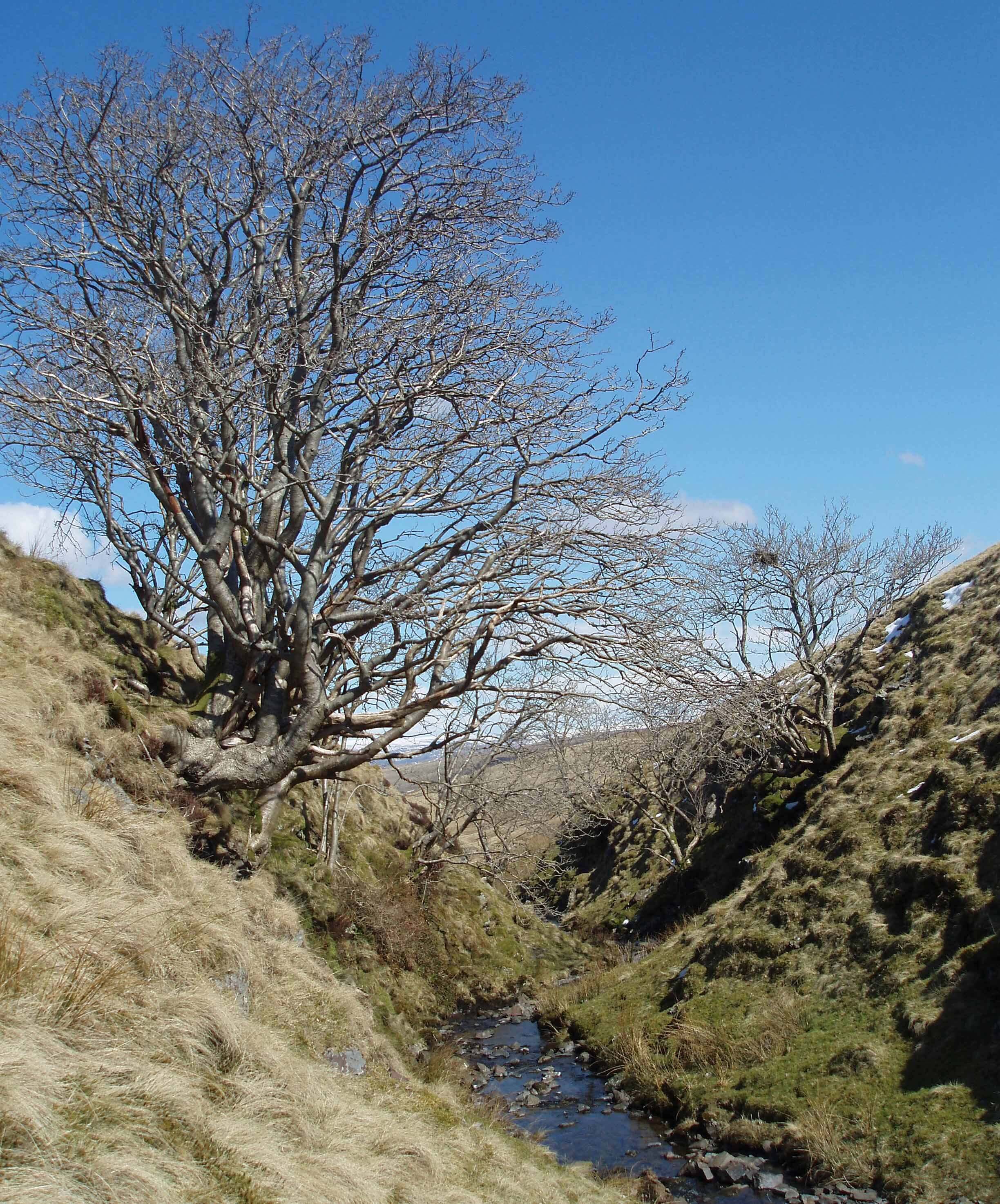 Left: The first trees of Loyne
Left: The first trees of Loyne
If this is to be a worthwhile discussion of Loyne wildlife, I cannot
get away with ‘trees’. I need to be more specific. Unfortunately,
identifying trees without the help of foliage is a new challenge for
me. The dark slate-grey bark with horizontal markings leads me,
with the confidence of ignorance, bravely to assert that the first tree
in Loyne is a rowan.
As is immediately obvious, I am not a wildlife expert. I hope
to become less inexpert during the course of this journey. In the
meantime, I will rely upon the expertise of real and virtual friends
to put me right.
As I walked on past High
Greenside I heard a sound that
even I could not mistake: the
song of the curlew Numenius
arquata [1].
Two curlews glided
over the moor, with exquisite,
flowing notes, an exuberant
trill, yet with a touch of
melancholy.
They had returned to their
nesting haunts after wintering
in tidal waters, which is
quite a bold expedition to
have made already after this
protracted cold winter. They
nest in a scrape upon the
ground, producing young of
a surprising cuteness. The
chicks are mottled, to escape
observation, and have a short
beak that does not hint at the
curved 6-inches of the adult
curlew beak. The parents
tend to position themselves
between the chicks and an
approaching human, which
gives a good clue as to where
to spot the chicks. The parents
and young do not linger on the
moor once the latter are able to
make their way to the shore.
 Right: A curlew chick (Andrew Martin)
Right: A curlew chick (Andrew Martin)
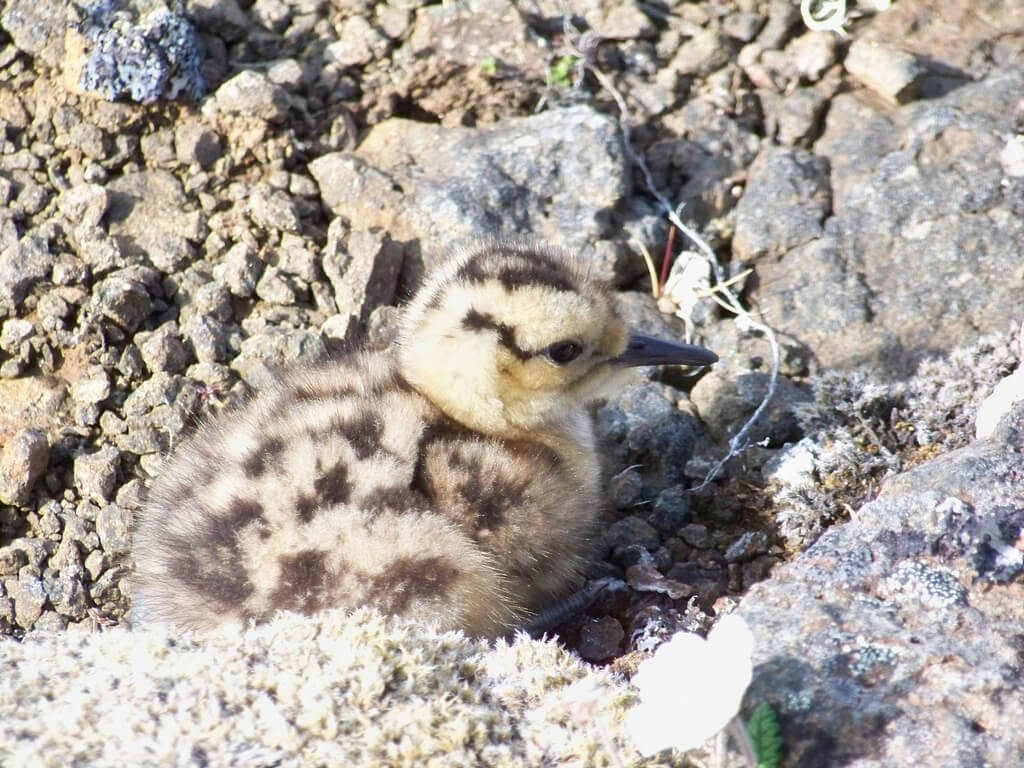
Far right: A curlew in flight (Thomas Heaton)
The curlew is Europe’s
largest wading bird, although there is not much for it to wade in
on this moor. It is some 55 centimetres in length and stands high
on long grey legs. It is, however, more familiar in flight, when its
evocative song draws the eye towards it. Sadly, its numbers are
declining sufficiently to make it an ‘Amber bird’ on the Green,
Amber and Red Lists.
These lists have been devised by the UK’s leading bird
conservation organisations.
In 2009 246 species were assessed
against a set of objective criteria to place each on one of three
lists – Green, Amber and Red – indicating an increasing level of
conservation concern. There are 68 species on the Green List,
126 on the Amber List and 52 on the Red List. Red is the highest
conservation priority, with species needing urgent action, with
Amber being the next most critical group.
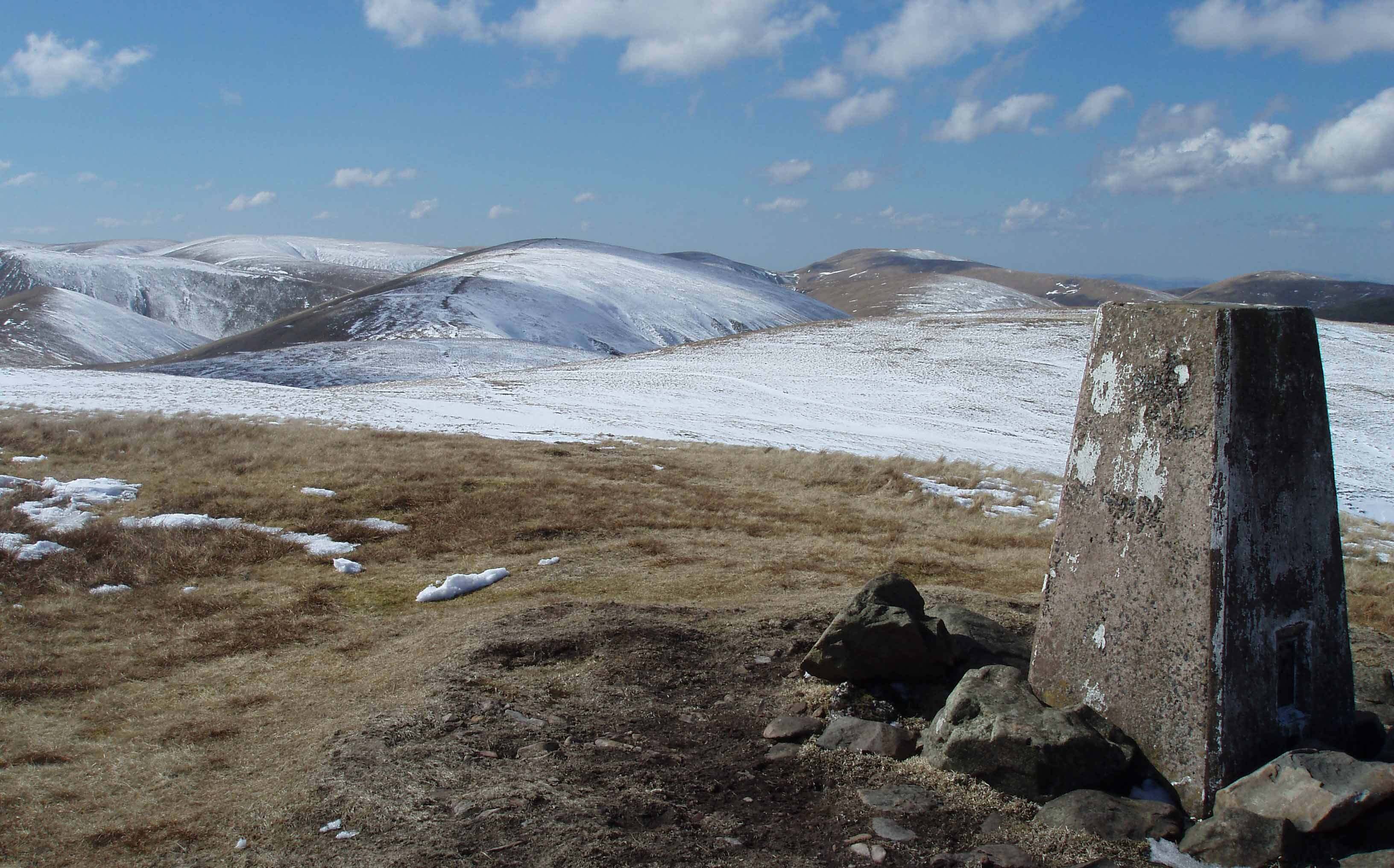 Left: The Green Bell trig point, looking towards Randygill Top
Left: The Green Bell trig point, looking towards Randygill Top
Red List birds are defined to be globally threatened or suffering
from a severe (at least 50%) decline in UK breeding population
or breeding range over the last 25 years or a longer-term period.
Otherwise, if the species:
• has poor conservation status in Europe;
• or its population has declined during 1800–1995 but is now
recovering;
• or its UK breeding population or range or non-breeding
population has moderately declined (25-49%);
• or it is localised (most of its UK population is in 10 or fewer
sites);
• or it is a rare breeder (1–300 breeding pairs in the UK);
• or it is a rare non-breeder (less than 900 individuals);
• or it is internationally important (at least 20% of the European
population in the UK)
then it is on the Amber List. Species that occur regularly in the UK
but do not qualify under any of the above criteria are on the Green
List.
Since 2009 the curlew has continued to decline, so much so
that it seems to warrant transfer to the Red list. Its UK breeding
population declined by about 60% between 1970 and 2010,
including 44% just from 1995. Its alarming decline internationally
led to the announcement of an International Conservation Plan in
2013. It is now considered ‘globally near threatened’ by the IUCN
(International Union for Conservation of Nature).
However, officially, at the moment the curlew is an Amber bird,
which at least I now know does not mean that it is an amber bird.
My initial foray has helped me to realise that not all wildlife will
be as visible and as easily identifiable as the curlew. I will need to
curb my normal purposeful march through the countryside. I must
pause, look and listen. I will need binoculars and a magnifying
glass. I will need guidebooks to help me identify the birds, plants,
beetles, lichen, trees, and so on. I cannot rely on serendipity. I
will need to prepare my expeditions, to help me anticipate what to
look for and where. I should read all I can to help me understand
whatever I am able to see of the wildlife of Loyne.
So, with a slightly better appreciation of the task ahead of me, I
continue on my way.
[1]. I give the Latin scientific names in order to provide a veneer of
academicism (but only if I write a paragraph or more about the
species, otherwise the text will be cluttered with the things). I only
give the scientific name once, on the first significant mention of the
species.
[2]. http://www.rspb.org.uk/wildlife/birdguide/status_explained.aspx.
2. Snails on Sunbiggin Moor
June 2013
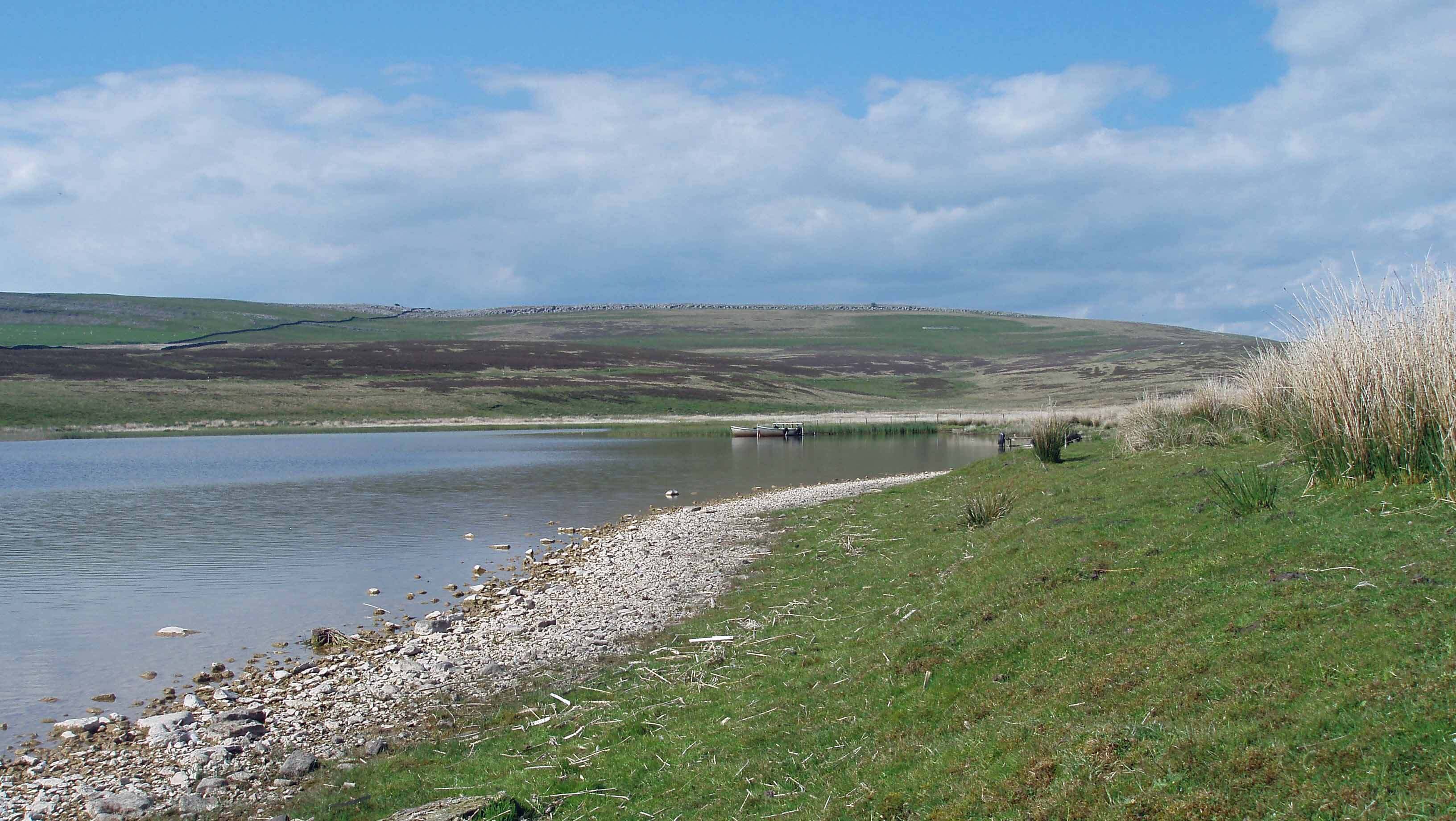 Right: Sunbiggin Tarn
Right: Sunbiggin Tarn
As the Lune heads west from Newbiggin-on-Lune towards
Tebay it passes to the south of limestone scars. Rais Beck
arises below Little Asby Scar and meanders via Rayseat
Sike and from Sunbiggin Tarn, occasionally disappearing through
the limestone, to reach the Lune near Raisgill Hall. The upland
tarn lies at 250m in a hollow between the scars and the Kelleth
Rigg ridge above the north bank of the Lune. The region around
Sunbiggin Tarn is a Site of Special Scientific Interest (SSSI), which
sounds promising.
What interests scientists may not interest me, so let me consult
its citation,
that is, the official reasons given for granting SSSI status
to Sunbiggin Moor.
There seem to be three main reasons.
First, as can be readily appreciated even by me, a variety of
habitats is to be found within this small region. The limestone
scars give rise to calcareous soil, that is, soil that contains calcium
carbonate and hence is relatively alkaline. Around Sunbiggin
Tarn, the wetlands and heather-dominated fen include areas of
acidic mire. Therefore flora and fauna characteristic of the different
habitats may be found unusually side-by-side.
Secondly, the habitat’s distinctive
natures support various rare species.
Specifically, according to the citation,
the area around the tarn is the
only location in the British Isles for
Geyer’s whorl snail Vertigo geyeri.
Local literature repeats this claim, as
indeed did I in The Land of the Lune.
However, I am doing my research
a little more thoroughly now and
I have read elsewhere that recent surveys
have recorded the snail at
thirty locations in the UK, including
two, possibly three, in England.
But it hasn’t been seen anywhere else in
Loyne, so if I want to see it, this is the
place to look.
So, on a bright June day, I set
off, intrepid explorer that I am,
undaunted by unforeseen dangers, from the watershed near Grange
Scar with the specific objective of finding Geyer’s whorl snail. I
knew exactly what it looks like, thanks to Wikipedia. And although
it is small (less than 2mm across) I am assured that there are plenty
of them. Surveys have found it to be the most abundant snail in the
region, forming about a quarter of those collected.
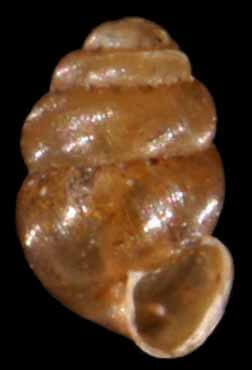 Left: Geyer’s whorl snail (Wikipedia)
Left: Geyer’s whorl snail (Wikipedia)
Geyer’s whorl snail is an air-breathing land snail. Surprisingly
(to me), some snails have lungs and others have gills, but both kinds
of snail can be found in water and on land. As it happens, Geyer’s
whorl snail has lungs, although I didn’t expect to see them.
The snail is a relic of post-glacial conditions. Since
then climate change has greatly reduced its range and it is now
vulnerable to changes in the hydrological conditions of its present
sites. So it was with some misgivings that I embarked upon my
search.
I was reminded of the dwarf caribou. This caribou may have
been dwarf but it was not as small as Geyer’s whorl snail. Anyway,
in the 1870s it was rumoured that a relic subspecies of caribou lived
in a remote Canadian swamp far from and dissimilar to the habitats
of other caribou.
Scientists were sceptical and a reward was offered to anyone
who brought a specimen of the elusive dwarf caribou. In due course,
a local Indian brought forth a skull fragment of such a caribou and
claimed his reward.
However, some scientists remained sceptical, suspecting that
the Indian had brought his caribou skull from the distant habitats.
So in 1908 a hunting party set out to settle the matter once and for
all. Eventually, they came upon a small herd of dwarf caribou, shot
them, and triumphantly brought them back to the satisfaction of
the scientific community.
It was indeed a rare species. No more dwarf caribou were ever
seen. Perhaps the existence of the dwarf caribou was confirmed at
the very instant that the extinction of the species was achieved [1].
The moral of this tale was
perhaps reinforced as I walked
past Spear Pots. The OS map
marks this as a lake. Now, it is
a small flat grassy area. I have
vague memories of this indeed
being a lake, surrounded by a
number of hides, whether to
watch or shoot the waterbirds,
I don’t know. Either way, the
waterbirds are no more, which
is perhaps why the lake is no
more.
I continued on to Tarn
Moor, around Sunbiggin Tarn.
I realised that, amateur that I
am, I had chosen a poor day to
search for snails. It had hardly
rained for weeks. The heather
was brittle dry. The ground was unusually dusty. Only by Tarn
Sike was there any of the wetness that is more normal for the moor.
If Geyer’s whorl snail is anything like my garden snails it would not
venture forth on such a desert.
In any case, I was concerned that my walking about on Tarn Moor
may upset the hydrology and hence the delicate snail. Geyer’s whorl
snail is fully protected, which should include protection against
my boots. Being a ‘fully protected’ species means that, under UK
legislation, it is an offence to disturb, kill or injure a member of that
species or to disturb their breeding and sheltering places. Standing
on a 2mm snail is, I should imagine, likely to disturb it somewhat.
So, after reflection, I didn’t, after all, worry too much about
the snail. To tell the truth, I am not very excited about snails. As
wildlife goes, snails are not very wild and nor do they go much.
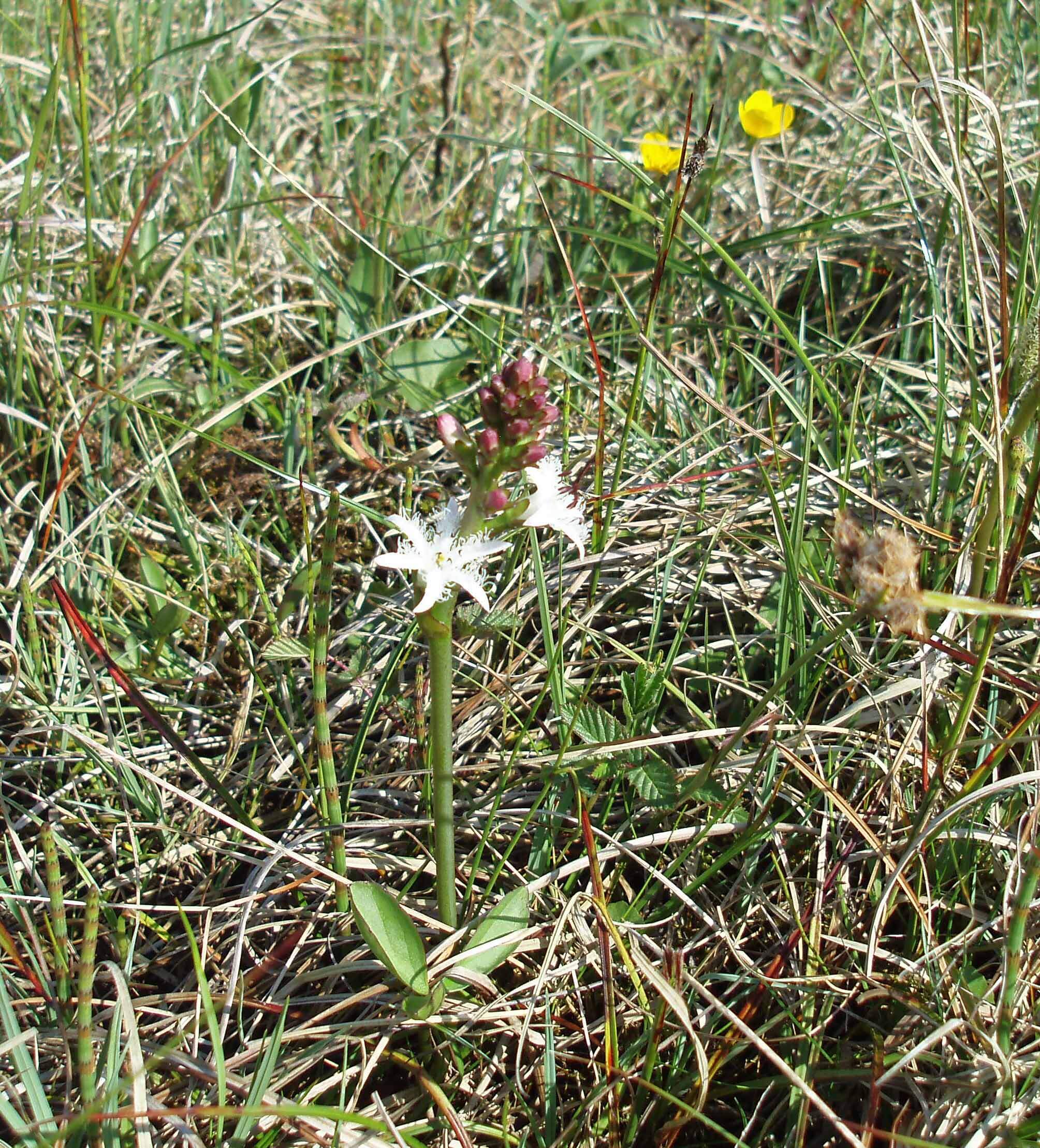
My aborted search for the snail had its rewards, however.
There was a surprising luxuriousness in the vegetation on the
boggy banks of Tarn Sike. Amongst the dominant marsh marigold
various wildflowers flourished, including the attractive specimen
shown to the right.
After several hours perusing the wildflower catalogues, I am
now prepared to identify this as bogbean or buckbean Menyanthes
trifoliata. Botanists will shake their heads. How can anyone take
hours to identify a bogbean, with its distinctive white flowers, pink-tinged, fringed
with white hairs, and with rose-coloured buds? In
my excuse, the catalogues all insist that bogbean’s flowers have
five petals. All the drawings and photographs show this to be the
case. But my specimen had six petals. I was struck by its attractive
symmetry.
This is disconcerting. Are all flora so lax in following their
descriptions? Must I read the catalogues less literally? As children,
we search for four-leaved clovers among the common three-leaved
versions. So perhaps it is not so unusual for plants to have variations.
Perhaps, evolutionarily, it doesn’t matter much whether a plant has
five or six petals. At least, not as much as it would for, say, a dog to
have four or five legs.
It was then time to attend to the third main reason given in
that citation. This concerns the birdlife around Sunbiggin Tarn. It
is the largest body of water for several miles in any direction and
therefore a focus for many birds. The lake is, however, not large,
forming about six hectares of open water. It can be walked around
in an hour if you are prepared to climb various fences and walls
designed to prevent sheep (or you) wandering into the reeds that
surrounds the tarn and its neighbour, Cow Dub.
The citation mentions twenty-two species of bird to be seen at
the lake, from, in alphabetical order, black-headed gull to wigeon.
Unfortunately, the birds do not have the courtesy to all turn up at
the same time. On any particular visit, only a subset will be seen.
My June visit yielded two swans, two moorhen, several gulls, with
curlew and skylark heard overhead, one snipe disturbed while I
circumnavigated the tarn, and a buzzard hovering nearby.
However, I trust the citation (except for the black-headed gulls,
which I have read elsewhere have recently deserted Sunbiggin
Tarn). The surrounding wetlands look fine breeding ground for
waterfowl, with the reed marshes providing a degree of protection.
The moorlands, relatively unfrequented by humans, are surely
nested upon by skylark, snipe, curlew and lapwing. Ornithologists
with the time to come repeatedly in order to survey passing birds,
especially those on their winter migration, are no doubt rewarded
by the sight of many species for whom Sunbiggin Tarn forms a
welcome resting place.
As indeed it does for me.
[1]. The tale of the dwarf caribou is given, with details of other extinction
events, in David Day (1990), Noah’s Choice, London: Puffin Books.
3. Orchids on Great Asby Scar
June 2013
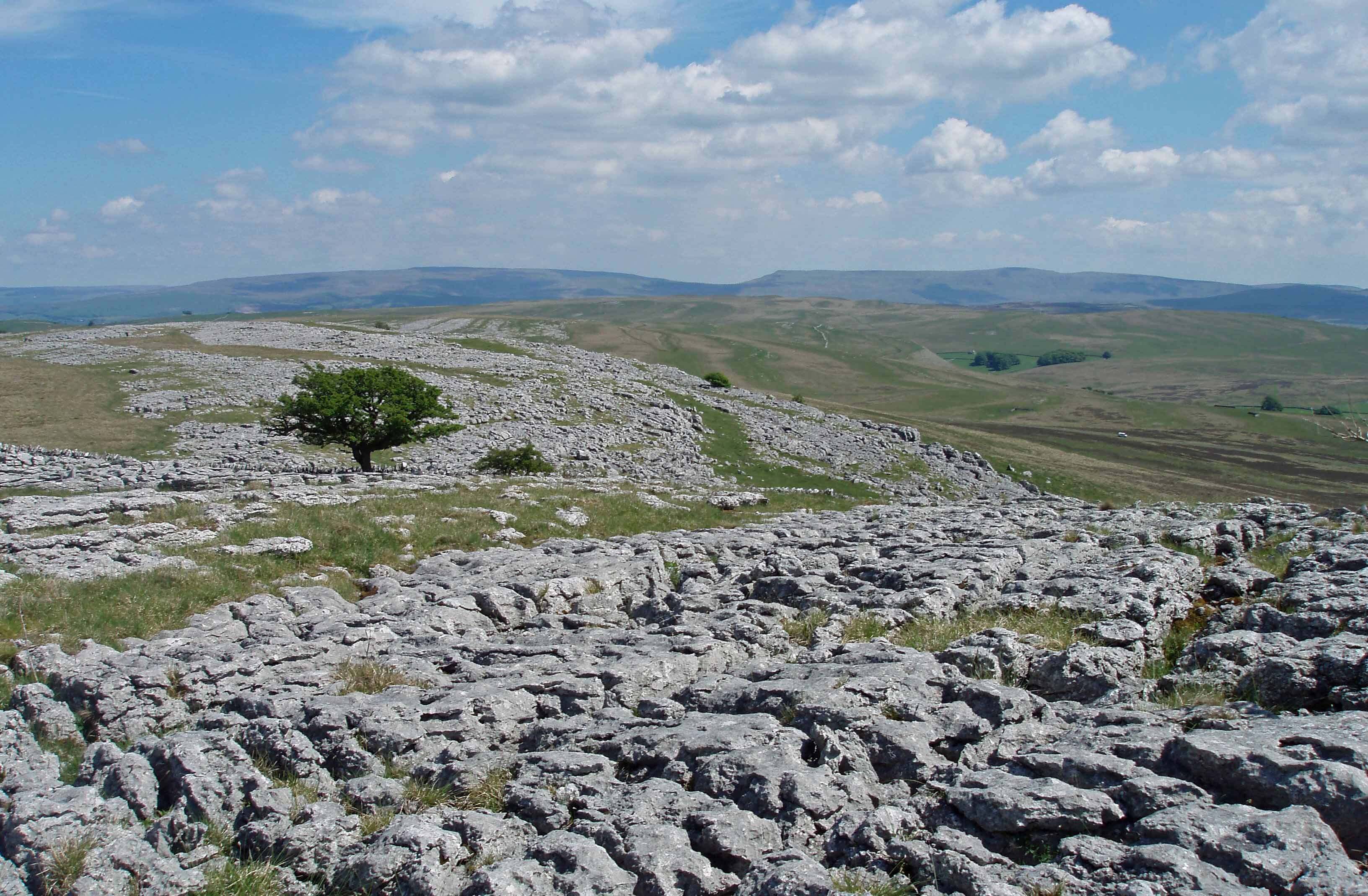 Left: Great Asby Scar
Left: Great Asby Scar
The western end of the limestone ridge that begins above
Sunbiggin Tarn drains via Chapel Beck through and by Orton
to the Lune north of Old Tebay. The scars that lie south of the
wall that runs from Knott to Little Kinmond form part of the Great
Asby Scar Nature Reserve, most of which lies north of the wall and
drains to the Eden. Well, a nature reserve should be of interest, so
I decided to have a look.
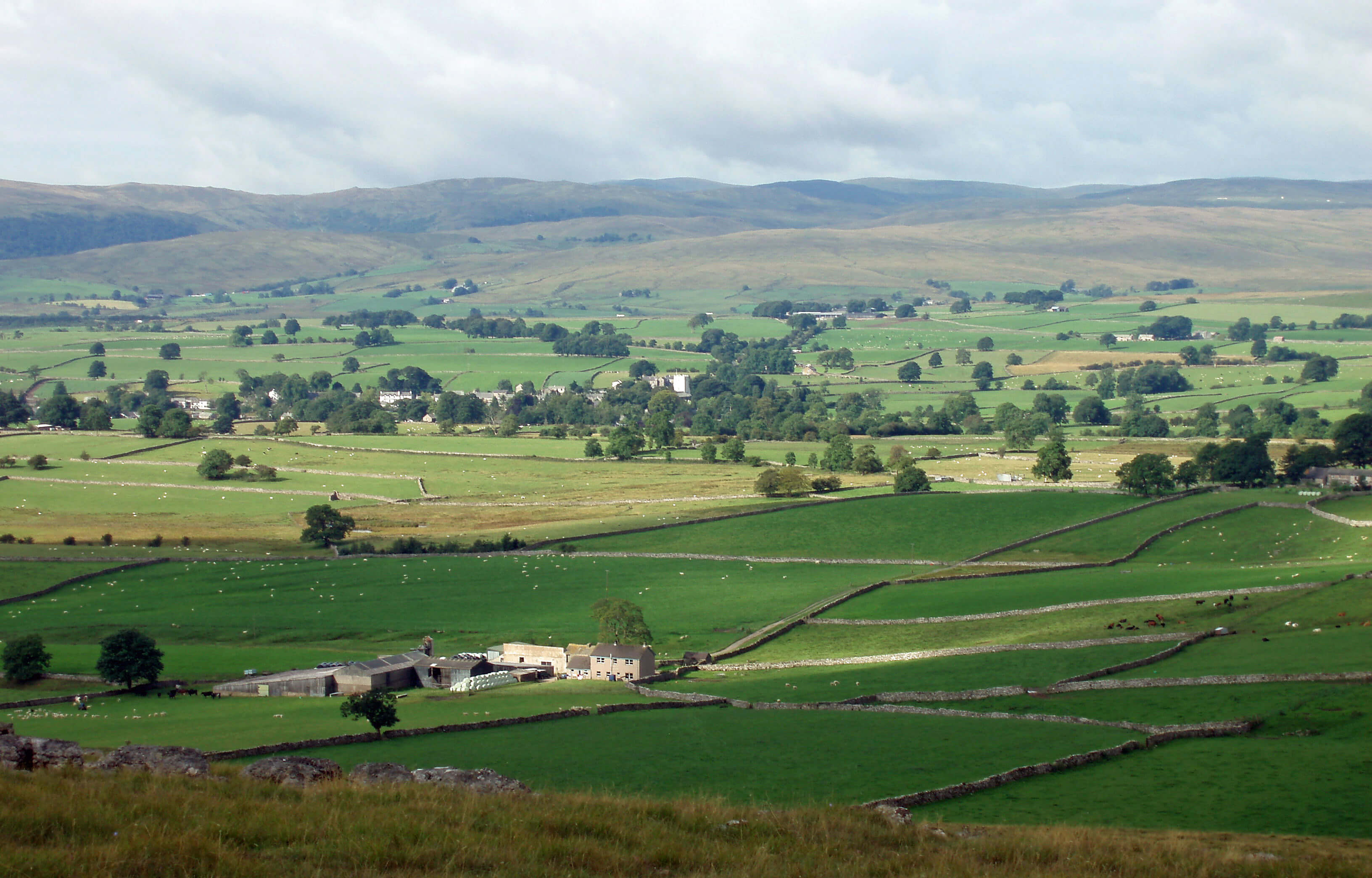 Right: Looking towards Orton from Great Asby Scar
Right: Looking towards Orton from Great Asby Scar
The limestone has been significantly weathered since the last
Ice Age (of 10,000 years ago). Vertical weaknesses in the limestone
have been eroded to form deep fissures (called grikes) and many
loose fragments lie upon the limestone blocks (called clints) between
the fissures. These so-called pavements are more hazardous to
walk upon than any pavement which we might harangue the local
council about.
Nonetheless, it is my duty to investigate the exceptional flora
found around the pavements. Unfortunately, the specimens that
are of most interest (to experts) are to be found lurking within the
grikes, where the shelter, rainwater, and protection from sheep
enables various uncommon plants to flourish.
My enthusiasm does not yet drive me to spend the day on my
knees peering into gloomy grikes. I accept what the experts tell
me - that within these grikes are to be found woodland plants such
as wood anemone and dog’s mercury and herbs such as angular
solomon’s seal and bloody cranesbill. At the moment, I would not
recognise these even if I saw them (at least, not without a wildflower
book to hand).
There are also many varieties of fern (rigid buckler-fern, brittle
bladder-fern, hard shield-fern, lady-fern, and so on). To my eye,
the ferns all look much the same, with the green fronds (which I am
delighted to discover is not only my word but the correct botanical
name for the leaves of ferns) hidden and occasionally protruding
from the grikes.
Even more occasionally, something more substantial had
managed to grow and emerge from the grikes - trees. Most are
somewhat stunted although on Little Kinmond there are relatively
well-developed hawthorn, ash, rowan and sycamore. Overall,
though, the limestone pavements presented an apparently desolate
and barren scene.
The main problem for any flora is not so much the exposure
to the elements but the effects of grazing by sheep and cattle. For
example, the fact that the large sycamore - I found only one - stands
alone is testament to the efforts of sheep and cattle around it.
Recently, grazing on the scars has been reduced to enable the flora
to recover, although they are still relatively denuded of flowers.
Undeterred I set out to look for flowers on the pavements.
Passing over the usual daisies, buttercups and dandelions, the first
flower that I alighted upon was an unexpected but familiar friend,
the bluebell Hyacinthoides non-scripta. I thought the bluebell was a
flower of, or near by, woodland. I would not have expected it to
flourish on these exposed rocks at 350m. Clearly, the shallower
grikes provide enough protection and nourishment.
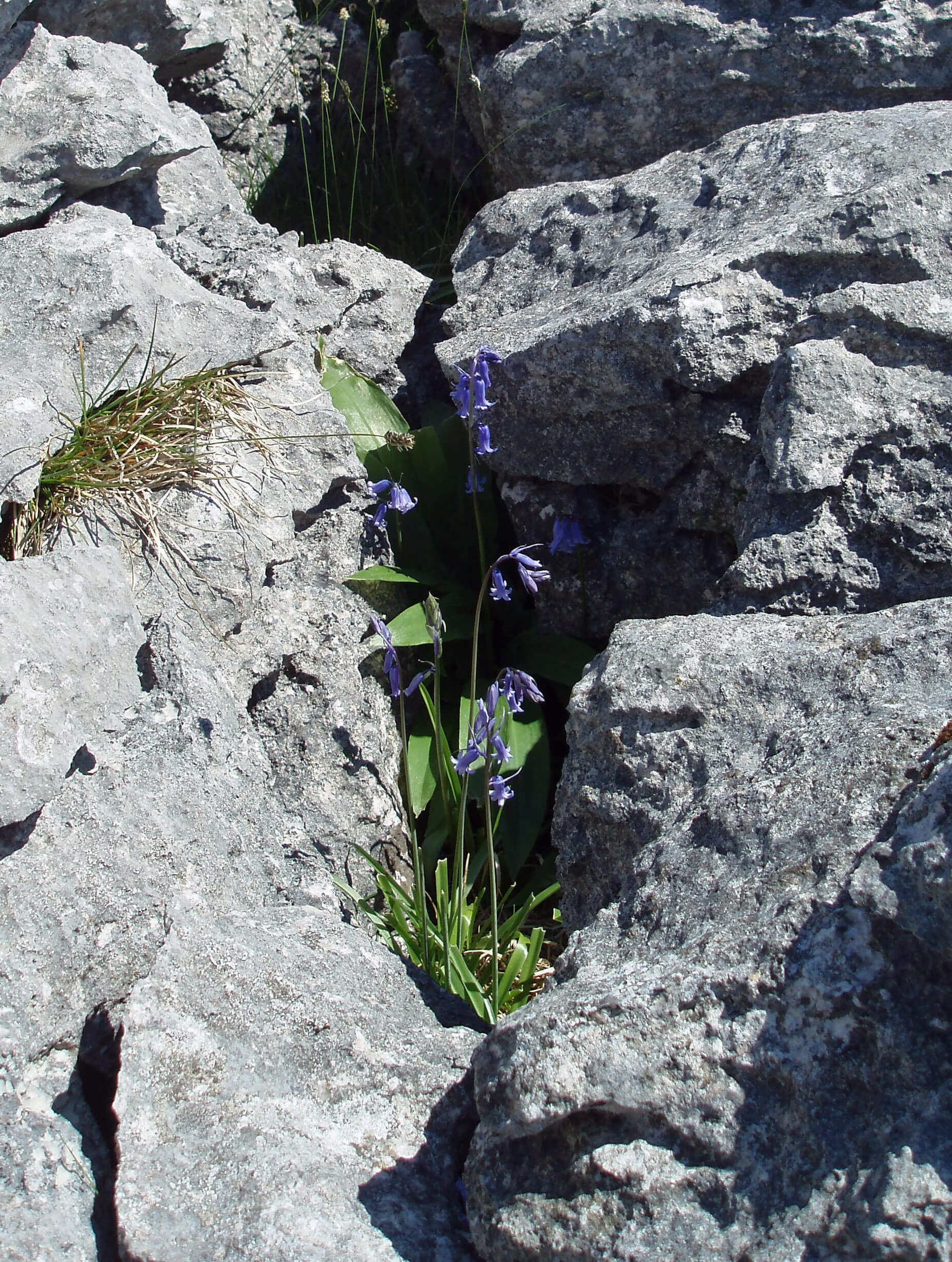
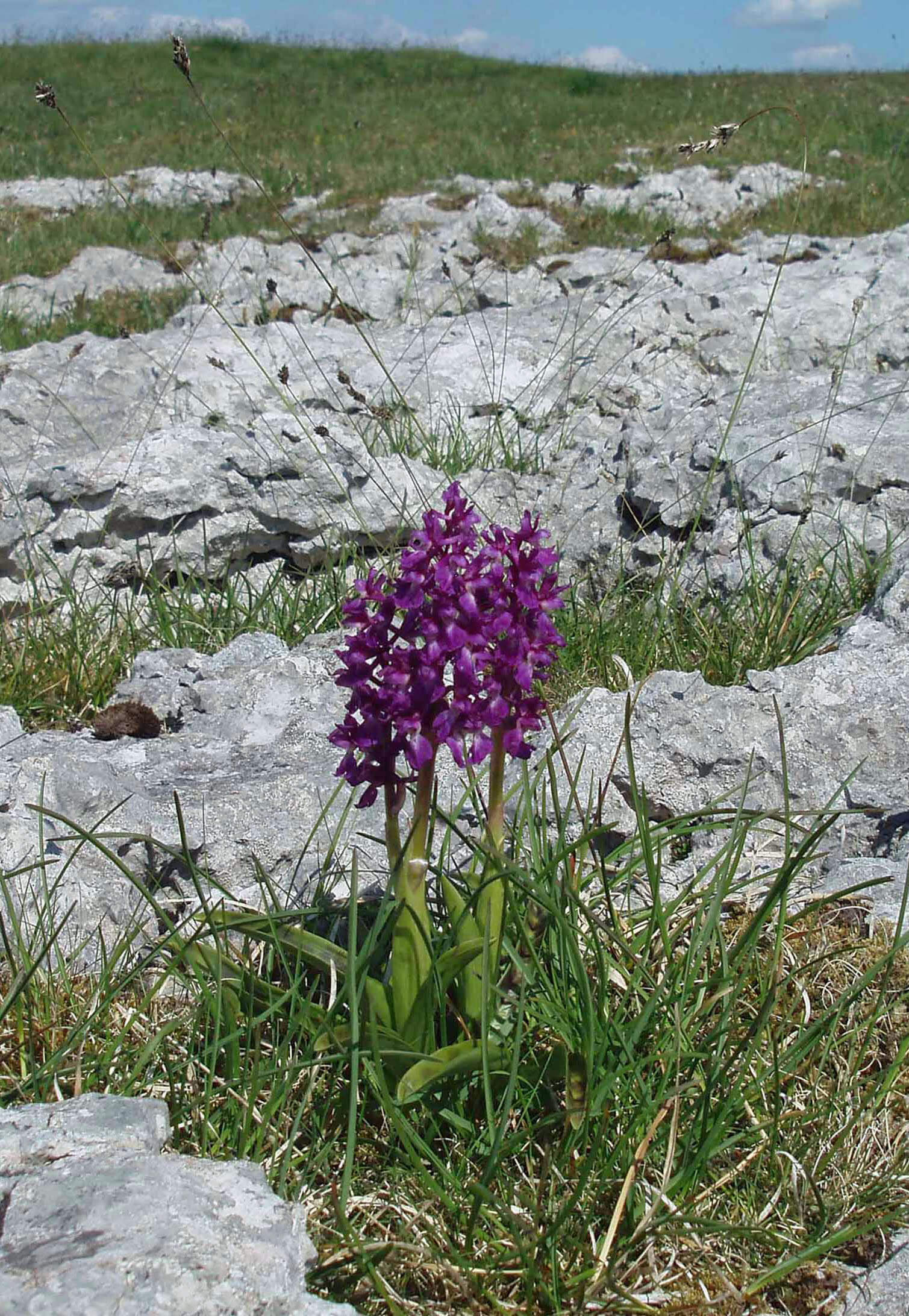 Left: Bluebell on Great Asby Scar
Left: Bluebell on Great Asby Scar
Right: Early-purple orchid
The most prominent flower on the limestone grassland,
however, was an orchid, which since it was early in the season and
its flowers were deep purple,
I confidently identify as an
early-purple orchid Orchis
mascula.
I felt I ought to check this
in the catalogue. I found that
the early-purple orchid is
our commonest orchid and is
often seen with the bluebell, so
that’s promising. However, I
also found that there are about
25,000 species of orchid - four
times as many as there are
mammals. Moreover, they
cross-breed to produce 100,000
or so hybrids. A thorough
search through the catalogue
would take me some time.
However, I was distracted
by the discovery that the
name ‘orchid’ comes from the
Greek for ‘testicle’. The root
is so shaped, apparently. In
Greek mythology, the gods
transformed Orchis, the son
of a nymph, into a flower after
he tried to rape a priestess
of Dionysus. After this
unpromising start, orchids
have become the jewels of the
plant world. Actually, the real
start for orchids was, according
to fossil evidence, before the
dinosaurs became extinct.
So, orchids are a venerable
species. Today, enthusiastic
fans will pay fortunes for rare
specimens and tropical orchid-hunting had almost the romance of
the first jungle explorations.
As can be imagined, with so many species, orchid flowers
vary greatly. However, I must not despair for there are only fifty
or so native British species. Their flowers are usually purple-ish,
mottled with white or green, and bear their flowers in single spikes
or clusters. One can therefore usually confidently identify a plant
as an orchid, although maybe not which one.
There were also flowers around the Great Asby Scar pavements
that were not orchids. But I did not worry about those because, with
bluebell and orchid, I already felt that I’d done rather better than
Alan Coren, who wrote that “This evening, my son and I embarked
upon a pleasant excursion to collect examples of the wild flowers
with which this part of the forest is so abundantly blessed. We
collected a daisy, and fifty-nine things that weren’t” [1].
[1]. Alan Coren (June 6, 1979), The unnatural history of Selbourne, Punch.
4. Trees in Edith's Wood and Greta Wood
July 2013
Orchids in their thousands, bogbeans with the wrong number
of petals, 2mm snails - this wildlife game is quite tricky,
isn’t it? I felt a need to retreat to safer ground. I decided to
have a look at trees. Even I know a tree when I see one.
I started with a wood especially planted for people like me -
Edith’s Wood, near Ingleton. This was newly planted in 2002 with
native trees (so I won’t be confused by pesky foreign trees or strange
hybrids). I refrained from reading which ones, to give myself a
challenge.
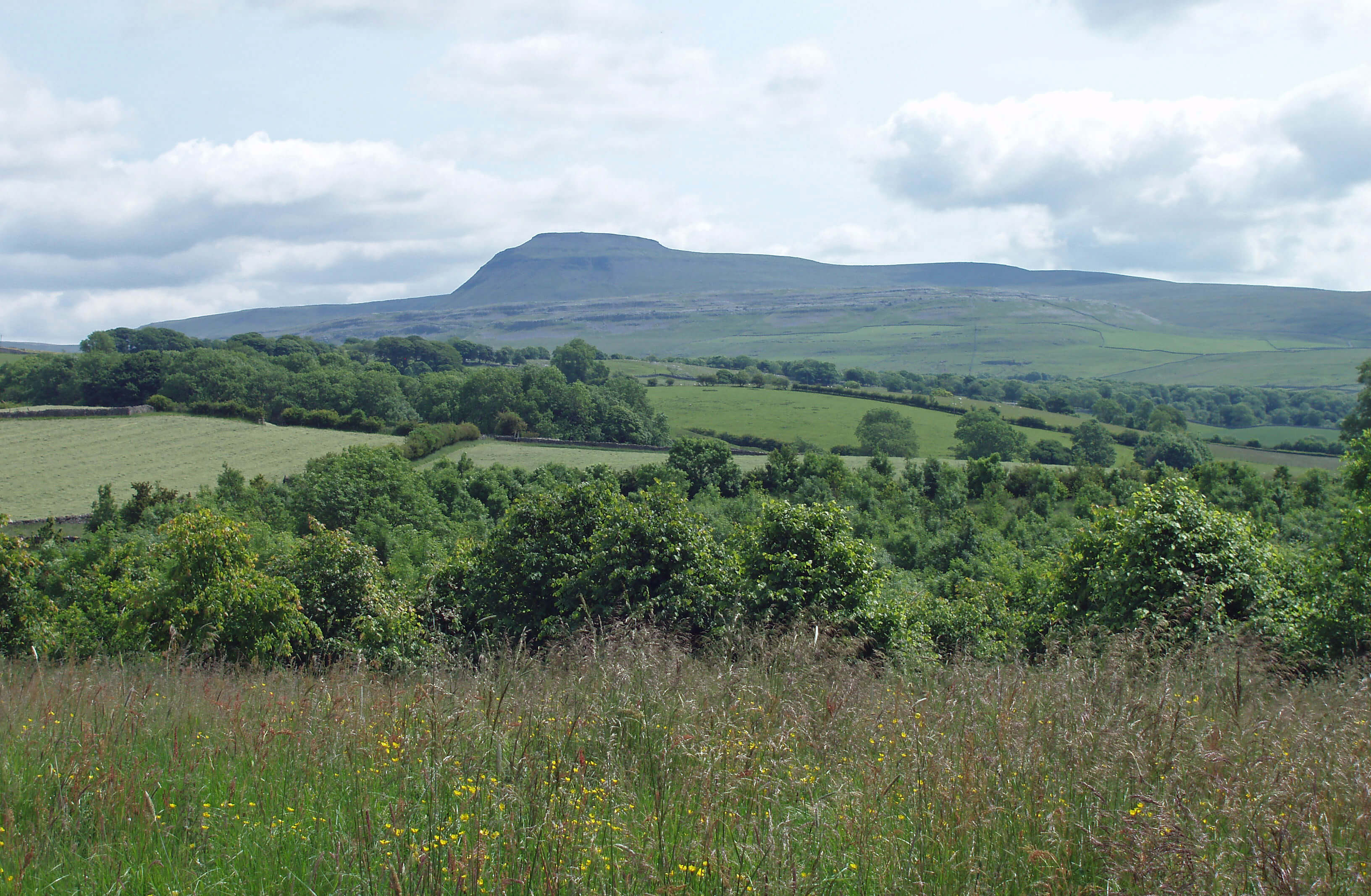 Left: Ingleborough from Edith’s Wood
Left: Ingleborough from Edith’s Wood
However, I needed to do some preparatory reading to get a grip
on trees. Alas, I soon found that a ‘tree’ is not precisely defined. It
is not part of the scientific classification system for plants. Neither
is ‘bush’ or ‘shrub’. But everyone has a commonsense idea of what
a tree is, so I’ll leave it at that. I needed to break trees down into
more manageable groups and classes, so that I may more easily
identify them and appreciate their characteristics. Unfortunately,
almost every grouping that is suggested seems to be hedged with
various qualifications and exceptions.
A starting point might be that trees can be divided into those that
have seeds that are not contained in anything (the gymnosperms)
and those that have seeds that are contained in something (the
angiosperms). The former correspond to evergreen, softwood
conifers such as pine and fir; the latter to deciduous, hardwood
broad-leaved trees such as oak and beech. Except that: some of
the former lose their leaves in winter (for example, larch) or are
hard-wooded (for example, yew) and some of the latter do not lose
their leaves in winter (for example, holly) or are soft-wooded (for
example, willow).
Also, an evergreen tree is not necessarily very green (for
example, Colorado blue spruce); the ‘hardness’ of wood is a
subjective judgment that I cannot make unless I take a saw with me
on my walks; the leaves of broad-leaved trees do not always seem
very broad to me.
Botanists classify trees as they do other members of the Plantae
‘kingdom’. First of all, trees are grouped into families, such
as Fagaceae (informally, the beech family) or Sapindaceae (the
soapberry family). The members of each family have the properties
that define that family. These definitions involve the use of botanical
terminology that it is beyond my competence and your patience to
explain.
Each family contains one or more genera, such as Quercus of
Fagaceae (informally, the oak genus) or Acer of Sapindaceae (the
maple genus). Of course, not all genera have familiar informal
names like oak or maple.
Then each genus has one or more species, such as Quercus robur
(English oak) or Quercus rubra (red oak) or Acer pseudoplatanus
(sycamore) or Acer negundo (box elder). Sometimes, a species exists
in variations distinct enough to warrant an extra suffix, such as
Populus nigra ‘Italica’ (Lombardy poplar), a variant of Populus nigra
(black poplar), a species within the Populus (or poplar) genus of the
Salicaceae (or willow) family.
So, now I can give a proper name to a tree, if I can but determine
what name it should be. As far as I am concerned, the identification
of a tree has to be based on what I can see - its overall form, its
leaves (if any), its trunk and bark - bearing in mind that all these
are liable to vary according to the season, the location and the age
of the tree.
I started off with the most basic guide I could find. In all of
fifteen pages (seven of which were illustrations) it provided advice
on identifying about a hundred trees. First, I must place the leaf
shape into one of ten categories. To help me, a little drawing
was provided. Nobody is a complete novice at this game and I
might imagine that I could think of an exemplar for each of the ten
shapes:
ace-of-spades - silver birch
elliptical - sweet chestnut
jagged - oak
long and narrow - willow
needle - spruce
oval or pointed oval - beech
palmate (like fingers) - horse chestnut
palmately lobed - sycamore
pinnate (having two rows of leaflets) - ash
rounded - hazel
This is, of course, rather superficial. For a start, there are several
oaks and willows. I really ought to give the species name to be
clear. But my hope is that if I can say that a particular leaf is a bit
like what I think of as, say, an oak then that will narrow down my
search to, on average, ten or so trees in my little handbook.
Then I can compare my leaf with the drawings and check my
tree against the brief descriptions. For example, if I find a beech-like leaf (that is, an oval one) and see that the tree has “bark smooth,
grey; twigs slightly downy”, then I might have a stab at hornbeam
Carpinus betulus.
Thus emboldened, I set forth into Edith’s Wood. Proceeding
from the southern corner, I immediately realised a difficulty. The
trees had not grown that much in eleven years or so and may not
have the mature properties described in my little book. Typically,
the bark of a tree goes through various states as a tree ages (much
like our skin, I suppose) and in its youth a tree may not have the
characteristic overall form of its maturity.
Still, I was confident that I first encountered oak, probably
Quercus robur, and ash Fraxinus excelsior. Then, in the next set, hazel
Corylus avellana and hawthorn Crataegus monogyna. Somehow, the
species names made the achievement more commendable.
As I was closely studying a rose in the hope of pinning down
its species name, a young deer wandered up nearby, also taking a
keen interest in the low-lying leaves, but with a different purpose
to me. It took little notice of me. Perhaps it was unfamiliar with
the human species, as there was little sign that it frequented Edith’s
Wood regularly. A dog rose Rosa canina, I think.
And so on, slowly through the seven hectares or so ... birch Betula
pendula (some looking a little poorly, the only trees that seemed to
be struggling), alder Alnus glutinosa, and ... what’s this? So far, I
think I might, even without my little book, have had a general idea
of all the trees so far but this one was different.
I had already realised
that it is harder than it might
seem to place a leaf into one
of ten shapes - some of them
are rather similar and leaves
are rather variable. After due
deliberation, ... leaves lobed
(a bit like a sycamore), five
lobes, could be a maple, “red
when young” ... yes, I opted
for field maple Acer campestre.
I didn’t have a judge to
give confirmation but I was
convinced. Joy unconfined! I
had managed to identify a tree
that I am not sure that I’d even
heard of before. Or is a field
maple what is often just called a maple? (Not that I could identify
a maple.)
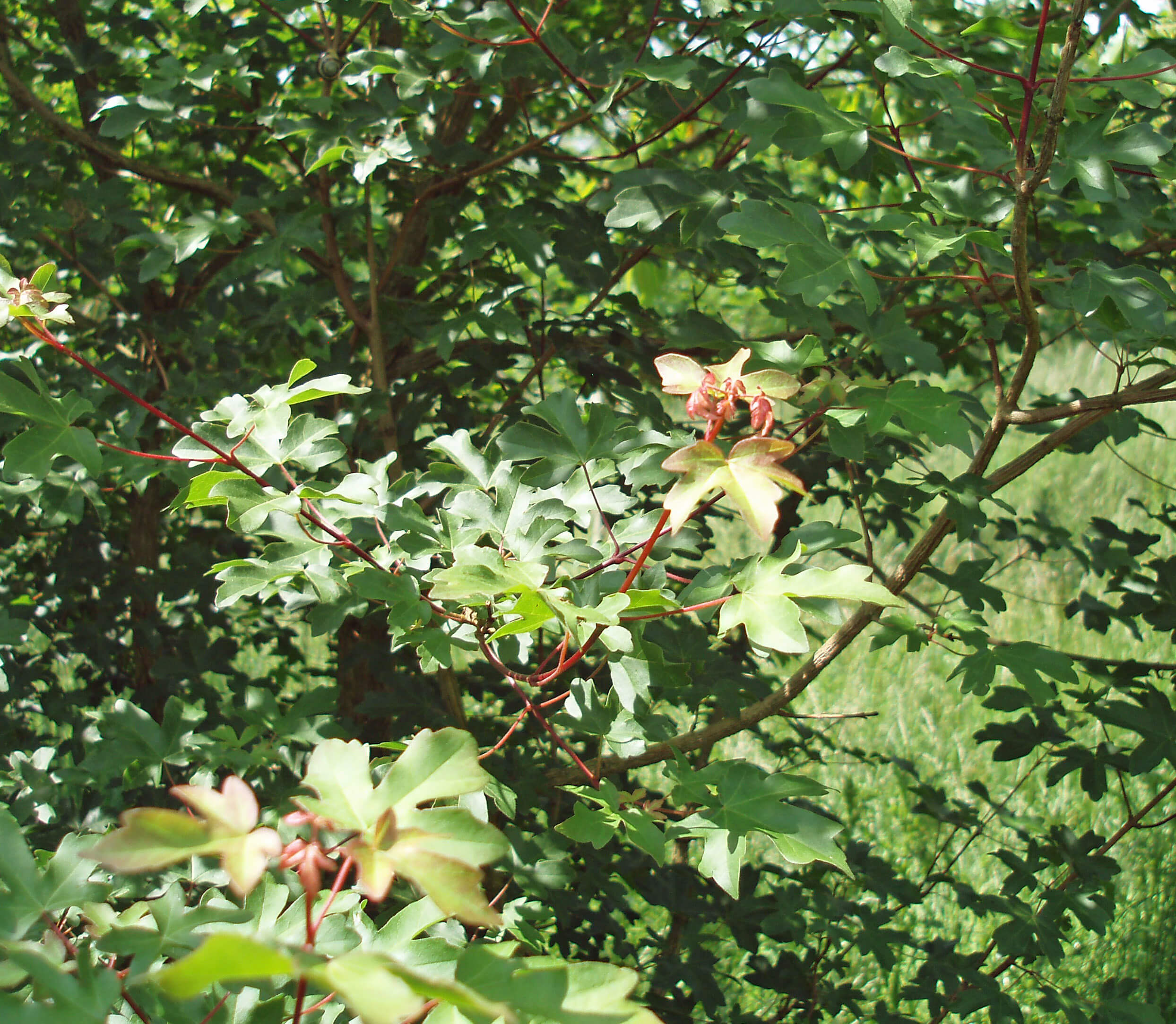 Left: The young tree (field maple?) in Edith’s Wood
Left: The young tree (field maple?) in Edith’s Wood
I am developing a fresh appreciation of the expertise of
arboriculturists and silviculturists who can effortlessly identify
hundreds of species of trees and immediately recall their distinctive
properties. I also see the need for these fancy scientific names. I
think I was vaguely aware that a rowan or mountain ash was not
really a kind of ash (although the leaves are certainly similar). Now
I read that the former is Sorbus aucuparia and therefore of the rose
family and the latter is Fraxinus excelsior of the olive family. Who
would have thought it?
Now enthused, I headed for the Woodland Trust’s Greta Wood,
near Burton-in-Lonsdale. This, I saw straightaway, presented a
different challenge. As I entered the wood on the footpath from
Burton Bridge, I walked under a dense canopy of mature trees.
Indeed, they are so mature that the wood has been designated an
Ancient Semi-Natural Woodland (ASNW). An ‘ancient’ wood is
defined to be one that has
existed continuously since
1600, before which date trees
were not commonly planted.
Therefore, an ancient wood
is likely to have developed
naturally.
 Right: Beech in Greta Wood
Right: Beech in Greta Wood
However, the word semi-natural, suggests that the wood
may not be entirely natural
now. As I walked through
the gloomy wood, I found a
majestic stand of old beeches
at the western end, along with
many ash and a few oak, but
the overwhelming impression
was of sycamore. These cast a
dark shadow over everything.
I can see enough sycamores
from my garden. It was a
disappointment to see so many here. It seems that many experts
share my lack of enthusiasm for sycamore.
To the layman, sycamore is a familiar, natural tree. It is, in fact,
native to central Europe and is thought to have been introduced
here in the 16th century. It is therefore, strictly speaking, a non-native tree, although fully ‘naturalised’, that is, capable of persisting
as a self-sustaining population.
Sycamore disperses its fruit through its characteristic
‘helicopters’. This is does rather too well, for the seeds are widely
distributed and grow vigorously under moderate shade. The
seedlings do less well under the sycamore’s own dense shade. As
a result, sycamore often grows in a kind of partnership with other
species, such as ash, which can grow under sycamore and under
which sycamore can grow [1].
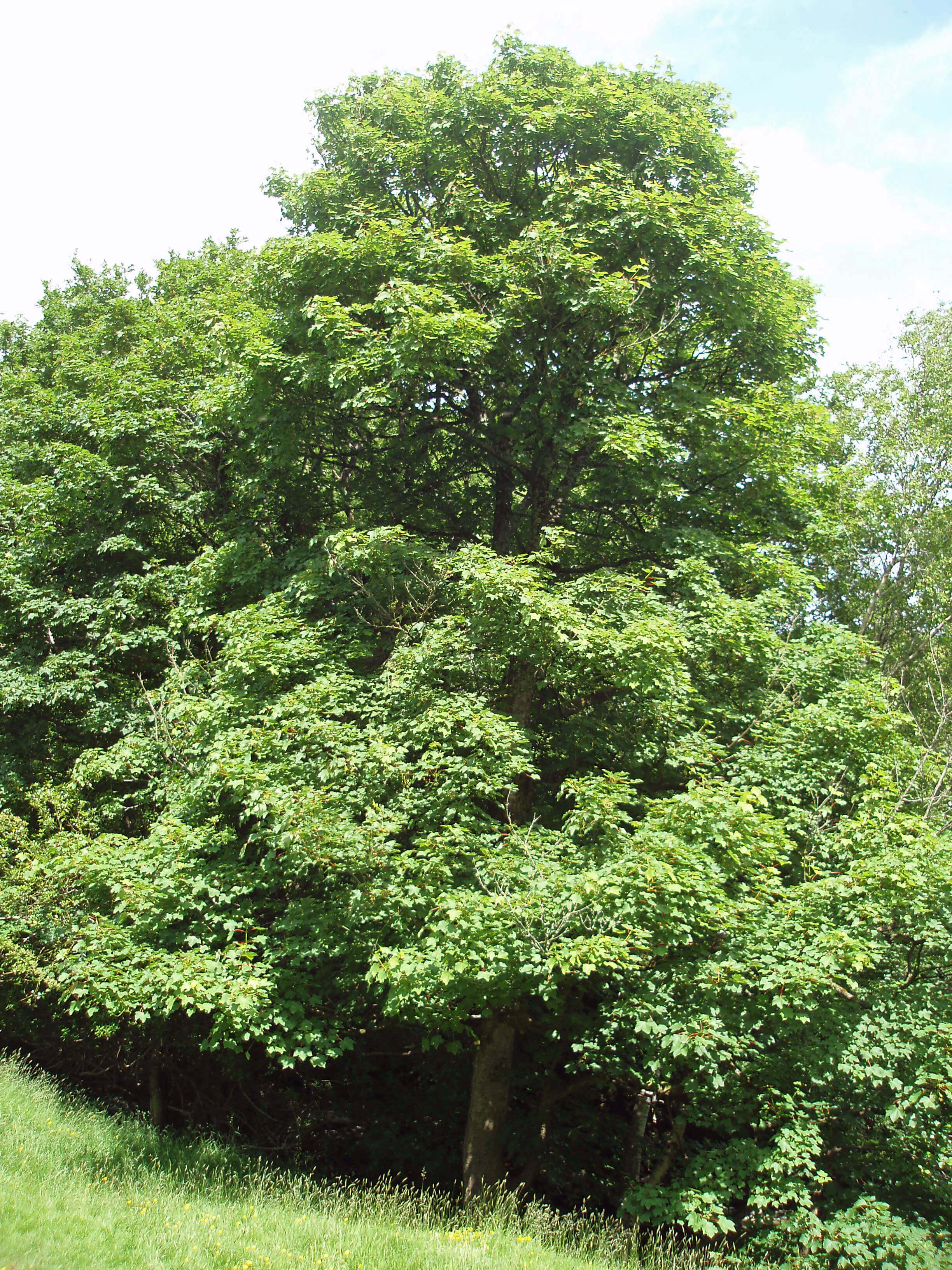 Left: Sycamore by Greta Wood
Left: Sycamore by Greta Wood
Clearing sycamore can be counter-productive because it may
well be the first tree to re-colonise the cleared land. Sycamore will
appear to take over clear land, as an invasive species, until its own
presence stifles further growth. Because of its apparent invasive
properties (and perhaps lingering resentment for it being alien),
sycamore is regarded as a threat to native wildlife. Conservationists
therefore advocate its removal, especially from ancient woodland.
This policy has not, it appears, been applied to Greta Wood.
A Natural England report includes sycamore in a list of 21
species (out of 2,700 non-native species considered) that have
“demonstrated major negative environmental effects” [2].
Sycamore is allegedly a “competitor; aesthetically bad”.
I am no defender of sycamore but that judgement seems
debatable. The aesthetics of sycamore are a matter of opinion. It
cannot look so bad otherwise it would never have been planted in
such numbers to decorate city roads. As regards being a competitor,
sycamore seems to grow in partnership with other species, as
indicated above. The overwhelming dark canopy is not good for
its undergrowth but it doesn’t exactly compete with it.
I cannot say if Greta Wood would be better if the sycamore were
removed. I can say that I was relieved to escape from its gloominess
onto the open footpath that continues along the south bank of the
River Greta.
Here, in a narrow strip of
woodland by the riverside,
trees present themselves
separately, in an orderly
fashion, which it is a pleasure
to inspect and try to identify,
one-by-one. Alder, oak,
hawthorn, holly, hazel, spruce
... but, once away from Greta
Wood, not a single sycamore,
as far as I noticed.
It is a mystery to me that
sycamore can flourish in,
indeed dominate, a dense
wood like Greta Wood, one
which is no doubt under the
careful management of the
Woodland Trust, but, despite
being regarded as an invasive
species, cannot reach far out
here, into the open, by the
riverside, onto land that is not
managed (as far as I know).
Perhaps sycamore is not such a bad tree, after all.
[1]. Mike Townsend (2008), Sycamore - Acer pseudoplatanus,
Woodland Trust report.
[2]. Natural England Research Report No. 662 (2005),
Audit of non-native species in England.
5. Cinnabar Caterpillars near Heysham Moss
July 2013
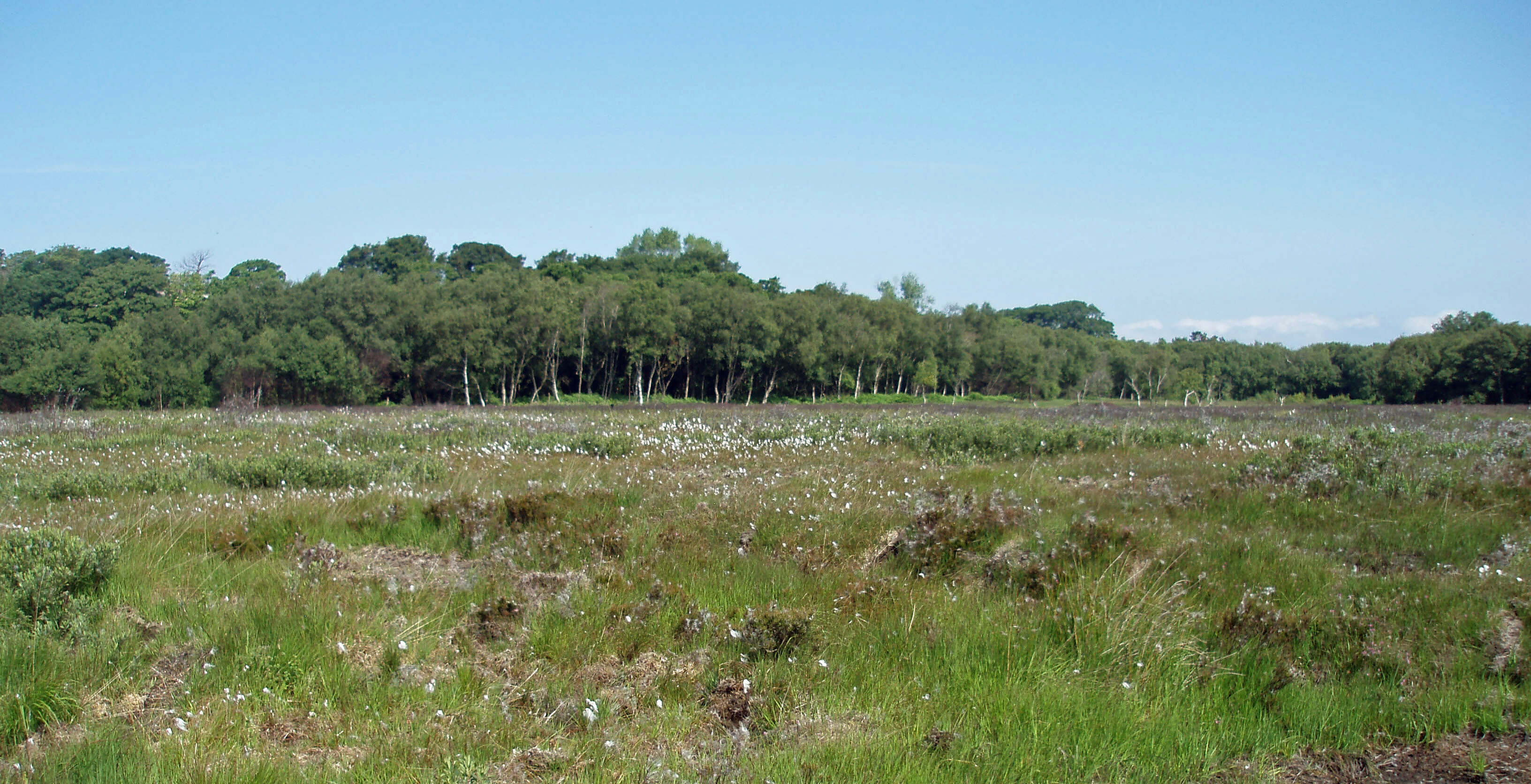
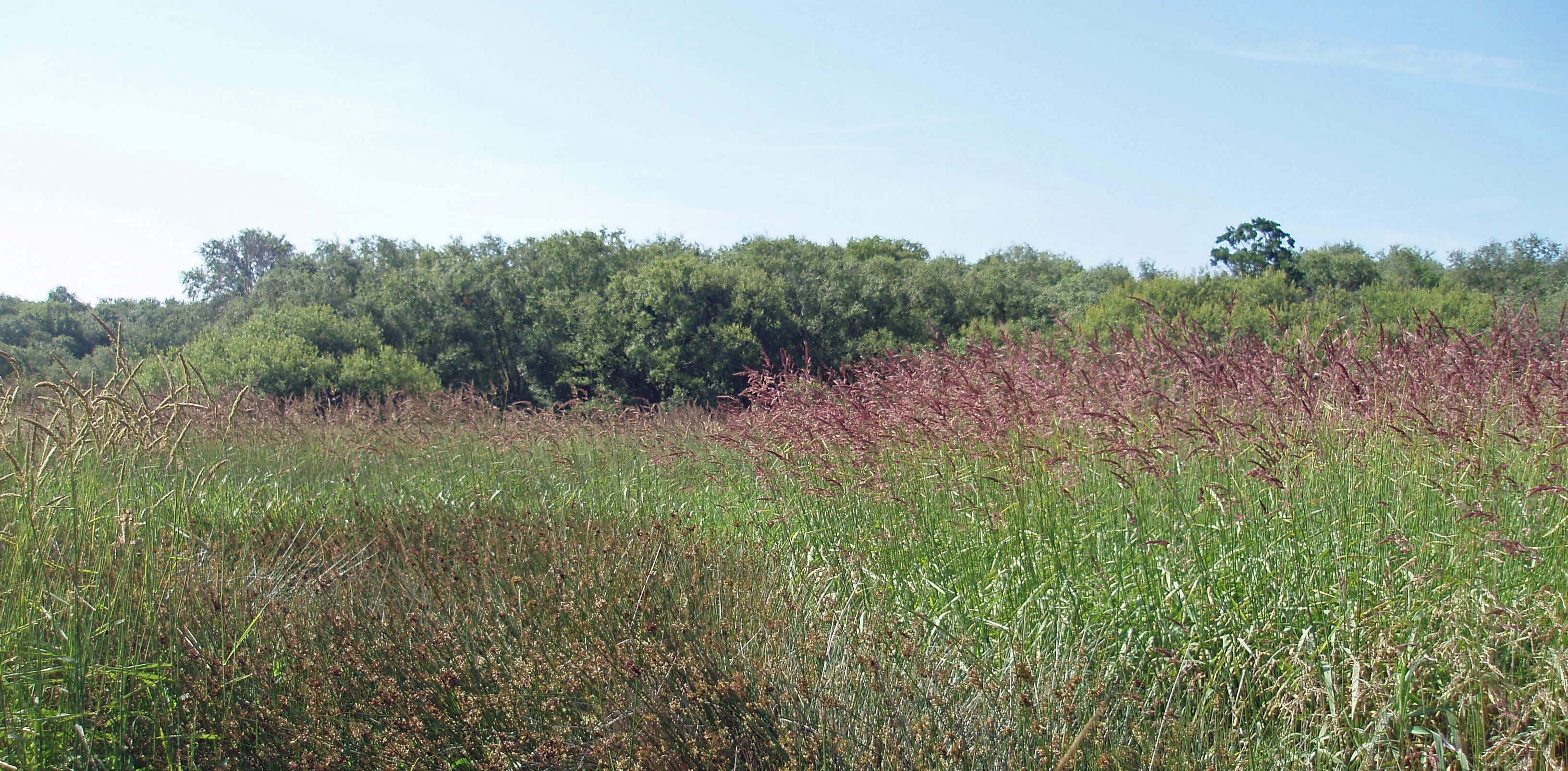 Left and Right: Heysham Moss
Left and Right: Heysham Moss
In April 2013 the local paper reported that “A huge wildfire ripped
through the [Heysham Moss] reserve destroying everything
in its wake at teatime last Friday” [1].
Perhaps only in Loyne do
disasters happen at teatime. The report continued: “A raised bog
... was devastated during the fierce blaze. It could be years before
the vegetation and wildlife regenerate themselves, according to a
Lancashire Wildlife Trust spokesman”. I thought that I’d have a
look at the devastated reserve, and then revisit after a couple of
years to see how the regeneration was progressing.
The Wildlife Trust Nature Reserve of Heysham Moss is on the
western edge of the flat region bisected by the A683 from Lancaster
to Heysham. This region lies west of the Lune, between the small
ridge that peaks at Colloway Hill (36m) and the village of Heysham
itself. The fields are drained by many ditches that yield fine
agricultural land for cattle and sheep. In the past, however, this was
a vast waterlogged morass, no doubt occasionally inundated by the
sea. A century or two ago this region was called Little Fylde.
A remnant of the past can be seen at the lowland bog of Heysham
Moss. It is at an altitude of about 10m and you can’t get much lower
than that. According to the information board at the site, 3m of that
10m is peat laid down in the last 4,000 years.
Lowland raised bogs once covered much of Lancashire’s coastal
plain but they have almost all been reclaimed for agricultural use.
Heysham Moss itself is not entirely intact, with drainage and peat-cutting having occurred
at the periphery, but the central area is
relatively pristine. Here, purple moor-grass and common cotton-grass dominate. There are also
characteristic bog plants such as
bog myrtle, bog asphodel and round-leaved sundew and many
varieties of sphagnum moss.
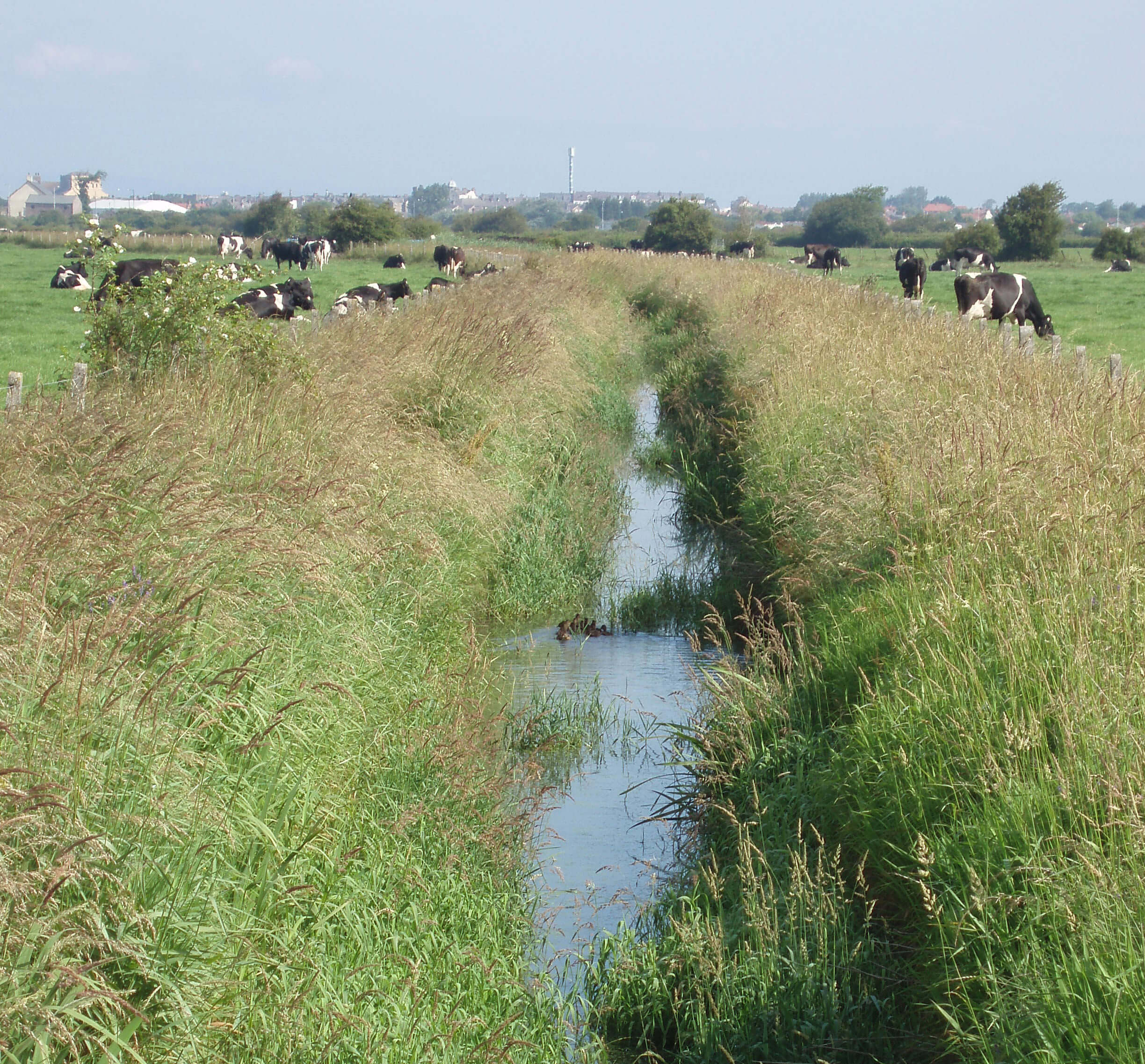 Left: A ditch in Little Fylde (with ducklings)
Left: A ditch in Little Fylde (with ducklings)
I did not go directly to Heysham Moss but walked to it across
the reclaimed agricultural land. I wanted to imagine how different
this activity would be if it were all still like Heysham Moss. I walked
along the surprisingly tranquil footpath from White Lund. Once
away from the road, there was not a sound except the twittering of
swallows. Along the track I found ragwort Senecio jacobaea festooned
with caterpillars of the cinnabar moth Tyria jacobaeae.
Ragwort is poisonous to
horses and livestock, although
they know to avoid it. In the
summer its yellow flowers
dominate road-sides. Its
notoriety as a weed led to
the distinction of having a
government bill named in
its honour, the 2003 Ragwort
Control Bill.
During the drafting of
the bill it was pointed out
that about thirty invertebrate
species are entirely dependent
on ragwort, and ten of these
are considered scarce or rare.
The bill therefore backed off
from proposing the eradication
of ragwort, merely suggesting
that its spread be controlled
where it might form a hazard
to grazing animals.
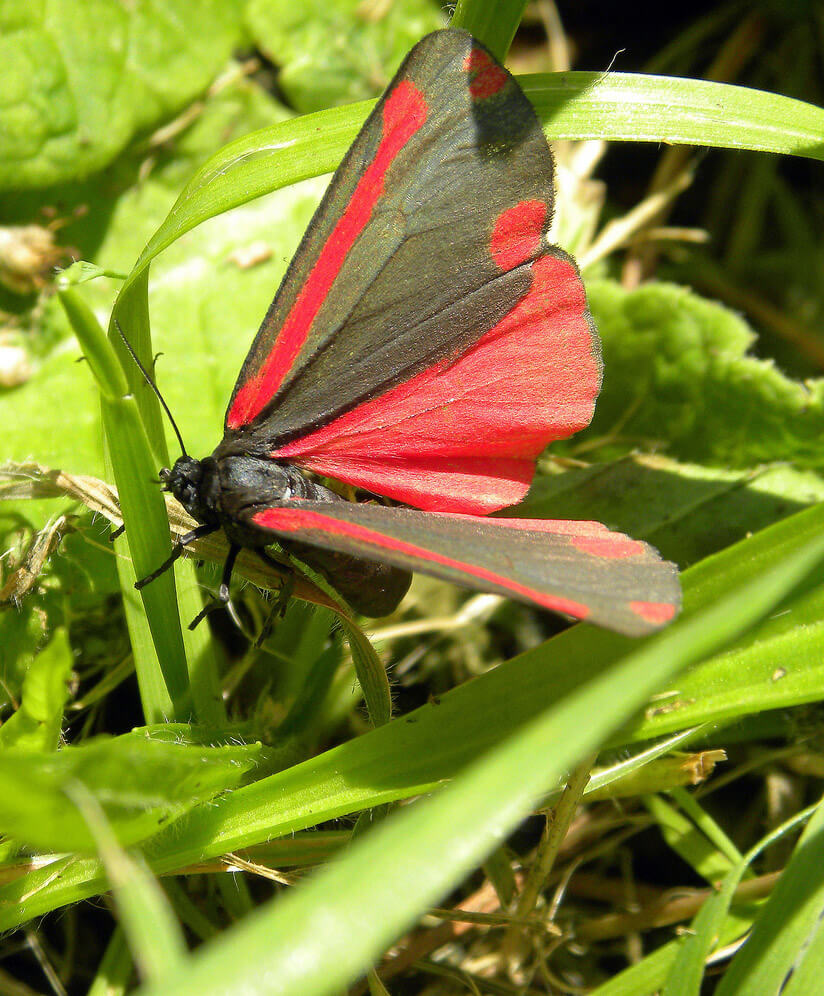 Right: Cinnabar moth caterpillars on ragwort
Right: Cinnabar moth caterpillars on ragwort
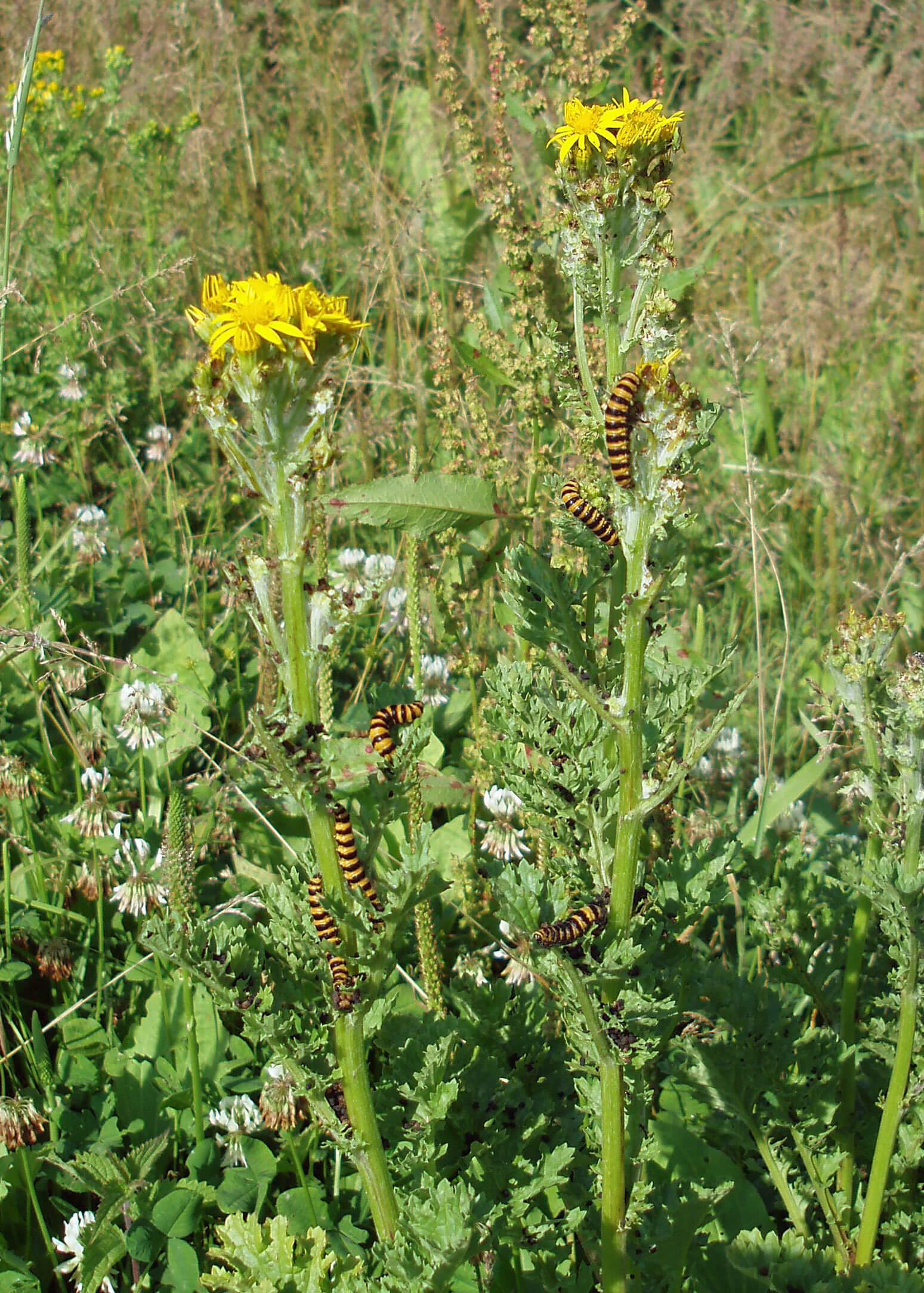
Far right: Cinnabar moth (Alison Day)
One of the species
dependent on ragwort is
the cinnabar moth. It is still
a common moth although
its numbers have dropped
considerably following the
attempts to control ragwort.
The moth is a striking black
and red (cinnabar-coloured,
indeed) and its caterpillars are
equally eye-catching, being
striped black and yellow. This
helps warn predators to steer
clear of the poison that the
caterpillars have ingested.
The female moths lay eggs in batches of fifty or so on the
underside of ragwort leaves. Numerous caterpillars on one
ragwort plant soon reduce it to a bare stem, as was underway on
my observation. So voracious are they that they have been used to
control ragwort.
This is a microscopic illustration of the complexities faced by
our attempts to control nature. The fact that ragwort is poisonous
to valuable animals has helped persuade us that it is a weed that
should be eliminated. In fact, the plant itself is a perfectly reasonable
specimen and it is not excessively invasive. The cinnabar moth and
its caterpillars are attractive examples of their kind and it would, of
course, be a shame to lose them.
I eventually reached Heysham Moss and completed the walk
around the perimeter path. I noted impressively high purple
moor-grass and scrubby birch and willow woodland. It had been
exceptionally dry in the preceding weeks and the whole area
looked parched, which I am sure is far from its normal state. But
I didn’t notice any real sign of the fire. Either the local paper was
exaggerating or the reserve had already recovered remarkably.
The most lasting impression, however, was of bracken, brambles
and clegs (or horse-flies). I am doing my best to love wildlife in all
its forms but the cleg defeats me. Would the world be so much
worse if Noah had forgotten to invite clegs onto his ark? I can find
no mitigating feature that overcomes its habit of settling unnoticed
on my arm, sucking my blood, until, too late, I feel the sting and
swat it away.
In the circumstances, I may forego the planned return trip to
the moss.
[1]. The Visitor (April 10, 2013), Beauty spot devastated by massive blaze.
6. Marsh Gentian on Keasden Moor
August 2013
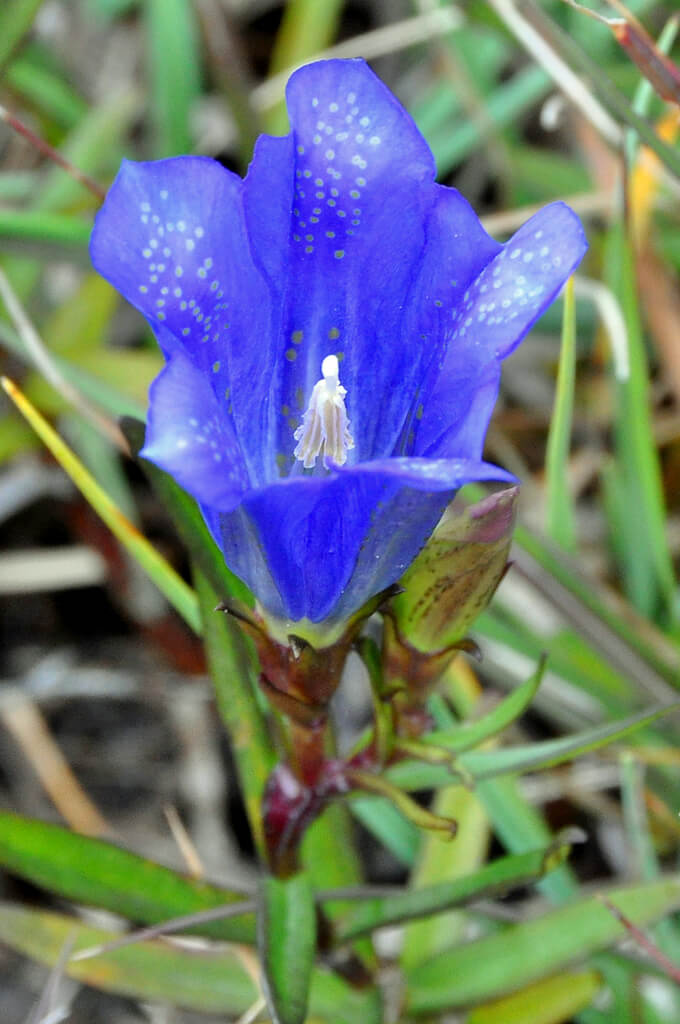 Left: Marsh gentian (Tim Melling)
Left: Marsh gentian (Tim Melling)
As Keasden Beck runs from the expanses of Great Harlow
and Burn Moor it passes, just north of Turnerford Bridge,
a small undistinguished moor that has been designated
the Keasden Moor SSSI. The first sentence of its citation states that
“Keasden Moor is of special interest as the only known site for the
marsh gentian Gentiana pneumonanthe in the Yorkshire Dales”.
This statement is contentious on two counts: first, Keasden Moor is not
in the Yorkshire Dales and secondly, there are no marsh gentians
there.
The first is obviously so, from
looking at a map. The second is
open to contradiction by anyone
who succeeds in finding marsh
gentian on the moor.
The latest Natural England
review of the site (26th September
2012) admitted that “no marsh
gentian were seen”. The 4cm
bright blue, trumpet-shaped
flowers surely cannot be missed -
but perhaps 26th September is a bit
too late in the year to see them.
So I set off in August, with
some optimism, to carry out a
systematic search of the moor. I
marched up and down the moor
carefully surveying narrow strips
as I went. It is a small enough
moor to be thoroughly traversed
in two or three hours.
Unfortunately, I saw no marsh gentians. Not seeing is not
believing. Notwithstanding the SSSI citation, I will not believe that
there are any marsh gentians on this moor until someone directs me
to their exact location. I do not intend to search this dreary moor
again.
Marsh gentian is a nationally rare species - and, it seems, perhaps
rarer than it was thought. If it were to exist on Keasden Moor this
would be at the northern edge of its range in England. It is now
believed to survive at only a handful of sites in northern England.
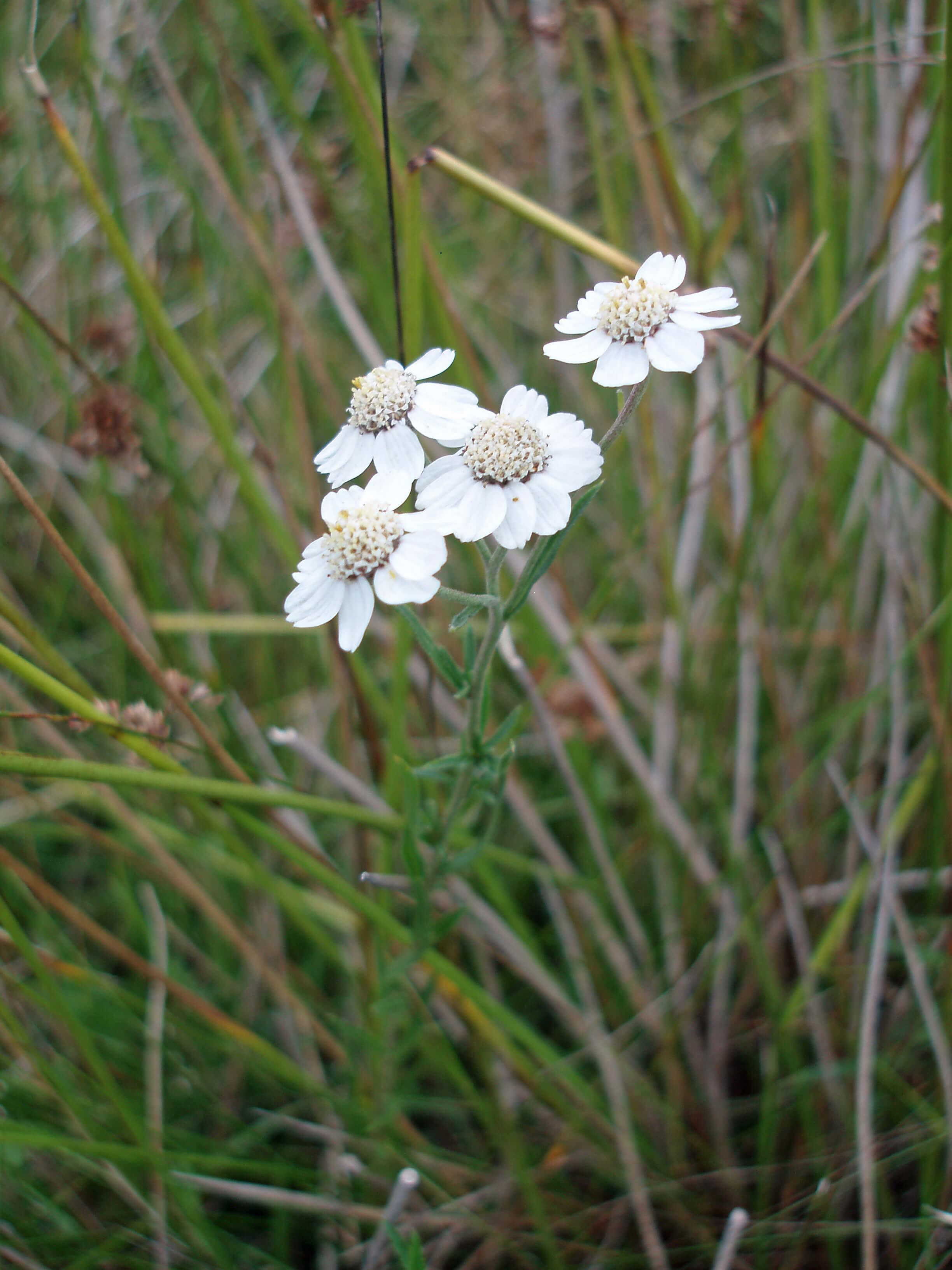
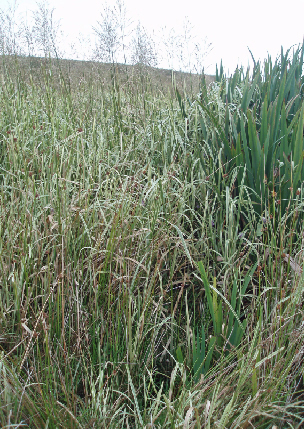
Right: The ‘pond’ on Keasden Moor
Far right: Sneezewort
Is there a mechanism for de-registering a SSSI? There surely
ought to be in case the main reason for establishing a SSSI
disappears. Apart from the (non-existent) marsh gentian there is
little to commend Keasden Moor.
The citation, which is the shortest I have seen, also mentions
“a small pond [which] provides an additional feature of interest”.
This pond is said to be surrounded by various rushes with common
marsh-bedstraw, marsh willowherb, sneezewort and lesser
skullcap.
I can vouch for the rushes but I have to take the scientists’ word
for the rest. The pond is protected by a squelchy quagmire of a
depth that I had no wish to investigate. If the scientists have in fact
reached the pond itself I admire their bravery in the course of their
scientific duty.
Of the plants mentioned the only one that I found was sneezewort,
which is common on the moor itself, not just by the pond. I did
disturb a few ducks from the pond, their alarm suggesting that they
are rarely visited by humans. Nearby, I flushed out a snipe and
elsewhere on the moor a hare was startled into action.
Overall, then, this small moor forms a haven for wildlife, safe
in the knowledge that most humans have the sense not to walk
upon it. If it does not deserve to be a SSSI then perhaps it is better
regarded as a ‘nature reserve’ although I am unsure of the precise
legal difference between the two. In any case, it is not entirely
natural because sheep and cattle trample upon it. Perhaps they eat
marsh gentian?
7. Small-Leaved Lime in Aughton Woods
September 2013
 Right: Aughton Woods, Lune, Ingleborough and hot air balloon
Right: Aughton Woods, Lune, Ingleborough and hot air balloon
Inspired by my foray into Edith’s Wood and Greta Wood and
now informed by two voluminous tree guides subsequently
acquired, I aimed to investigate Aughton Woods. I have walked
in these woods dozens of times and although I appreciated that the
trees were there I had never really taken much notice of them.
This woodland comprises Sidebank Wood, Cole Wood, Burton
Wood, Lawson’s Wood, Walks Wood and Applehouse Wood.
Different subsets of these woods form a Biological Heritage Site,
the Aughton Woods Nature Reserve (owned by the Lancashire
Wildlife Trust) and the Burton Wood SSSI.
The ancient name of Aughton is said to mean ‘oak-town’, which
indicates that these woods are of some vintage. Apart from oak,
there are other native species such as hazel, ash, wych elm, rowan,
hawthorn, fir, cherry and alder. The non-native sycamore and larch
is gradually being cleared. That is all well and good. These are all
old familiar friends - friends with whom I have recently become
closer. But pride of place in the literature on Aughton Woods goes
to the small-leaved lime. Now they’re talking! I like to search (if
unsuccessfully) for something new and rare on my outings.
The limes are Britain’s most noble trees. They are our tallest
broad-leaved trees, with attractive heart-shaped leaves. They grace
many parks, public gardens and palaces, such as Hampton Court.
Lime wood is fine-grained and doesn’t warp, making it suitable for
wood carvings and to make musical instruments. They are hardy
trees that provide good shade and will stand severe pruning and, as
a result, are often used in street avenues. Limes used to be thought
holy trees, able to provide protection against evil.
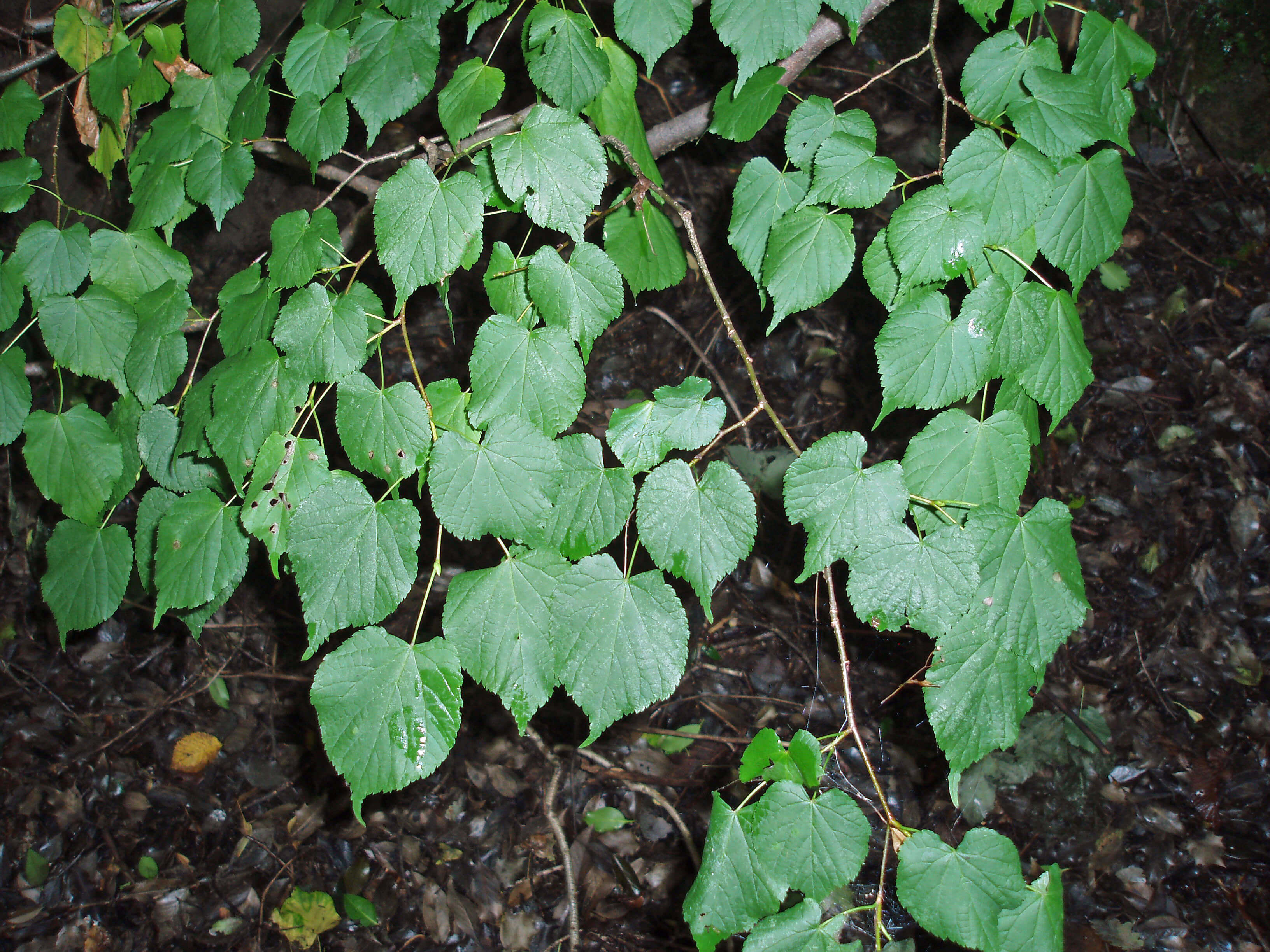 Right: The leaves of small-leaved lime
Right: The leaves of small-leaved lime
The leaves of the small-leaved lime Tilia cordata are, to my great
relief, smaller (4 - 7.5 cm) than the leaves of the large-leaved lime
Tilia platyphyllos (6 - 15 cm). The leaves of the medium-leaved lime
- no, it’s not really called that - that is, the common lime Tilia x
europaea are between the two (5 - 10 cm). Which is as it should be,
because the common lime is a natural hybrid of the small-leaved
lime and the large-leaved lime.
So if I found a heart-shaped leaf 7 cm long it could be off any
of them. However, if I measured all the leaves on one tree and
none of them exceeded 7.5
cm then perhaps I’d be safe
in identifying it is as a small-leaved lime.
Actually, if I found any
kind of lime in Aughton
Woods it ought to be the small-leaved species. This is because
Aughton Woods is supposed
to host native trees and the
common lime and large-leaved
lime are not native to this part
of Britain. The small-leaved
lime is relatively uncommon and is near the northern limits of its
range in Aughton Woods.
A careful study of the descriptions of the three species reveals
differences other than just the size of the leaves - that is, in the
precise shape of the heart, the hairiness and shininess of the leaves,
the overall shape of the tree, the appearance of the bark, the shape
and colour of the flowers, and so on. These, however, are, for
an amateur like me, subsidiary features to be used to confirm a
provisional identification. My first objective, as I set off for Aughton
Woods, was to find a tree with heart-shaped leaves.
... And, yes, there was little difficulty in finding small-leaved
lime, once I had overcome my preconception that a small-leaved
lime is a small tree. It is in fact among the largest trees in Aughton
Woods. The distinctive leaves are therefore far aloft, out of reach of
my ruler but they look small to me. Some of the trees have lower
offshoots, allowing a closer inspection.
The leaves may be confused only with those of hazel, but that of
course is more of a multi-stemmed shrub, not at all like the sturdy-trunked lime.
Hazel leaves are less heart-shaped and have more
ragged edges.
Small-leaved lime may be located without leaving the Lune
Valley Ramble path in Lawson’s Wood. There are a couple of
specimens by the field as you enter the wood from the east. In the
wood there is a series of eight footbridges over small gullies. If
you pause on the first five of these you can see a small-leaved lime
growing conveniently within a few yards of the footbridge. It is
almost as if the limes were planted in order to be viewed from the
bridges, but of course that is not the case as the bridges are recent.
I was overcome with a peculiar sense of achievement in finding
something ’new’ in a wood that I thought I knew well.
8. Eels in the Wenning
September 2013
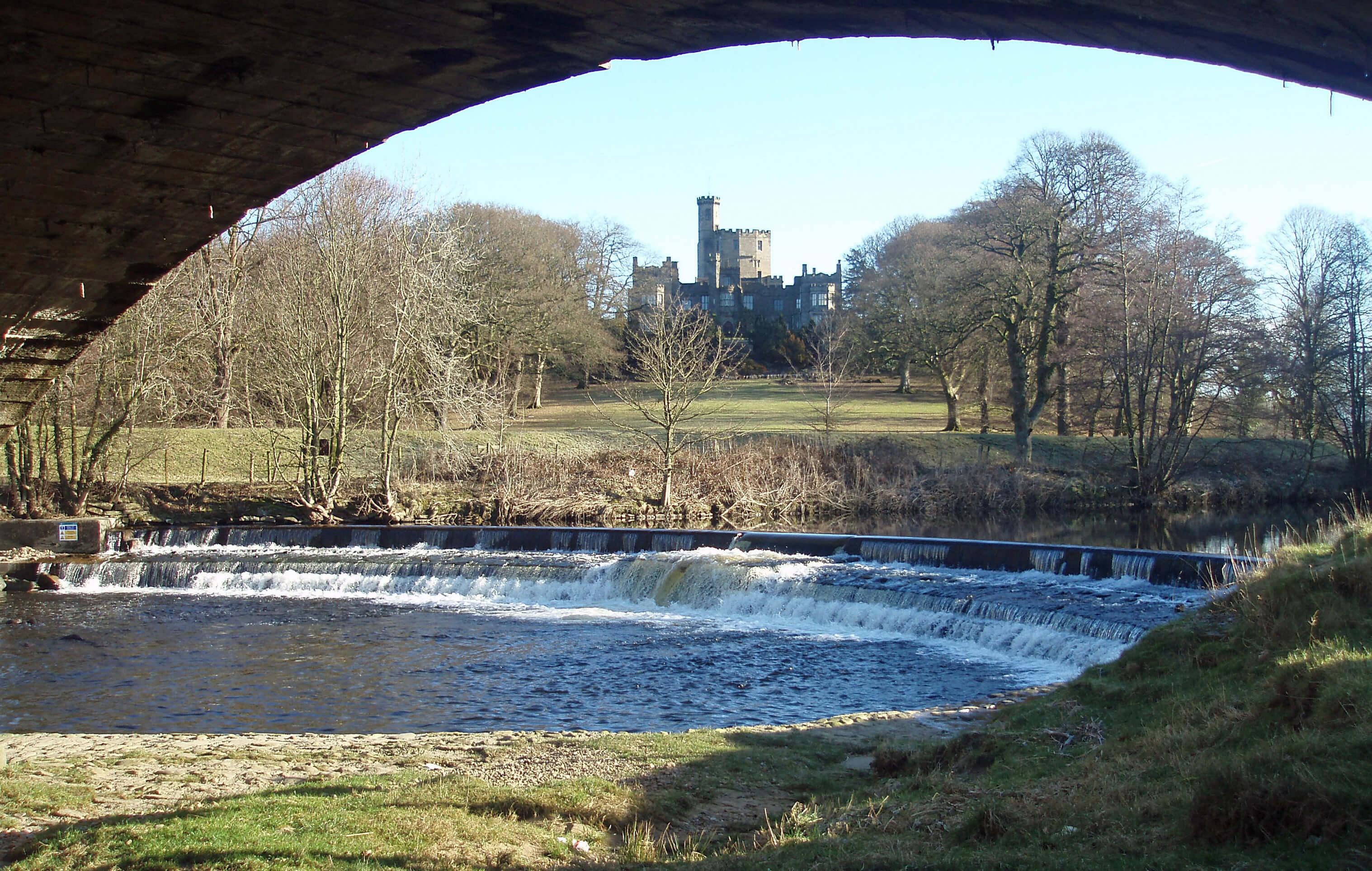 Left: The weir at Hornby
Left: The weir at Hornby
The River Wenning curves below Hornby Castle to drop over
an arc-shaped weir. This weir, unlike most weirs in Loyne,
was not built for an old mill. Perhaps it was built to create
deep still waters above the weir to enable castle residents to fish and
boat. Perhaps it was intended to enhance the aesthetically pleasing
view of the castle from the bridge.
The weir’s symmetry is not spoilt by the presence of a fish
pass. Fish have to leap the weir. However, the north side of the
arc is broken by a green structure, the purpose of which is not
immediately obvious.
I once sat by Hornby Bridge to watch a heron swallow an eel
(more precisely, a European eel Anguilla anguilla). The heron has a
long neck but it is not as long as this eel was. It took the heron some
time to get the whole eel inside.
Herons are often to be seen standing by the weir. They have their
eye on fish that are waiting below the weir for the right conditions
to leap it and also on eel that, of course, cannot leap at all. For an eel
to move upstream it must leave the water, wriggle across land, and
re-enter above the weir. At
least, it would have before the
green structure was provided
to help eels past the weir. It
is, however, not intended for
eels as large as the one I saw
eaten. It is for small eels that
are supposed to wriggle up
through the green bristles.
 Right: The Hornby eel pass
Right: The Hornby eel pass
The eel pass looks quite a
challenge. First, the eel has to
locate it. I imagine that small
eels travel up in the calmer
waters at the river’s edge rather
than battle along midstream.
So maybe half the eels are on
the wrong side for the pass
(maybe more, as I picture them coming on the inside bend from the
Lune). How do they know to struggle over to the other side? Once
there, they have two vertical walls to climb. It is much the same, or
worse, for all the other weirs and dams they encounter.
Considering what the eel has gone through to get to Hornby
weir, this seems a lot to ask. The eel has an implausibly complicated
life cycle. It holds the record for the number of names it has for its
various life stages.
Eels are born in the Sargasso Sea. If you search a map of the
100,000,000 square kilometres of the Atlantic Ocean you will find
only one sea, the Sargasso Sea to the east of the West Indies. So this
region of the ocean must be special.
Columbus and other sailors noticed an unusually calm region
of the Atlantic Ocean within which floated large masses of seaweed
(sargasso is a kind of seaweed). We now know that the Sargasso
Sea is bounded by four major currents: the North Atlantic Current
(to the north), the Canary Current (to the east), the North Atlantic
Equatorial Current (to the south), and the Gulf Stream (to the west).
These currents deposit debris within the 3,000,000 square kilometres
of the Sargasso Sea.
In order to learn about the Sargasso Sea, I have carefully read
Wide Sargasso Sea by Jean Rhys, a book that is always near the top
of any list of best books. I found, however, that the Sargasso Sea is
only mentioned once (in the title). The book is deep and mysterious,
difficult to navigate, midway between the cross-currents of West
Indian and British culture and with its narrative threads somewhat
entangled.
Whatever the properties of the Sargasso Sea are, eels are
irresistibly attracted to them. They travel 6,500 kilometres from our
rivers to the Sargasso Sea in order to spawn and die. The larvae
(about 5mm long) are then swept by the Gulf Stream towards
Europe. Salmon live mainly in the sea and return to our rivers to
breed; eels live mainly in our rivers and return to the sea to breed.
So, the young eels are not seeking a specific ‘home’. Where they end
up in Europe is, I suppose, just where the ocean currents happen to
take them.
On their way across the Atlantic they grow to about 6cm and
become transparent. These ‘glass eels’ arrive at our estuaries in
spring. In freshwater the glass eel metamorphoses into a young
eel or ‘elver’. It was these eels that were consumed in spring-time
‘eel-feasts’, from which the word elver is thought to derive. They
then wander about our estuaries, rivers and lakes for several years,
growing to become ‘yellow eels’ of up to 80cm. When they become
mature ‘silver eels’, after 15 years or more, they descend our rivers
to cross the Atlantic back to the Sargasso Sea.
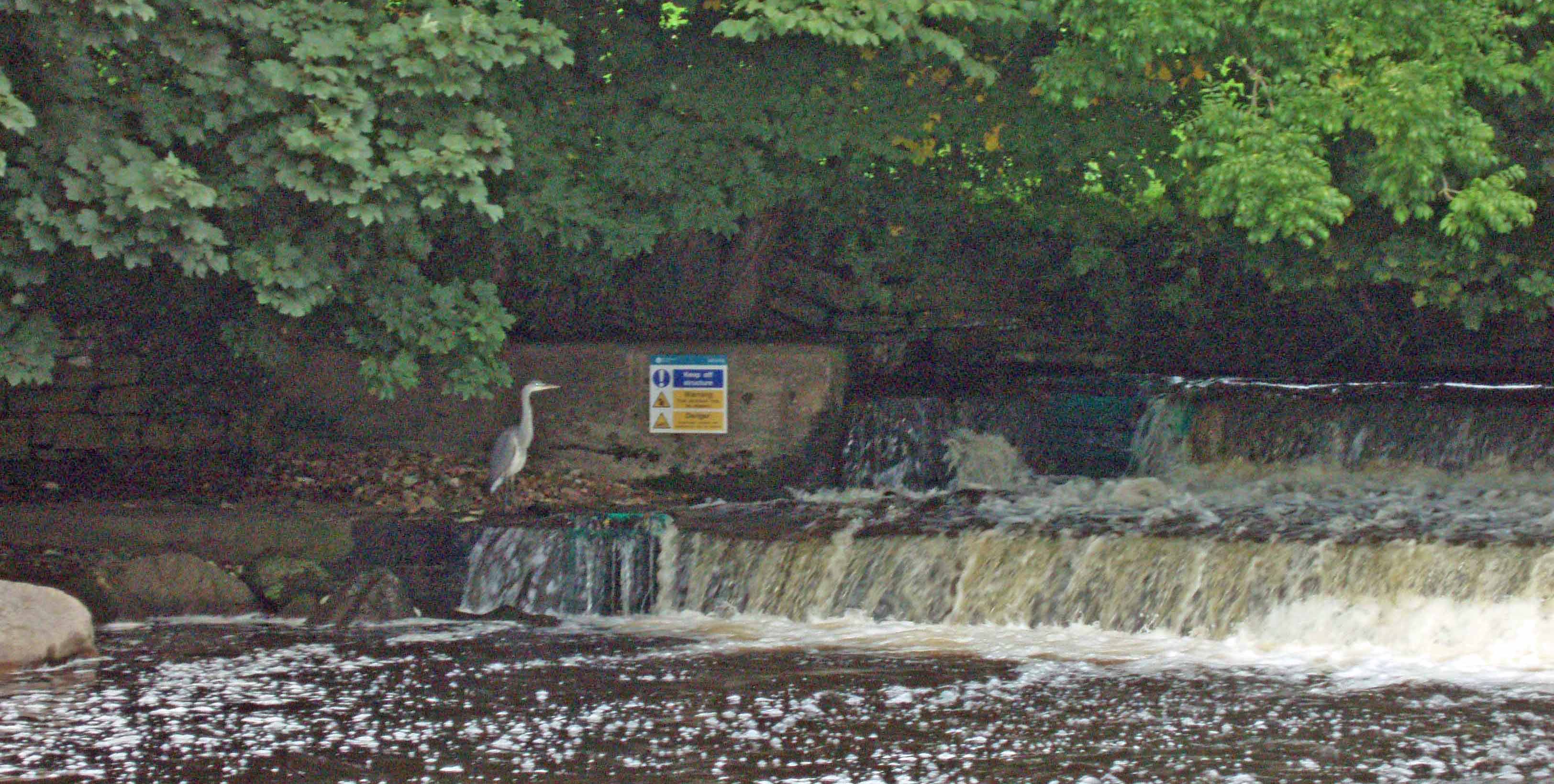 Right: Heron by the eel pass on Hornby weir
Right: Heron by the eel pass on Hornby weir
This is obviously a hazardous life. The Atlantic currents may
not gather the Sargasso Sea nutrients that eel larvae need. The Gulf
Stream may not bring the glass eels to our shores. Climate change
may be causing it to slow. No doubt there are predators galore in
the Atlantic that have adapted to the supply of food that has flowed
reliably for millennia.
If the glass eel reaches our shores, it faces pollution and all
sorts of barrier to its movement up our rivers. Within our rivers, it
faces our eel fishery industry, the most valuable commercial inland
fishery in England, according to the Environment Agency. If they
survive all that they have to try to travel all the way back to the
Sargasso Sea. And all the while the herons wait by Hornby weir.
It is probably no surprise, therefore, that the number of eels
in British rivers has declined - by more than 90% since 1970. The
European eel is now considered a ‘Critically Endangered’ species
by the IUCN. Critically Endangered is the highest risk category
and is used for those species that are facing an extremely high risk
of extinction in the wild.
In 2007 the European Union required all member states to
develop Eel Management Plans, the aim of which was to ensure
that the number of silver eels returning to the sea to breed was 40%
of its earlier level (which, for most river systems, is not known!).
A 2010 DEFRA document summarises the eel plan for NW
England [1].
Somehow this document concludes that “the available
evidence ... suggests that the rivers in the North West RBD [River
Basin District] are meeting the silver eel escapement target”.
The Lune is among the most healthy of northwest rivers but even here
eel numbers have fallen significantly. The report includes the
following surveys of the Lune:
sites surveyed eel found %
1991 134 94 74%
1997 74 47 64%
2002 75 32 43%
2007 45 17 38%
So, it seems that the proportion of sites where eel were found has
halved in just 16 years. But why has the number of sites surveyed
fallen from 134 to 45? Did they give up on sites where eel were not
found before? If so, perhaps the last row should really be:
2007 134 17 13%
This would mean that the proportion of Lune sites where eel were
found fell from 74% to 13%, that is, by 82%, in 16 years. In that
case, the Lune is doing about as badly as the general figure quoted
above, 90% since 1970. Moreover, the number of sites is not that
useful a measure. We really need to know how many eels there are
at each site.
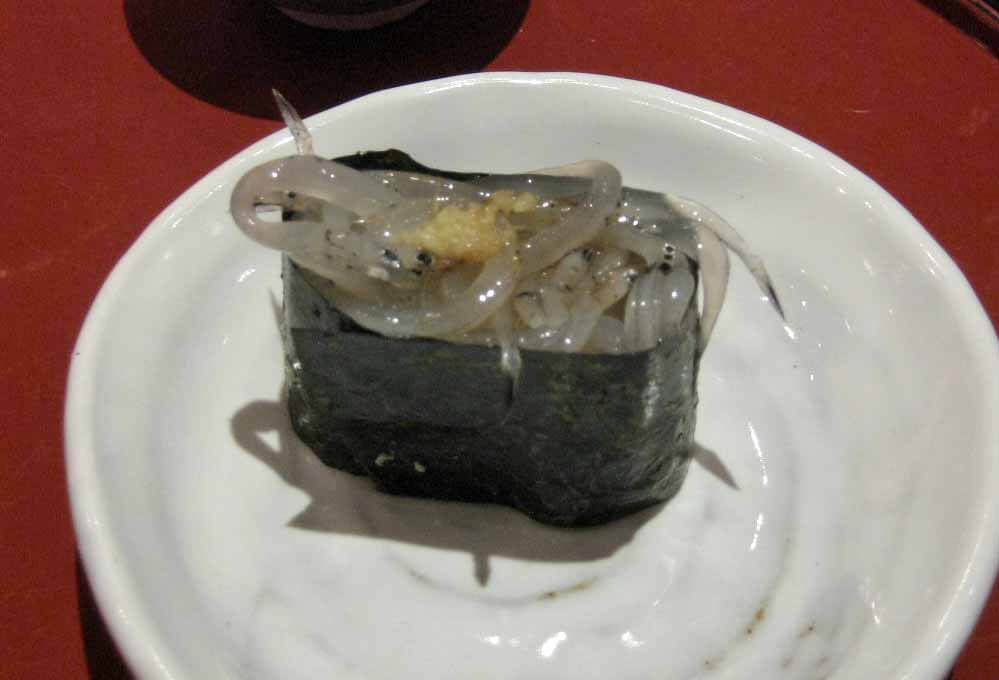 Right: A delicacy?
Right: A delicacy?
The document also includes some data on eel fishing within
the Lune region. Licences are issued for glass eel fishing and since
2005 eel fishers have to report the weight of glass eels taken. In
2007 43kg of glass eels were taken from the Lune (the report says
that this is likely to be an under-estimate). A glass eel is not very
weighty so 43kg sounds to me like a huge number of a supposedly
critically endangered species.
There is even commercial yellow and silver eel fishing on the
Lune, although the numbers taken (40kg in 2007) are, I suppose,
small. Many more eels are caught by recreational anglers but these
are supposed to be returned to the water.
The Environment Agency continues to allow eel fishing on the
Lune because “there is no evidence that the North West RBD is failing
the escapement target, and therefore no reason to restrict the eel
fisheries”. It seems to follow that there is also no reason to propose
more than modest measures within the 2010 Eel Management Plan
for the North West.
Perhaps this apparent complacency is reasonable. Maybe the
number of eels is subject to many arbitrary natural variations. In
2013 it was reported that the River Severn received ten times more
glass eels than it had in previous years; in fact, a hundred times
more than in 2009. There was no obvious explanation for this. (I’ve
heard no reports of a similar eel bonanza on the Lune.)
The most important consequence of this surprise influx was,
according to a Telegraph headline, to put “elvers back on the
menu” [2].
That’s a novel way to deal with a critically endangered
species - eat it.
[1]. DEFRA Report (March 2010), Eel Management Plans for the United
Kingdom: North West River Basin District, available on-line (or it was).
[2]. The Telegraph (May 9, 2013), Elvers back on the menu after the biggest
harvest for 30 years, European Eel Foundation.
9. Cattle on Fell End Clouds
October 2013
In August 2013 Natural England applied to the Planning
Inspectorate to erect a fence around Fell End Clouds. This was
after an earlier similar application had aroused the wrath of the
locals and had been withdrawn. Well, I like a good controversy, so
I thought I’d go to see what all the fuss is about.
Fell End Clouds lies between the slopes of Wild Boar Fell to the
east and Harter Fell to the west. The two slopes are patently very
different. Wild Boar Fell has a flat, craggy top and descends over
peat to the prominent outcrop of Fell End Clouds. Harter Fell is,
like almost all the Howgills, smooth and grassy. The slopes differ
because of the underlying geology. The top of Wild Boar Fell is
millstone grit. Harter Fell is of Silurian slate. The eastern rocks are
some 100 million years younger than those on the west, from which
they are separated by the Dent Fault.
Fell End Clouds is neither grit nor slate. It is limestone. Fell
End Clouds is a SSSI, like the more extensive limestone area of
Orton Scar, because of its geology and the flora that it gives rise to.
Looked at from afar, however, the flora seemed to consist of a lone
tree, standing prominently on the horizon.
 Right: The lone tree on Fell End Clouds
Right: The lone tree on Fell End Clouds
At closer quarters, I saw short grass with few flowers other
than low-lying yellow tormentil. Apart from grass, vegetation was
largely restricted to within the grikes of the limestone pavement.
The SSSI citation says that there are seventeen species of fern
growing here. I didn’t embark on a search for them in case I found
only sixteen, thereby causing myself endless sleepless nights.
The reason for the scarcity of flora outside the grikes is said to
be the high level of sheep grazing. The solitary tree must somehow
have escaped the attentions of the sheep but otherwise all scrub and
tree species have been unable to grow.
This is where Natural England comes in, or would like to, it
seems. Natural England is, according to its website, an “Executive
Non-departmental Public Body responsible to the Secretary of
State for Environment, Food and Rural Affairs”. I presume that
it is funded by the Department for Environment, Food and Rural
Affairs (DEFRA) and is therefore not independent of government.
Natural England’s purpose is “to protect and improve England’s
natural environment”.
In particular, Natural England is responsible for the welfare of
SSSIs, such as Fell End Clouds. Its proposed fence around Fell End
Clouds is intended to exclude sheep. It plans to graze a small herd
of native cattle instead. This, it contends, would enable the flora to
regenerate to a more natural state.
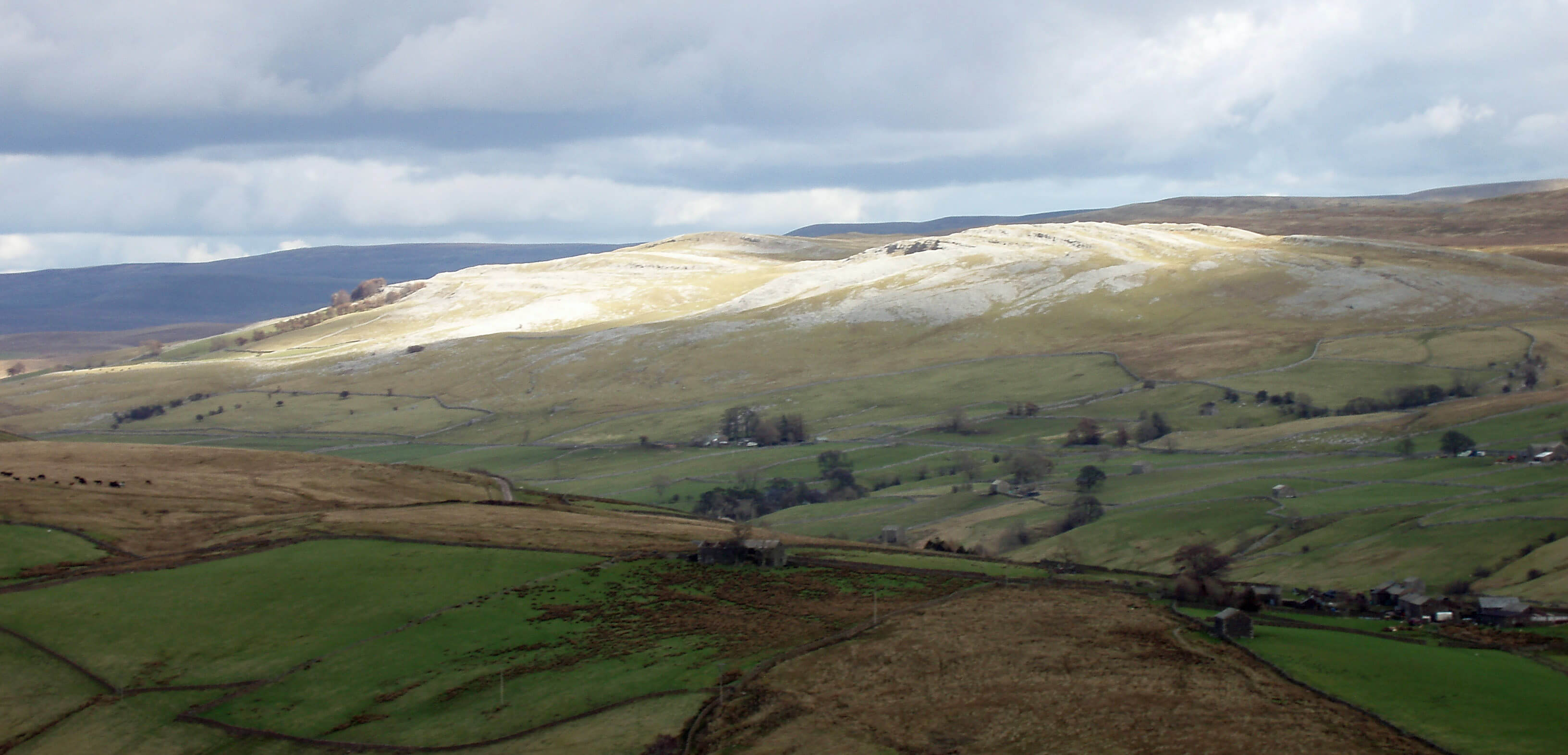 Left: Fell End Clouds
Left: Fell End Clouds
Fell End Clouds is isolated, with not much local community
near it - but what there is vigorously opposed the proposal, for
several reasons. First, the very idea of a fence was anathema. All
the boundaries in the region at the moment are of traditional dry
stone walls. Fell End Clouds itself has no walls to restrict the free
roaming of sheep and fell ponies.
It was feared that the proposed cattle would be hazardous to
walkers and would pollute the limited water supply that runs off
the fell. It was also argued that since the foot and mouth epidemic
of 2001 sheep grazing had already been reduced because subsidy
payments were no longer paid per head of stock. The flora was,
therefore, already regenerating (although this was not apparent to
me).
Harry Hutchinson, a local farmer, said “Natural England want
to see trees growing in the grikes between the limestone, but the
farmers think this will change the whole aspect of The Clouds,
which has been grazed for centuries” [1].
The fact that local farmers
were expected to pay (and be reimbursed later) for the fence and a
new cattle grid perhaps did not encourage a positive response.
The locals did not seem to query Natural England’s assertion
that cattle would be better for The Clouds than sheep, and perhaps
I shouldn’t either. However, I understand that the remarkable
flora of the Burren in Ireland, one of the most extensive areas
of limestone pavement in Europe, depends upon a distinctive
‘winterage’ cattle-grazing system that has evolved. Cattle graze the
lowlands in summer and are transferred to the limestone uplands
in winter. This is partly because of the lack of water on the uplands
in summer. The result, of course, is that the cattle are not grazing
when the limestone flowers and shrubs grow. I don’t know if a
similar regime is proposed for The Clouds.
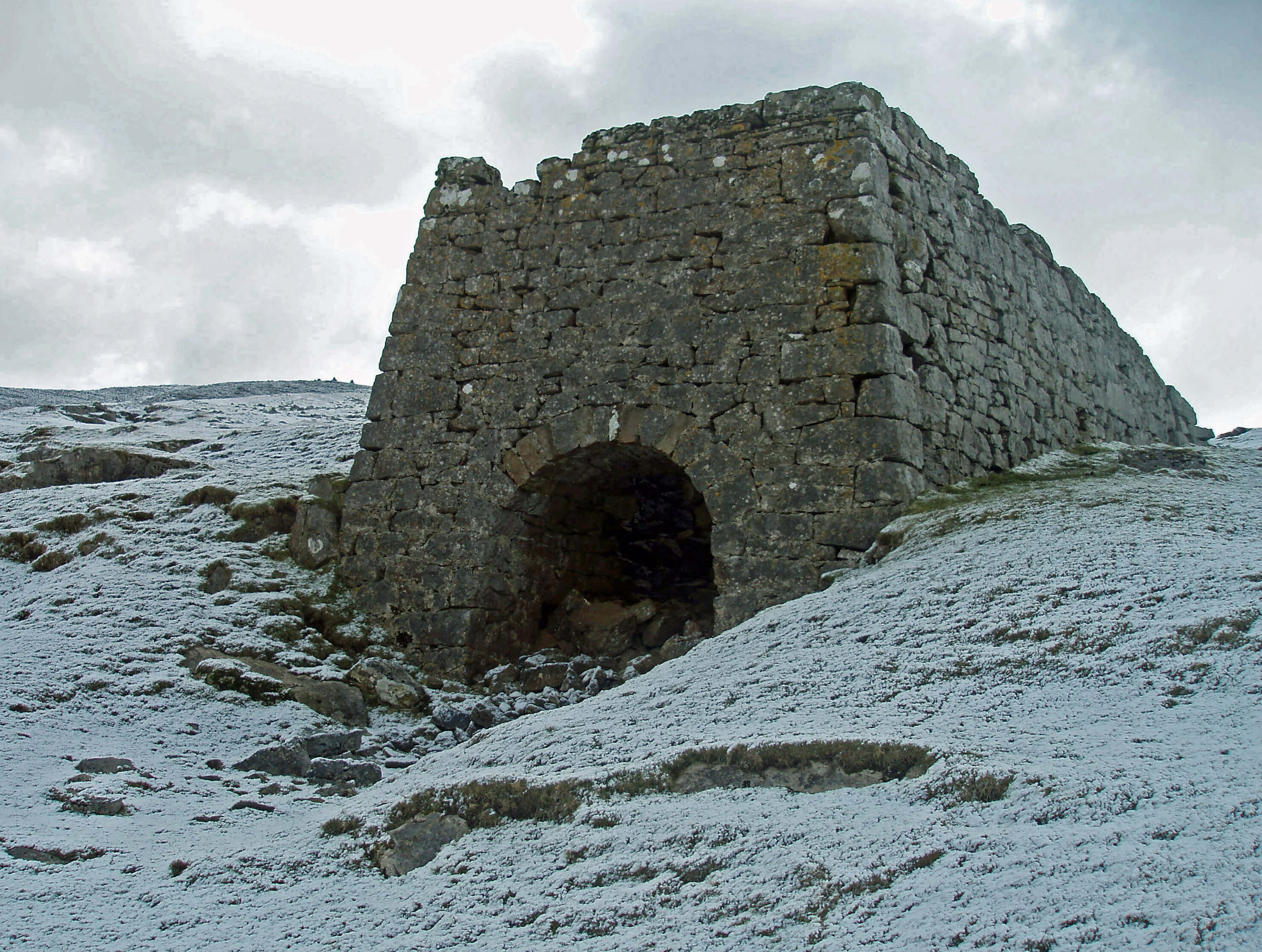 Right: Limekiln on Fell End Clouds
Right: Limekiln on Fell End Clouds
The crux of the matter is a basic question that we will no doubt
meet again: What is natural? Or, perhaps better, which form of
nature is to be preferred? And why? And by whom?
Is the lone tree on Fell End Clouds an aberration, an anomaly, an
accident? Is it unnatural for it to be there? Or is the rest of Fell End
Clouds unnatural? Should the tree really be part of a woodland of
similar trees growing unhindered from the grikes? (This particular
tree, a sycamore, should not be there but that’s another story: let’s
pretend it’s an oak.)
The appeal to ‘tradition’ is unconvincing. Dry stone walls are
not that old and are certainly not natural. Sheep may have grazed
here for centuries but that doesn’t mean that they will or should be
here indefinitely. A few centuries ago we had wild boar on Wild
Boar Fell.
Legally, it is, I suppose, up to Natural England to decide what is
natural. However, whatever criteria they use will be tempered by
the local reaction and that reaction will, in general, be influenced by
factors other than what is best for nature.
Personally, I doubt that Fell End Clouds is worth Natural
England engaging in a protracted dispute over. The locals will no
doubt disagree with that opinion but welcome the conclusion. In
my opinion, Fell End Clouds is an intriguing and attractive area,
enlivening this particular environment, but it is not a patch on the
limestone pavements of Orton Scars and the Yorkshire Dales.
Some people will find Fell End Clouds more interesting as a rural
industry wasteland than for its ‘naturalness’. There are the remains
of a quarry and some fine lime-kilns. The pavements themselves are
disfigured by several excavated trenches where various minerals,
such as galena for lead, were extracted. But industrial wastelands
are outside my scope, so I will leave it at that.
[1]. Cumberland & Westmorland Herald (December 19, 2012), Storm over
fencing plan for The Clouds.
10. Pink-Footed Geese in the Wyre-Lune Sanctuary
February 2014
What is the difference between a goose and a duck? I am
increasingly plagued by such naive questions - questions
that hadn’t bothered me much before, and questions that I
am embarrassed to realise that I cannot answer with any precision.
Perhaps it is unreasonable to seek precision. The meanings of
words such as ‘goose’ and ‘duck’ have evolved informally over
the centuries. They may not be the same for different people, at
different times, or in different places. Many birds called ‘goose’ in
the southern hemisphere are really shelducks. ‘Goose’ and ‘duck’
are not terms invented by us to have defined meanings, such as, say,
‘proton’ and ‘neutron’, where we may demand a precise distinction.
They are more like, say, ‘energy’ and ‘impulse’, everyday words
that scientists have co-opted and assigned precise definitions that
do not entirely accord with their everyday senses.
Perhaps I cannot do better than “geese are bigger than ducks;
geese honk, ducks quack; geese fly in formation, ducks don’t; male
and female geese look similar, male and female ducks don’t”. These
generalisations are only more or less true. I am coming to terms with
this unavoidable imprecision but I am flummoxed to discover that
the hallowed scientific classification scheme (kingdom, phylum,
class, superorder, order, family, subfamily, tribe, genus, species) is
not completely precise either.
When a species is defined scientists determine the salient
features that define it. Some other scientists, however, may consider
different features to be more salient for defining those species.
New data may become available, for example, from the study of
fossils. New features may be discovered, for example, from gene
analysis. After discussion and dispute, a new classification may be
agreed. So, the much-vaunted ‘tree of life’ has the odd property
that branches may be chopped off and grafted on elsewhere.
It seems that the classification scheme for waterbirds is in a state
of flux at the moment. The Anatidae family includes ducks, geese
and swans but not some waterbirds that look duck-like to me, such
as grebes and coots. This illustrates the well-known saying “if it
looks like a duck, it may not be a duck” (or something like that).
However, the definition of the Anatidae subfamilies, and
the species within them, is not agreed upon. Anatidae has been
suggested to have three or six or nine subfamilies. At the moment,
Wikipedia lists ten subfamilies.
One subfamily, Anserinae, contains
what I would think of as swans and geese. The others are various
forms of duck. Even now, several waterbirds, such as the mandarin
duck, are still swimming in the ‘unresolved’ pool.
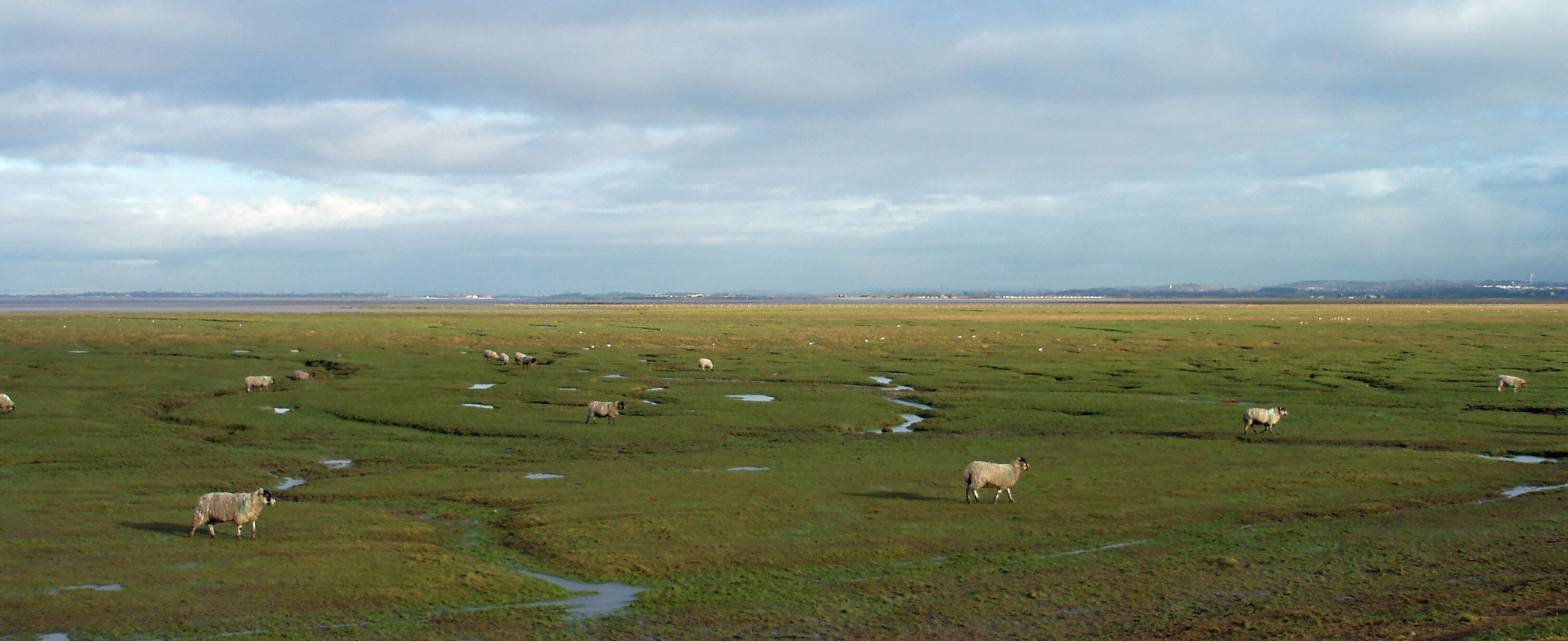 Right: The Wyre-Lune Sanctuary from Lane Ends
Right: The Wyre-Lune Sanctuary from Lane Ends
I have embroiled myself in this imbroglio because I planned an
expedition to the only wildlife sanctuary in Loyne, the Wyre-Lune
Sanctuary. This was established in 1963 and runs for some six miles
along the muddy sands between the Lune and Wyre estuaries.
The sanctuary provides a refuge for the many birds that
congregate in Morecambe Bay, especially the various species that
migrate here in the winter from places such as Iceland. As I couldn’t
enter the sanctuary, I anticipated viewing the region from its fringes
and therefore focussing upon the larger species (the swans and
geese), ignoring for the moment the ducks (which is just as well
given their confused status), gulls and smaller sea-birds.
That, I thought, would be enough for me to cope with. Three
species of swan and nine species of goose have been seen in the
region. Of these twelve species,
* three are resident: mute swan Cygnus olor, Canada goose Branta
canadensis and greylag goose Anser anser;
* four are common winter visitors: Bewick’s swan Cygnus
columbianus, whooper swan Cygnus cygnus, pink-footed goose
Anser brachyrhynchus and white-fronted goose Anser albifrons;
* five are uncommon, scarce or vagrant visitors: barnacle goose,
bean goose, brent goose, Egyptian goose and snow goose
(who should visit more often if they want me to give their
Latin name).
I was unlikely to see any of the last set, so that left just seven species
(three swan and four goose) for me to tackle.
I was particularly intent on spotting the pink-footed goose,
which I had not knowingly noticed before. I understand that the
noisy arrowheads that adorn our winter skies are of pink-footed
geese (the ‘pink arrows’ perhaps) but I cannot see their pink feet
way up there. The pink-footed geese come in their hundreds to
bask in the warmth (relative to Iceland) of a Lune estuary winter. I
wanted to see them before they returned to Iceland, misled by our
unseasonably mild weather so far this year.
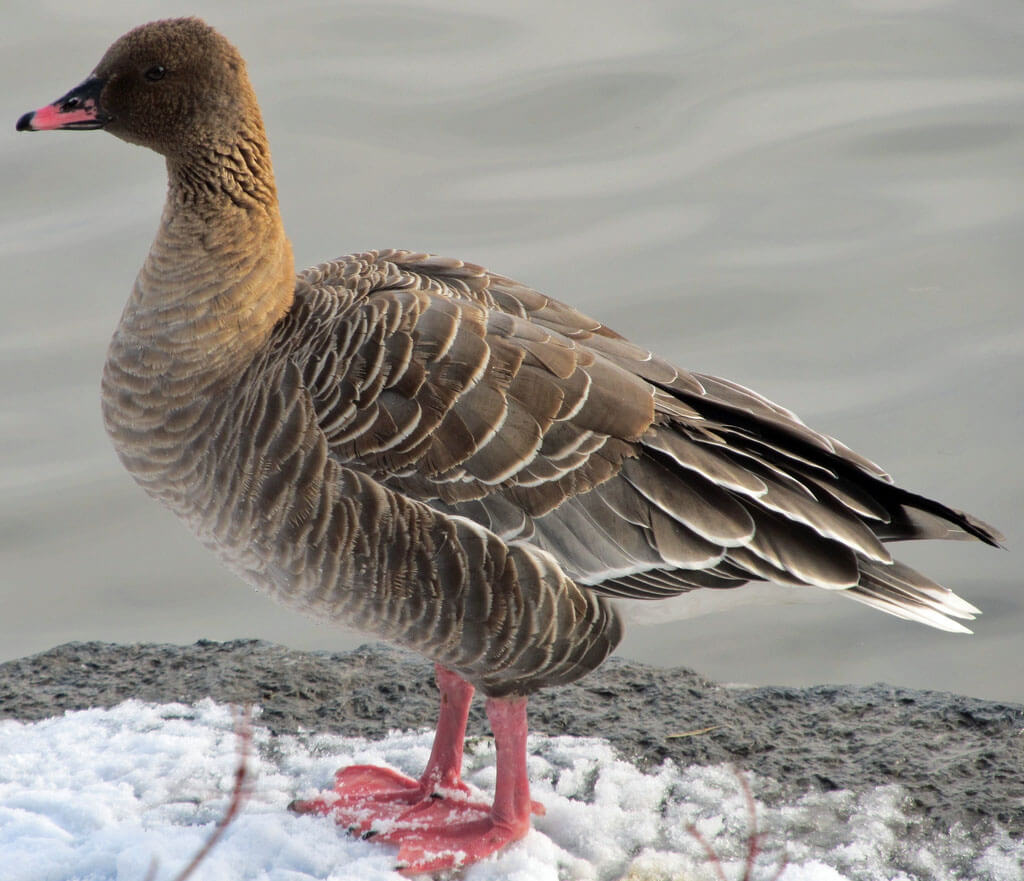 Left: Pink-footed goose (Greg Froude)
Left: Pink-footed goose (Greg Froude)
I was confident that pink-footed geese were in the Wyre-Lune Sanctuary because I had been following the blogs of local
birdwatchers [1].
These are fearsomely authoritative: “There were a
few waders on the beach including 86 Oystercatchers, 114 Sanderlings
and 50 Grey Plovers ... On
the telegraph wires were
224 Starlings and in one of
the fields 207 Black-headed
Gulls ... Our totals included
216 Pink-footed Geese north,
11 Common Scoters west, 32
Cormorants, ...”.
There’s no hint of doubt as
to the species of bird and an
unchallengeable precision in
the numbers. 216 pink-footed
geese! I sometimes have a
few pheasants in the garden. It is not easy to count them as they
insist on moving about and hiding in the shrubbery. How do they
count 216 geese? Perhaps they take a photograph and pore over it
at night. Perhaps there’s something like the Photoshop ‘red eye’
software that counts birds’ eyes.
The seemingly effortless expertise of these birdwatchers has
been developed over decades of experience that I have sadly
missed. One RSPB officer says that he “could identify all of the
birds in his father’s Handbook of British Birds before he could read” [2].
I assume that he means that he could identify them in the book, not
in the wild. It would be a prodigious achievement for a toddler to
travel the land identifying Dartford warblers, great northern divers,
Scottish crossbills, and about 250 more.
I picture his father reading to him at bedtime: “red-breasted
merganser, melodious warbler, long-tailed skua, Balearic shearwater,
...”. It would certainly soothe me to sleep but obviously not our RSPB
officer-to-be. Rather unfairly, my parents’ ornithological expertise
ended with “Goosey goosey gander, whither shall I wander” (what
sort of a rhyme is that?).
I arrived at the Lane Ends amenity area, near Pilling, to find two
birdwatchers already at their stations. They were silently scanning
the muddy marshes not with binoculars but with telescope/cameras
on tripods. Their gear had an infinity of knobs and dials. Is there
any activity that doesn’t become expensively serious to some?
I joined them, at a safe distance.
The waters of Morecambe Bay were far distant. The marshes
and then mud seemed to continue unbroken to the Lake District
hills, which were barely discernible in cloud. The Heysham to
Isle of Man ferry seemed to glide miraculously over the mud. A
helicopter hovered mysteriously some miles out, stationary just a
few yards above the mud. The scene was dominated by the glinting
white of the Heysham power station.
There was no sound of the sea. Normally, at the seaside, we
expect to hear at least a gentle rhythmic shish as the waves run up
and down the sand or gravel. Here, there was no sign or sound of
the movement of water. The marshes, of course, had their pools.
Sheep wandered over the drier parts. As you’d expect of a sanctuary,
there was no sign of human activity, now or past. No fishermen, no
dog-walkers, no abandoned boats, no buildings. At the landward
side of the salt-marshes stood the Pilling embankment, which is
certainly a sign of human activity. It was built in 1981 to protect the
low-lying land of Fylde.
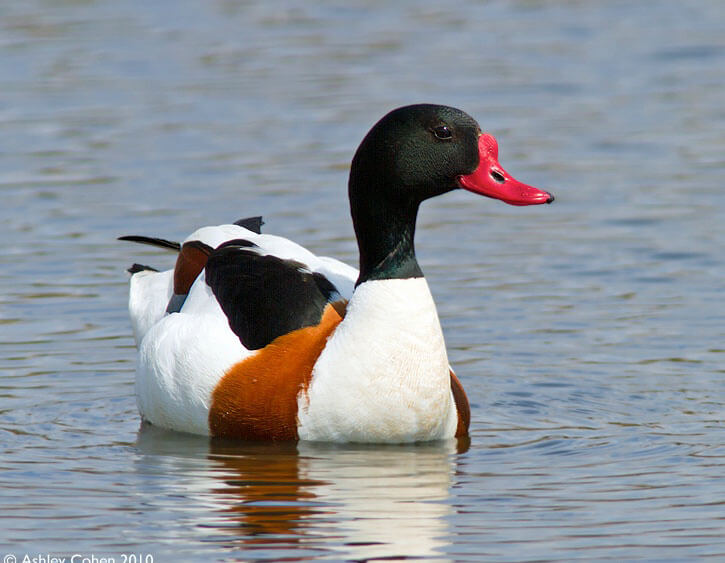 Left: Shelduck (Ashley Cohen)
Left: Shelduck (Ashley Cohen)
I focussed upon the birds.
There were many of them, of
many species. I did not allow
myself to be overwhelmed. I
noticed a little egret, startlingly
white on the green marsh. The
majority of nearby birds were
(I found, after surreptitiously
consulting my guide)
shelducks Tadorna tadorna. I
don’t suppose experienced
birdwatchers get excited by
shelducks. I wouldn’t say that
I was excited exactly but they
looked, to me, rather fine birds
to be able to put a name to.
Far off, half-a-dozen, possibly pink-footed, geese rootled in the
marsh. After a while, I thought I’d move on in the hope of finding
some closer geese, but I was halted by an approaching kerfuffle in
the sky. A couple of hundred geese flew noisily over and, joined by
others, settled at the muddy edge of the marsh, on, I suppose, the
banks of the Lune. They were closer than the half-a-dozen but still
too far away for a beginner to identify. If they weren’t pink-footed,
then they should have been. I am not going to get neurotically
frustrated at being unable to be certain in my identifications. It
doesn’t really matter what they were: it was a delight to hear and
see them all fly over, as if on cue.
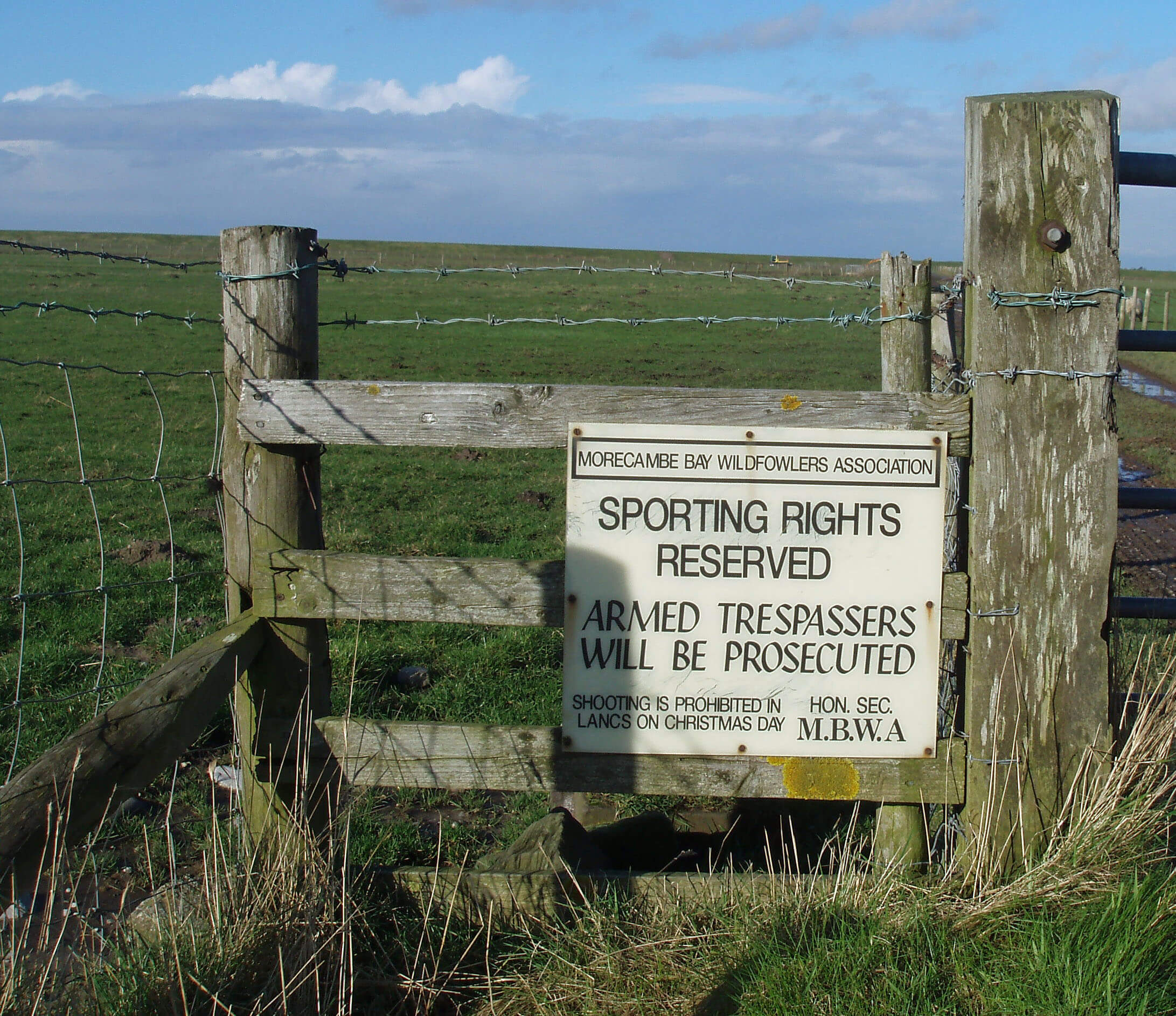 Right: Beware armed trespassers
Right: Beware armed trespassers
On the drive to Lane Ends I had passed a field with about fifty
swans in it. I went back to have a proper look at them. At the gate
I saw the notice shown to the right. I wasn’t sure if it meant
that unarmed trespassers would not be prosecuted but I decided
not to chance it. The Morecambe Bay Wildfowlers Association is
a new one to me but I don’t
think they are a body I wish to
have a disagreement with.
I studied the swans intently.
Again, I would not bet my
house on it, but I’d say they
were whooper swans. They
did not have the black knob on
the bill that distinguishes the
mute swan so they were either
whooper swans or Bewick’s
swans. They seemed fairly
large and with the straight
neck more characteristic of the
whooper.
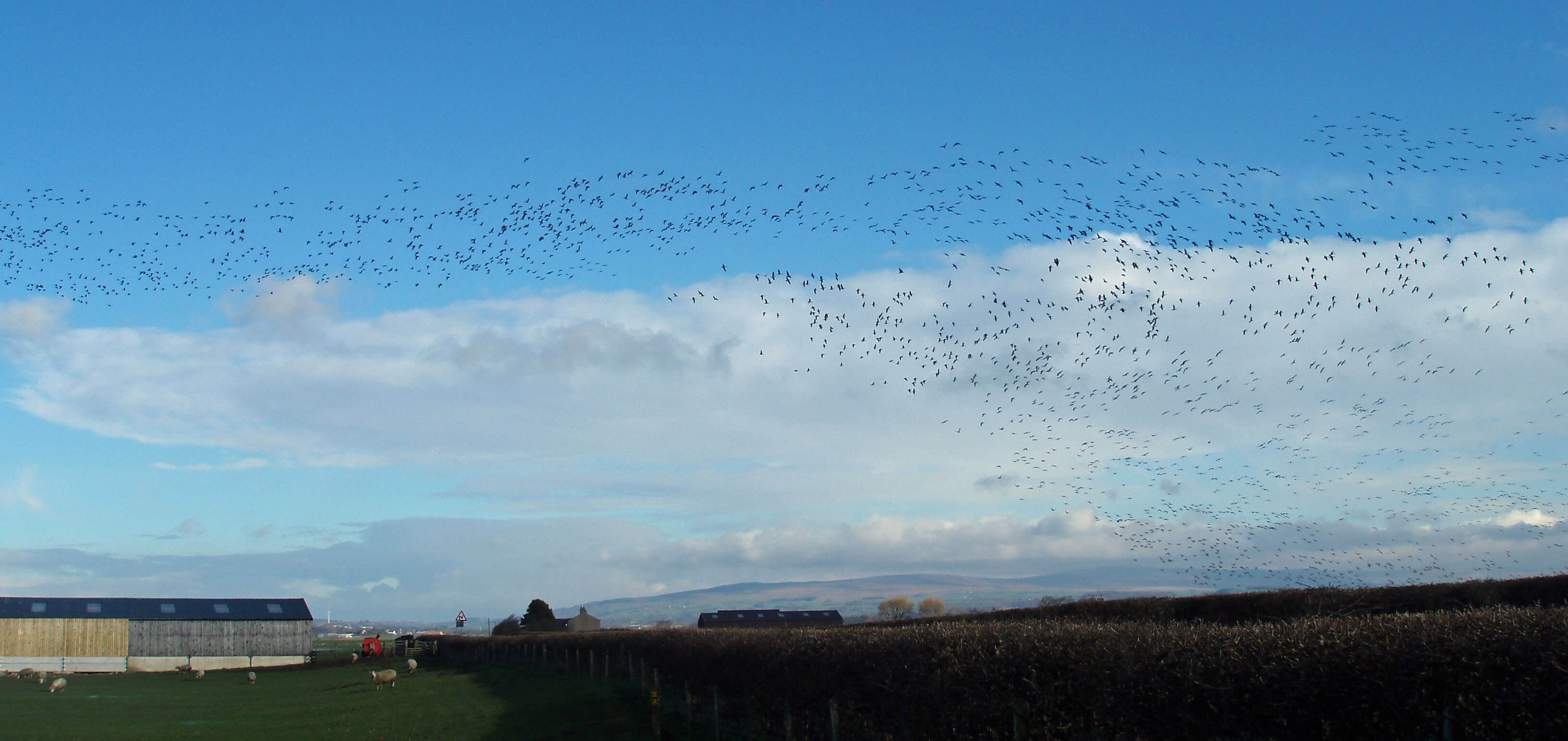 Left: A swirl of geese
Left: A swirl of geese
As I stood at the gate,
another crescendo of hoots and honks approached from the south.
Hundreds, perhaps thousands, of geese swirled about, occasionally
forming lines or Vs, and then disbanding. For several minutes,
the flocks broke up and re-formed, as if unsure of their objective.
Eventually, they moved out over the bay.
Perhaps this performance is a daily occurrence, unremarkable
to the locals, but to me it was all most impressive.
I thought I’d
have my sandwiches by the marshes at Patty’s Farm so that I could
keep an eye on the skies over towards Pilling.
I was treated to a performance by three kitesurfers off the
Bank End caravan park. Their sails looked like huge birds of prey
swooping over the bay. I couldn’t see the water they were surfing
on but occasionally the brisk wind whisked them up in the air and
they landed with a splash. They swung around gracefully - but
nowhere near as gracefully as the many flocks, of different sizes
and shapes, that continued to swirl around over the flat horizons
of Pilling. I didn’t need to identify the birds in order to appreciate
their display. I will return - but not with a telescope/camera with
an infinity of knobs and dials, I fear.
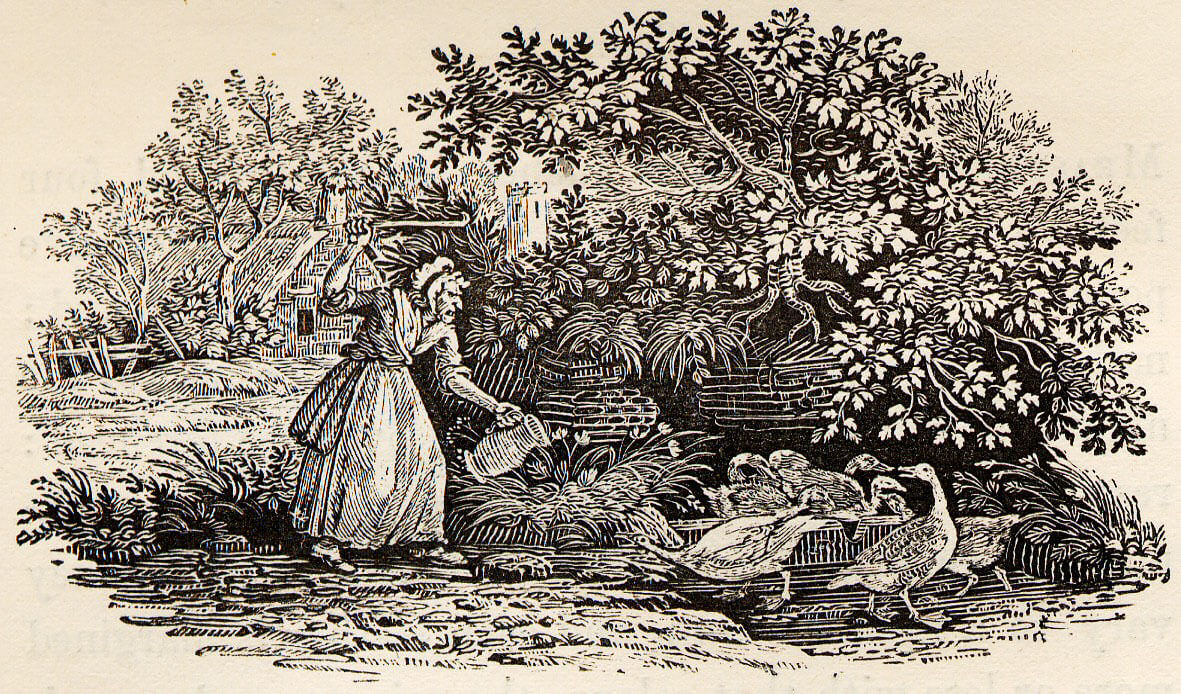 Right: Bewick’s ‘old woman and ducks’
Right: Bewick’s ‘old woman and ducks’
I also ask myself questions born of inquisitiveness as well as
naivety, such as: Who, what or where is the Bewick of Bewick’s
swan? This question has led me to learn that the swan
is named after Thomas Bewick (1753 - 1828), who wrote A History
of British Birds, published in two volumes (1797, 1804). This book
is now regarded as the forerunner of all modern field guides for
British birds. In fact, a colleague with whom Bewick had a fractious
collaboration wrote some of the words of the first volume but never
mind the words, it is the wood engravings that make the book
special.
At that time book illustrations had, of course, to be engraved.
Bewick revolutionised the art of wood engraving and a measure of
his reputation can be gained by the references to him in Charlotte
Brontë’s Jane Eyre and in a poem by Wordsworth (“Oh now that the
genius of Bewick were mine, And the skill which he learned on the
banks of the Tyne ...”).
He possessed a profound knowledge of the birds themselves,
as he would need to in order to produce such detailed engravings.
He disliked London; he campaigned for the fair treatment of
animals; and he thought war pointless. William Yarrell, an English
zoologist, named the swan in his honour in 1830 but perhaps the
swan should feel more honoured to be named after a gentleman
with such worthy views.
Bewick sometimes engraved his own thumb-print into his work,
which is a neat joke. He also often included ‘tail-pieces’, that is,
small, detailed, sometimes humorous, engravings, to fill up spaces
at the ends of his sections. One (‘old woman and ducks’ - though
they could be geese!) is shown to the right.
[1]. Birdwatching Lancashire
is a kind of meta-blog. It
aggregates posts from various other blogs about Lancashire birds.
[2]. Adam Marek (Winter 2013), The wetland wizard, Nature’s Home, The
RSPB Magazine.
11. Purple Saxifrage on Ingleborough
March 2104
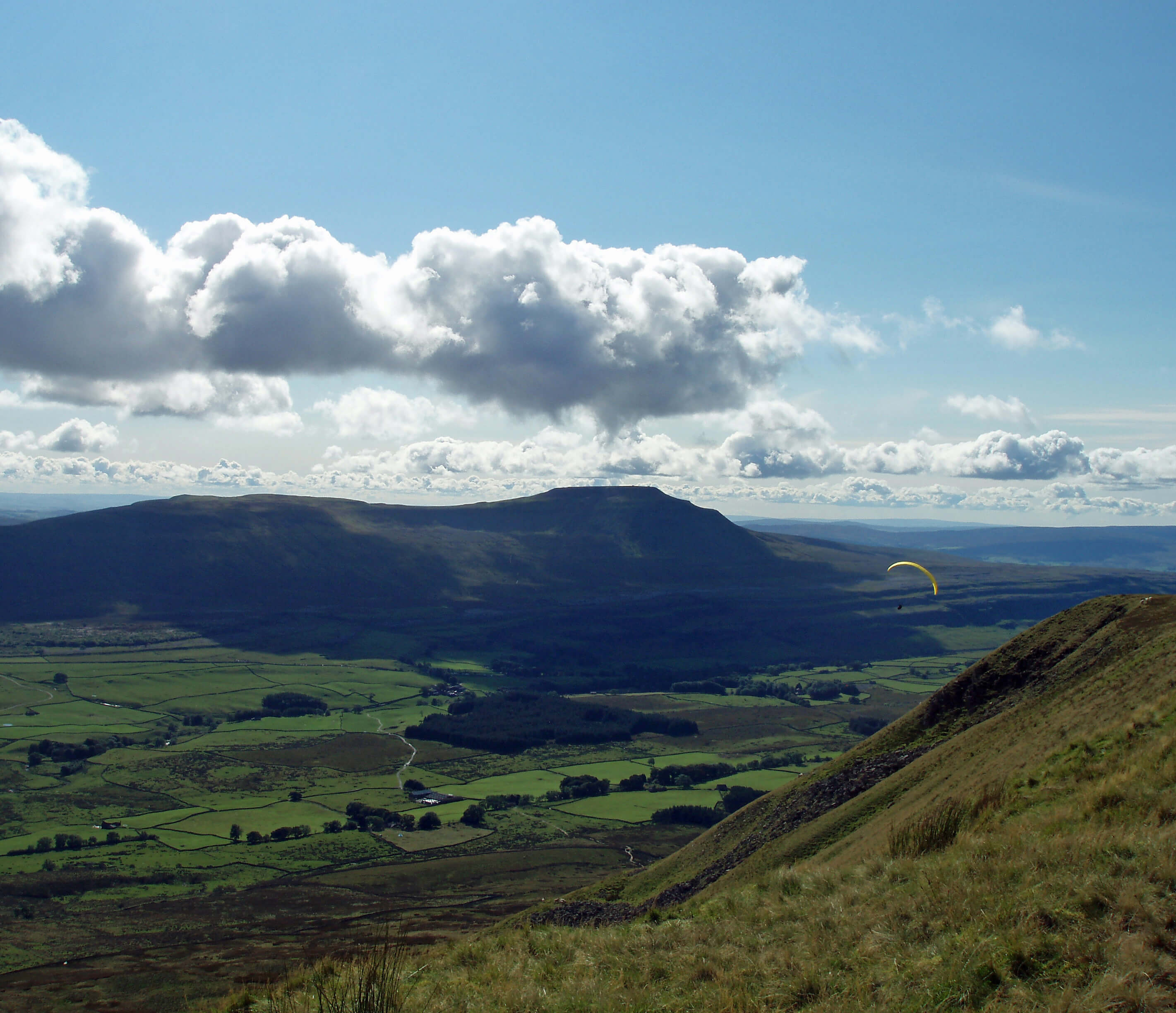
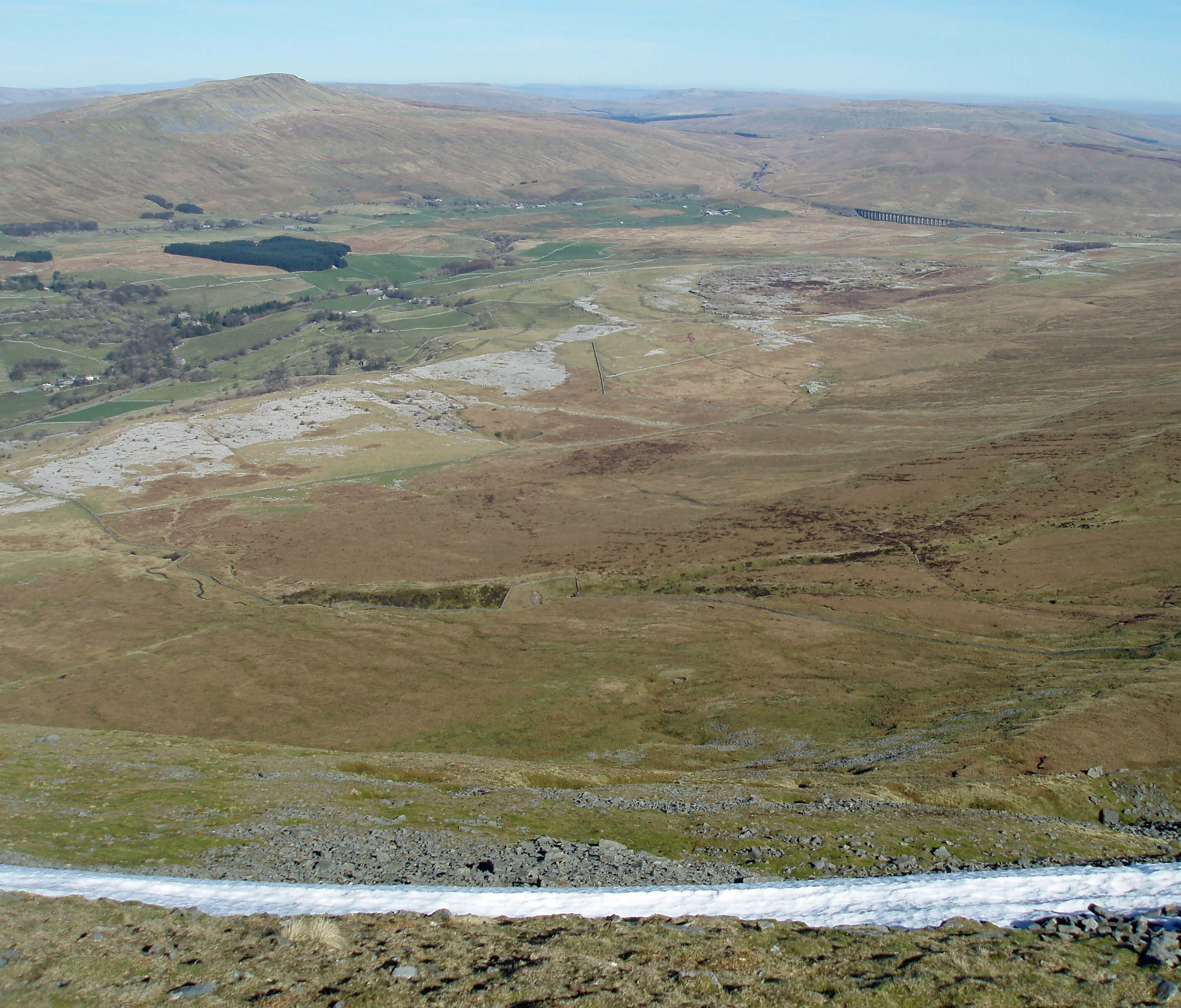 Left: Ingleborough from Whernside
Left: Ingleborough from Whernside
Right: Whernside from Ingleborough
A fine 265-page book on Ingleborough includes an index that
mentions only one species of wildlife, the red grouse [1].
So I am not alone in (up till now) neglecting the wildlife of the region.
The book, the subtitle of which is ‘Landscape and History’,
focusses upon the geology, archaeology and human activities
within the Ingleborough region. It says that “it is the first book to
adopt a fully holistic approach to Ingleborough” and that it creates
“what is in essence the biography of a mountain”. And yet, while a
‘biography’ is an account of a life, this ‘fully holistic approach’ (that
is, one that considers the whole thing) ignores the wildlife of the
mountain. The grouse, incidentally, earn a mention through being
participants in a shooting enterprise based at Ingleborough Hall in
Clapham that ran from 1830 to 1884 and from 1922 to 1948, until the
grouse inconsiderately disappeared.
Landscape is a slippery concept. According to the dictionary,
the word was introduced to the English language in the 16th
century from the Netherlands, where it was a painter’s term for a
view. Painters tend to prefer to paint views that are picturesque
and it therefore became assumed that landscapes were picturesque
too. More recently, however, a landscape has been understood to
include all components of a view, whether natural or man-made,
whether aesthetically appealing or not.
Whatever the subtleties of its meaning, a landscape usually
implies a long-distance view, such as that shown in the photographs
above. Any long-distance view of or from
Ingleborough will, of course, include some geology and perhaps
some buildings or other signs of human activity but it will be
dominated by the flora - at least, by the general impression of its
greenery. However, a long-distance view, and hence a landscape,
will not include the details of individual wildflowers, say.
The flora of the region around Ingleborough embodies aspects
of its history, which the book seeks to describe. One needs only to
look at the slopes of Ingleborough to wonder: red grouse? Grouse
need heather. Where’s the heather? If it was here, what happened
to it?
Looking at the photographs, other questions arise. Why is the
limestone pavement unnaturally exposed? (Having visited Orton
Scars and Fell End Clouds we may anticipate the answer.) And
those trees across the valley near Chapel-le-Dale - are they conifer
plantations incongruously stuck on the slopes of Whernside?
When were they put there? Why? These, however, are questions
for another day. I was off in search of an aspect of the flora that is
evidence of Ingleborough’s past, being a relict of the days after the
ice receded.
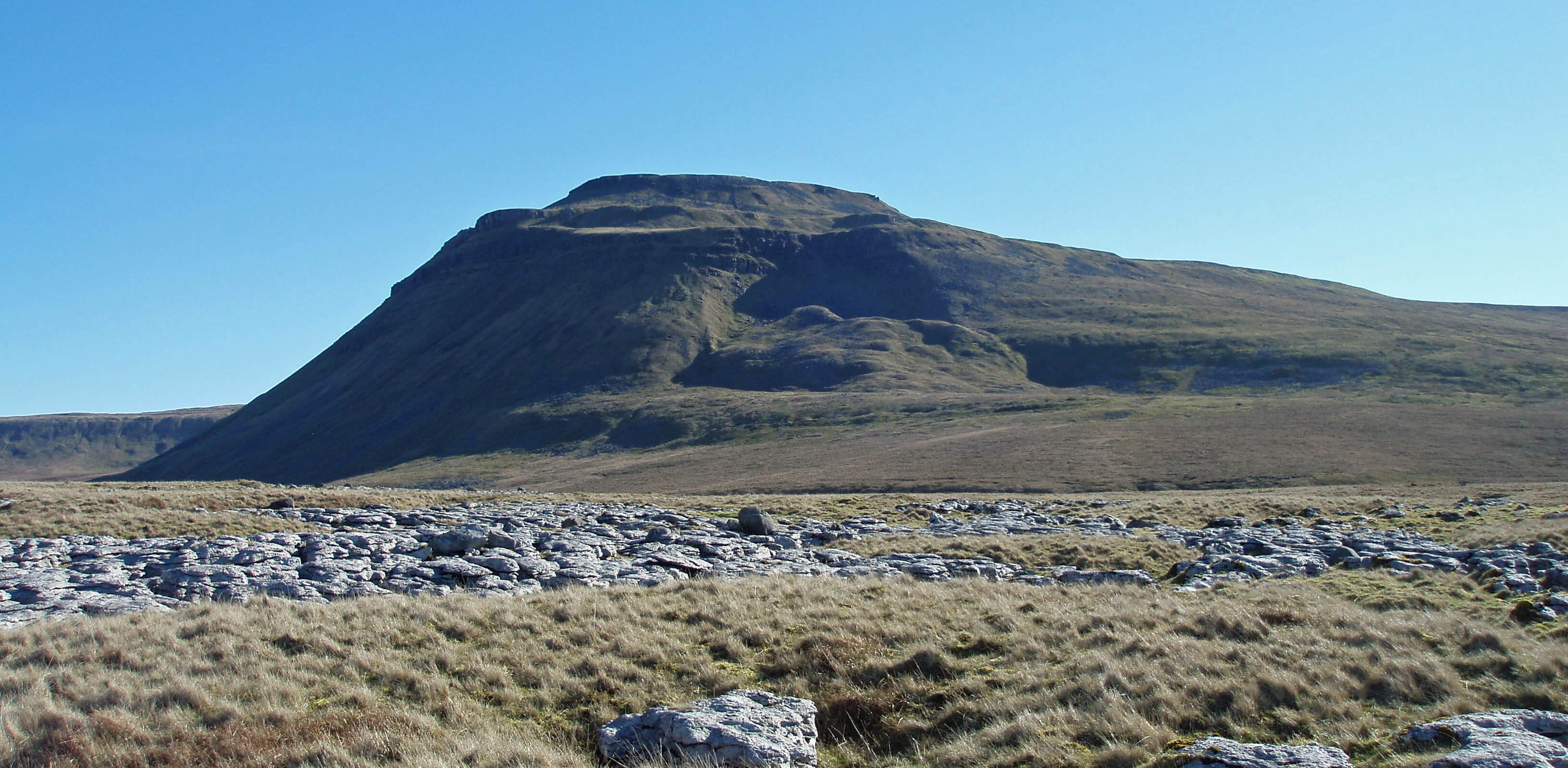 Left: The old landslip on Ingleborough
Left: The old landslip on Ingleborough
I have walked up Ingleborough several times but never before
with the prime objective of finding a flower. Normally, I follow
the standard paths up from Ingleton, Chapel-le-Dale, Clapham or
Horton but those paths do not take me close to my target. This, the
Arctic-Alpine flower purple saxifrage Saxifraga oppositifolia, grows
at a height of 500m or so on the steep limestone scars north-west of
the millstone grit top of Ingleborough. As far as I know, it grows
nowhere else in the Loyne region.
The steep slopes, shown in profile in the photograph to the left,
have the appealing name of Black Shiver. I intended to tackle them
head-on, with a frontal assault from Raven Scar across Tatham Wife
Moss. That way, I figured, I was bound to cross the 500m contour
somewhere.
That was the plan, but I thought better of it. From directly below,
the dark cliffs presented a formidable barricade and the huge old
landslip, picked out by the morning shadows, did not inspire trust
in the stability of the mountainside. So I scrambled up to the right
and contoured below the limestone cliffs.
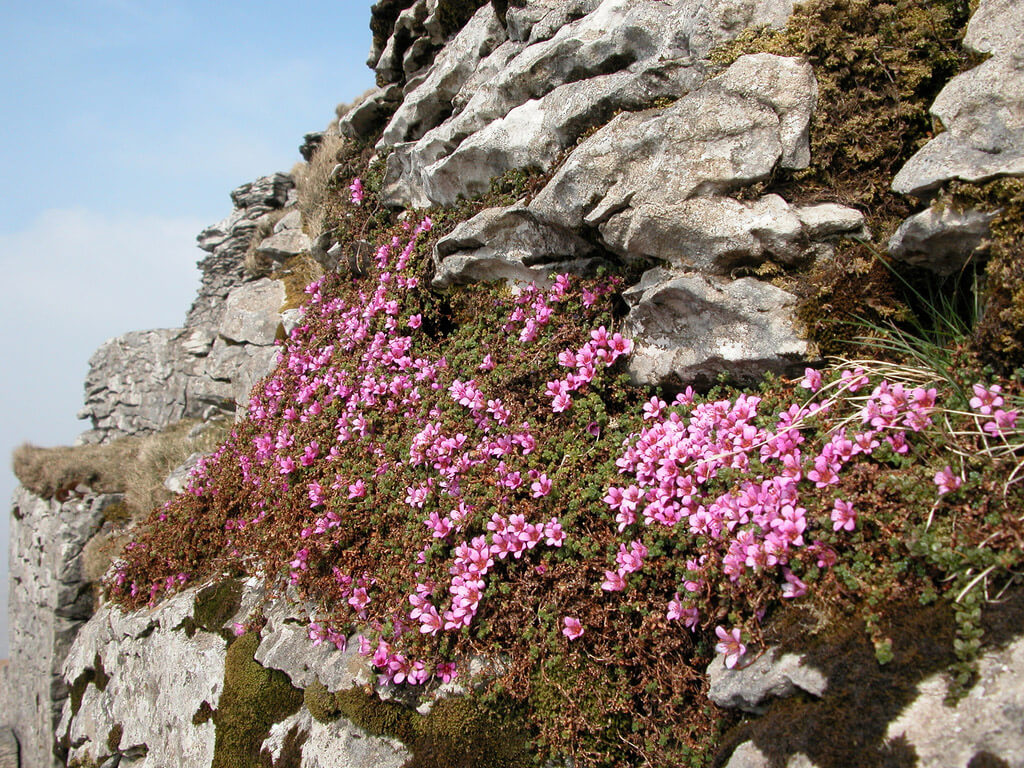 Right: Purple saxifrage on Ingleborough (Brian Rafferty)
Right: Purple saxifrage on Ingleborough (Brian Rafferty)
Yes, I did find purple saxifrage - but it was not yet very purple.
I had thought that the mild winter, with very few days of snow on
Ingleborough, would have brought the flowers on early. However,
the flowers were only just beginning to open (March 11). I did not
see the purple profusion shown in the photograph. Indeed, I don’t
think I saw enough purple saxifrage with the potential to produce
such a display! Next time, I will visit a little later in the year.
Purple saxifrage is obviously a tough plant. The low-growing,
densely-matted dark green leaves cling to the rock crevices to
withstand the elements. Even on the first warmish day of spring
a cold wind kept ice in pools on the mountain slopes. The vivid
purple flowers, when fully open, are larger than the leaves, with five
petals from within which purple stamens protrude. The saxifrage
survives, no doubt, because on the vertical scars it is safe from the
boots of walkers and the mouths of sheep.
I sat for some time perched below these cliffs, contemplating
the significance of the purple saxifrage, admiring the view across
to Whernside and the Lake District hills, out of sight of the many
walkers toiling up the standard paths to the top of Ingleborough
- most of whom will be (like me, until recently) oblivious of the
existence of the purple saxifrage.
The plant is common in the high Arctic, the Alps and the Rocky
Mountains, where it is welcomed as the first plant to flower in spring,
often emerging through snow. In some northern communities, the
flowers are eaten, used to make tea, and taken as a herbal medicine
(the Latin word saxifraga means ‘stone-breaker’, from, it is thought,
its propensity to break down kidney stones rather than its ability to
grow within rock crevices). Purple saxifrage is said to grow further
north than any other flower, at 83°40’ on Kaffeklubben Island off
Greenland.
Amazingly, we still have a little bit of the Arctic within Loyne.
[1]. David Johnson (2008), Ingleborough: Landscape and History, Lancaster:
Carnegie.
12. Sand Martins by the Lune
April 2014
In April each year, as I walk along my local stretch of the River
Lune between Bull Beck and the Crook o’Lune, I keep an eye
open for the first sand martins of the year. It is not a systematic
search for the very first sand martin: I just want to be able to say
that “the sand martins are back”, as some reassurance that the
natural world is still functioning. Of the many signs of approaching
summer - butterflies, bees, chiffchaffs, daffodils, skylarks, ladybirds,
blossom, ... - I prefer to adopt the sand martin because its return is
most closely associated with the Lune.
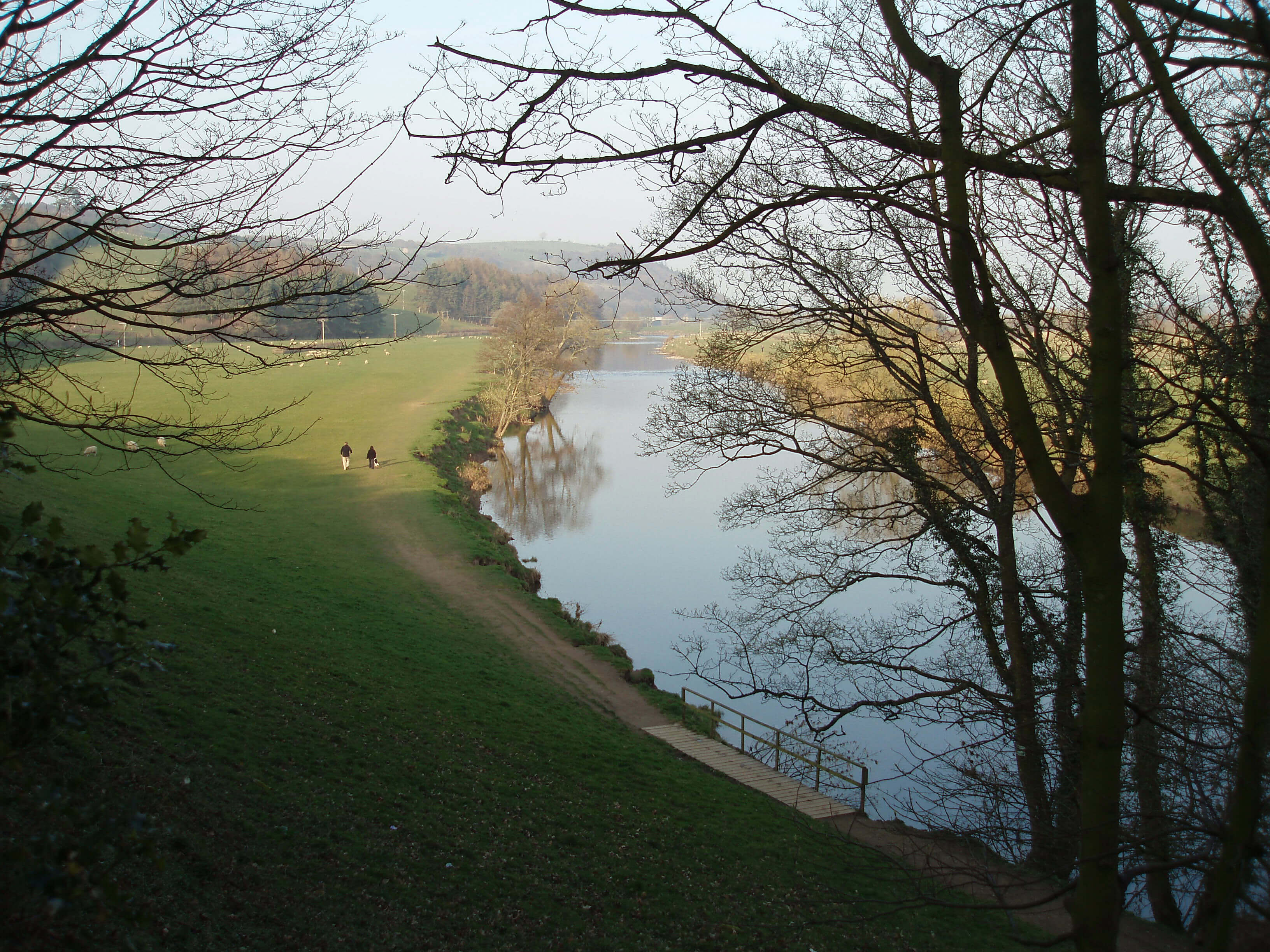 Left: The River Lune from the Crook o’Lune
Left: The River Lune from the Crook o’Lune
We all have irrational likings for particular birds unless
birdwatching is an obsession (to count 216 pink-footed geese) or
a competition (to see as many species as possible). I thought that
my attitude to birds might be reinforced by the book How to be a
bad birdwatcher, which I have rather belatedly come across [1].
It has plenty of welcome advice: don’t buy expensive equipment; don’t
dash to the Shetlands hoping to spot an exotic bird; don’t expect to
see the differences between all the warblers ...
I was brought to a halt on page 47 when I read that the author,
Simon Barnes, was, as a boy, a member of the RSPB’s Young
Ornithologists Club. This is almost on a par with our RSPB officer
who could identify all the birds before he could read. I was never a
member of this club. Nor was anyone I knew. I doubt that any of us
had heard of the RSPB’s Young Ornithologists Club. Ornithology
did not exist on our council house estate. I don’t remember anyone
talking about watching birds.
And yet ... the first school prize I ever won (at the age of eight)
was The First Ladybird Book of British Birds and their Nests. I still have
it, as a memento not as a source of information. It briefly describes
24 birds, from yellowhammer to black-headed gull, for some
reason. Sadly, the book did not inspire a lifelong love of birds or
even prevent a nearly-lifelong disinterest in birds.
By my standards, Simon Barnes is far from a ‘bad birdwatcher’.
He knows a lot more about birds than he pretends at the start of his
book. By page 148 he is admitting that he has identified 80 species
in one morning at Minsmere.
After the revelation on page 47, I felt patronised by a
know-(almost)-all. “You probably know a mallard, and maybe a tufted
duck”. Of course I bloody know a mallard, even if I can’t manage
80 species in a morning like you. I’m sorry about the ‘bloody’: I
have been contaminated by How to be a bad birdwatcher, which has
surprisingly many of them.
Back to my sand martins. Every spring they return here from
their winter sojourn south of the Sahara. The least I can do is
welcome them back. They come to nest in the tunnels they build in
the banks of the Lune. Sand martins also nest in artificial tunnels
such as drainpipes placed in walls for their benefit but their natural
home is in river-banks, as is insisted upon in their scientific name
Riparia riparia and even more so in our subspecies, Riparia riparia
riparia (the Latin ripa means ‘river-bank’).
This year the sand martins may have beaten me to it. I saw a
couple on April 1st. Last year, after the long cold winter, I didn’t
see sand martins until April 20th. In 2011 their return on April 9th
coincided with a flood that put all their tunnels underwater, which
annoyed them somewhat. Perhaps this year the birds were blown
here by the southerly wind that has deposited Sahara sand over us,
to the fascination of the news media.
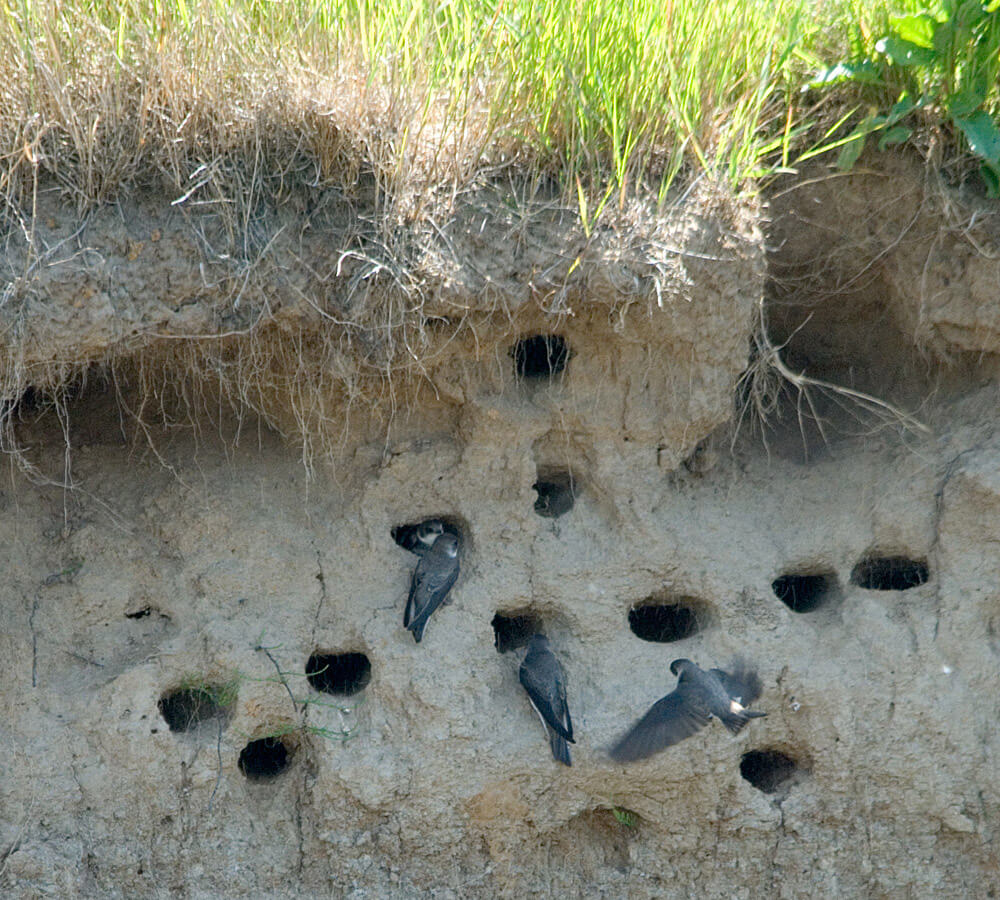 Right: Sand martins (Sergey Yeliseev)
Right: Sand martins (Sergey Yeliseev)
The guidebooks say that sand martins return to the same location
every year but I doubt that is completely true. The new Brockholes
Nature Reserve near Preston built a special ‘sand martin wall’ and
it was colonised by returning sand martins within months. Clearly,
those sand martins were not there the previous year.
If a sand martin returns to the same general region, does it nest
in the same tunnel as previous years? The guidebooks imply so but
again I doubt that it is really the case. When a sand martin born
beside the Lune last year returns as a one-year-old it cannot nest
in the same tunnel as its parents. I have not noticed any unseemly
family squabbles over domiciliary rights. The one-year-old or
parents must find a different tunnel.
A one-year-old sand martin would surely prefer adopting
an already existing tunnel to creating one afresh. It must be an
extraordinary effort - to be avoided if at all possible - to excavate
a 50cm tunnel into a river-bank, without any special adaptations
to do so. The sand martin is a relatively small bird, with modest
beak and claws. But obviously they must occasionally create new
tunnels, because the old tunnels sometimes become uninhabitable,
through erosion or indeed through being buried by bank repairs,
as has happened recently upstream of Bull Beck. So, if young sand
martins adopt an existing tunnel then perhaps older ones have to
as well.
I have noticed that sand martins can usually be seen at the
Crook o’Lune a day or two before any can be seen a mile upriver
at Bull Beck. If that is the case, why is it so? It seems implausible
to me that the Crook o’Lune sand martins are simply speedier than
the Bull Beck ones. My guess is that the first sand martins prefer
the Crook o’Lune and bag the best spots. Perhaps the tunnels are
safer here; perhaps this calm stretch of the river is better for feeding.
The later birds would then have to overlap the already settled sand
martins. Does this imply that returning sand martins arrive at the
mouth of the Lune and work their way upstream?
I expect that expert ornithologists can resolve these amateur
speculations. Anyway, having returned to this part of the Lune, the
sand martins then contribute to its distinctive summer ambience,
their constant swirling and twittering over the river being so familiar
as to become unnoticed. They are, of course, swooping about to
collect insects, midges, and so on to feed themselves and their
young, safely ensconced at the end of their tunnels. Occasionally,
they will swoop low to take a sip of water in flight.
If you stand on Waterworks Bridge and observe one particular
tunnel on the bank below then you will see that the martins return
frequently, every couple of minutes or so. So the birds do not travel
far from their nests - they are always swirling about nearby.
Sand martins seem to be gregarious birds. They are content to
nest close by one another, their tunnels sometimes almost merging,
and the members of the colonies seem to relish intermingling their
round-and-round, to-and-fro flights above the river.
The sand martin is a member of the Hirundinidae family, which
eats only flying insects. It includes the swallow and house martin
but surprisingly (to me) not the swift. All four birds are on the
Amber List because their numbers in Britain are declining, probably
because of the loss of traditional nesting sites and of changes to
their African environments. However, the number of sand martins
on the Lune is increasing, if anything. At all events, I am pleased to
see their return, as evidence that the travails of winter must surely
be over.
[1]. Simon Barnes (2004), How to be a bad birdwatcher, London: Short Books.
13. Fell Ponies on Roundthwaite Common
April 2014
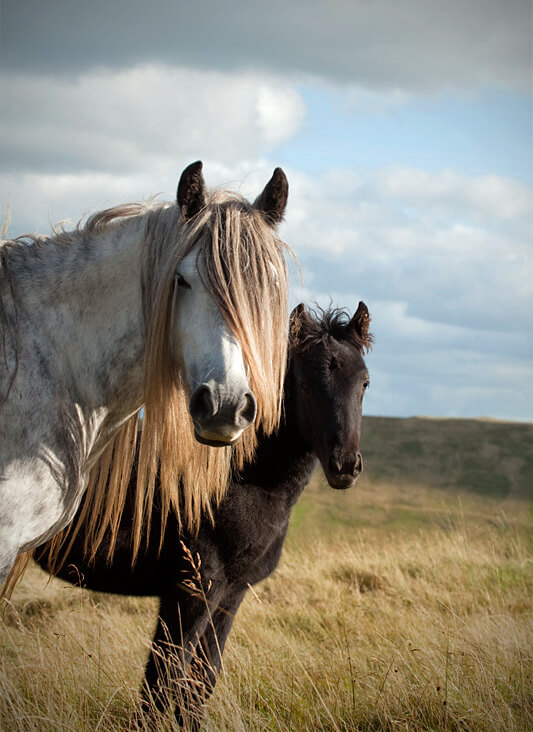
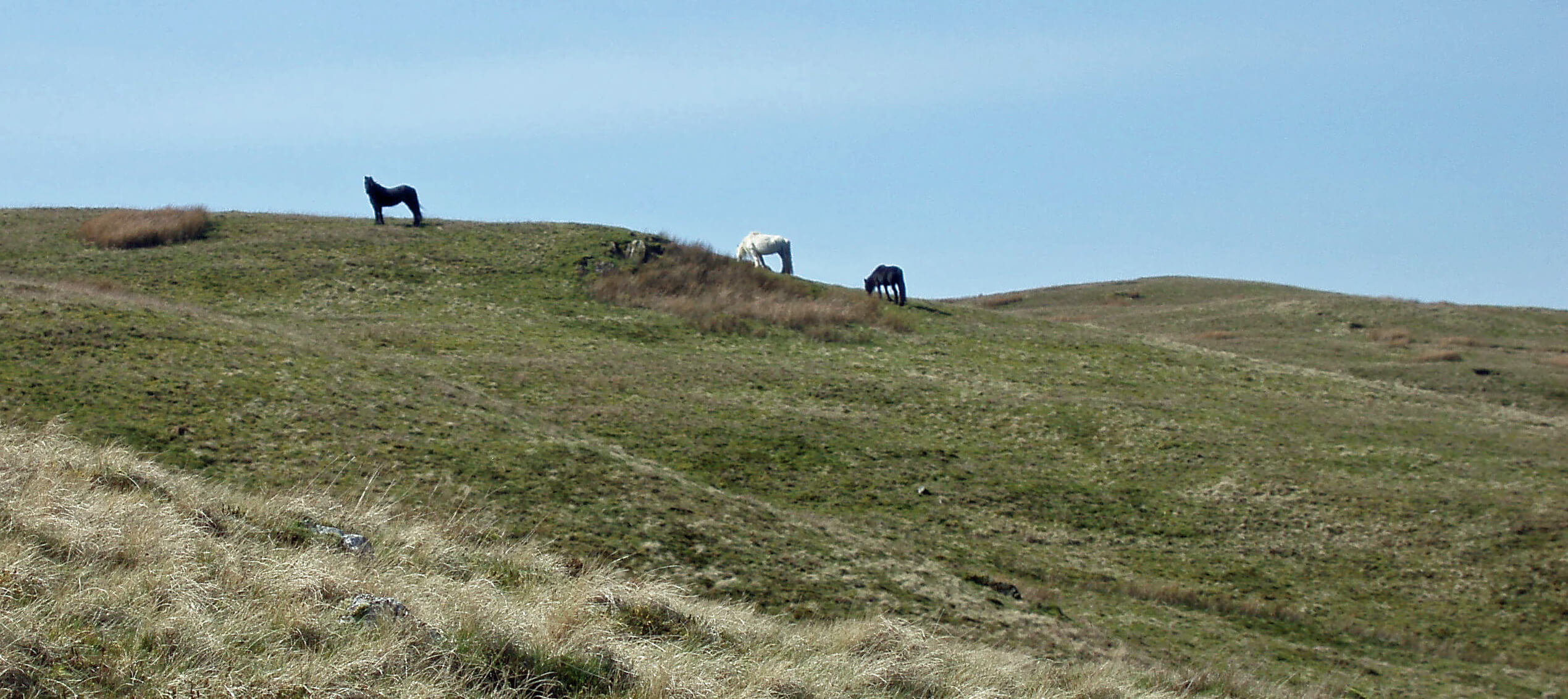 Left: Fell ponies on Roundthwaite Common
(Mitch McFarlane)
Left: Fell ponies on Roundthwaite Common
(Mitch McFarlane)
Right: Fell ponies near Belt Howe above Borrowdale
Are fell ponies ‘wildlife’? It was remiss of me to begin this
exploration of Loyne’s wildlife without defining what it is.
So, here goes: ‘wildlife’ is life that is wild. What could be
simpler than that?
I am reminded of the Not the Nine O’Clock News sketch:
Prof. Fielding: When I caught Gerald in ‘68 he was completely
wild ...
Gerald (a gorilla): Wild!? I was absolutely livid!
In our context, ‘wild’ means undomesticated, untamed, capable
of independent existence in the natural world. Independent of
humans, that is. Unfortunately, the natural world changes, partly
because of human activity, and for some species independence may
become impossible or, at best, risky. We are increasingly aware
that we have created problems that we have an obligation to help
some species overcome.
The Sunbiggin Moor snails are ‘fully protected’ because
changes to the climate and to the environment have rendered them
vulnerable. We provide passes for eels and sanctuaries for pink-footed geese. We take salmon eggs and breed them on the salmon’s
behalf. We shoot grey squirrels to help red ones. We protect bats.
We provide hives for bees, nesting boxes for barn owls, ponds for
frogs. There’s hardly a species left that we don’t try to help along
the way! All these species, while not fully independent, are scarcely
‘tamed’. We would, I think, consider them all wildlife.
On the other hand, if I had pet goldfish then they would not
be wildlife. They would depend entirely upon my tender care. If
I were to tip them into the Lune then I doubt that they would have
sufficient wherewithal to survive long enough to be considered
wildlife. Likewise, I wouldn’t fancy the chances of the farmer’s
chickens if they wandered far from his fields.
Fell ponies are all owned and looked after by someone. For
example, the Roundthwaite Common fell ponies are members of
the Lunesdale Fell Pony Stud of Roundthwaite Farm [1].
However, for most, if not all, of the year the ponies are perfectly capable of
leading a feral existence up on the fells. That is partly what defines
a ‘fell pony’!
I don’t want to keep debating with myself whether a particular
species qualifies as ‘wildlife’ for my purposes. So, I will consider
all ‘life’ to be within my scope, whether strictly ‘wild’ or not (with
the exception of human life, although some of that is certainly wild
enough).
Fell ponies are not wild but docile, as far as a human walker
is concerned. Although the ponies are frequently encountered
on the Cumbrian hills, including the Howgills, Birkbeck Fells and
Roundthwaite Common, I have never known them to be alarmed
or attracted by walkers. Perhaps that is also a reflection of walkers’
behaviour towards the ponies. Indeed, they deserve our respect,
for all fell ponies are registered with the
Fell Pony Society, whose
patron is Queen Elizabeth II - which is not bad for a pony of humble
northern stock.
Fell ponies are native to northern England, no doubt pre-dating
Roman times, and it is the region where they are still mainly to
be found. Their hardiness, strength and agility gave them a
working role in early farmsteads, for ploughing, pulling sledges,
and transporting goods. Being strong, fast and steady walkers,
fell ponies were used as pack-horses to transport goods (wool,
foodstuffs and other merchandise) long distances. This continued
well into the industrial age, as the ponies transported iron, lead and
coal around the factories and mines of northern England.
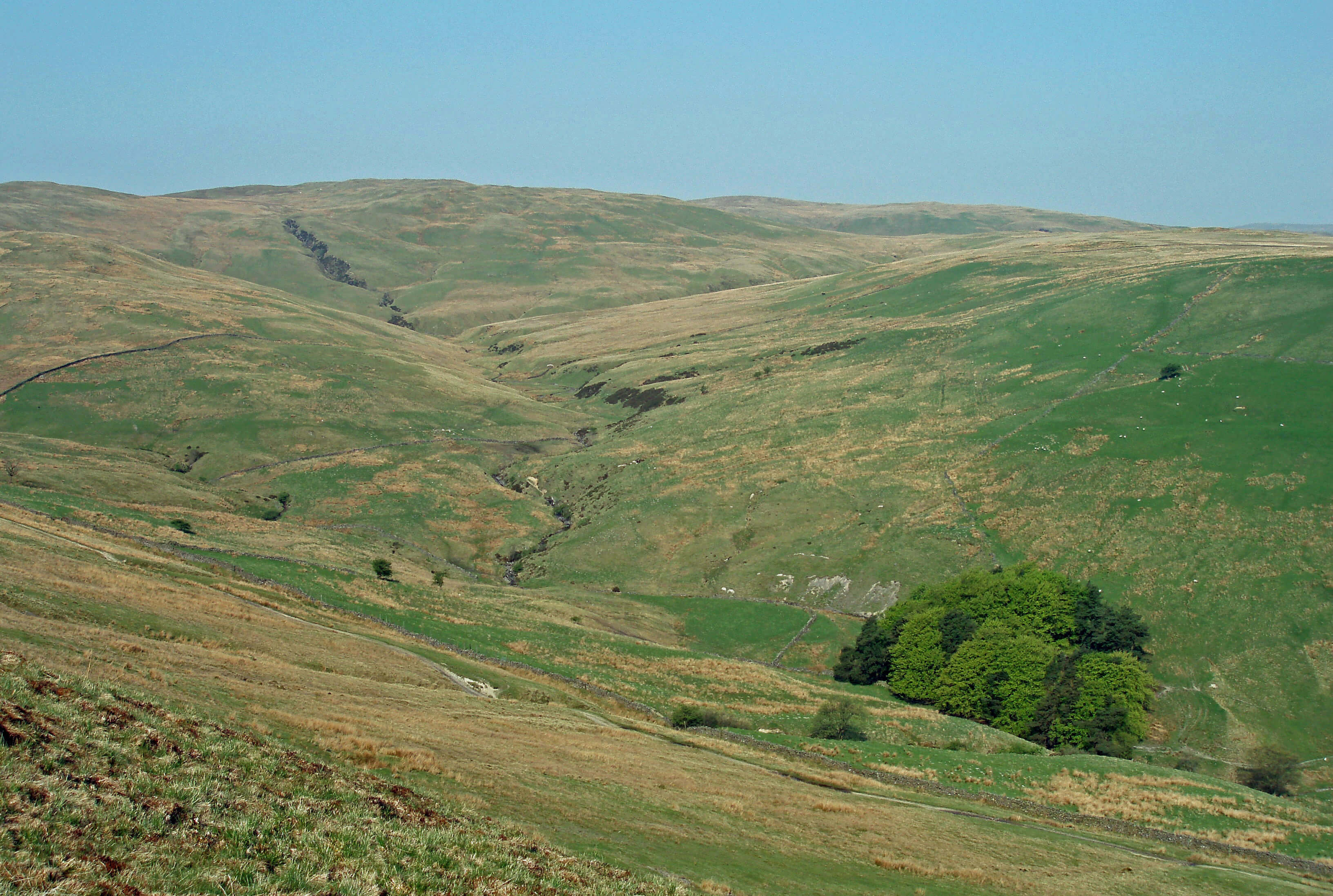 Right: Roundthwaite Common
Right: Roundthwaite Common
As is our wont, we began in the 19th century to use fell ponies
for sport and leisure, such as for the Cumberland sport of trotting.
This has proved to be the saviour of the breed. The demand for their
labour has greatly decreased in recent centuries, although, as befits
a good patron, the Queen still finds rightful uses for fell ponies, in
transporting deer and grouse off the hills around Balmoral.
Nowadays, though, with the pedigrees being meticulously
recorded by the Fell Pony Society, the concern is to keep the breed
pure enough to be displayed at classes and, of course, to serve as a
family pony for general riding. Colours acceptable to the Society
are black, brown, bay and grey. Woe betide any fell pony born
chestnut or piebald or even with a dash of white other than on the
head or hind fetlock.
The pony’s even, sure-footed walk helps to ensure safe passage
over the roughest terrain. The breed has been adopted by the
Riding for the Disabled movement. The ponies are not naturally
great racers but their expertise at traversing rough, marshy or hilly
ground has led the Fell Pony Society to develop a form of cross-country trial for them. And, with its heritage, the pony is also suited
to recreational carriage-driving, as so memorably demonstrated by
the Queen’s husband.
Attentive readers may have noticed that, scarred as I am by my
attempt to define ‘duck’ and ‘goose’, I have not tried to do the same
for ‘pony’ and ‘horse’. I am aware that it is all too complicated for
me. Informally, a pony is a small horse Equus ferus (in competitions,
‘small’ is defined as less than 14.2 hands). Most modern pony
breeds are small through having lived on marginal habitat, like our
fell ponies. A breed (which is itself not a scientifically defined term)
may classify an individual animal as a horse or a pony based on its
pedigree. There are about 300 breeds of horse and 100 of pony [2].
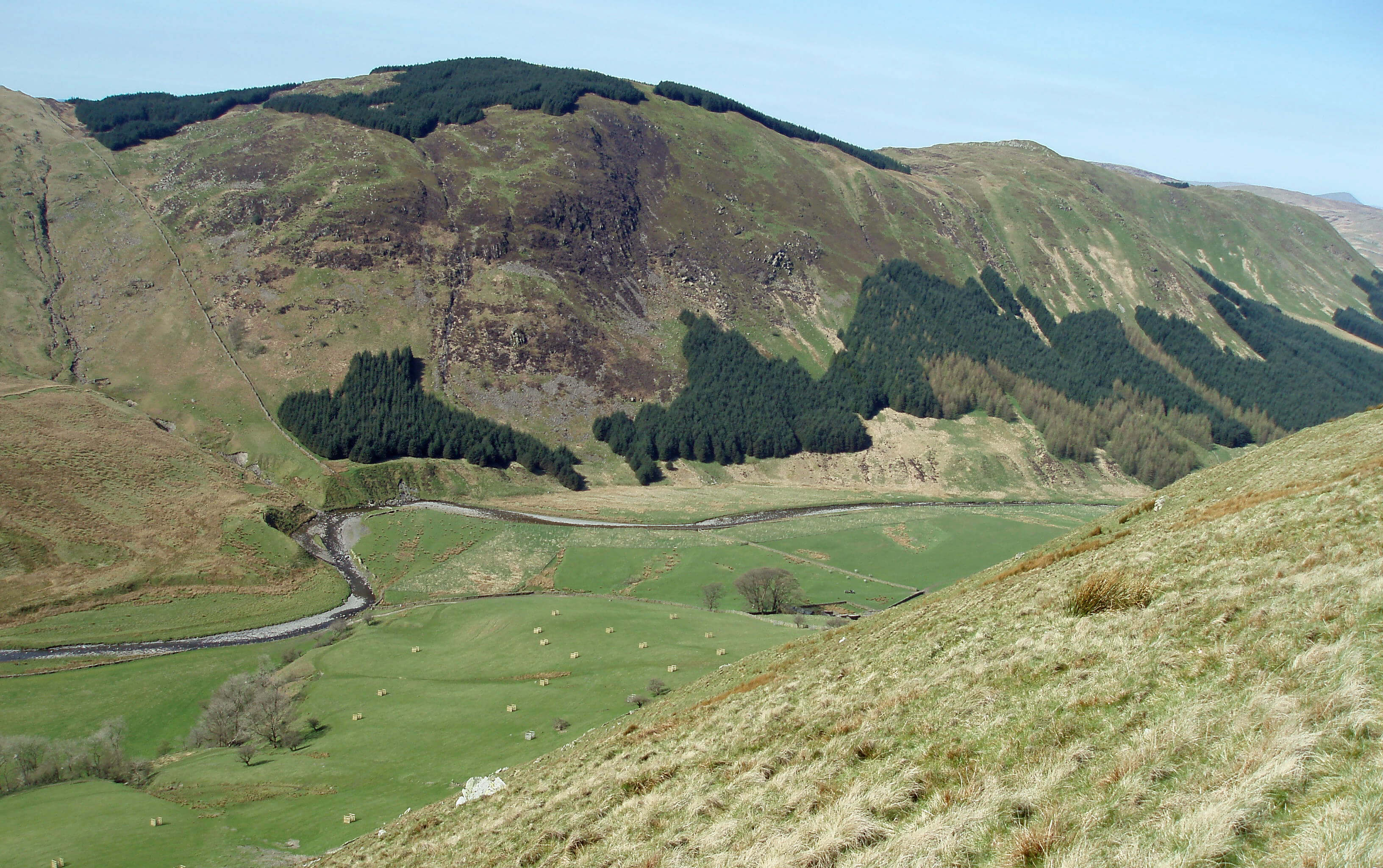 Left: Borrowdale
Left: Borrowdale
Confident that I can leave the matter in the safe hands of the Fell
Pony Society, I walked over the series of summits - Jeffrey’s Mount,
Casterfell Hill, Belt Howe, Winterscleugh and Whinash - that line
the northern slopes of lower Borrowdale in order to appreciate the
Lunesdale fell ponies in their element. I saw about 25 ponies dotted
about the Common, some in groups of four or five and some alone.
They all took far less notice of me than I did of them.
As I walked west from Jeffrey’s Mount the hum of the motorway
gradually transmuted into the songs of skylarks. By Winterscleugh
I could hear nothing but skylarks. It seemed that every few yards
another skylark was sent singing skywards.
It is sobering to reflect that, if plans had not been rejected in 2006,
the hum of the motorway would have been transmuted not into
the songs of skylarks but into the throb of 27 wind turbines. This
would have been England’s largest terrestrial set of wind turbines.
The proposers argued that this barren moorland held little appeal
to anyone and that more visitors would come to see the windmills
than come to walk the hills.
They may be right. I walked all the way along the ridge to
the old track of Breasthigh Road, back east along the Borrowdale
valley, over the bridleway to Roundthwaite and saw only one other
walker. No doubt, if there were more walkers then there would be
fewer skylarks. And if there were wind turbines, even fewer. The
fell ponies, however, would, I’m sure, remain unperturbed.
Apart from the fell ponies and the skylarks, I saw, without
searching conscientiously, a few peacock butterflies, a dipper, some
pied wagtails and wheatears, a buzzard and some tadpoles. This is
not exactly a wildlife safari comparable to seeing herds of wildebeest
and packs of lions but that is what it is and should remain - blissful
silence, apart from skylarks, unaccompanied by wind turbines.
Knowing the fell pony’s equable temperament and suitability
for general riding, a walker who felt as tired as I did towards the
end of this expedition might be tempted to co-opt a pony for a
relatively effortless descent from the moor. I wouldn’t recommend
it. I doubt that the ponies are that equable, and I am sure that their
owners are even less so.
[1]. Carole Morland of Roundthwaite Farm and
Lunesdale Stud
has written a book about fell ponies, as has Sue Millard of
Greenholme, whose ponies graze the nearby Birkbeck Fells:
Carole Morland (2008), A Walk on the Wild Side, Kirkby Stephen:
Hayloft Publishing.
Sue Millard (2005), Hoofprints in Eden, Kirkby Stephen: Hayloft
Publishing
[2]. Here's a list_of_horse_breeds.
14. Cuckoos in Littledale
May 2014
Birdwatchers who are serious, but not so serious as
ornithologists, are nowadays called ‘birders’. They go
‘birding’. Perhaps that’s because there is more to birds than
just watching them. You could listen to them, for one thing.
I went to Littledale to hear a bird. I didn’t particularly want to
see it. The appeal of the mysterious, disembodied sound echoing
around the hills might be diminished by a sight of an ordinary
bird creating it. Every May I make a pilgrimage to Baines Cragg
and Little Cragg, near the head of the River Conder, in the hope
of hearing the cuckoo Cuculus canorus. I have not thoroughly
researched alternative cuckoo locations in Loyne: all I can say is
that I am rarely disappointed in Littledale. The number of cuckoos
in Loyne has declined, as it has elsewhere in the UK, but so far
they have continued to return here. On a sunny, late May evening
the calls of cuckoos resonate within the amphitheatre of Littledale,
below Ward’s Stone and Clougha Pike.
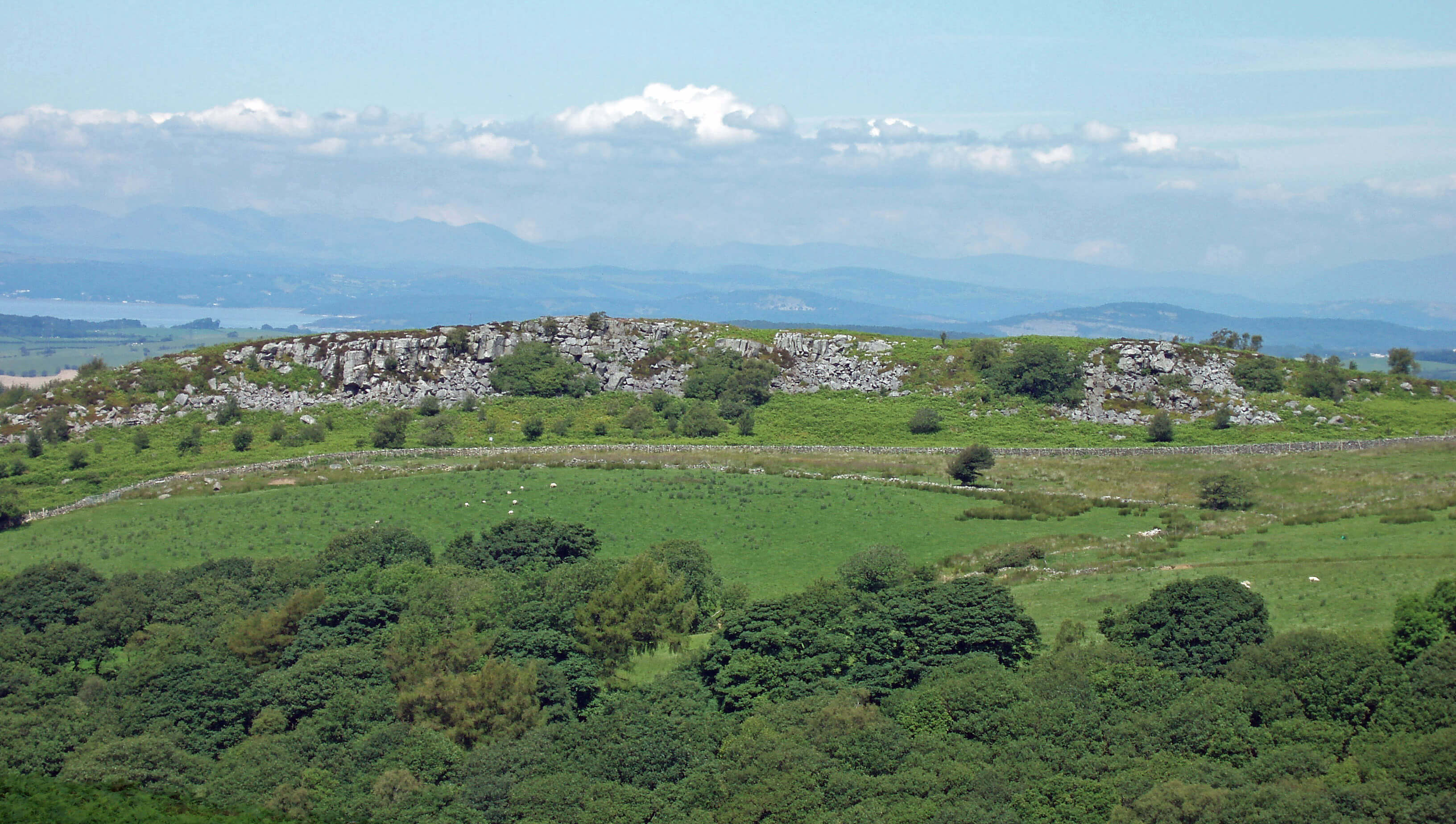 Right: Baines Cragg, with the Lakeland hills beyond
Right: Baines Cragg, with the Lakeland hills beyond
It is an evocative sound of which we are curiously fond,
considering that it is as monotonous a bird call as there is. Perhaps
it is the elementary musicality that appeals. The cuckoo calls in the
key of C, descending by a minor third, with the interval widening to
a fourth through the season. Several classical composers, including
Beethoven, Delius, Saint-Saens, Johann Strauss and Vivaldi, have
mimicked the cuckoo.
The cuckoo call, so simple and yet appealing, is the call of choice
to be mechanically simulated within a clock, the cuckoo clock
(although there it is a major third, in order to sound less doleful).
The cuckoo must be the only UK bird to have a museum devoted to
it - the Cuckooland Museum in Tapley, Cheshire, which is mainly a
museum of cuckoo clocks.
Of course, to many people the call of the cuckoo appeals because
it is the clearest sign of approaching summer - at least, it used to
be when the cuckoo was more common and the people were more
rural. It was recognised as such in what is regarded as the first
English song, the 12th century “Sumer is icumen in, Lhude sing
cuccu”.
The cuckoo’s iconic status in pastoral England is reflected in
many myths. For example, several villages (including Austwick in
Loyne) claim to be the origin of the old story of villagers wishing
to appear simpletons, in order to drive away putative newcomers,
by trying to enclose the cuckoo to prevent it flying away, thereby
preserving spring and summer forever. Hence the old expression
“to fence in the cuckoo”.
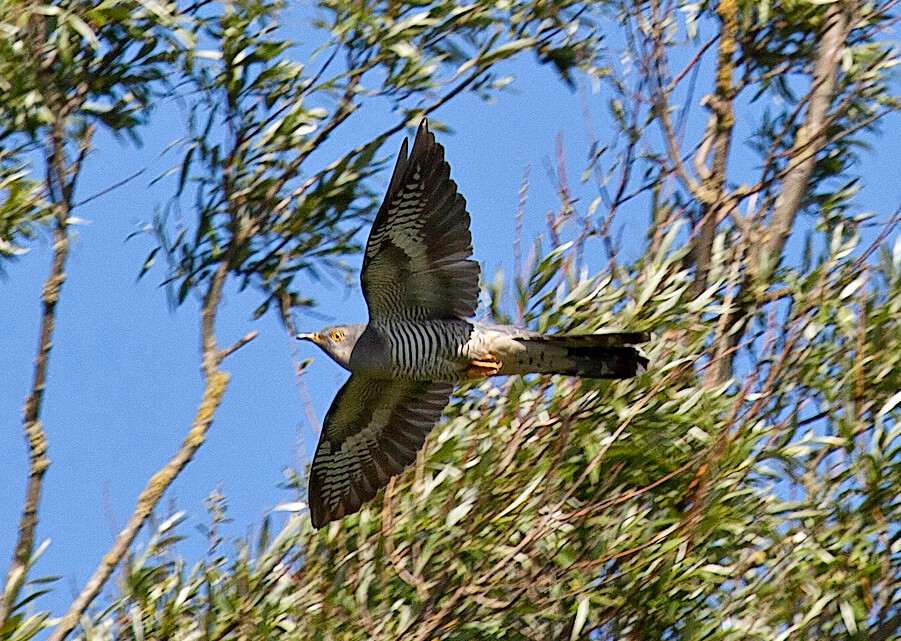 Left: The cuckoo in flight (Nick Ford)
Left: The cuckoo in flight (Nick Ford)
The seasonal appearance and disappearance of birds was
something of a mystery before the details of migration were
unravelled. Many people believed that the cuckoo, which in flight
has a superficial resemblance to a sparrowhawk or falcon, did not
fly away at all but transformed itself in the autumn into a hawk -
and vice versa in the spring.
Also, it was thought by some that there were no female cuckoos.
The male cuckoo was supposed to mate with hen birds of various
species who then laid ‘cuckoo eggs’. Perhaps this apparently free-and-easy sexual
life led to the word ‘cuckold’, which, according
to the dictionary, comes from the French for cuckoo. However,
it somehow became the husband that is made a cuckold, as
Shakespeare indicated in Love’s Labour’s Lost:
The cuckoo then on every tree
Mocks married men, for thus sings he: Cuckoo!
Cuckoo, cuckoo — O word of fear,
Unpleasing to a married ear.
Of course, the female cuckoo does exist, although she only
makes a kind of bubbling call, and she does lay genuine cuckoo
eggs - many of them, in fact, up to 25 a season. The need for such
a profusion of eggs suggests that the nifty strategy of using foster
nests is none too successful.
Cuckoos have used over a hundred species as hosts, with the
meadow pipit and reed warbler being the most common UK hosts.
With so many host species, each with their different eggs, how does
the cuckoo ensure that its own eggs are not so different to the host
eggs that the parents become suspicious? It has long been known
that a particular female cuckoo has a preference for a specific host
species and lays eggs that match those of that host. In modern
terminology, each female cuckoo belongs to a specific ‘gens’, that
is, a subset of the species that has evolved to rely upon a particular
host. That, of course, is no explanation: it is merely a jargonised re-phrasing.
It is believed that the gens-specific properties belong to
the female cuckoo, with the male being able to mate with females of
any gens, thus maintaining the cuckoo as a species.
The female cuckoo has evolved the useful trick of retaining
its egg within its body for longer than other birds. The embryos
therefore tend to be more advanced than the eggs of the host birds
and more likely to hatch first. The cuckoo chick evicts all the other
eggs and chicks (if any) in order to monopolise the host parents’
feeding.
Evolution is amazing but it is always a work in progress. The
cuckoo seems to have benefitted from its distinctive evolution.
Why have the host species not evolved to respond? Well, to an
extent they have. Some host species will mob cuckoos (although
they are somewhat deterred by the resemblance to sparrowhawks),
which shows that they have learned to distrust or fear the cuckoo.
A fair number of hosts are not fooled by the imposter eggs either.
They simply abandon a nest with an alien egg.
And cuckoos are not so smart. They cannot distinguish their
own eggs either. One study showed that over half of cuckoo eggs
were laid in nests that already had a cuckoo egg [1].
In removing an
egg at random when laying its own the cuckoo is liable to remove
an earlier cuckoo egg. The cuckoo hatchling will in any case remove
any other cuckoo egg, along with all the other eggs.
It is always a relief, as well as pleasure, to hear the cuckoo because
the UK population has more than halved in recent years, putting it
on the Red List. Possible reasons for its decline - and indeed that
of other birds, particularly summer migrants - are discussed in the
book Say Goodbye to the Cuckoo [2].
This is clearly a complicated topic which I cannot hope to do
justice to here but I can perhaps indicate its complexity by mentioning
some of the reasons put forward. In the last century increasingly
intensive farming - involving the use of pesticides, the removal of
hedges, the increase of autumn-sown crops and the replacement
of wildflower-rich hay meadows - caused the widespread loss of
farmland birds. While attempts have been made to mitigate the
problem, breeding farmland birds have continued to decline to
about half what they were fifty years ago.
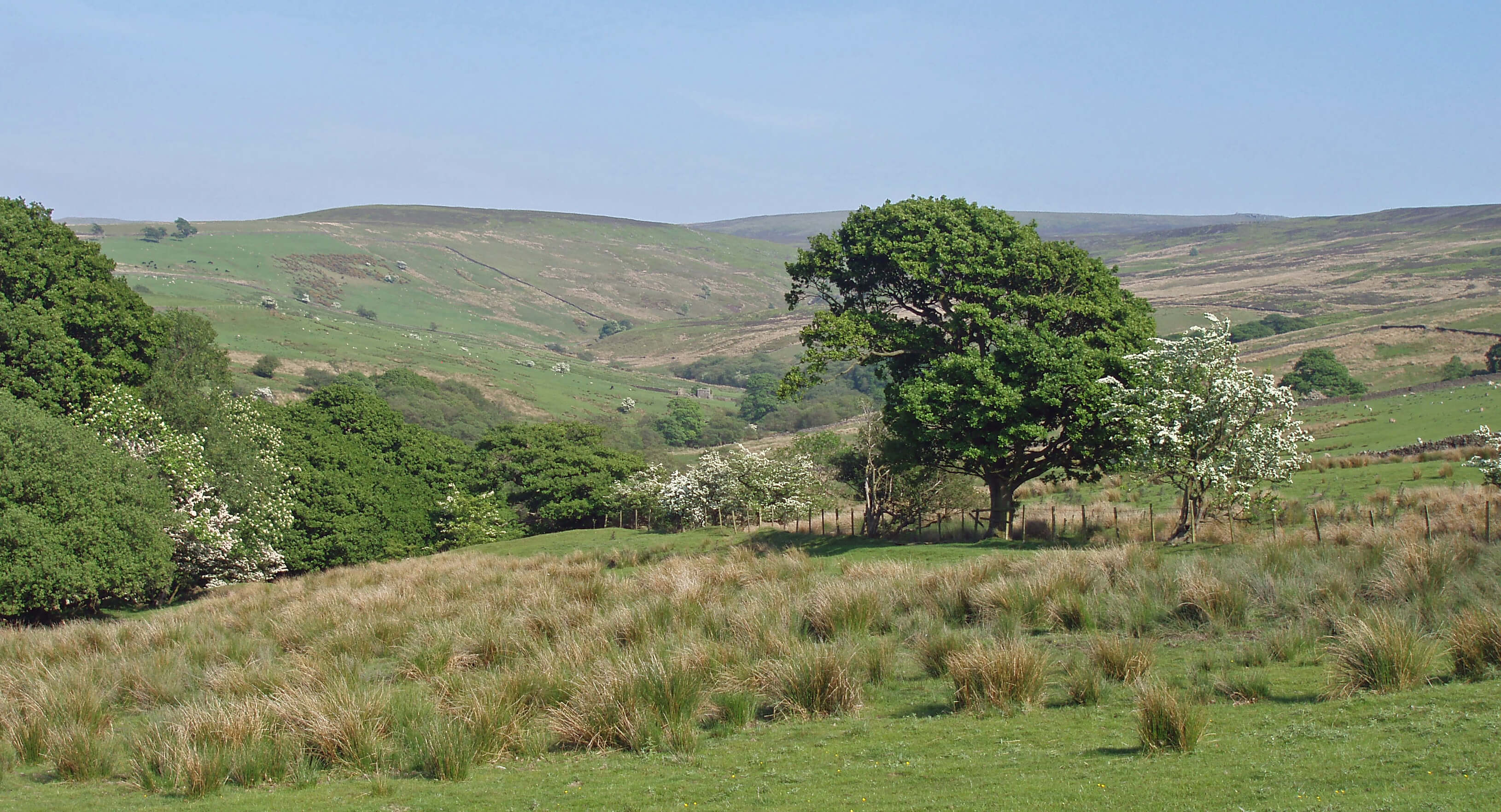 Right: Littledale
Right: Littledale
Migrant birds face a set of additional problems. A survey
of bird declines in the period 1994-2007 found that seven of the
ten most rapid declines were of summer migrants: cuckoo, pied
flycatcher, spotted flycatcher, swift, turtle dove, wood warbler,
yellow wagtail. This is more than you would expect pro rata as our
migrants constitute less than a quarter of all our birds.
Our migrants face difficulties in their breeding grounds (here),
during their journey, and in their non-breeding grounds (such as
Africa). Some of these difficulties also face non-migrants and some
are inter-dependent, but listing some of them indicates the complex
mosaic of problems:
• the continued intensification of farming
• increased predation by, for example, grey squirrels
• increased destruction of undergrowth by deer
• decline of moth caterpillars (especially the big hairy ones that
cuckoos like)
• the arrival of migrant birds and their food (caterpillars, flies)
being increasingly out of synch because of climate change
• illegal hunting of birds on their journey
• the failure of African wintering grounds (for example,
through drought)
• general environmental degradation in Africa, such as
deforestation
Only fifty years or so after we began to appreciate fully the
astonishing scale and nature of the journeys of our migrant birds
we are faced with an apparently intractable set of problems to
overcome if this migration is to recover to what it had been for
previous millennia, before humans interfered. Meanwhile, as we
struggle with this, we should recognise that our cuckoo is not really
ours. It spends more of its time in Africa - and if we are not careful
it may soon spend none of it here.
Our Littledale cuckoos, having no parental duties, are free to
leave us after their egg-laying is completed, which they do in July
or August. They take no interest in their offspring, which must
make their own way south beyond the Sahara. And next spring to
come all the way back to Littledale (I hope).
[1]. C. Moskát and M. Honza (2002), European Cuckoo Cuculus canorus
parasitism and host’s rejection behaviour in a heavily parasitized
Great Reed Warbler Acrocephalus arundinaceus population, Ibis 144 (4): 614–622.
[2]. Michael McCarthy (2009), Say Goodbye to the Cuckoo, London: John Murray.
15. Small Pearl-Bordered Fritillaries at Lawkland Moss
June 2014
 Right: Small pearl-bordered fritillary (Andrew Webber)
Right: Small pearl-bordered fritillary (Andrew Webber)
A kindly lepidopterist informed me that I had been mistaken
in referring to the pearl-bordered fritillary in The Land of the
Lune. It should have been the small pearl-bordered fritillary.
It was a gaffe comparable to saying “Mr Smith” when referring to
the former Conservative party leader Mr Duncan Smith.
The informal names of species do not, dare I say it, always
accord with common sense. A small pig is a pig that is small (small
for a pig, that is). Like most adjectives, the ‘small’ takes the set
denoted by the following noun and limits it to a subset. However,
the ‘small’ in ‘small pearl-bordered fritillary’ is not an adjective. It
is part of the species name.
There is, alas, another species with the
informal name of ‘pearl-bordered fritillary’. A small pearl-bordered fritillary is not a
pearl-bordered fritillary that is small. (The latter must be referred to as a
‘little pearl-bordered fritillary’, I suppose.) One species cannot be a
subset of another because species are, by definition, distinct. If the
name had been hyphenated to ‘small-pearl-bordered-fritillary’ (just
as Duncan-Smith might be) or if the other species were ‘large pearl-bordered fritillary’ then
novices would be less easily muddled [1].
Lepidopterists see no problem. They are perfectly content to
have three other pairs of British butterflies with names suggesting
that one is a subset of the other: mountain ringlet and ringlet;
northern brown argus and brown argus; Réal’s wood white and
wood white.
I mustn’t complain because, on the whole, whoever gave
names to our butterflies did a splendid job. Red admiral, painted
lady, purple emperor, marbled white, Camberwell beauty, small
tortoiseshell, ... - what evocative names for these beguiling insects!
However, the names are not exactly snappy. By the time you’ve
said “There’s a small pearl-bordered fritillary” there isn’t. I wonder
what lepidopterists call them when off duty, chatting in the pub, if
they do. It may be presumptuous of me but I’m going to call the
two species ‘small-pearl’ and ‘pearl’.
The species that confused me are Boloria euphrosyne (small-pearl) and
Boloria selene (pearl). I intended to search for the former.
I wanted to see the butterfly that had caused me grief. There is
(I read) a colony, one of only two in Loyne, at the Lawkland and
Austwick Mosses SSSI.
This lies north of Fen Beck, a desultory
watercourse that runs west from Lawkland to join the River
Wenning. The small-pearl is a relatively rare butterfly, having
declined so significantly in England that in 2007 it was added to the
UK list of priority species for biodiversity action.
I walked to Lawkland Moss from Eldroth and tramped through
the thigh-high grass and thistles of swampy, tussocky meadows,
where I was welcomed by clegs, and battled through some of the
birch, alder and willow woodland. I then crossed to Austwick
Moss (there is no public footpath to it but that is no deterrent to a
committed trespasser). Again, I struggled across the moss, through
woodland, rough grassland and heather. These are strange, other-worldly, man-forsaken
wildernesses that it is little pleasure to walk
within. The ground is uneven, possibly from earlier peat digging,
with clumpy grass tufts. After wet weather it must be a morass
impossible to cross on foot.
I saw a number of brownish butterflies (meadow browns and
skippers, I assume) and many black butterflies that, after a thorough
search of the butterfly books (which show no black butterflies), I
deduce are not butterflies at all but (probably) chimney sweeper
moths. I saw no small-pearls. All in all, it was a miserable outing
that left me wishing never to see Lawkland and Austwick Mosses
again.
A week later (June 25) I returned, demonstrating my exemplary
commitment. This time, I approached from Austwick to the north.
The sun was not shining, which I took to be a bad omen. Again,
I entered the scrubby meadows of Lawkland Moss. Again, there
were plenty of brownish butterflies that weren’t small-pearls.
But then, as I’d all but given up, I glimpsed something orangey.
I walked slowly to where it had landed and found it happily settled
on a grass stalk, where it proudly displayed for me the upper and
lower sides of its wings. Unmistakably, a small-pearl!
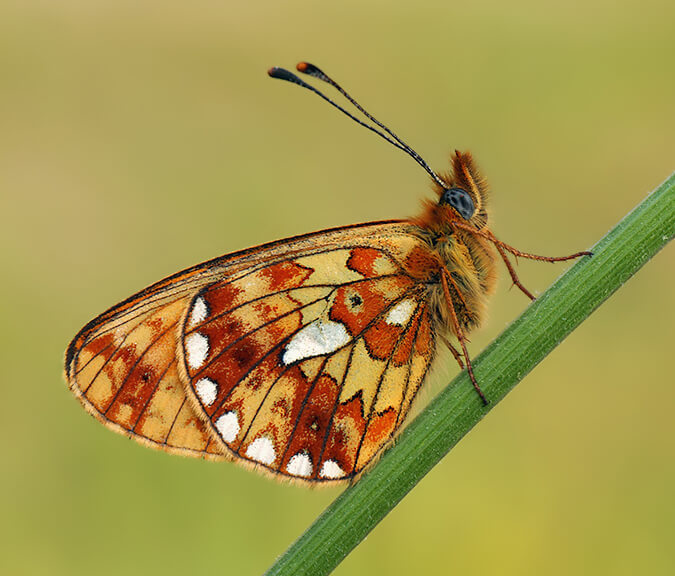
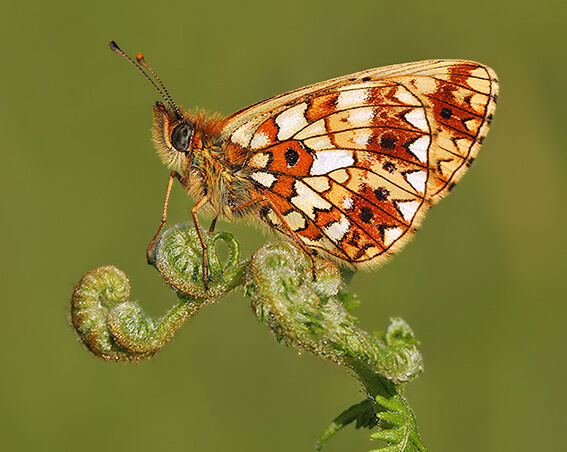 Left: Pearl-bordered fritillary; Right: Small pearl-bordered fritillary
(Nigel Kiteley)
Left: Pearl-bordered fritillary; Right: Small pearl-bordered fritillary
(Nigel Kiteley)
I don’t know if pearls also frequent this meadow (I assume not,
as the kindly lepidopterist would otherwise not have been so certain
that I was mistaken) but I had read that the two butterflies are best
distinguished by looking at the undersides of the hind-wings,
which are obviously best observed when the butterflies are at rest.
Both butterflies have a row of seven spots (the ‘pearls’) along the
outside border. The pearl has a distinct extra spot within the wing;
the small-pearl has a more complex pattern of whites, browns and
oranges. As I say, this one was definitely a small-pearl.
Eventually, the small-pearl flew off. It is a mystery to me how
experts can recognise butterflies (and birds too) from the merest
glimpse as they fly past. There is presumably something distinctive,
if not definable, in the flights of different species. This may be so
with small-pearls. Its flight seemed more purposeful than that of
the other butterflies flitting about. With relatively few rapid flaps
of its wings, it was soon yards away, before settling again on some
grass or wildflower. It also flew well above the grass and appeared
a rather bright orange that I would imagine to be even brighter in
sunlight.
I don’t know if a pearl’s style of flight differs from a small-pearl’s
but if it does then I think I might be able to identify a small-pearl
if I saw one in flight. I certainly couldn’t distinguish them from
their size, despite their names, because, according to the books, one
is 18-23 mm and the other 17-22 mm - nor from their appearance
in flight, as the upper sides of their wings seem identical (I could
have labelled the photograph at the beginning ‘pearl-bordered fritillary’
without fear of correction).
As I continued around the meadow, now knowing what I was
looking for, I could put my hoped-for expertise to the test because,
as I walked along, a number of other small-pearls took to flight.
Perhaps on a sunnier day they would have been flying voluntarily.
I am sorry to have disturbed them but I am sure that the small-pearls felt it was in a worthy cause.
I found it best not to try to keep up with the small-pearl whilst
it was flying. For one thing, it could fly faster than I could walk
over this terrain. It was better to let the butterfly land afar and then
creep up upon it. Generally, the small-pearl was content to allow a
close approach (to within a yard or two). Binoculars were useful to
locate and study the butterflies from a distance.
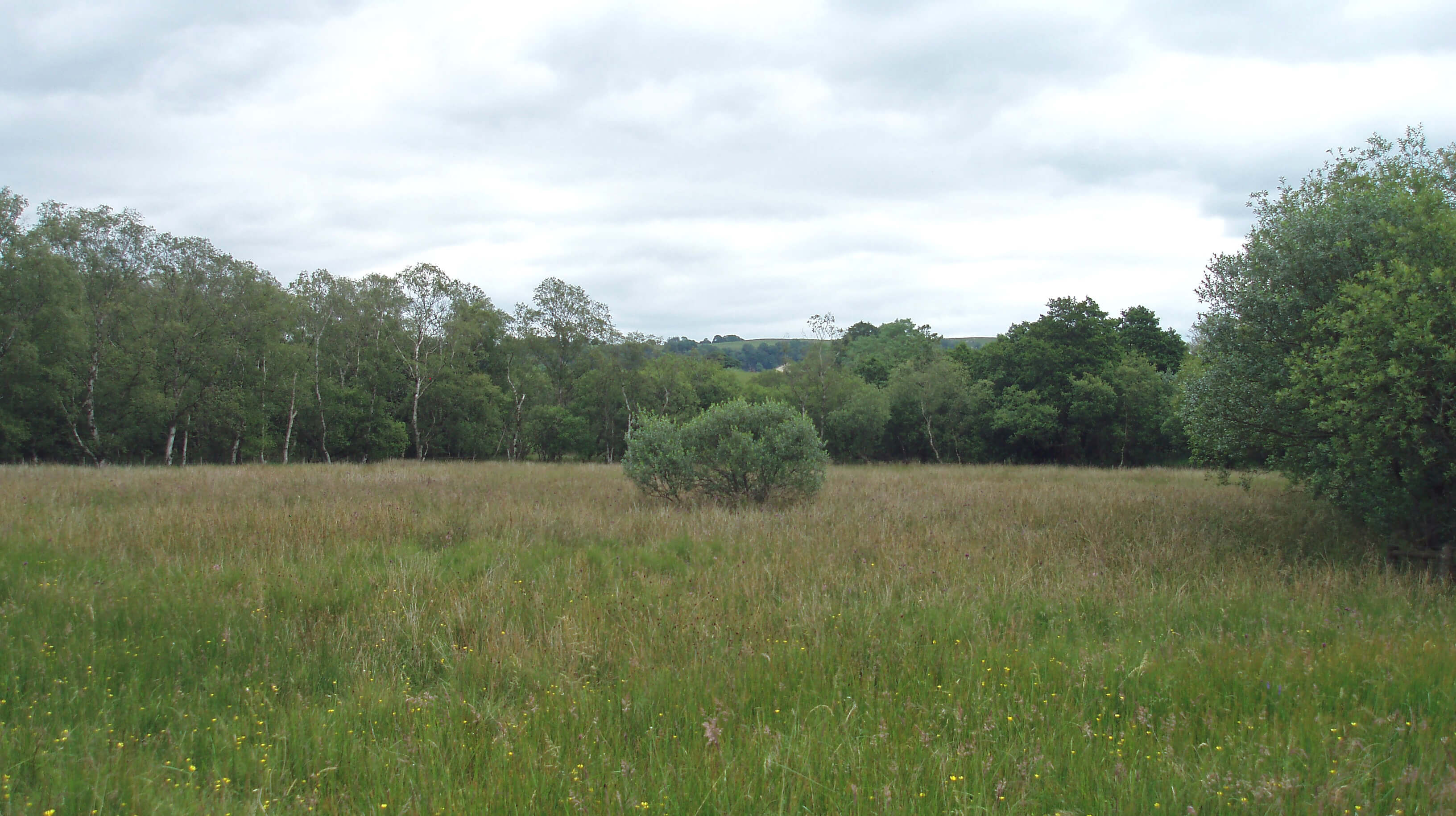
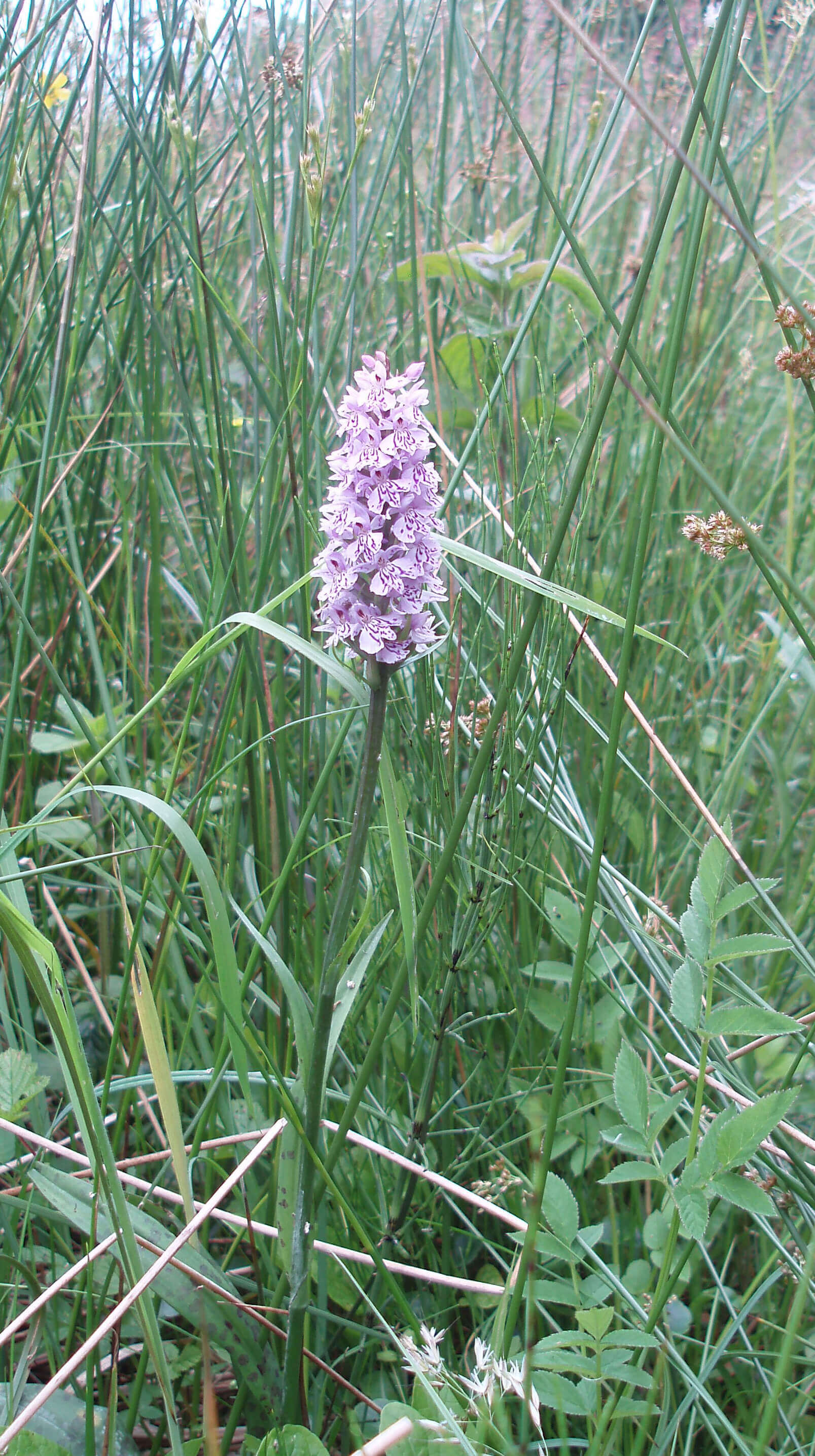 Left: The Lawkland Moss meadow, where the small-pearls were seen
Left: The Lawkland Moss meadow, where the small-pearls were seen
Right: A Lawkland Moss common spotted orchid, one of the small-pearl’s food plants
The meadow was transformed. Last week it was torture; now it
was pleasure. I spent some time pottering about, feeling at one with
the butterflies. All the small-pearls that I saw were in a meadow
enclosed on three sides by woodland, and therefore sheltered from
the breeze. But then I didn’t look elsewhere, once I’d found my
small-pearls in this meadow.
However, I did not see ‘swarms’ of small-pearls - a dozen at
most, and, of course, I may have re-seen the same butterfly. Maybe
there are more later in the season but anyway I am led to wonder
about the viability of the colony.
Indeed, I wonder what
a ‘colony’ is. According to
Encyclopedia Britannica,
a colony is “a group of
organisms of one species that
live and interact closely with
each other”. Does that imply
that they do not interact with
organisms outside the colony?
I understand that there are
also colonies of small-pearls on
Newby Moor and in the Arnside
and Silverdale AONB (Area of
Outstanding Natural Beauty).
Newby Moor is some five
miles northwest of Lawkland
Moss and is also a peat mire
but without the extensive
birch woodlands and enclosed
meadows that are home to the
small-pearls at Lawkland Moss.
The Silverdale region is further
west and is limestone country with very different habitat.
How far do small-pearls travel? Some butterflies travel far, for
example, painted ladies, which migrate here across the channel.
However, a small-pearl would be recklessly bold to leave the
enclosed meadow at Lawkland Moss that meets all its needs. There
is no similar habitat in any direction for some miles. It would not
know to head for Newby Moor and the chance of reaching it by
chance must be slim - and of reaching Silverdale much slimmer.
So, my presumption is that the three colonies are discrete, that
is, that the individuals in one colony never meet those of the other
colonies - and have never done so since the intervening habitat was
replaced by farmland and building. If there is only a handful of
small-pearls at Lawkland Moss then they are no doubt vulnerable
to problems of in-breeding, extreme weather conditions, loss of
habitat and disturbance by inquisitive visitors.
If the colonies are discrete, what makes the individuals all of
one species? As I understand it, a species is defined by the fact that
the individuals within it are capable of interbreeding. In practice, if
my presumption is correct, the individuals of the different colonies
do not interbreed. They may have the potential to do so but it is
never realised. At least, I assume so. Has anyone confirmed that
small-pearls from Lawkland Moss can interbreed with small-pearls
from Silverdale?
The colonies now live in such different habitats that perhaps
they have evolved differently after many generations apart (and,
of course, a butterfly generation only lasts a year - or less in a long,
hot summer when two generations are possible). Perhaps the wild
‘island’ of Lawkland Moss is hosting something similar to the
evolution of Darwin’s Galapagos Island finches.
[1]. To avoid muddling myself in future I could do as some writers do,
capitalise the name of a species (such as Red Deer), leaving ‘deer’ for
all species of deer. There are, however, two problems with this (apart
from the ugly profusion of capitals barging into sentences). One is
that it is necessary to be careful about whether a name is indeed that
of a single species. For example, in a list of trees - alder, birch, elder,
elm, hawthorn - which should be capitalised? The Wildlife of Lancashire
(2004) book by the Lancashire Wildlife Trust would have Alder, birch,
Elder, elm, Hawthorn. This looks silly (and wrong, to me) and makes
a distinction that I doubt that I will need to make. Secondly, a name
may refer to a single species in the British context but not globally.
For example, ‘eel’ for us means the European eel, not any or all of the
other 800 species of eels. Should I write ‘eel’, ‘Eel’, ‘European eel’ or
‘European Eel’? The Wildlife of Lancashire uses Eel. So, instead, I will
use my own convention. If the name of a species has more than one
word I will string them together with hyphens, for example, red-deer.
It is clear then that the qualifying words are not adjectives but are part
of the name. Nobody else seems to use this convention (although it
would help those who cannot decide where to put hyphens (if any) in
common spotted orchid!) but it seems simple enough to me. Let’s see
how it goes.
16. Kingfishers by Bull Beck
July 2014
I don’t always have to travel far in my search for the wildlife of
Loyne. Sometimes it comes to me. Yesterday (July 9th) I saw
two kingfishers by the beck at the bottom of our garden. This
beck begins as Tarn Brook by the Caton Moor windmills and runs,
as Bull Beck, through Brookhouse to the River Lune.
I had glimpsed a kingfisher a few days earlier - the first that I
had seen by Bull Beck for many years. To see two together was, for
me, rather special. I had been drawn to them by an unusual sound
- a kind of short, sharp screech or whistle. We have dippers and
grey-wagtails by the beck, as well as the normal garden birds, but
none have a call similar to this.
I located the birds at a bend in the beck and we watched for a
while before they flew upstream, one pausing for some minutes
on a small branch above a pool. We did not see it try to catch fish.
Indeed, I am doubtful - but hopeful - that there are enough fish in
this small beck to sustain a kingfisher or two.
The kingfisher Alcedo atthis was placed on the Amber list because
of its decline in Europe during the previous decades. It is specially
protected under the 1981 Wildlife and Countryside Act. The
RSPB
estimates that there are about 4,600 breeding pairs of kingfishers
spread somewhat thinly across the UK.
The RSPB has a particular reason for monitoring the kingfisher
population - the kingfisher played an important, if unwilling, part
in its formation. In the 19th century, society ladies adorned their
hats with kingfisher feathers or indeed whole kingfishers. Others
objected to this and a group in Didsbury, Manchester began writing
letters to the ladies, pleading on behalf of the poor kingfishers. In
1889 this group became the Plumage League and two years later the
Society for the Protection of Birds. The ‘Royal’ was added in 1904.
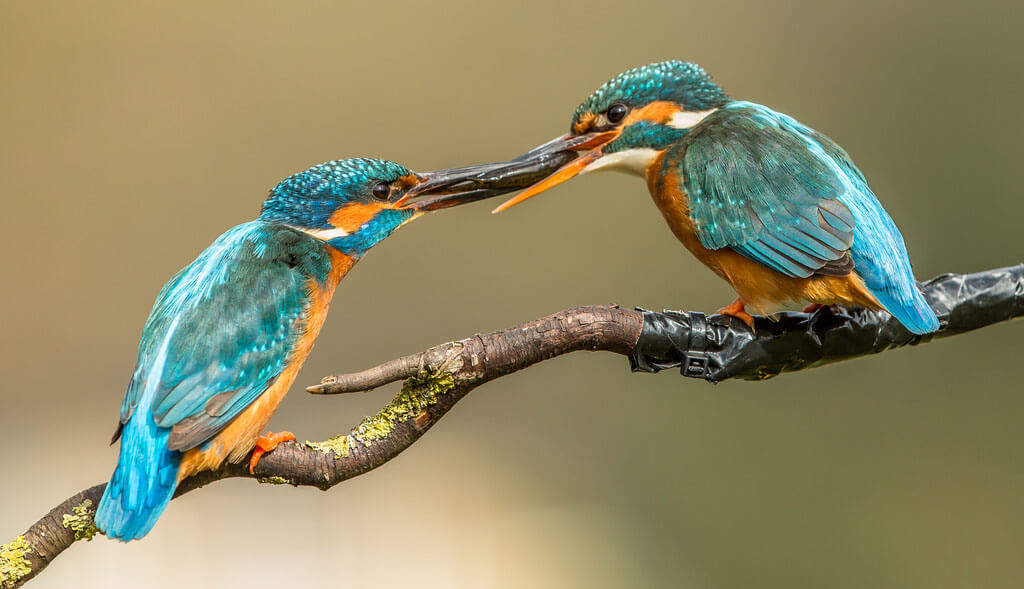 Left: Kingfisher and queenfisher (Ken Jensen)
Left: Kingfisher and queenfisher (Ken Jensen)
I don’t know if the two kingfishers we saw constitute one of the
4,600 pairs. I cannot be sure that they were a pair. Male and female
kingfishers look identical apart from the former having a black
lower bill and the latter a red one. This I did not notice, sorry.
Kingfishers are territorial birds that will fiercely protect their
domain. For most of the year a kingfisher is solitary, controlling a
stretch of river up to two miles long. If another kingfisher enters
the territory, fights may occur where each bird tries to grab the beak
of the other and hold it under water.
The Bull Beck two were quite amicable. If they weren’t a pair
perhaps they were young kingfishers, not yet mature enough to
be argumentative. However, young kingfishers are rather less
iridescent than mature birds - and they seemed fully iridescent to
me.
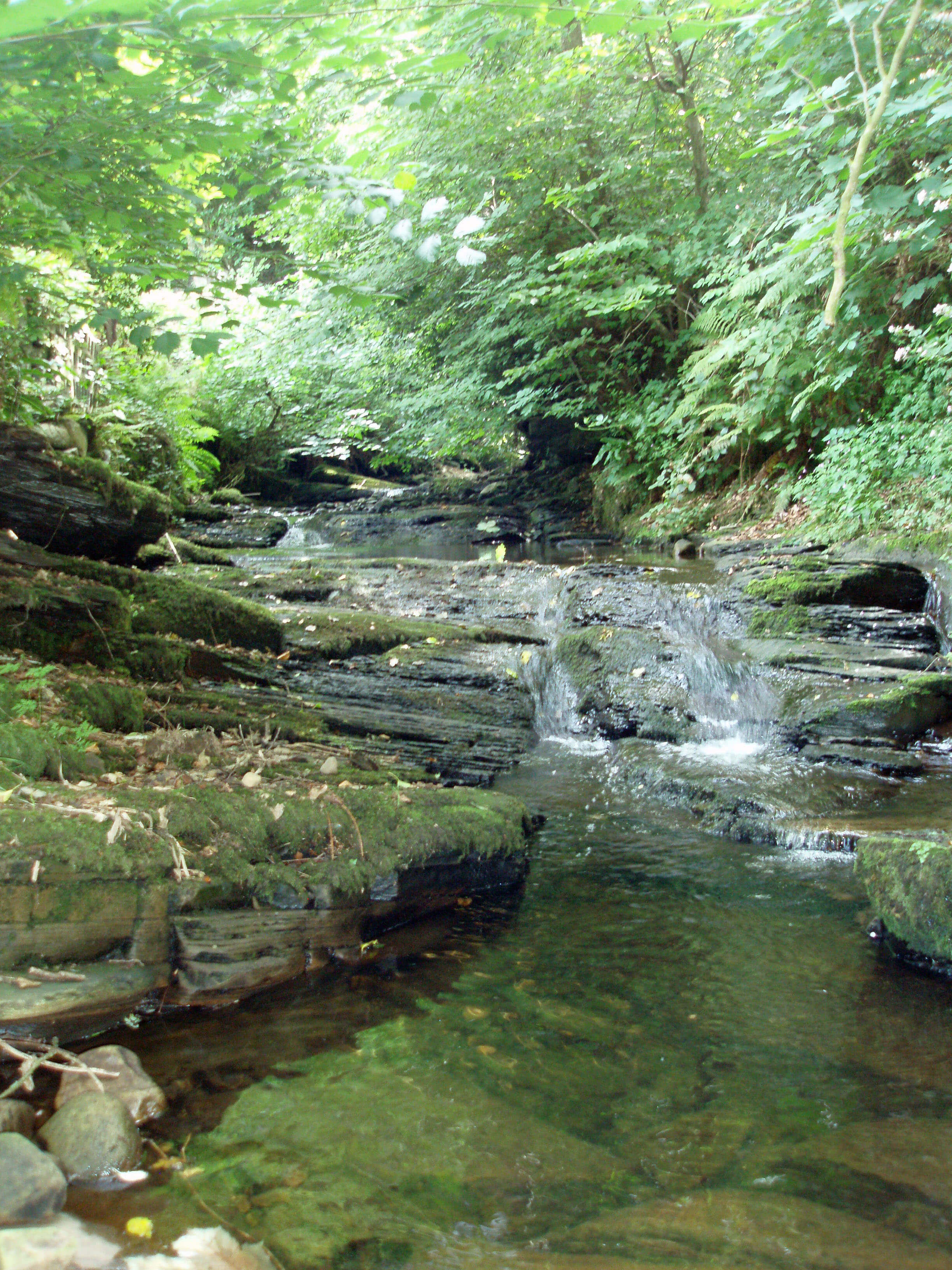 Right: Bull Beck
Right: Bull Beck
The colour of kingfishers is, of course, its most immediately
obvious and appealing characteristic. It is what catches the eye
as the kingfisher flies quickly by. However, although it may look
bright blue or green, it is really a dull brown. That is, if we could just
see the light reflected directly from the wings it would be brown,
but actually we see light that has bounced around the structure of
the wings, causing iridescent colouring that changes according to
the illumination and angle of observation.
If the two kingfishers were young ones then, since kingfishers
do not travel far, they were likely to have been born locally, perhaps
even by Bull Beck, which seems too much to hope for. Kingfishers,
like sand-martins, nest in tunnels excavated in a river bank. They
lay five to seven eggs, two or three times each season. That’s a lot of
eggs, indicating that mortality is high. Less than a quarter of young
kingfishers survive to the next breeding season. Only a quarter of
adult birds survive to the next season as well.
Kingfishers are no longer pinned to hats but even so they have a
difficult life. The early days of fledgling kingfishers are particularly
hazardous, even more than they are for most birds. Kingfishers
must become competent fishers within a few days, before they are
driven out of their parents’ territory.
Kingfishers are, as can be easily imagined, vulnerable to severe
weather. They stay here over winter and the shallow waters they
feed in may be iced over for days on end, leading to starvation.
Summer floods can destroy nests and make fishing difficult. So I
fear that I must accept that these kingfishers may be fleeting visitors
rather than long-term residents.
However, it is encouraging to see them at all because the most
important factor for kingfishers is water quality. The water must be
healthy enough for the small fish and aquatic insects that kingfishers
need. Moreover, the water must be clear enough for the kingfishers
to see them, as they skim over the surface or peer into the water
from a perch. Once in the water, a kingfisher is effectively blind, as
a third eyelid covers and protects the eyes.
It has been estimated that an adult kingfisher must catch over
2,500 fish a year. They do not care whether they are minnows or tiny
trout and hence kingfishers are not popular with anglers. But, of
course, the kingfishers wouldn’t be where they are if there weren’t
enough fish for them - and enough left over for anglers.
The fact that UK kingfisher numbers seem to have improved in
recent years is perhaps an indication that our freshwater systems -
rivers, becks, canals and lakes - are now cleaner and better able to
support kingfishers. If so, perhaps the two kingfishers are a good
sign for Bull Beck. Or perhaps my recently heightened wildlife
perceptiveness has revealed to me kingfishers that have been there
all along (but I doubt it).
17. Himalayan-Balsam on the Upper Lune
August 2014
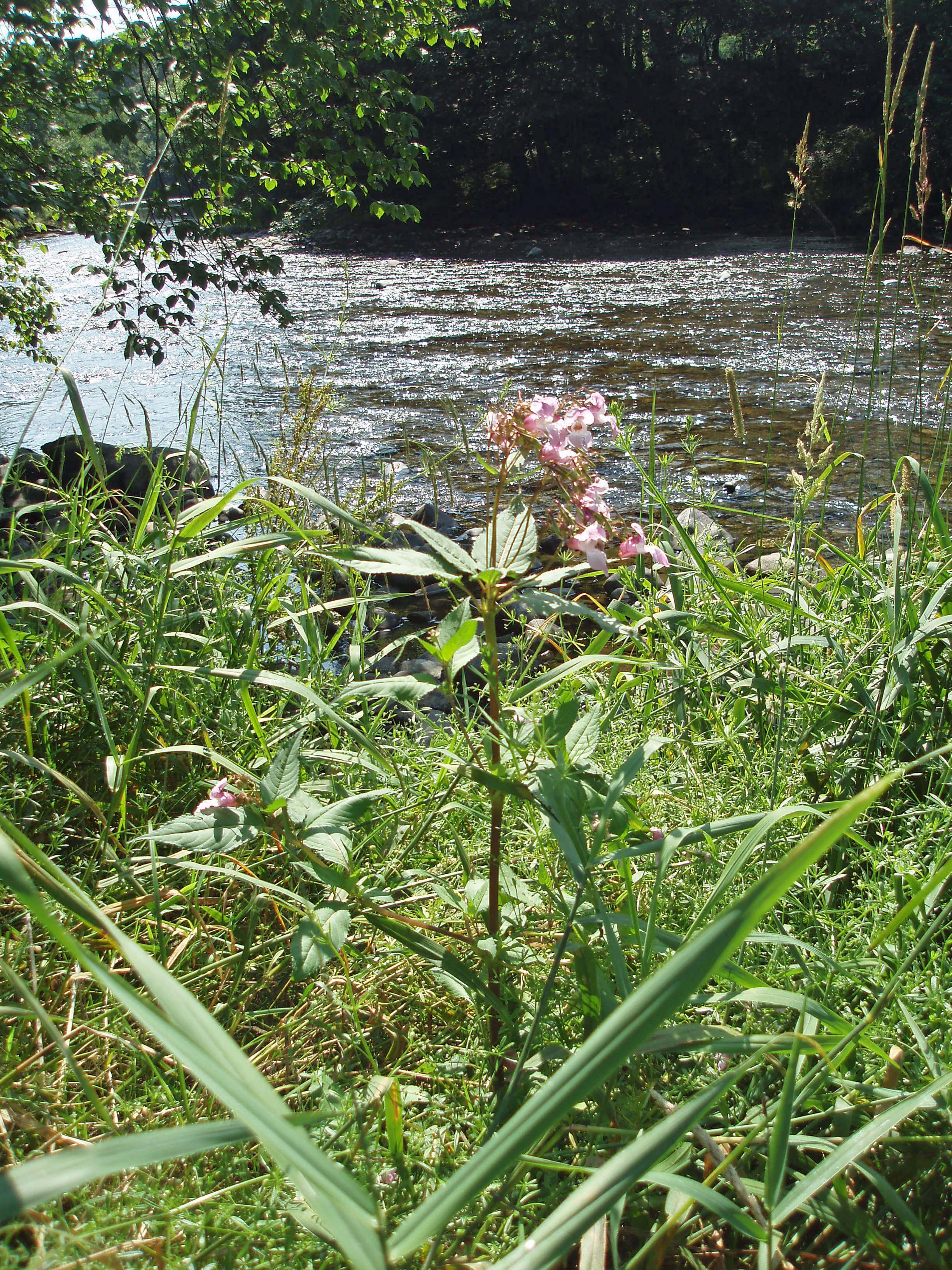 Left: Himalayan-balsam
Left: Himalayan-balsam
Now that the banks of Himalayan-balsam are in flower,
eliciting gasps of appreciation from some strollers by the
lower Lune, I thought that I’d find out where the balsam
begins on the upper Lune. We owe most of our lower balsam to
seeds being washed down the Lune from the upper balsam.
I am not aware of any
balsam along the banks of
the fledgling Lune from
Newbiggin to Tebay, so I
began my search at the M6
bridge in Tebay. I had at most
about ten miles of the Lune
to patrol because a bank of
Himalayan-balsam may be
clearly seen from Killington
New Bridge.
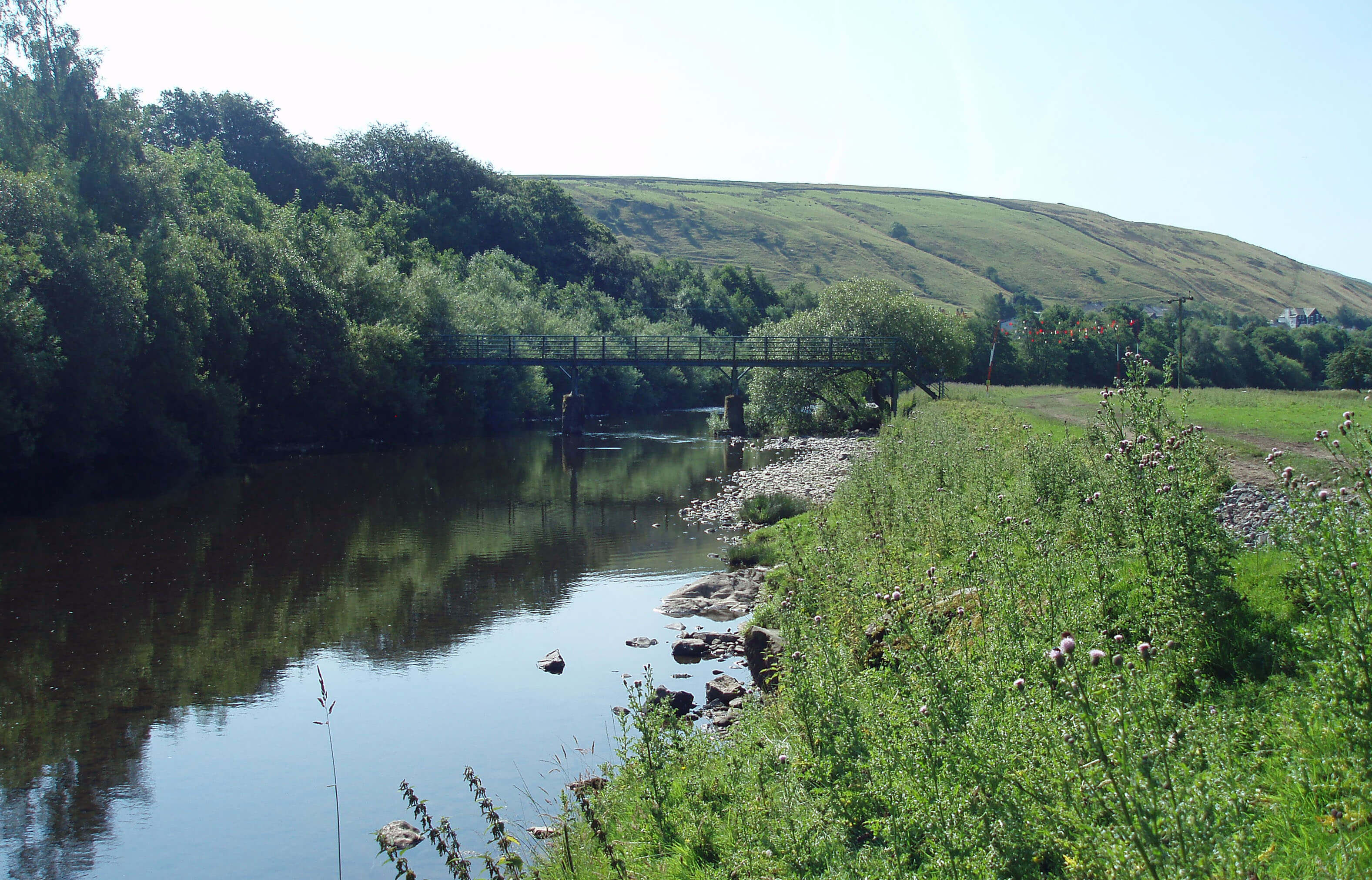 Right: Footbridge at Tebay, from under the M6 bridge
Right: Footbridge at Tebay, from under the M6 bridge
The start of my walk was
enlivened by swarms of green-veined-white-butterflies
feeding off muddy ruts under
the M6 bridge. Quite what
nourishment they find there
I cannot imagine. From the
footbridge, several fish may be
seen - more than is normally
seen from bridges down-river. And there was no Himalayan-balsam before the path swings away from the Lune, so it was all
rather pleasant - apart from the noise of the motorway ...
Himalayan-balsam Impatiens glandulifera is a large annual
plant that was brought to the UK as a decorative flower in the 19th
century. It grows to two metres or so, with a soft, green, red-tinged
stem. The flowers are pink-purple, with a sweet-smelling nectar,
naturally attractive to bees. After the balsam has flowered, seed
pods are formed which explode when disturbed, distributing the
seeds far and wide, especially if the seeds should fall into flowing
water, which is likely as the plant prefers to grow in moist soil such
as river banks. Each plant can produce 800 seeds, which are viable
for up to two years.
Victorian botanists have, therefore, enabled us to enjoy
plants with the virtues of ‘herculean proportions’ and ‘splendid
invasiveness’, as they promised. However, Himalayan-balsam is
so successful at colonising river banks and damp woodlands that
it causes nearby native plants to struggle for space, light, nutrients
and pollinators. Fairly soon, there are no native plants nearby. So,
native biodiversity is reduced. Then, when the balsam withers
away at the first frosts, there is no vegetation left on the banks,
which leaves them at increased risk of erosion.
Those unhappy at the sight of a non-native mono-culture
consider this a problem to be tackled urgently. The balsam arrived
here unaccompanied by the natural enemies that constrain it in
its native habitat. Research efforts are underway to identify a co-evolved species that attacks the balsam but not indigenous species.
This is obviously a dangerous strategy. We don’t want to repeat
the Australian experience of introducing cane-toads to eliminate
sugarcane beetles only to find the toads running amok.
In the meantime, little can be done apart from uprooting each
plant and destroying it so that it cannot disperse its seeds (an
activity called ‘balsam bashing’). This is easy to do, as the roots
are remarkably puny for such a large plant. In principle if not in
practice, the balsam may be eradicated in a couple of years if there
is no further infestation.
The effectiveness of balsam bashing is a matter of debate.
Richard Mabey, an esteemed writer on the relations between
nature and culture, writes “Work parties spent ‘balsam bashing’,
despite (or perhaps because of) the pervasive scent of the squashed
stems and the ceaseless grapeshot of seeds, are high points in the
social calendars of conservation volunteers. Whether the jollies are
justified, or have any ecological impact, are moot points” [1].
If Mabey were not such an esteemed writer then I might suspect
him of trolling, that is, of seeking to provoke a reaction (like the one
that follows). I don’t consider balsam bashing a ‘jolly’, nor is it a
highlight of my social calendar, empty though it is. It’s hardly a
social event: it’s hard work, bent over, for hours on end, mindlessly
pulling up balsam.
To suggest that people balsam bash because of an attraction to
the scent or to the excitement of seed scattering is absurd. Mabey
knows perfectly well that balsam is bashed before the seeds are
ready to scatter, otherwise the situation will be made worse. I
presume he must have his reasons for his opinions on Himalayan-balsam. Perhaps I need to consider the context in which they were
expressed in order to appreciate them.
... I returned to the Lune
at the ancient Lune’s Bridge,
where an Environment Agency
car was parked, as there often
seems to be. I don’t know what
they are investigating here but
I doubt that it is Himalayan-balsam. A thorough search
around Lune’s Bridge and the
A685 bridge found none ...
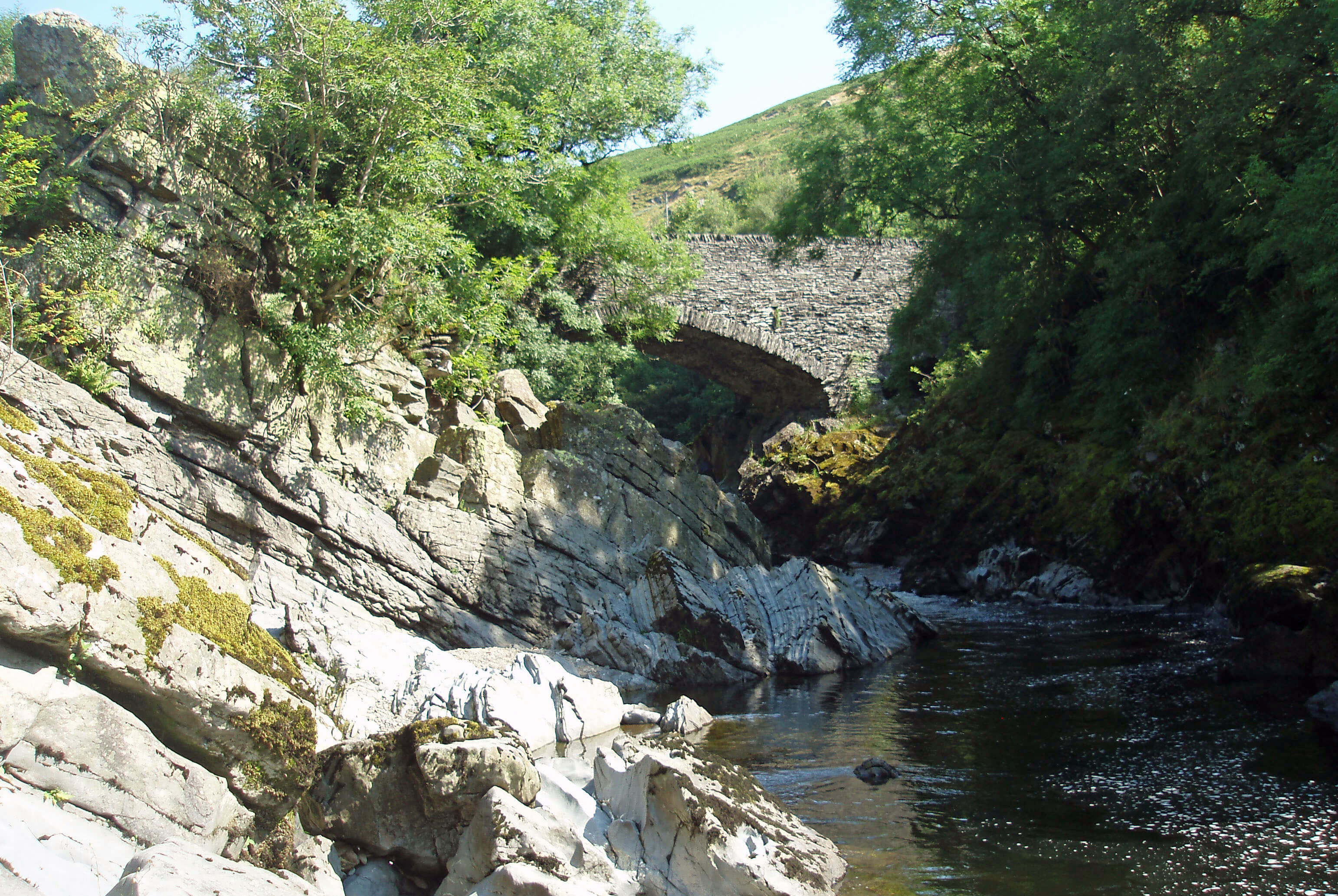 Left: Lune’s Bridge
Left: Lune’s Bridge
Mabey was writing within
a book entitled Weeds: The Story
of Outlaw Plants where he acted
as defence lawyer for weeds.
He wanted to argue that
weeds are not always guilty
of all that they are accused.
So, when he considers the
Himalayan-balsam as a weed,
he needs to defend that too.
The everyday definition of a weed as a plant in the wrong
place tells us immediately that ‘weed’ does not have any botanical
definition. We decide where is a ‘wrong’ place. Therefore, ‘weed’
is a psychological construct. Moreover, it is obvious that what is
a ‘wrong’ place depends on who, when and where the opinion is
expressed.
Weeds annoy us: they grow where they shouldn’t; they banish
the plants we’d prefer to grow there; some are ugly and smelly; some
scratch and sting us; some have the audacity to run wild after we’ve
invited them in good faith to this previously green and pleasant
land. Ruskin thought them “impertinent” for always sticking their
roots in where they were not wanted [2].
He also believed that God put all plants on Earth for our benefit - to eat, to admire, or whatever.
It is tempting to humanise weeds as aggressive louts but they are
only doing what evolution has led them to do, as all plants do.
Not all of the above applies to the Himalayan-balsam. Those
who appreciate the splendour of its flowers might need some
convincing that Himalayan-balsam is a weed not an adornment.
Mabey argues that weeds are not only human-defined but
they are human-encouraged, in the sense that they grow where we
disturb the land, by, for example, attempting to grow crops. Of
course, if there were no humans there would be no weeds. And
if we disturb land it tends to be what we regard as weeds (nettles,
bindweed, brambles, and the like) that take over first. Himalayan-balsam may be most apparent in areas of urban desolation but it
does not require disturbed land to flourish. It will happily take
over river banks that have been virtually unchanged for centuries.
Supporters of Himalayan-balsam find solace in a report that
concluded that Himalayan-balsam “exerts negligible effect on the
characteristics of invaded riparian communities, hence it does not
represent [a] threat to the plant diversity of invaded areas” [3].
This appears to contradict an earlier study that found a highly significant
increase in species richness and diversity following the removal of
Himalayan-balsam [4].
... From Lune’s Bridge the path south follows a track rather
high above the Lune, some of which it is possible to survey with
binoculars. No balsam was seen. At Brockholes the track drops
down to the Lune and on to Salterwath Bridge. Here seems prime
Himalayan-balsam habitat: lush, damp and partially shady. If there
were balsam above this point then its seeds would surely flourish
here - but there was no sign of it ...
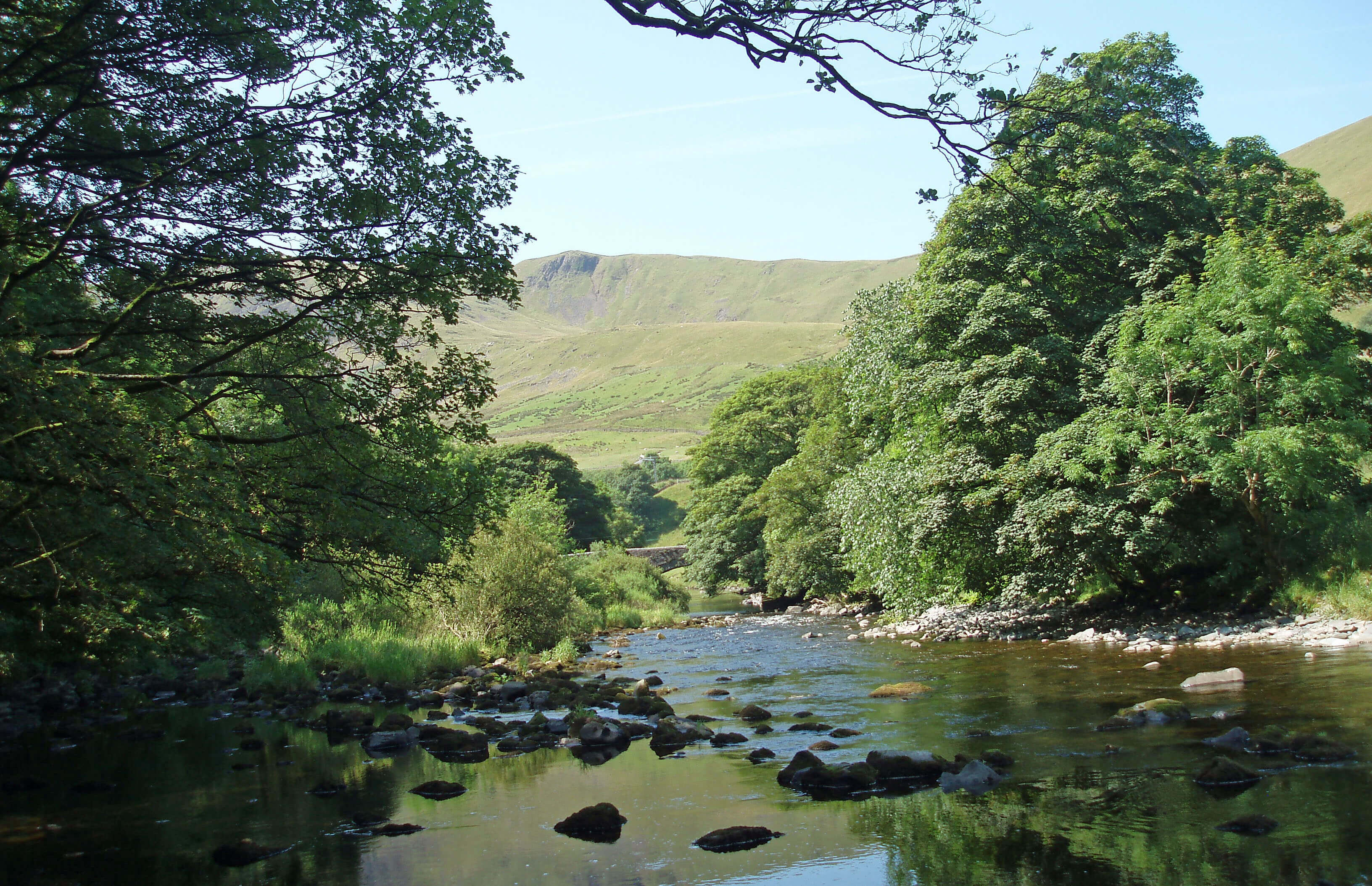 Right: Salterwath Bridge, with Grayrigg Pike beyond
Right: Salterwath Bridge, with Grayrigg Pike beyond
It is the academic botanist’s job to debate, discuss and refine the
experiments. What am I to make of such controversies?
I cannot get into the
minutiae of the experimental
studies but I can look for, and
be wary of, mis-statements
of what the reports claim
to show.
Wikipedia, for
example, says that the former
study “concludes that in some
circumstances, such efforts
[that is, balsam bashing] may
cause more harm than good”.
In fact, it shows nothing of the
sort. It presents no evidence
that removing the balsam
causes more harm than
good. It isn’t concerned with
removing the balsam at all!
My interpretation of the
study is that on six measures
Himalayan-balsam was found to have a negative, but statistically
insignificant, effect on other species. I must accept what the statistics
don’t tell me, but, on the other hand, if Himalayan-balsam is really
neutral, what are the chances that all measures will come out
negative? One in 32, I believe, if the measures are independent.
When I stand in a thicket of Himalayan-balsam, with the leaves
by my ears, I can reach down and grasp the stems. Occasionally I
may grasp a nettle. That is all. There is no danger of accidentally
uprooting a valued native plant. There is effectively only one
species present, the balsam.
There is only one way in which this balsam could not have led to
a decrease in the number of species compared to before the balsam
invaded: that is, if previously there was at most one species present.
For example, there may have been only a thick bank of nettles. In
that case, the Himalayan-balsam has simply replaced the nettles -
and we may be rather content with the exchange.
To digress for a moment, nettles are the bane of our childhoods
and one of our most detested weeds. We once took a visitor from
Bulgaria for a walk along our lanes and she was surprised that we
did not ‘harvest’ the nettles. She did, to make us nettle soup, which
wasn’t too bad. In fact, nettles have a long history as a food source
and a medicine. No doubt many of our weeds were of use to us in
the past and might be of use in the future. However, we must not
fall into Ruskin’s fallacy of assuming that plants are here for us. To
digress even further, the baneberry has berries so poisonous that
they may lead to death. Is it a weed?
Returning to Himalayan-balsam, the report that found a
negligible effect did not study areas completely dominated by
balsam. It considered plots in which there were about ten species
present and in which the balsam was considered to cover about half
the area.
If I wander away from my thickets of balsam into the fringes of
its invasion zone I encounter conditions more like those studied in
this experiment. The balsam is not so high: it doesn’t need to be,
as it’s not yet competing against other balsam. It is intermingled
with numerous native species. Balsam bashing here is a more
laborious process. I cannot just grab handfuls of the stuff with my
eyes closed. I must carefully select (weed out) the balsam stems.
Progress appears to be much slower but it is perhaps as important
to prevent the balsam’s further spread as it is to tackle ‘lost’ areas.
I can well imagine that a study focussing on areas not fully
invaded will find most species still present (which is what the study
counted) although probably not in the same numbers as before. If,
however, a study considers areas that are 80-100% covered with
Himalayan-balsam (as the earlier study mentioned above did) then,
even with my limited amateur experience, I would expect different
results, as the earlier study found.
... From Salterwath Bridge the road runs south to Carlingill
Bridge and then on to Fairmile Road. The road is rather high above
the Lune, from which it is shielded by a line of trees. I decided to
skip ahead to Crook of Lune Bridge at Lowgill and reconnoitre back
from there. Again, although the habitat seemed ideal for it, I could
see no balsam near the bridge, nor for a mile up-river ...
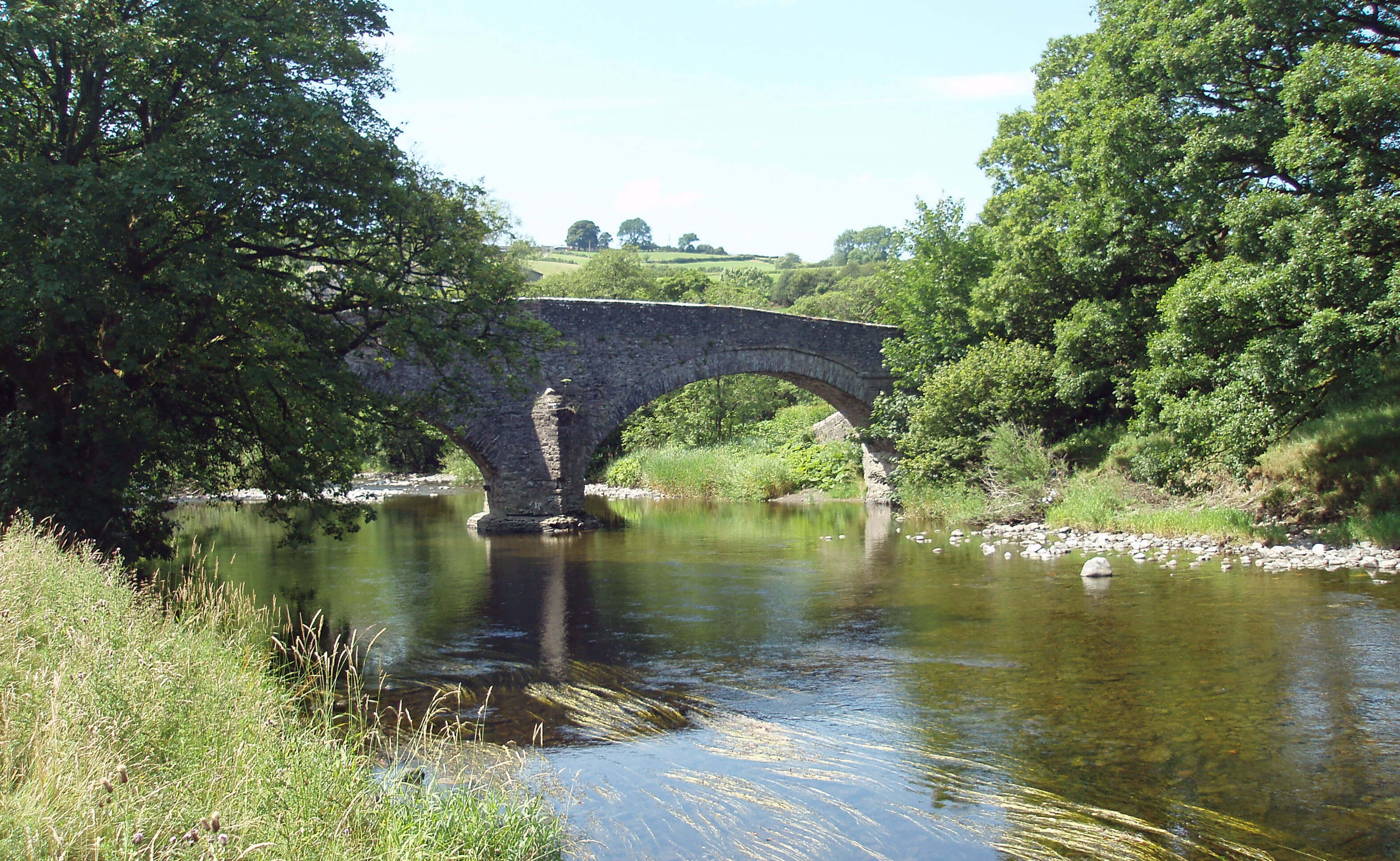 Left: Crook of Lune Bridge
Left: Crook of Lune Bridge
Why do Mabey and others defend Himalayan-balsam? I have
mentioned some of the reasons:
• it looks attractive and may be thought to brighten the urban
environment;
• it does no harm, according to some interpretations of research
studies;
• it is an annual and therefore dies away each winter (the seeds
don’t though!);
• rather than balsam bashing, it would be better to control the
conditions under which it flourishes, by decreasing the amount
of nitrates and phosphates in the water;
• the bees like it, especially in late autumn when other flowers
have died away (but those other flowers have had insufficient
pollination because of the balsam’s attractiveness to bees);
• it is now far too established throughout the UK to be eradicated
anyway, especially where it grows in inaccessible areas.
Nonetheless, Himalayan-balsam is now considered by the
UK government to be not a mere weed but a member of the set
of Invasive Non-Native Species (INNS), which DEFRA regards as
“one of the greatest threats to biodiversity across the globe”.
A programme to banish all non-native plants would require
thorough research through horticultural histories to determine
which of our plants should
be sacrificed: escallonia?,
rhododendron?, eucalyptus?
laurel? But if we go on about
non-native species then we risk
being accused, like
Gardeners’ Question Time
recently, of
being “layered with racial
meanings” and linked to “the
rise of nationalist and fascist
parties”.
It is not non-nativeness
per se that makes a particular
species a threat. To be
objectionable a non-native
plant needs to have negative
characteristics that outweigh
its positive ones. If it out-competes native plants, such as cowslips,
which then become in danger of extinction, we might take action
to protect our cowslip. If an introduced plant had a fruit that
resembled a strawberry but was poisonous, then we might seek to
have it prohibited. There are many such negative properties but
the one that the DEFRA policy focusses upon is invasiveness.
DEFRA defines invasive species as ones “that can become
dominant in the environment where they may impact on other
(native) species, transform ecosystems and cause environmental
harm”. The boundary is not always clear. Sycamore is non-native
but has only recently come to be regarded as invasive, at least, in
environmentally sensitive areas. It is definitely regarded as invasive
in other contexts, such as Australia. The snowdrop, too, is an import
and might, by the definition, be considered invasive. But, of course,
we are too fond of it now to wish to get rid of it.
Himalayan-balsam is officially an Invasive Non-Native Species.
What does that imply?
DEFRA’s 2003 review of INNS policy made a number of ‘key
recommendations’ that indicated an intention to develop a nation-wide programme of action [5].
In due course, we have begun to tackle
the problem of Himalayan-balsam along the Lune and its tributaries.
The Cumbria Freshwater Non-Native Species Initiative has been
established and in 2012 organised over 4,000 hours of volunteer
balsam bashing. In 2011 the Lancashire Invasive Species Project
was set up to coordinate the control and eradication of invasive
species throughout Lancashire. Several local groups have set about
the balsam.
If all else fails, we can resort to the law. As Himalayan-balsam
is listed under Schedule 9 to the Wildlife and Countryside Act 1981
it is an offence to plant or otherwise allow this species to grow in
the wild. However, nobody has ever been prosecuted with respect
to Himalayan-balsam under the 1981 Act - not least, because of
the difficulty of defining “in the wild”. I suppose that whenever
I am on a countryside walk and pass Himalayan-balsam, thereby
allowing it to grow, I am, strictly speaking, breaking the law.
... I returned to the Crook of Lune Bridge to continue my search
down-river. This path is part of the Dales Way and it is indeed an
idyllic walk. Below the bridge two sandpipers were happily piping.
There were also several grey-wagtails, a dipper or two, a heron,
and, when I paused to inspect the river closely, many tiny fish in
the Lune’s shallows. There were also two women swimming in a
secluded, deep pool.
But then I saw my first
Himalayan-balsam, on the
riverbank below Crook of Lune
Wood. I uprooted it, of course.
The photo of Himalayan-balsam above shows it before I uprooted it.
I walked on to the footbridge
over Ellergill Beck but saw
no more balsam. Indeed, a
later cursory inspection of the
Lune at Lincoln’s Inn Bridge
near Sedbergh revealed no
Himalayan-balsam there
either. I like to imagine that
I have, single-handedly,
prevented infestation of a fine
three-mile stretch of the Lune.
The balsam on the lower
Lune is for another day, or several.
[1]. Richard Mabey (2010), Weeds: The Story of Outlaw Plants, London: Profile
Books.
[2]. John Ruskin (1876), Proserpina.
[3]. M. Hejda and P. Pysek (2006), What is the impact of Impatiens
glandulifera on species diversity of invaded riparian vegetation?,
Biological Conservation, 132, 143-152.
[4]. P.E. Hulme and E.T. Bremner (2005), Assessing the impact of Impatiens
glandulifera on riparian habitats: partitioning diversity components
following species removal, Journal of Applied Ecology, 66, 66–79.
[5]. DEFRA’s Invasive Non-Native Species Framework Strategy is at:
https://secure.fera.defra.gov.uk/nonnativespecies.
18. Juniper on Moughton
September 2014
I thought that I had better go to see the juniper on Moughton
before it was too late. Too late? The juniper on Moughton has
been there for thousands of years. Surely, it is not about to
disappear - is it?
Common-juniper Juniperus communis is one of only three native
conifers, the others being yew and Scots-pine. Juniper is a long-lived, slow-growing, adaptable plant. It can grow from sea-level
to mountain-tops and on a range of soils, from the lime-rich soils
of southern England to the base-rich or acidic soils of Scotland. On
Moughton it grows on limestone. It can form an erect tree but on
Moughton, where the juniper is fully exposed to the elements, it is
a low, spreading shrub, rarely more than a metre high.
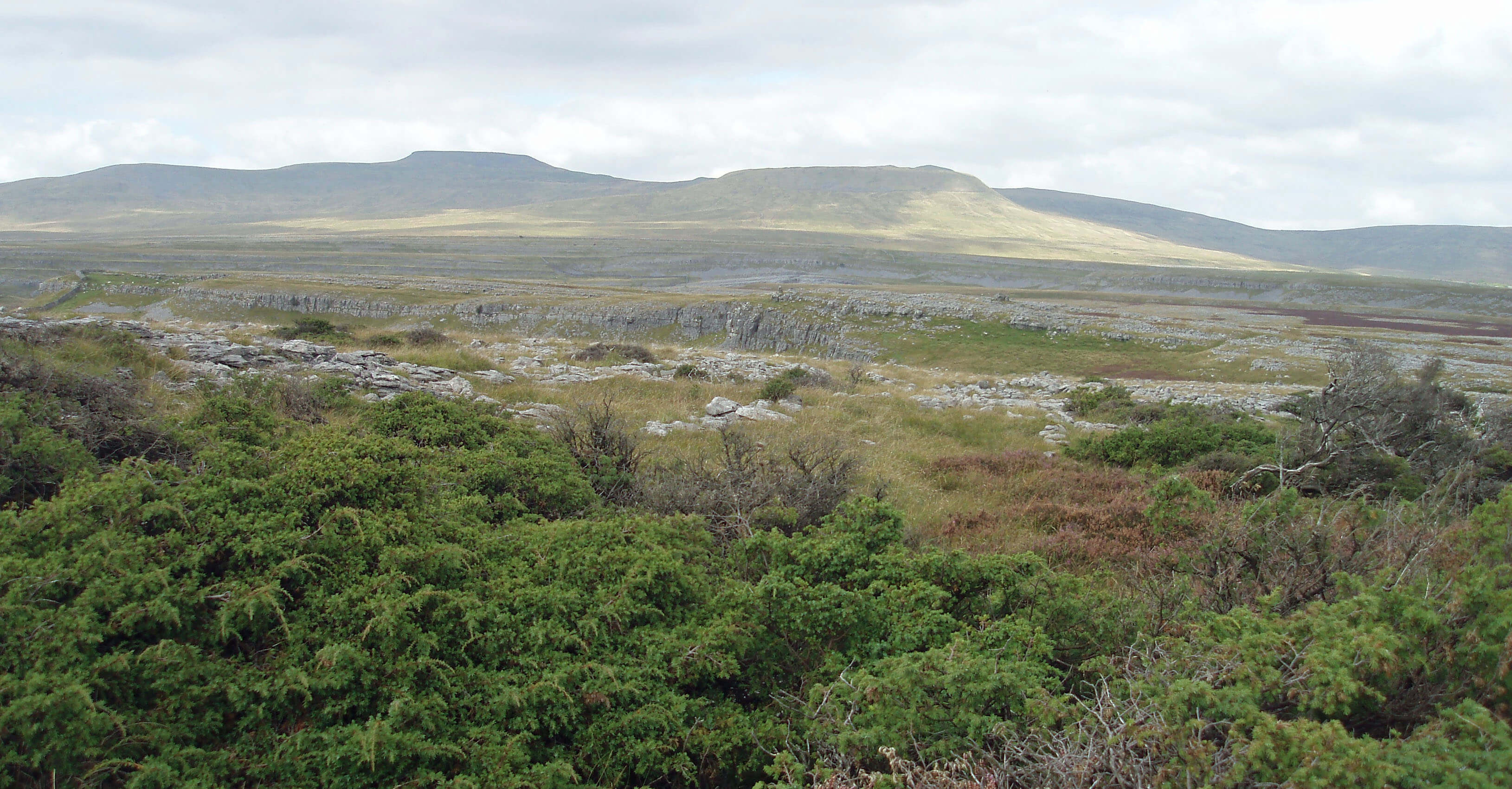 Left: Juniper on Moughton, looking towards Ingleborough
Left: Juniper on Moughton, looking towards Ingleborough
Juniper has a tough, wiry, red-brown bark. It flowers in April
with the male and female flowers on separate plants. The female
berries are green, turning blue-black as they ripen. These are the
berries well-known for flavouring gin and cooking.
But doesn’t ‘conifer’ come from the Latin conus (cone) and ferre
(to bear)? How come juniper has berries not cones? So another
naive question arises: what exactly is a ‘cone’? After diligent
research, I found that a cone is an organ on conifers that contains
the reproductive structures - which doesn’t take me very far. But I
also found that juniper has ‘berry-like cones’, so that’s fine, then. I
have learned that a cone is not necessarily cone-shaped.
Although it is one of the commonest trees worldwide, juniper
is the rarest of the three native conifers in the UK, even more so
after a significant reduction in its distribution in the last fifty years.
This is mainly because of changes in land management, such as
over-grazing and afforestation. Juniper is now identified as a UK
BAP priority species, that is, as one considered to be among the
most threatened and requiring conservation action under the UK
Biodiversity Action Plan.
Juniper was once widespread on the hills of the Yorkshire Dales
and the Forest of Bowland. It usually grew as a shrub within open
woodland of birch and rowan. I would imagine that a century
or two ago juniper was common on the slopes of Ingleborough,
Whernside and neighbouring peaks. I am not aware that it survives
as a native species anywhere within Loyne to the extent that it does
on Moughton - and even there it is rather sparsely spread.
I expect that sheep are mainly responsible for the disappearance
of our juniper. Sheep have also removed almost all vestiges of
heather, previously widespread, from the slopes of Ingleborough
and elsewhere. Perhaps sheep do not find it necessary to leave
the sheltered abundance of grass in Crummackdale to tackle the
fractured limestone pavements on the top of Moughton for the
dubious pleasure of nibbling the tough leaves of juniper. For
the same reason, I assume, there is still heather to be found on
Moughton, enough to lure two red-grouse seen on our visit but not,
I am sure, enough to lure sufficient grouse to satisfy any shooters
tempted to use the now dilapidated grouse butts on the plateau.
Humans may be partly to blame for juniper’s disappearance
too. In the past we found many uses for juniper and our harvesting
of it helped to disturb the ground and create conditions for it to
seed. No doubt, once the juniper had no value, we often simply
cleared it out.
Juniper was used for firewood and to line farm walls. It burns
with little smoke, ideal for curing ham and for illegal distilling. The
berries (but now from overseas juniper) are still used not only for
flavouring but also in liqueurs and sauces - and were also used, as
recently as the 1980s, within ‘juniper pills’ to terminate a pregnancy.
The berries had a variety of medicinal uses, from resisting the
plague to acting as an antidote to poison. Juniper was also hung
over doorways to ward off evil spirits, but for some reason this is
unnecessary nowadays.
The juniper has been on Moughton for a very long time,
probably since shortly after the Ice Age. The healthy specimens
on Moughton are accompanied by many dead and dying ones. I
expect that that has always been the case because, as far as I can tell,
they are dying of nothing more serious than old age.
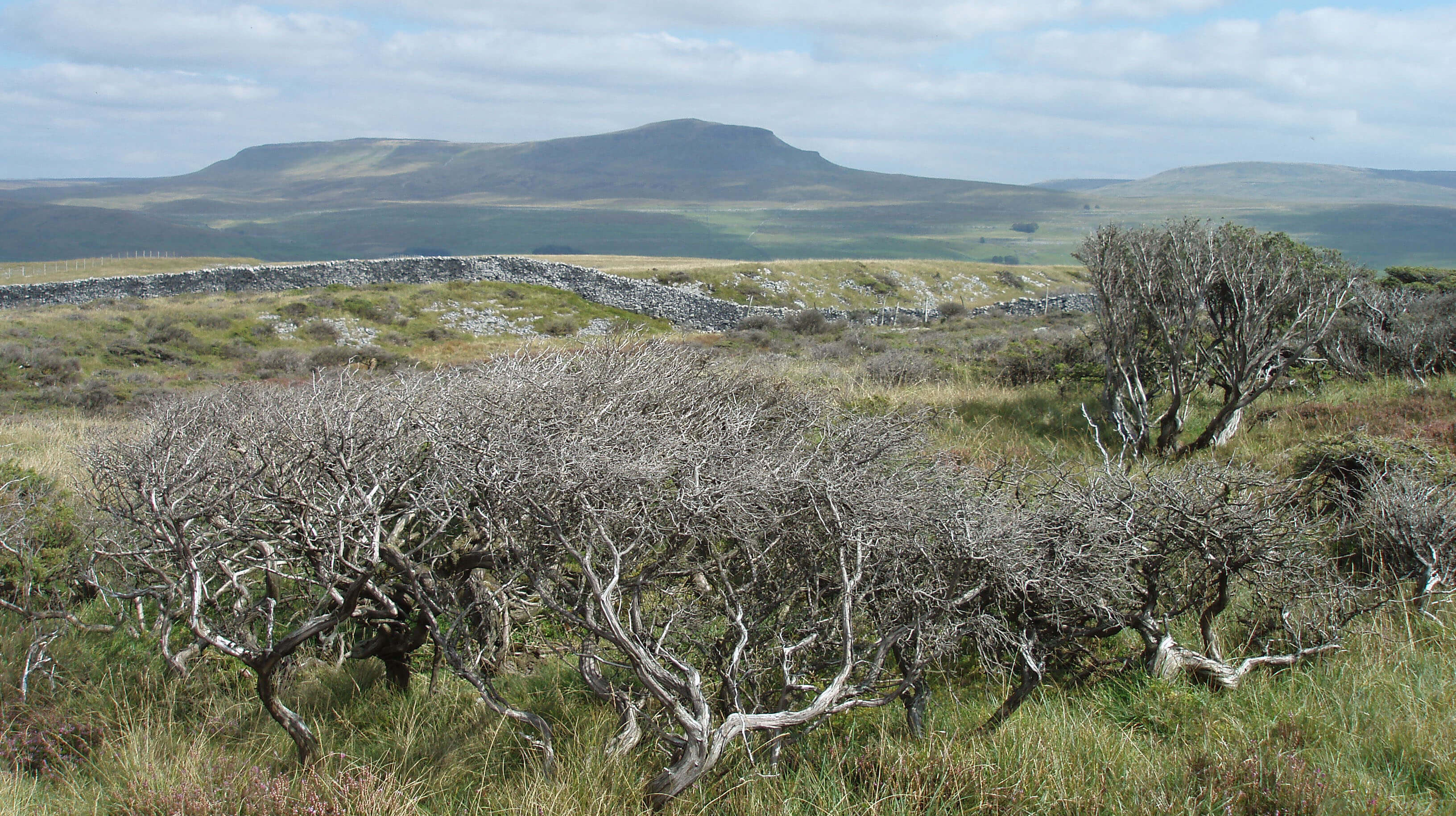 Left: Dead juniper, with Pen-y-Ghent beyond
Left: Dead juniper, with Pen-y-Ghent beyond
However, this may be about to change.
In 2011 juniper in Teesdale was found to be dying. It was being
attacked by a fungus Phytophthora austrocedrae (to be precise, a
fungus-like plant pathogen) that had somehow been imported from
South America.
When the juniper roots are infected, the foliage
turns a lighter green, withers, turns a bronze-brown, and the plant
dies. Other pathogens cause similar symptoms and it therefore
takes an expert to recognise Phytophthora austrocedrae, which is
usually done by analysing the inner bark.
The fungus has since been found at many juniper sites in the
Scottish Highlands, the Lake District, and elsewhere, according to
the Forestry Commission map.
This is naturally a cause for alarm.
The Telegraph immediately worried about the threat to gin and
tonic (akin to its reaction to the glut of elvers, chapter 8) [1].
It need not be too worried as there is plenty of juniper abroad, where the gin is
made, and we have not (yet) exported the fungus.
 Right: Moughton Scars with Moughton beyond
Right: Moughton Scars with Moughton beyond
It is, however, not a frivolous matter. As yet, UK scientists do not
know precisely how the fungus spreads or how it may be controlled.
Even if we are not particularly fond of juniper, we should be aware
that it is a key food plant for a wide range of invertebrates and
birds, and there is a specialised group of insects, fungi and lichens
associated with it.
The public has been made aware of the threat of ‘ash dieback’,
because ash is such an iconic British tree. There are about a dozen
other trees, including alder, larch and horse-chestnut as well as
our juniper, that are also under various threats. Have our trees
always been under such threats, and we have only recently become
aware of it, or are they becoming increasingly vulnerable to alien
pathogens? If the latter, what can we do about it?
Earlier this year Natural England reported that Phytophthora
austrocedrae had been confirmed on Moughton. We went to
Moughton half-expecting to find the juniper fenced off, as per
Natural England’s guidelines, in order to prevent people like us
blundering about inadvertently spreading the fungus.
However, there were no fences or warning signs to indicate that
anything was amiss. The juniper, although somewhat decrepit, did
not show any of the symptoms of the fungus attack. I am no expert,
of course, and in any case we only investigated the juniper on the
northern part of Moughton, from the Whetstone Hole footpath up
to the trig point. We did not go on to the southern half, where there
seems to be less juniper. By that stage we had lost our enthusiasm
for finding dying juniper.
We preferred instead to walk along the exhilarating cliff edge
of Moughton Scars over to Beggar’s Stile above Crummackdale
in order to enjoy the marvellous views of Ingleborough and Pen-y-Ghent over the
sea of limestone pavement. But we could not
entirely forget that these magnificent hills had lost all their juniper
- and that soon the Moughton plateau behind us may do likewise.
[1]. The Telegraph (June 19, 2013), Juniper tree disease threatens G&T.
19. Wolf-Spiders by the Lune
September 2014
 Right: Loyn Bridge, Hornby
Right: Loyn Bridge, Hornby
I have been re-reading Robert Macfarlane’s The Wild Places [1] in the
hope that I might find some profound insight into the concept
of wildness.
The book describes a series of expeditions to
elucidate the nature of wildness, although not of wild life but of
wild places. Macfarlane spent a night shivering on the summit of
Ben Hope, Scotland’s northernmost mountain. He tramped across
the vast boggy hags of Rannoch Moor. He spent time alone on the
island of Ynys Enlli off the Lleyn Peninsula. He slept on a frozen
tarn during a blizzard below Red Pike in the Lake District.
However, after all these bold endeavours, he concluded (page
316) that “wildness was not about asperity, but about luxuriance,
vitality, fun. The weed thrusting through a crack in the pavement,
the tree root impudently cracking a carapace of tarmac: these were
wild signs, as much as the storm wave and the snowflake. There
was as much to be learned in an acre of woodland on a city’s fringe
as on the shattered summit of Ben Hope”.
That is a relief. I have plenty of weeds and tree roots to study
in preference to spending nights on freezing mountain tops. In that
spirit, I have come to reflect on the nature of my own expeditions.
I too have sought, in my less heroic way, the extreme rather than
the commonplace. When I went in search of, say, purple-saxifrage
on Ingleborough, it was not because I had suddenly developed a
deep interest in purple-saxifrage itself, as a flower. That would
be irrational because purple-saxifrage is, as far as I know, no
more interesting than any of the other 440 species of saxifrage. A
wildflower guide devotes no more space to purple-saxifrage than it
does to other saxifrages. If I’m going to search for purple-saxifrage
then perhaps I ought to make an equal effort searching for the
others.
No, the reason that I am interested in purple-saxifrage is not to
do with its properties as a flower. It is because purple-saxifrage is
rare in Loyne, because its existence on Ingleborough is part of the
history of the region, and because the search for purple-saxifrage
presents an invigorating challenge. Similarly, the search for locally
rare species such as the small-pearl-bordered-fritillary, the marsh-gentian, the small-leaved-lime and so on appeals to me because the
challenge provides a pretext for me to learn more not just about those
species but also about the ecological challenges facing Loyne.
However, perhaps I should not neglect the commonplace
even if it seems to have little specific to tell me about Loyne. As
I sit here at my desk, I can see spiders and flies (I should house-clean occasionally). The wood-pile that I can see outside hosts
worms, snails, slugs, ants and beetles. I have no idea if there is any
interesting Loyne-specific story to tell about spiders, flies, worms,
snails, slugs, ants or beetles.
Let me consider spiders. I read that there are over 600 species
of British spiders. That’s more than there are British birds. But
whereas I can name many birds I am struggling to think of more
than a handful of spiders: tarantula, daddy-long-legs, money-spider, redback, black-widow. That’s about it.
I then read that all but one of those are not species at all but
groups of species (like, say, gull and raptor in the bird world). The
one species, redback, is Australian. Two of the others, tarantula
and black-widow, are not British either. Of the two British groups,
one of them, daddy-long-legs, does not include just spiders. It also
includes crane-flies, which are not spiders or flies, and harvestmen,
which are not spiders or men. The money-spiders, of which there
are over 4,000 species worldwide, are said to be so-called because
of a superstition that if they land upon you they will bring you
good fortune. That, however, doesn’t seem a foolproof method of
identifying them.
So, I cannot name, let alone identify, a single British spider!
This is not entirely my fault. Some British spiders, even quite
common ones, don’t seem to have names (I am not yet prepared
to utter Coelotes atropos in any conversation). Others, such as
Araneus diadematus, have several: cross-orbweaver, cross-spider,
diadem-spider, European-garden-spider. Most have plausible,
but to me unfamiliar, names, such as cave-spider (Meta menardi),
green-huntsman (Micrommata virescens), spitting-spider (Scytodes
thoracica), and so on. There is also an invisible-spider (Drapetisca
socialis), which I have not seen to put a name to.
Where do I begin? I should ensure that I know what a spider is.
Spiders (order Araneae) are of the class Arachnida of the subphylum
Chelicerata of the phylum Anthropoda of the kingdom Animalia.
Anthropods (which include insects, crustaceans and spiders) are
invertebrate animals with an external skeleton, a segmented body,
and jointed appendages. Chelicerates (which include horseshoe-crabs, sea-spiders (which are not true spiders) and spiders) have
biting appendages before the mouth - in the case of spiders,
usually fangs to inject venom into prey. Arachnids (which include
scorpions, mites and spiders) have four pairs of legs and two body
segments, the cephalothorax and abdomen. Spiders, unlike other
arachnids, produce silk from spinnerets, usually found at the end
of the abdomen.
Spiders don’t travel far but since Loyne has a wide range of
habitats, I’d guess that 300-400 of the 600 British species are to
be found here. If I were to write about a species of spider each
month that would keep me going until 2045 or so. Is there anything
particularly interesting to say about any one of them?
Well, here’s one that might have specific Loyne appeal, in so
far as any spider is appealing: northern-bear-spider, Arctosa cinerea.
These are ‘wolf-spiders’, so-called because they are agile, robust
hunters, not, sadly, because they hunt in packs. Arctosa cinerea is
one of Europe’s largest spiders, its body (not including the legs)
being up to 17mm long.
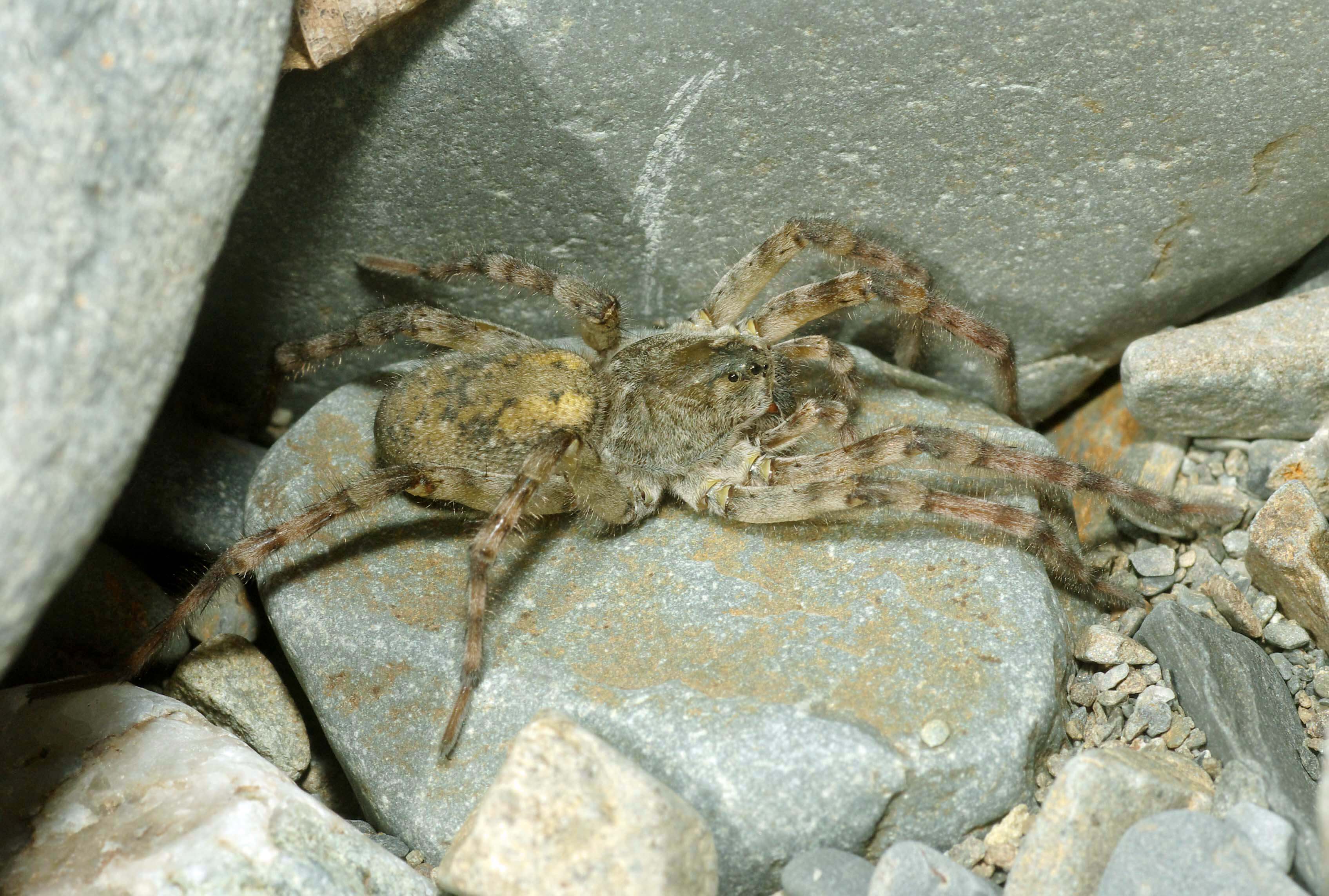 Left: Arctosa cinerea
(Steven Falk)
Left: Arctosa cinerea
(Steven Falk)
Most spiders have eight eyes. Perhaps you knew that. I didn’t.
So, an eye for each leg, except that the eyes aren’t on the legs, of
course - they are on the head, as usual, except that spiders don’t have
heads (the head is merged with the thorax). The eyes are usually
poor compared to those of most insects, as most spiders rely more
on touch and taste. But Arctosa cinerea is a hunter and needs good
eyes. It has two large eyes in a middle row, two medium-sized eyes
in a top row, and four small eyes in a bottom row.
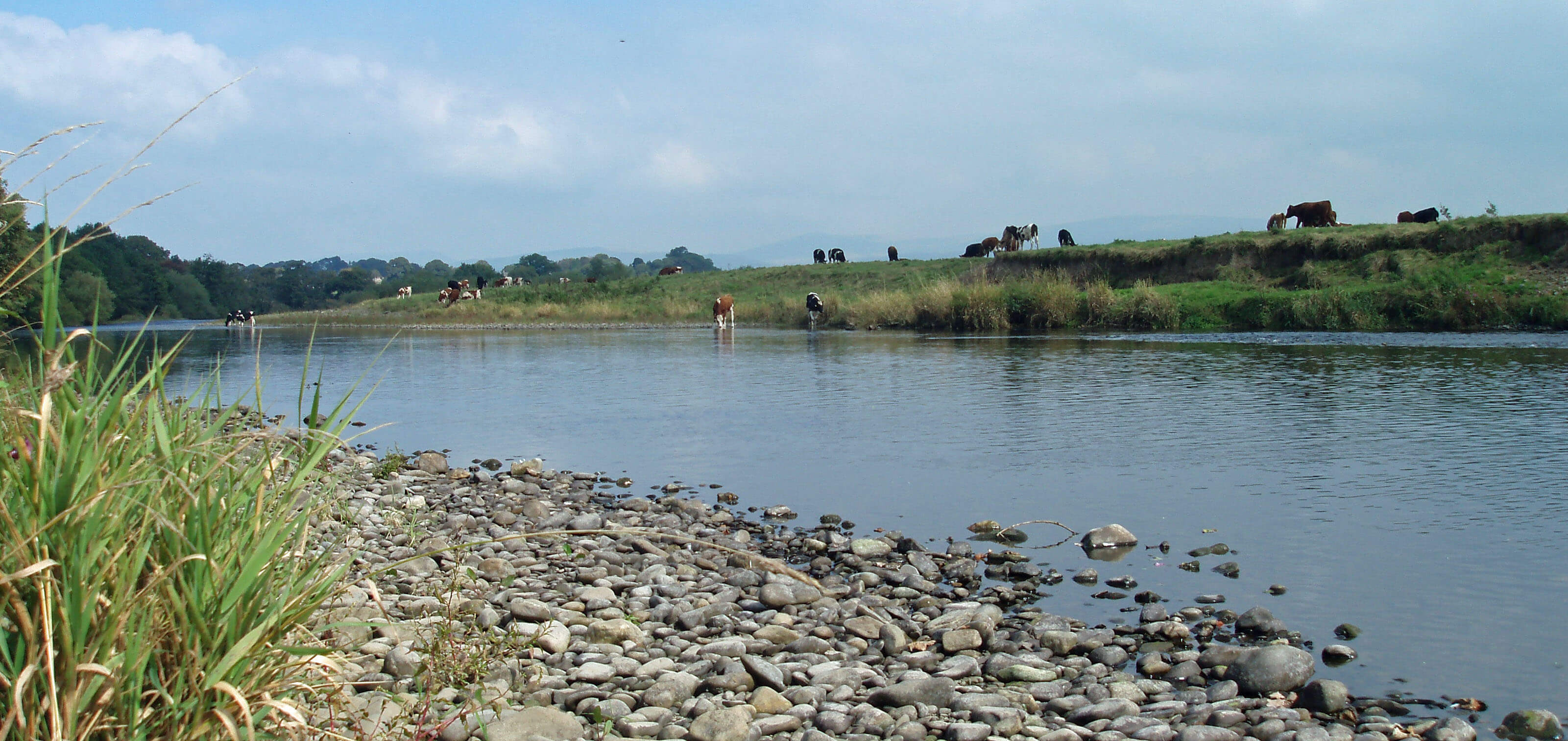 Right: The Lune near Thrush Gill Island, where Loyne’s Arctosa cinerea were first
recorded in 1976
Right: The Lune near Thrush Gill Island, where Loyne’s Arctosa cinerea were first
recorded in 1976
It just so happens that Loyne’s Arctosa cinerea are at the southern
limits of the British range, apart from some in Wales that I won’t
mention. It lives on the shingle edges of the River Lune. It hides
under the cobbles and digs holes that it covers with silk, where it
presumably remains during floods. It likes to live near the water’s
edge but not amongst vegetation. This implies that this apparently
barren region must satisfy rather precise conditions to suit the
spider: the river must not flood for too long, or the spider will
drown, but it must flood often enough to wash vegetation anyway.
This is an example of how tampering with the flow of a river may
have effects on wildlife that we don’t even know about.
The
British Arachnological Society’s map indicates that Arctosa
cinerea has been found along the Lune between Hornby and Kirkby
Lonsdale.
I thought that I’d investigate.
How do arachnologists arachnologise? I doubt that they set
out to find a specific species of spider. I imagine that they catch
whatever spiders they can, perhaps using traps, and then study
them with lenses at their leisure and pleasure.
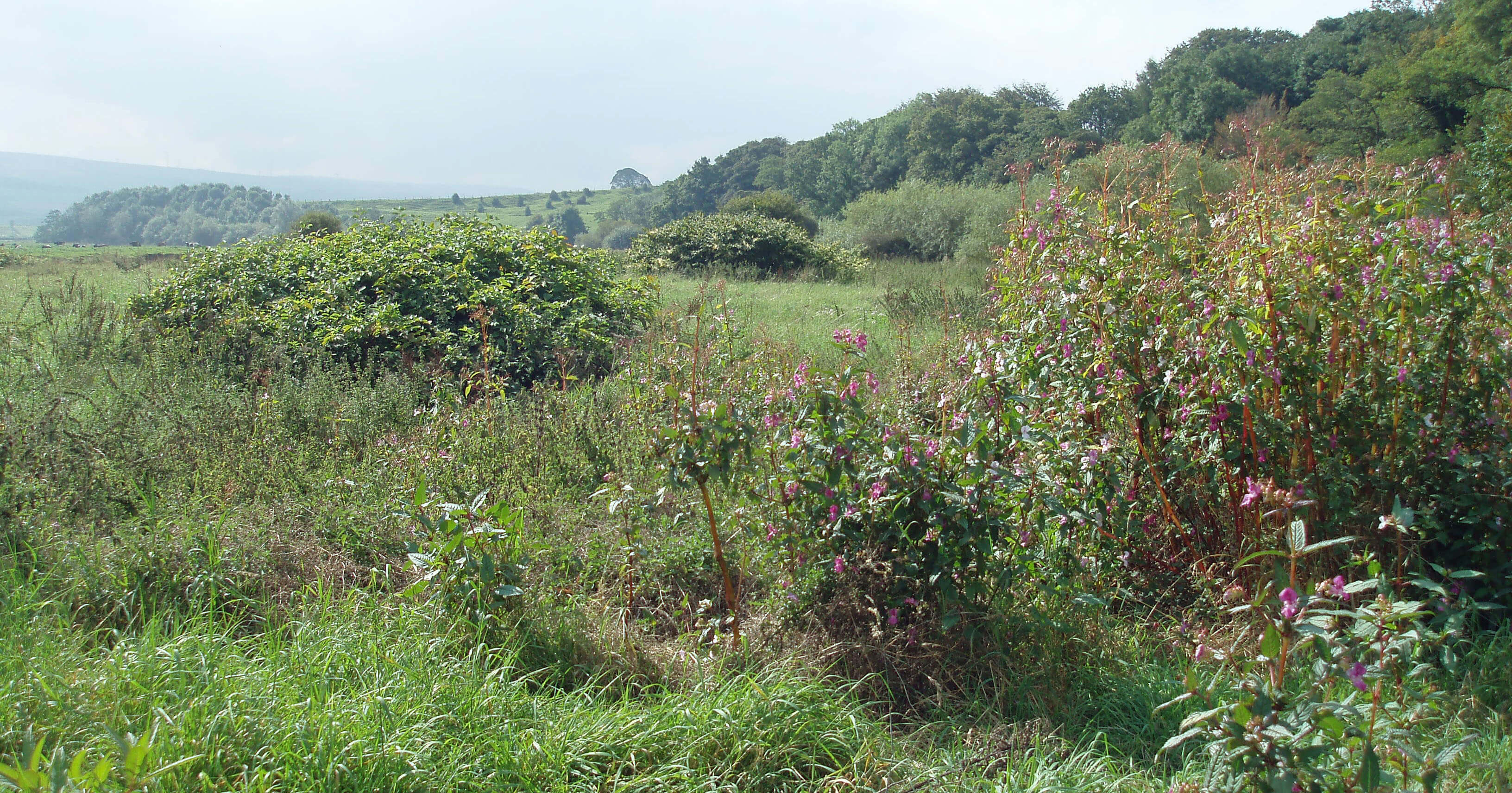 Left: Japanese-knotweed and Himalayan-balsam up river from Loyn Bridge
Left: Japanese-knotweed and Himalayan-balsam up river from Loyn Bridge
Anyway, I decided to walk north along the Lune Valley Ramble
from Loyn Bridge at Hornby to see where Arctosa cinerea live. I
didn’t expect, and nor should you, that a novice spiderman could
just go and find a particular spider for you. For one thing, Arctosa
cinerea wisely begins to hibernate in September.
Alas, I found that most of the shingle beaches were on the
opposite bank, where there is no public footpath. Even more alas,
most of my bank was protected by depressing swathes of Himalayan-balsam, plus some Japanese-knotweed for good measure.
I clambered over to a few shingle beaches and self-consciously
turned over a few hundred cobbles (I don’t know what I would have
said if anyone had asked me what I was up to). I sent a few small
spiders scampering about. None were considerate enough to keep
still to allow a close inspection. I hope that they weren’t Arctosa
cinerea because I picture them as considerably more fearsome.
My overall conclusion, however, is that while all the creepies,
the crawlies, the wigglies, the slimies, and so on are indeed part of
wildlife in all its glory there are just too many of them, all much
of a muchness to me. I have no doubt that they are really deeply
fascinating in their own way but if I developed a serious interest
in spiders, say, I’d have no time for anything else, which I’m sure
we’d all regret.
[1]. Robert Macfarlane (2007), The Wild Places, London: Granta Books.
20. Hen-Harriers in Roeburndale
October 2014
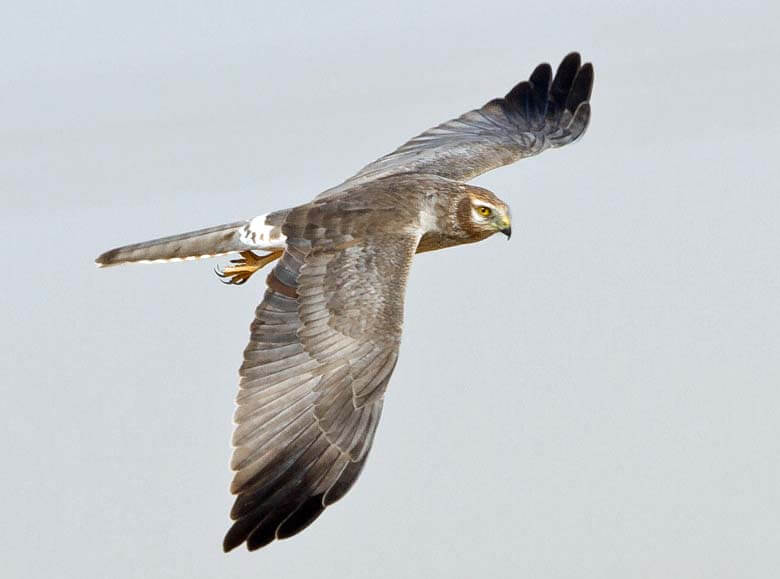
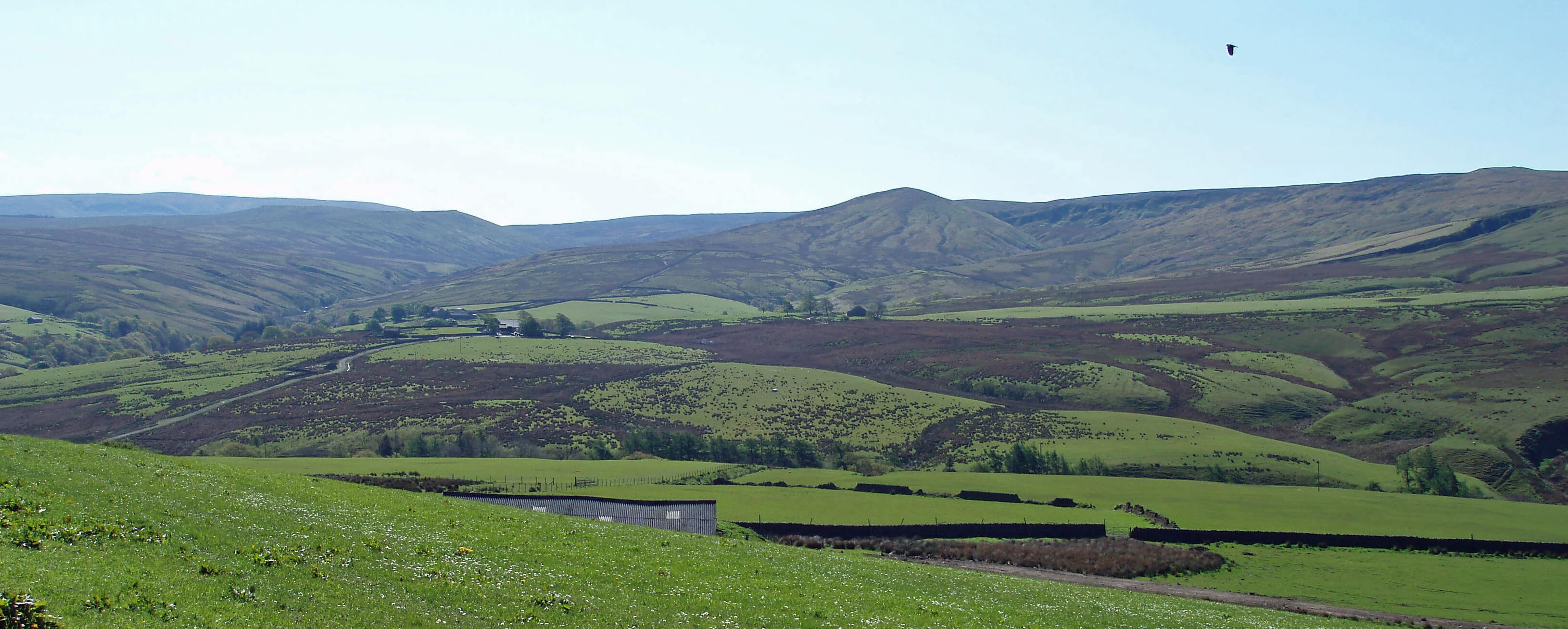 Left: Hen-harrier (Mike Barth)
Left: Hen-harrier (Mike Barth)
Right: Mallowdale Pike
The inconsequential flow of this narrative has been interrupted
by an event that may alarm, anger and shame us in Loyne. In
September two young hen-harriers were killed - or, in case
lawyers are reading, disappeared in suspicious circumstances - in
the Roeburndale region of Bowland. I am temporarily abandoning
my self-imposed rule of only writing about what I have seen, or at
least tried to see, in order to give the background to this event.
The hen-harrier Circus cyaneus is not just any old bird. It is the
icon of Bowland. It forms the logo of the Forest of Bowland AONB.
How did it come to be so? Why was it necessary to put tracking
devices on the fledgling hen-harriers? Why did they suddenly stop
transmitting in September?
In the early 20th century, habitat loss and persecution drove UK
hen-harriers to nest only on the Orkney Islands. During and after
the 1939-45 war, while estate owners and their gamekeepers were
distracted, the hen-harriers gradually spread south. They began to
breed again in England in 1968.
The recovery was always fragile even though there is suitable
habitat for several hundred pairs. Hen-harriers are birds of open
landscapes, not only the uplands to which breeding has recently
been restricted. They usually nest on the ground in mature heather.
Breeding activity generally starts with adult males attempting to
attract a mate by means of spectacular aerial displays known as sky-dances. In recent decades Bowland provided a relative stronghold
for breeding hen-harriers in England.
A
Natural England report
reviewed the breeding success of hen-harriers in England for the years 2002-2008.
In those seven years
there were 72 successful nests in England, yielding 225 fledged
young. Of those 72, 52 (with 179 fledglings) were in Bowland.
Of those 52, 42 were on land owned by United Utilities (a water
company) and 10 were on land managed as driven grouse shoots.
The report does not give the areas of land involved but I
doubt that United Utilities owns more of Bowland than is used
for grouse shooting. So, an obvious question is: why were there
so few successful nests on the grouse moors? Also, why were the
proportion of nesting attempts to be successful and the number
of chicks per successful nest lower on the grouse moors? Perhaps
United Utilities and the owners of grouse moors do not have the
same incentives to want hen-harriers not to flourish.
The report also analysed the reasons that Bowland nesting
attempts failed. The numbers were small - 22 on United Utilities
land and 8 on the grouse moors - but they indicate that the most
common cause of a United Utilities failure was predation and of a
grouse moor failure was ‘unknown’. The only case of persecution
being the reason for failure was on the grouse moors. None of the
Bowland breeding failures was considered due to the disappearance
of a parent bird, which occurred mysteriously frequently in the 24
failed breeding attempts in England outside Bowland.
As you would expect, the hen-harrier is a protected species.
Even so, the report concluded that “direct evidence [has been found]
that hen-harriers have been persecuted” and “that whilst illegal
killing continues to be a widespread activity ... the prospects for the
hen-harrier’s return to its former range and numbers unaided are
slight.”
Since 2008 this gloomy prognosis has turned out to be not
gloomy enough. By 2013 the number of hen-harriers breeding in
England had dropped to zero. Hen-harriers do travel considerable
distances - so visiting hen-harriers would still be seen in England -
but they tend to breed near their birthplace. Therefore, there would
be a decreasing chance, year-by-year, that hen-harriers would breed
in Bowland unless something changed soon.
In 2011 the RSPB announced the ‘Sky-dancer project’: “an exciting
new four-year project aimed at raising awareness and promoting the
conservation of hen-harriers in the north of England”.
DEFRA had (or has or will have) a ‘Hen-harrier Joint Recovery Plan’. Its details
appear to be awaiting agreement with RSPB and GWCT (the Game
and Wildlife Conservation Trust) involving apparently difficult
compromises between the need to safeguard a legally protected
species and the desire of some to sustain unnaturally high numbers
of another species in order to shoot it. Anyway, there was no lack
of awareness of the problem.
Earlier in 2014 there was cautious optimism when four hen-harrier pairs nested in England, including two in Bowland. With
24-hour protection, the two Bowland pairs raised nine young,
two of which were fitted with the tracking devices that failed in
September.
The makers of the device say that the probability of it suddenly
mal-functioning is very low. The probability of two failing is very
very low. The most likely explanation seems to be that the devices
were disabled, perhaps by the birds being shot or killed by a fox.
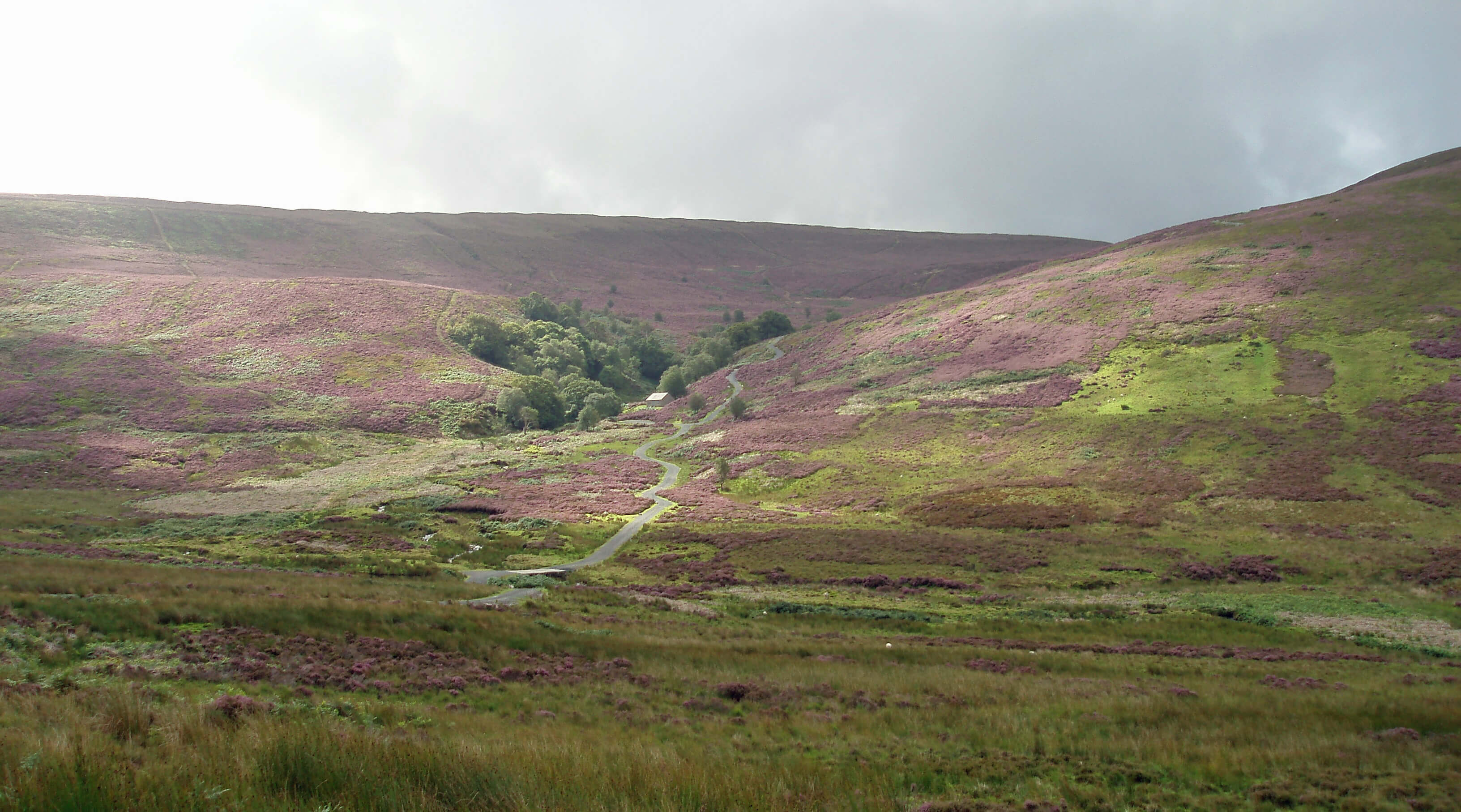 Right: Black Clough, near Abbeystead
Right: Black Clough, near Abbeystead
Most of the grouse moors of Bowland are owned by the Duke of
Westminster, the UK’s richest aristocrat. Men - and perhaps women
too - supplement his £8.5 billion by paying a thousand pounds a
day to shoot grouse on the 23,500 acre Abbeystead Estate.
What do the estates’ gamekeepers think of hen-harriers? Perhaps
the answer lies in their job-title. They are paid to keep game, not to
keep non-game, especially not non-game that, they believe, harms
game. I once mentioned to a Bowland gamekeeper that, despite
walking and running on the Bowland hills for over thirty years, I
had never seen a fox there. He replied “That’s ‘cos I kill ‘em all”.
Twenty-seven in one year, I think he said.
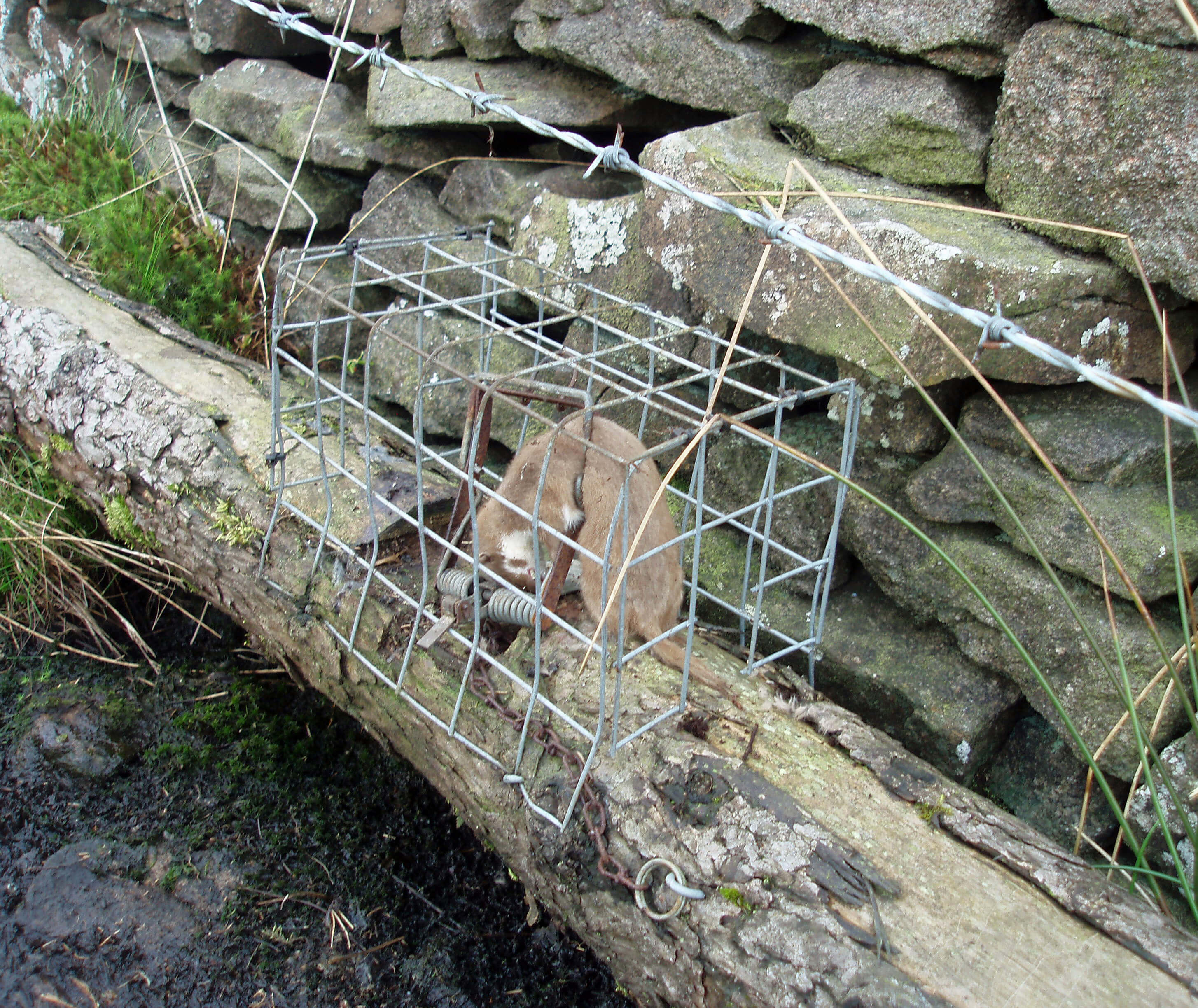 Left: Weasel trap
Left: Weasel trap
If you walk by a wall fringing a grouse moor you may come
across metal grids fixed to the tops of gates in the wall and on planks
across puddles next to the wall. Weasels don’t like to get their feet
wet, so they run along the tops of walls and gates or, if they are on
the ground, on the planks over puddles. They run into the grids
but not out of them. Members of the general public react differently
to the killing of foxes, weasels
and hen-harriers, but perhaps
some gamekeepers don’t.
There are proposals for
tougher penalties for wildlife
crimes, a regulation scheme
for grouse moors, and a
principle of vicarious liability,
whereby estate owners are
held legally responsible for
crimes committed by their
employees. These are highly
contentious. In 2007, Prince Harry and a gamekeeper were
interviewed after two hen-harriers were killed on the Sandringham
estate. Natural England, the body responsible for Special Protection
Areas such as Bowland, is a ‘non-departmental public body’ but the
Secretary of State has the legal power to ‘issue guidance’ to Natural
England. Natural England is dependent upon the government for
its funding. Would Natural England really seek to alienate owners
of large estates? The minister who ruled out vicarious liability was
a former trustee of GWCT and owner of grouse moors.
Even RSPB, an independent charity, seems to have its hands
tied. Its Sky-dancer project is funded by the Heritage Lottery Fund,
which imposes a condition that its grants must not be used for
political lobbying. Therefore, RSPB feels inhibited, or prevented,
from arguing the case for vicarious liability.
Perhaps belated hope lies in a recent study carried out at
Langholm Moor in Scotland. Here ‘diversionary feeding’, that is,
the provision of alternative food to parent hen-harriers, reduced
predation of grouse to what might be considered reasonable levels.
The Countryside Alliance, however, considers that the problem
does not lie with grouse moors. It says that “birds of prey are, on
the whole, doing incredibly well and most are at their highest levels
since records began” and that hen-harriers are “susceptible to bad
weather, disturbance, poor habitat and lack of available food”, for
none of which the managers of grouse moors can be blamed [1].
I expect that the Alliance considers the buzzard to be “doing
incredibly well”. A gamekeeper employed by another former
GWCT trustee was recently found guilty of killing ten buzzards.
A spokesman for the National Gamekeepers’ Organisation (NGO)
said: “We condemn these actions utterly. The selfish, stupid actions
of one man – who was not and never has been a member of the NGO
– must not be used to tarnish the good name of gamekeeping”.
The RSPB’s Sky-dancer project is offering a £1,000 reward for
any information that leads to a conviction, should it emerge that
one or both of our hen-harriers were illegally killed. All that is
known at the moment is that the last transmissions from the two
birds were at 7.33pm on 10 September on Summersgill Fell, west of
Thrushgill, and at 10.51am on 13 September on Mallowdale Pike.
[1].
The Observer (January 5, 2013),
Hawks in danger of extinction in illegal
hunting campaign.

21. Sitka-Spruce in Dentdale
December 2014
Recently I noticed an advertisement offering a woodland for
sale. To be precise, it offered the wood not the land. For
about £250,000, I could buy 28.8 hectares of mature forest,
provided that I promised to fell all the trees by 2017, yielding about
10,000 tonnes of timber, so that the cleared land could revert to the
owner for restocking.
I didn’t really have a need for 10,000 tonnes of timber and nor
did I have £250,000 to spare but I was intrigued by the notion that
I could temporarily adopt a forest in order to chop it down. I had
assumed that owners of forests felled their own trees for their
own profit. In this case, the owner was presumably content with
£250,000 and none of the work. The sale document didn’t actually
say who the owner is but it mentioned the Forestry Commission
and Cumbria County Council as ‘authorities’.
The Forestry Commission would need to give a licence to
whoever bought the forest before it could be felled. I doubt that
the Commission owns the forest, as it is fairly small. The Forestry
Commission was set up in 1919 as a government department to
restore wood supplies after the First World War, with a secondary
objective of sustaining rural populations. It planted fast-growing
conifers on the swathes of poor land that it bought to become
Britain’s largest land owner. After the Countryside Act of 1968 the
Commission’s focus moved towards conservation and recreation.
Today the Commission also engages in forestry research to protect
and improve the biodiversity of forests.
The woodland for sale was at Mossy Bottom at the head of
Dentdale. The majority (87%) of the forest was Sitka-spruce Picea
sitchensis that were planted in 1971-72, along with a few European-larches.
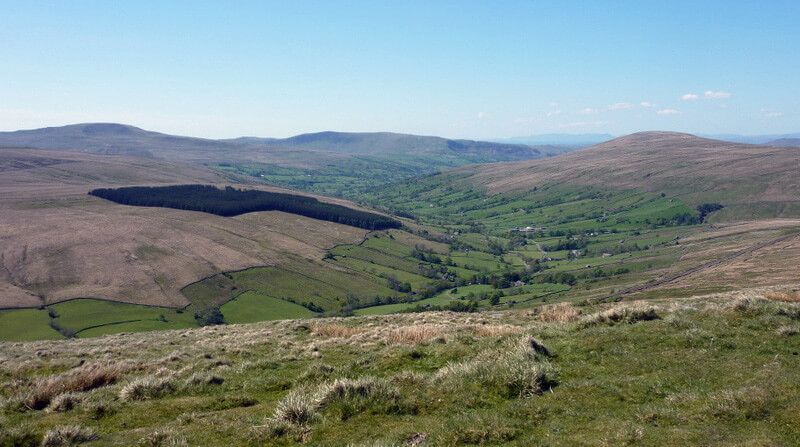 Right: Looking west along Dentdale from Great Knoutberry Hill,
with the plantation of Low Langshaw Moss on the slopes of Whernside
(John Shepherd)
Right: Looking west along Dentdale from Great Knoutberry Hill,
with the plantation of Low Langshaw Moss on the slopes of Whernside
(John Shepherd)
Sitka-spruce is probably Britain’s most numerous tree. It cannot
be said to be our most common tree, as that would suggest that it
is widespread. It isn’t. Almost all our Sitka-spruce is packed into
regimented forests on our northern and western slopes.
Sitka-spruce is native to the west coast of North America (Sitka
is a small port in Alaska) and was introduced to Britain in the
19th century. It requires plenty of moisture, which Mossy Bottom
certainly provides. It grows quickly on poor, exposed sites. It is a
tall, narrow tree that will grow close to its neighbours. It is resistant
to disease. It yields large quantities of timber. Its wood is light and
strong - ideal for making paper, boxes, musical instruments, boats,
aircraft, and so on. It seems perfect for Mossy Bottom!
Is it perfect for Dentdale? To gain an appreciation of the Mossy
Bottom Sitka-spruce I went to have a look. There are several other
conifer plantations in Loyne - for example, in Bretherdale, Garsdale
and Hindburndale - but they are usually small and inconspicuous.
However, from the surrounding hills of Dentdale or in the quiet,
green, rural valley, the conifer plantations seem prominent and
intrusive. From the Google Earth view of upper Dentdale you might
think that large areas have been redacted for security purposes.
Perhaps this subjective feeling of intrusiveness is provoked
by the fact that only in Dentdale do the public footpaths lead the
walker into the depths of the forest. Elsewhere in Loyne, as far
as I can remember, footpaths skirt the conifers, to which we can
therefore turn a blind eye, or stay far from them, so that we can
admire or ignore them from a distance.
 Left: The partially felled plantation of Hazel Bottom,
with the Settle-Carlisle railway on the slopes of Great Knoutberry Hill
Left: The partially felled plantation of Hazel Bottom,
with the Settle-Carlisle railway on the slopes of Great Knoutberry Hill
The footpath that goes through Mossy Bottom above the line of
the Settle-Carlisle railway in the Bleamoor Tunnel soon reduces the
view to one only of nearby, over-powering identical spruces, from
which one longs to escape onto the open moorland. At least, that
is how I remembered it. But as I dropped down from the top of
Blea Moor I could see that much of the forest had been felled more
recently than it had been Google Earthed.
The scene was one of some desolation. Large areas had been laid
bare, with only old stumps and scruffy piles of brash remaining. In
places, new rows of young spruce, in various stages of growth, had
been re-planted. Some patches of mature trees remained, including
some near where Mossy Bottom is marked on the map. I don’t
know if the 28.8 hectares are still for sale. There was no sign of any
forest workmen I could ask, nor indeed of any equipment for on-going work.
Enough of the forest remained for me to try to get more fully
into its spirit by walking off the footpath into its depths. I had
no fear of getting lost because the trees were in straight lines to
guide me back out. Beyond a few yards, the forest was dark and
silent. Hardly a splinter of light penetrated the dense canopy. No
undergrowth grew. There was just a springy carpet of dead, dry
needles. The lower branches of the trees seemed dead too. I doubt
that many animals live on the forest floor. I expect that there are
some birds that are at home in the upper branches but I didn’t hear
any, although admittedly December is not the best month to hear
birds.
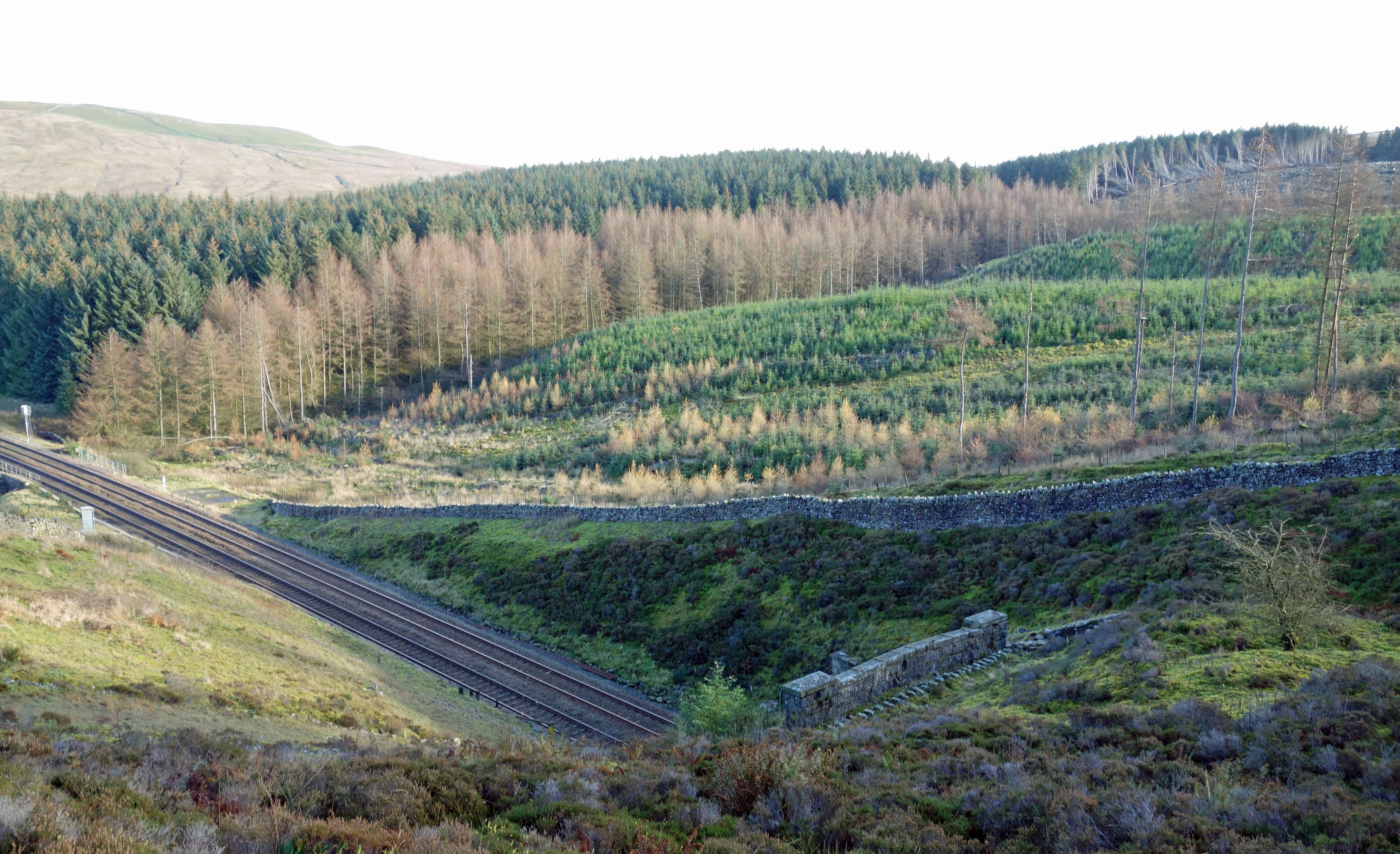
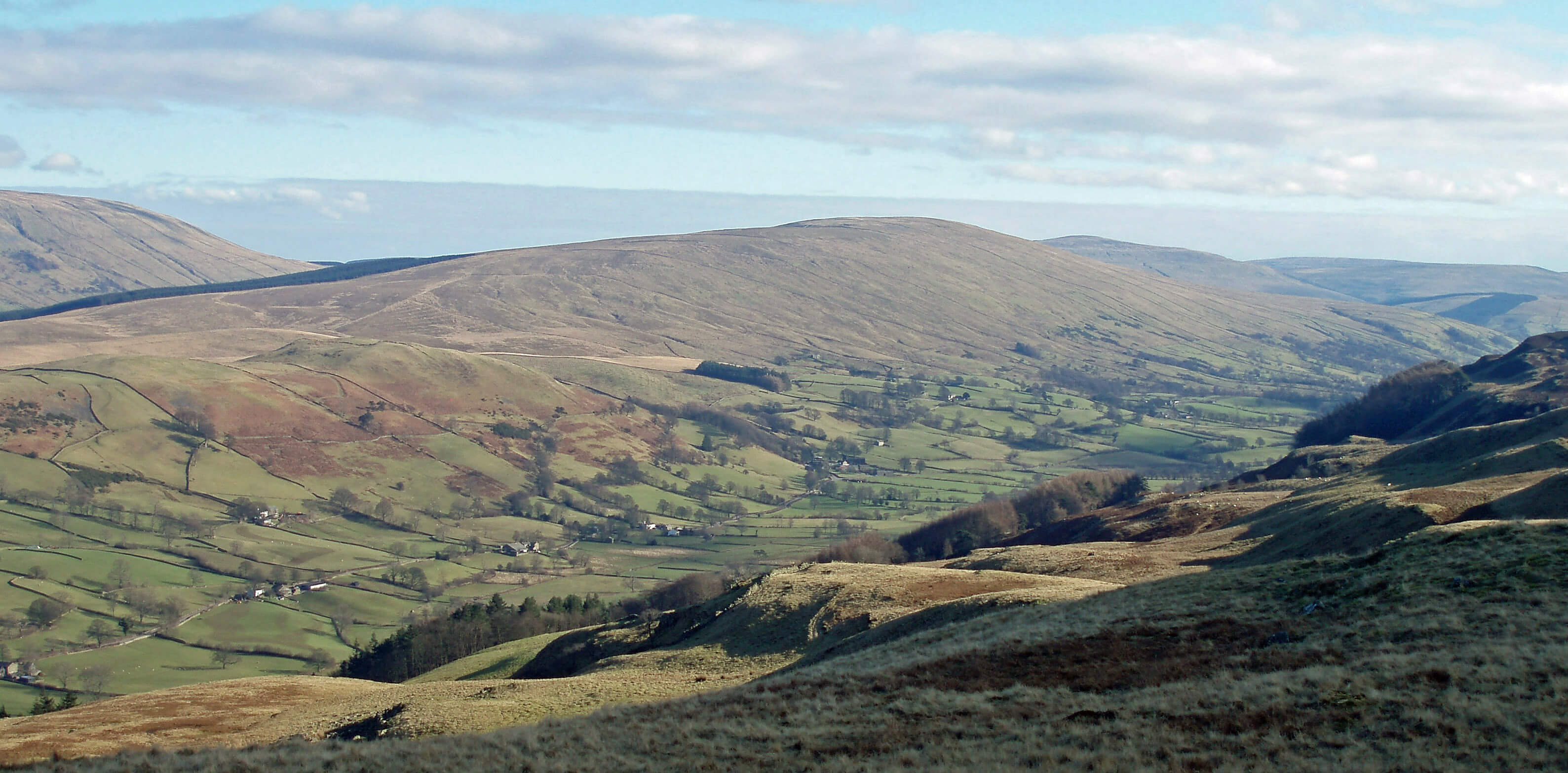 Left: The partially replanted plantation of Mossy Bottom,
with the Settle-Carlisle railway line disappearing into Bleamoor Tunnel
Left: The partially replanted plantation of Mossy Bottom,
with the Settle-Carlisle railway line disappearing into Bleamoor Tunnel
Right: Dentdale from Brown Knott
To be fair, I doubt that Mossy Bottom was replete with wildlife
before the forest was planted. Even so, it is dispiriting to see Sitka-spruce planted in serene, green Dentdale. But not so long ago
Dentdale was not as serene and green as most of it is today. The
Sportsman’s Inn below Arten Gill hints otherwise. ‘Sportsmen’
came to shoot red-grouse on the then heather-clad slopes. My
impression, incidentally, is that the grouse are returning and indeed
seem quite friendly now that they are not expecting to be shot.
Forestry policies are, of course, a matter of national controversy.
Elsewhere, for example in the Lake District, obtrusive, rigid conifer
plantations are being removed or at least softened by the planting of
deciduous trees. Newer plantations are skillfully landscaped, with
irregular shapes and mixed species, to provide a more pleasant,
varied aspect to the hillsides. However, as far as I could tell, no such
policy applies to Dentdale. Sitka-spruce seems set to continue.
Perhaps I need to take a longer term view. Our hills were
previously wooded and the removal of trees many centuries ago
led to the erosion and degradation of the exposed soil. The new
conifer forests were planted for the economic production of timber,
not to protect and regenerate the soil, although it may have that
effect, hard though it is to acknowledge this standing in the gloom of
Mossy Bottom. I must try to regard the Sitka-spruce as a temporary
crop. Eventually, when the very last spruce has been felled, perhaps
the soil will have been stabilised and reinvigorated to enable native
flora and fauna to return and flourish. One can but hope.
22. Dippers in Barbon Beck
January 2015
A midwinter, midweek walk in Barbondale is a particular
pleasure. There are no cars parked at the picnic spot near
Blindbeck Bridge. There are no cars being driven over
the Barbondale Road into Dentdale, for a jaunt. There may be the
occasional farm vehicle but otherwise all is silent, apart from the
bubbling of Barbon Beck itself.
Within the wood of the Barbon Manor estate few birds are to be
heard. A rook may caw; a pheasant may squawk; a robin may sing.
Perhaps a small flock of long-tailed-tits may twitter past. A heron
may try to fly unnoticed from the beck. The only distraction from
the peaceful solitude is the realisation, made manifest in winter,
that the wood is sadly becoming overgrown with rhododendron.
Once out of the wood, one may hear the mewing of a couple of
buzzards circling towards Castle Knott. Snow lies on the ground
and ice fringes the beck which runs strong and clear - and very cold.
There are no birds by the beck, it seems.
However, if one walks along by Barbon Beck it is likely that
a bird that is in its element will be seen - the dipper, or, in full,
the white-throated-dipper Cinclus cinclus. The dipper’s name is
doubly appropriate. The bird dips, or bobs, repeatedly as it stands
on a rock midstream. With
its white bib, its action seems
almost comically obsequious.
Also, the bird dips, or drops,
into the water from time to
time, to swim or splash about,
looking for insects. These two
characteristics, distinctive for
British birds, make the dipper
easy to identify.
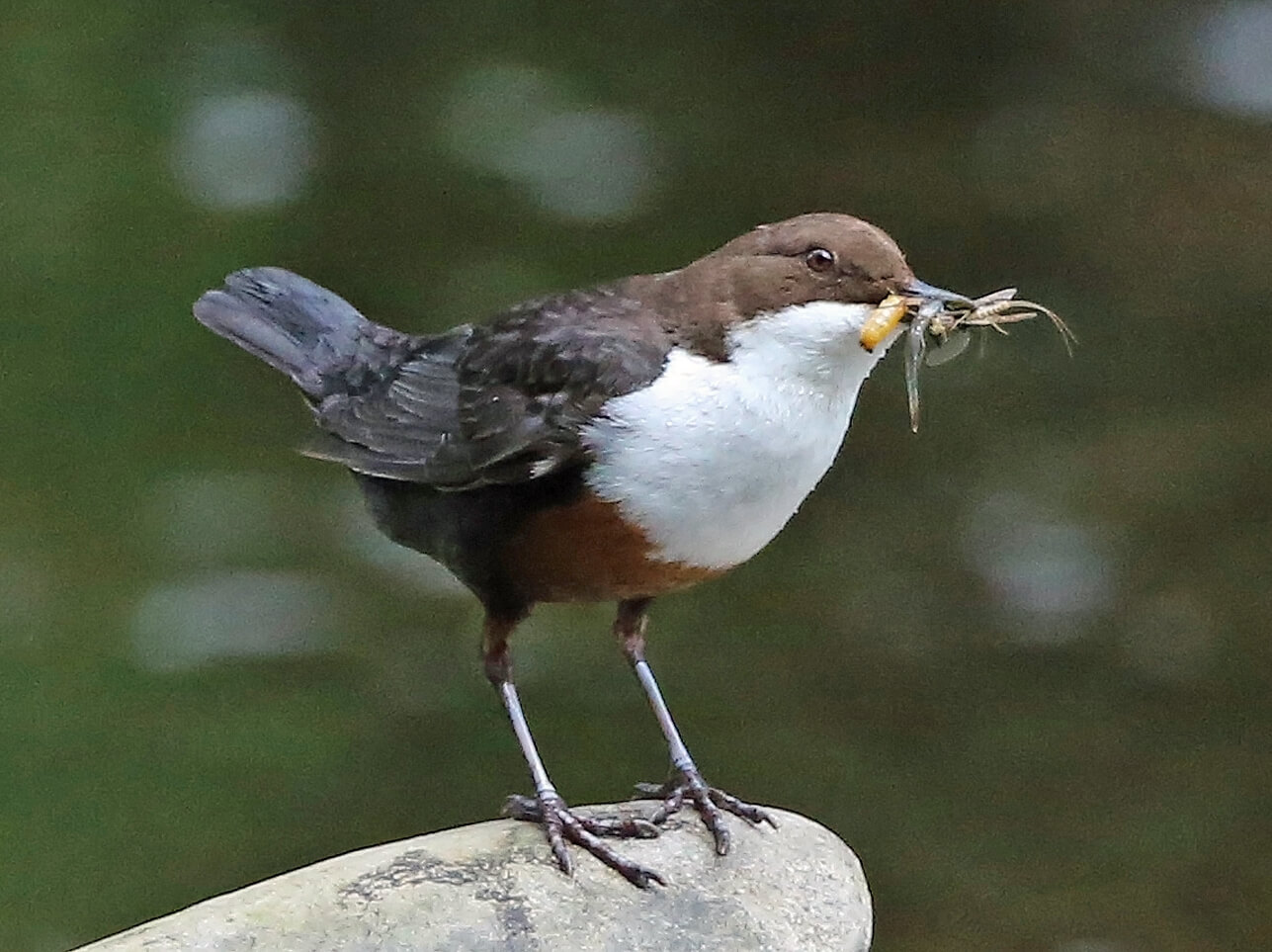 Right: Dipper (Margaret Holland)
Right: Dipper (Margaret Holland)
An obvious question is:
Why does a dipper bob in
such a fashion? To satisfy us
any answer would need to explain how the action gives the dipper
some evolutionary advantage. Dippers don’t reflect on the matter:
they just breed, eat, and try not to be eaten. The bobbing must, I
suppose, help one or more of those activities.
So suggested answers are: it is a breeding display or a means
of communication (but dippers bob throughout the year, although
more energetically at breeding times, and it is usually a solitary
bird, with no fellow dippers to communicate with); it provides
different viewing angles into the flowing water and thus enables
prey to be better seen (but, in my observation, dippers don’t seem
to be looking into the water when they bob - and why would it
need to be such a precise, regular bob?); it helps to camouflage the
dipper against the turbulent beck (but for my eyes, but perhaps not
its predators’, it, on the contrary, draws attention to the bird).
None of those answers satisfy me, so I’ll suggest some more.
Maybe it’s a way of helping the leg muscles, tired from gripping
rocks in fast-flowing water, avoid cramp. (Do animals other than
us get cramp? They surely must.) Perhaps the dipper is keeping
alert, to escape any would-be predator. Perhaps it is nervous about
diving into the cold water, like a diver on a high springboard.
Perhaps it’s just a ritual, like Rafael Nadal’s serving rigmarole. I
think dipper-philosophers should ponder this profound problem
more deeply, so that we may sleep better at night.
The dipper is an aquatic bird but it is not adapted to the water
like waterfowl, with, for example, webbed feet. It has its own
adaptations, appropriate to its niche, fast mountain streams:
• Its wings are short and strong, enabling them to serve as
flippers underwater.
• Strong claws can grip rocks in swift water.
• Thick down keeps the dipper insulated.
• A very large preen gland waterproofs the feathers.
• A third eye-lid helps to see under water and to clear the eyes
after diving.
• A nostril flap closes when the dipper is under water.
• Its eyes have strong focus muscles to help underwater vision.
• Its blood has high haemoglobin concentrations so that it can
store more oxygen.
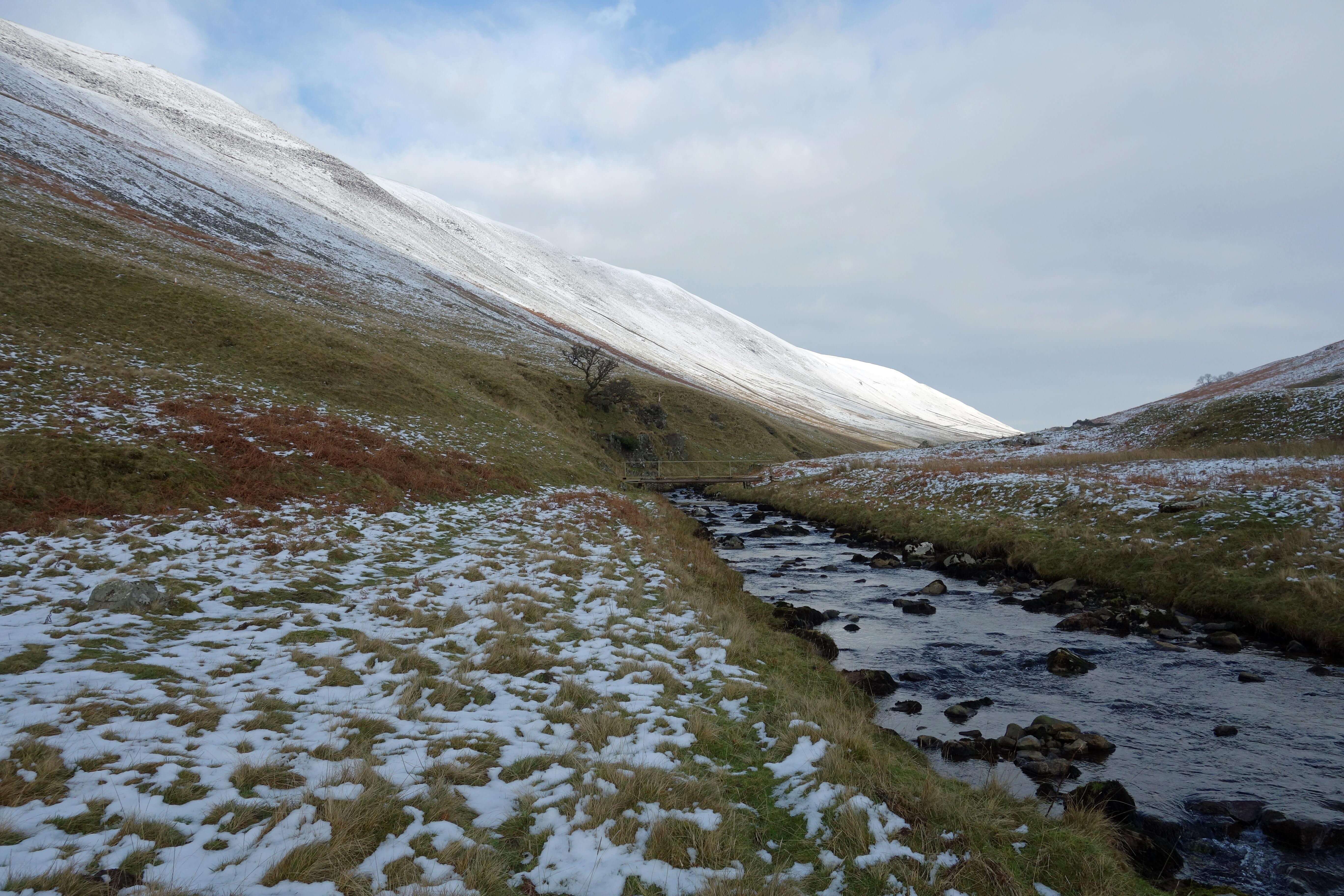
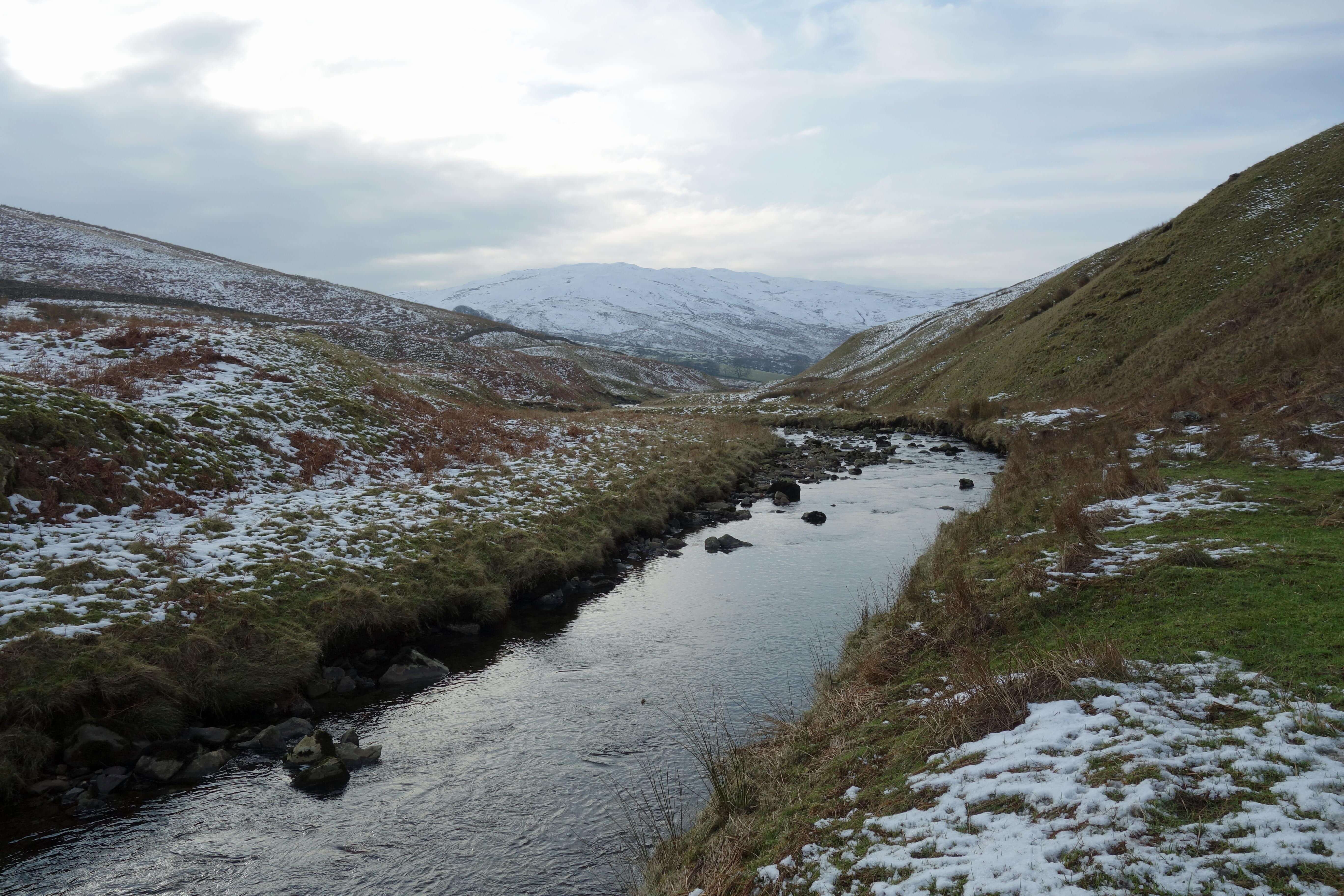 Right: Barbon Beck, looking north (left) and looking south (right)
Right: Barbon Beck, looking north (left) and looking south (right)
Clearly, with all these adaptations, the dipper is a special bird,
well suited to our mountain becks. It is worth pausing by Barbon
Beck to study the dipper with binoculars. Of course, not all the
adaptations can be seen but at least we can appreciate the dipper’s
capabilities. It can be alarming to see it suddenly drop, apparently
recklessly or by accident, into rapids, disappearing for several
seconds - only to pop up, implausibly, some distance upstream.
Meanwhile, the dipper takes little notice of us studying it. If,
however, we begin to approach, it will fly ahead of us to stand and
bob on another rock twenty metres away. It will continue to fly
ahead for some time until it decides that it has had enough of this
game, and will fly back past us, with a fast whirring of its wings
and a peep or two of disapproval. It is a distinctive, sharp little call.
I usually hear dippers in our beck (mentioned in Chapter 16) before
I see them sweeping past. It always flies not far above the water,
following the path of the beck, eschewing any short-cuts.
The Barbon Beck dippers are in fact flying back because they
have reached the end of their territory. A dipper patrols its stretch
and will not intrude upon its neighbour. Between Blindbeck Bridge
and Short Gill Bridge two or three dippers are likely to be seen.
Although dippers are described as birds of the mountain becks, I
often see them on the more placid lower reaches of the Lune. I don’t
know if these birds spend all their time on the Lune, or whether the
Lune marks the end of its territory along some nearby tributary.
Dippers are the earliest of our birds to nest, starting in February.
I saw no sign of the Barbon Beck dippers preparing to breed, which
I am relieved about. I wouldn’t want to disturb this crucial activity.
There are few beck-side shrubs to provide cover for dipper nests,
which are made mainly of moss and built into crevices on banks or
under bridges.
The length of a dipper’s territory is determined by the availability
of nesting sites (which, although I’m no dipper, I’d judge to be low
along Barbon Beck) and, of course, food. Dippers feed solely on
aquatic life. They eat caddis-fly larvae, nymphs, and occasionally
small fish. (Dippers used to be killed because they were believed
to harm precious fish stocks.) They forage among the stones on the
beck’s bed, clinging to rocks and swimming with their wings.
As is obvious at Barbon Beck, dippers do not, unlike many
songbirds, forsake us when winter comes. This alone deserves to
endear the dipper to us. They stay within their territory, which
means that it must provide adequate sustenance throughout the
year, for the dipper pair and for their brood of four or five young
(or more if there’s a second brood).
The dipper is completely dependent on clean, clear, fast-flowing water, with adequate food and safe nest-sites. Pollution
and turbidity, caused by erosion, and any damming or channelling
that alters water flow is liable to cause problems for the dipper. A
sight of a dipper on a beck is therefore a time to rejoice. It is a sign
that the beck is healthy. Barbon Beck and indeed most of Loyne’s
becks are, I’m pleased to say, healthy enough to support dipper
populations. Nationwide, too, populations appear to be stable and
thus the dipper is in the minority, being on the Green list of British
birds, enabling me, for a change, to end on a positive note.
23. Alpacas in Rawtheydale
March 2015
Drivers leaving Sedbergh on the A683 and crossing Straight
Bridge may be distracted by strange animals browsing in
the fields. These are alpacas. If they are not in the roadside
fields, they may be seen by walking on the footpath to Hebblethwaite
Hall, passing through the farm of Ghyllas, which has built up a
herd of about a hundred alpacas since 2000, part of a
'Why Not Alpacas' campaign.
The alpaca Vicugna pacos is a species of camelid. In other words,
it is of the Camelidae family, which, as you’d expect, also includes
camels. Camelidae is the only extant family within the suborder
Tylopoda, which means ‘swollen foot’. It is the broad cutaneous
foot pad that distinguishes the camelids from the other even-toed
ungulates within the Artiodactyla order, which also includes pigs,
deer and giraffe.
Camelids are herbivorous but they are not ruminants, that is they
do not acquire nutrients by fermenting plants in a special stomach
prior to digestion. Their
stomachs have three chambers,
not four; their teeth differ from
ruminants’; their upper lips
are split in two; and their back legs
have a different musculature,
causing a different action when
lying down.
There are seven species of
camelid, including four from
South America: alpaca, llama,
vicuña and guanaco, the first
two being domesticated forms
of the last two. The four species
can interbreed to produce
fertile offspring. For example, a
male llama and a female alpaca
produce a haurizo.
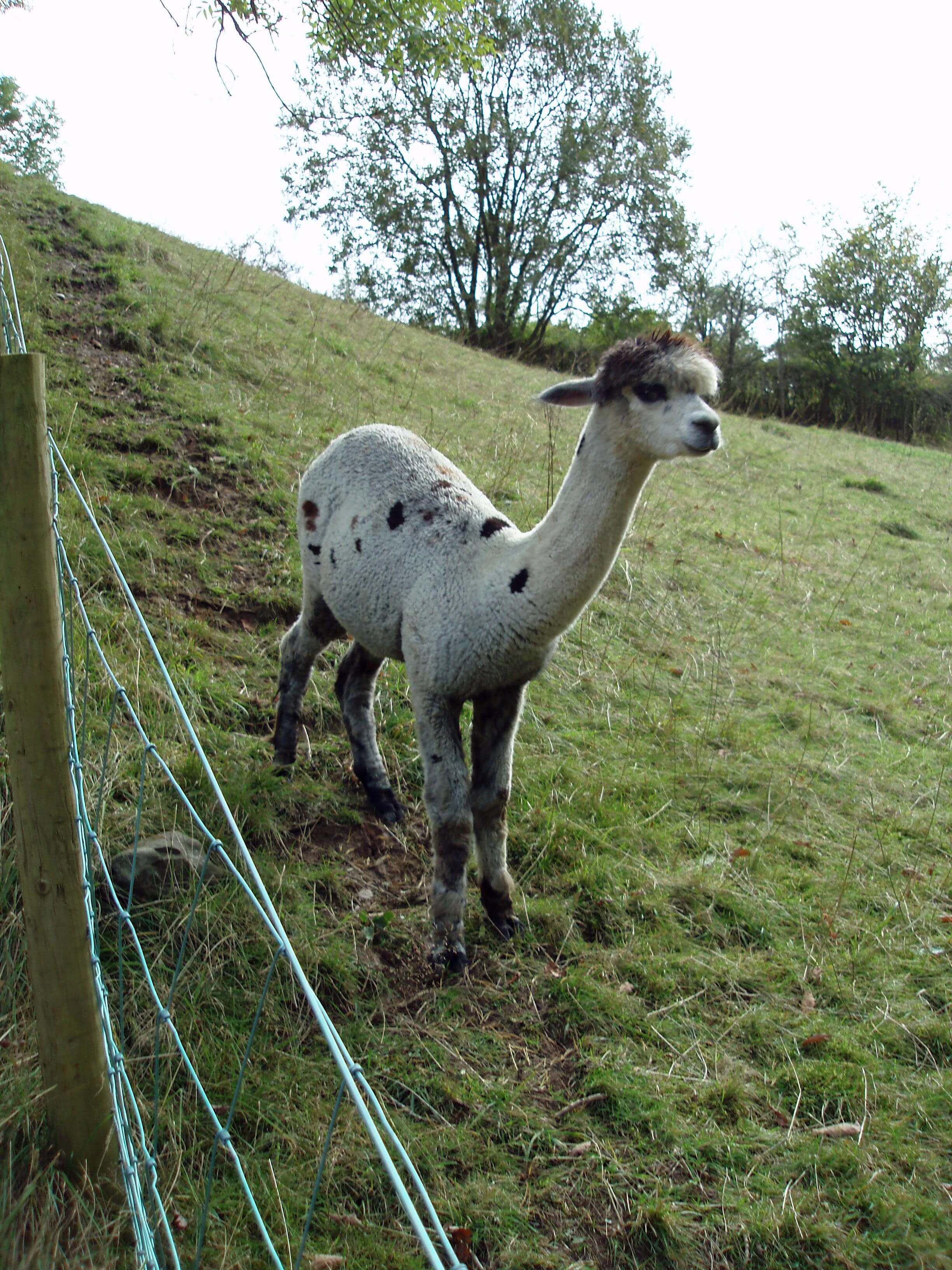 Left: Alpaca
Left: Alpaca
Whoa. What makes a set of organisms a ‘species’? The 4 species
of South American camelid could produce (by my arithmetic) 12
hybrids. As the 4 species can interbreed, I would expect the hybrids,
which are presumably intermediate, to be able to do so as well.
From the 4 species and 12 hybrids, we could have 252 hybrids, and
in the next generation 65,532 hybrids, and so on.
Why are the original four groups considered to be species but
none of the hybrids? I have stumbled into a problem so fundamental
that it has its own name: ‘the species problem’. It seems that there is
no universally accepted definition of ‘species’, despite the fact that
it is the basic unit of the biological classification system.
Scientists like to name, list and classify things. That was what
Carl Linnaeus had in mind when he came up with his scheme in
the 1740s. At that time the types of organism were considered
to be God-given, fixed and permanent. They could therefore be
categorised like, say, chemical elements or types of rock.
However, Darwin’s The Origin of Species of 1859 showed that the
enterprise was inherently flawed, because organisms change, albeit
rather slowly on a human timescale. The classification scheme was
no longer to be considered a description of a static system. Instead,
the focus was on how organisms evolved and how new species
emerged.
We may perceive that some animals are similar and we might
consider them a species (say, hippo). We can see that they differ
from another set of animals (say, zebra). We may then come across
a smaller animal that looks rather like a hippo. Is it the same species,
or different (a pygmy-hippo)? In the distant past, there have been
other hippo-like animals. Were they hippo? Today, it is not so easy
to see any difference between an alpaca and a vicuña. Since the
former is a domesticated latter, why are they considered different
species?
To avoid just relying on someone’s opinion, a definition of
‘species’ would be welcome. Ernst Mayr’s ‘biological species
concept’ of 1942 tried to provide one: “a species consists of
populations of organisms that can reproduce with one another and
that are reproductively isolated from other such populations”. The
emphasis here is upon reproduction rather than appearance.
This definition has its difficulties. For a start, it does not apply
to asexual organisms, such as bacteria and most fungi. Some
organisms that cannot interbreed, such as some breeds of dog, are
nevertheless considered to be of the same species. Some organisms
that can interbreed, such as lions and tigers (and indeed our four
camelids), are nevertheless regarded as different species.
What does the ‘can’ in ‘can reproduce’ mean? Does that allow
an ‘in principle’ reproductive capability that, in practice, may not be
realised for some reason? How does one demonstrate in principle
reproduction? And how ‘isolated’ do the populations have to be?
Our Lawkland and Silverdale small-pearls (Chapter 15), separated by
a few miles of farmland, are considered to be of the same species,
but perhaps they might not be if they were separated by an ocean.
Why is the clause about isolation necessary? Isn’t the species of
an organism determined by what it is, not where it is? The camels
in the Australian outback aren’t considered a new species through
being separated from the Middle East camels. That may be because
we know how the outback camels got there: they are descended
from camels imported to work in the Australian deserts. But if
the camels stay in the outback for long enough they may evolve to
differ from Middle East camels. Would they become a new species
because of these differences or because they are in Australia?
The biological species concept is also unsatisfactory because
it is of limited practical use. It cannot be easily applied to most
organisms - that is, the ones that are no longer with us. It is difficult
to contemplate in principle reproduction between proposed species
that lived millennia apart. This is unfortunate, as the species status
of now extinct organisms is a crucial part of evolutionary theory.
Even for living organisms it is not clear how you show species-hood. Imagine that you find a spider that you’d like to claim to be of
a new species. How do you show that it is incapable of in principle
reproduction with any known spider species (all 40,000 of them,
plus all extinct species)? Or is the onus of proof on those who might
deny that it is a new species? There is an understandable tendency
for naturalist-explorers to identify a specimen as a new species
because then they may have the honour of naming it, perhaps after
themselves, for everlasting fame.
There have been a score or more of other definitions of ‘species’.
None of them is accepted by all but I assume that one or more have
enabled experts to pronounce that we have four species of South
American camelid.
Nowadays it is hoped that gene analysis will provide a rigorous
basis for a precise definition. Unfortunately, genetic differences
between organisms do not always correlate well with the species
differences that we have emphasised up to now. Sometimes genetic
analysis reveals differences that we were previously unaware of. For
example, the giraffe species has at least eleven genetically distinct
populations. Perhaps, eventually, a genetically-based definition
will be imposed upon the word ‘species’ - but if so it will not fully
correspond to our understanding of the word ‘species’ today.
It seems that we must accept that the edifice of evolution is built
upon the shifting sand of an imprecise definition of species. This
is not just a philosophical discussion and a cause only of academic
angst. It enables creationists to attack the foundations of the theory
of evolution. And how can I campaign about ‘species conservation’
and ‘endangered species’ when somebody might demand that I
define what a species is?
I am, to my chagrin, little the wiser as to why it has been decreed
that there are four species of South American camelid. I decided to
go and ask the alpacas.
They all looked at me inquisitively, eyes wide, head erect on
their long neck, ears up. They looked cherubic - but also gormless.
Not a single one approached to tell me, straight from the alpaca’s
mouth, why they are a species.
 Right: Some of the inquisitive Ghyllas alpacas
Right: Some of the inquisitive Ghyllas alpacas
However, I also met the owner of the Ghyllas alpacas, and we
had an interesting, if inconclusive, discussion about the nature of
species. He told me about a local man who once had a zonkey - a
hybrid of zebra and donkey. Darwin, in fact, was quite intrigued
by the various zebra-horse hybrids and wrote a fair bit about them.
However, none of them, including the zonkey, is a species, because
they are sterile. We also considered the multitude of breeds of dogs
(all one species) and wondered why some hybrids, or mongrels, are
more valued than the pure breeds. We concluded that it is not a
matter for science alone.
He was somewhat puzzled by the fact that the two groups of
camelids (the South American and the Middle Eastern) are so far
apart. It does seem strange today but, of course, in the distant
past there were other camelids, now extinct, at intermediate points
between them. No doubt, given sufficient time, camelids could have
migrated over the vast land masses and have evolved differently
along the way. Maybe the land masses themselves have moved to
separate the two groups.
I learned that there are
two kinds of alpaca at Ghyllas
(although I couldn’t tell the
difference): huacaya-alpaca and
suri-alpaca. I say ‘kind’ because
I don’t know what the proper
word is. Some experts seem to
consider these different species;
others different breeds. I find it
disconcerting that experts cannot
decide these matters for me.
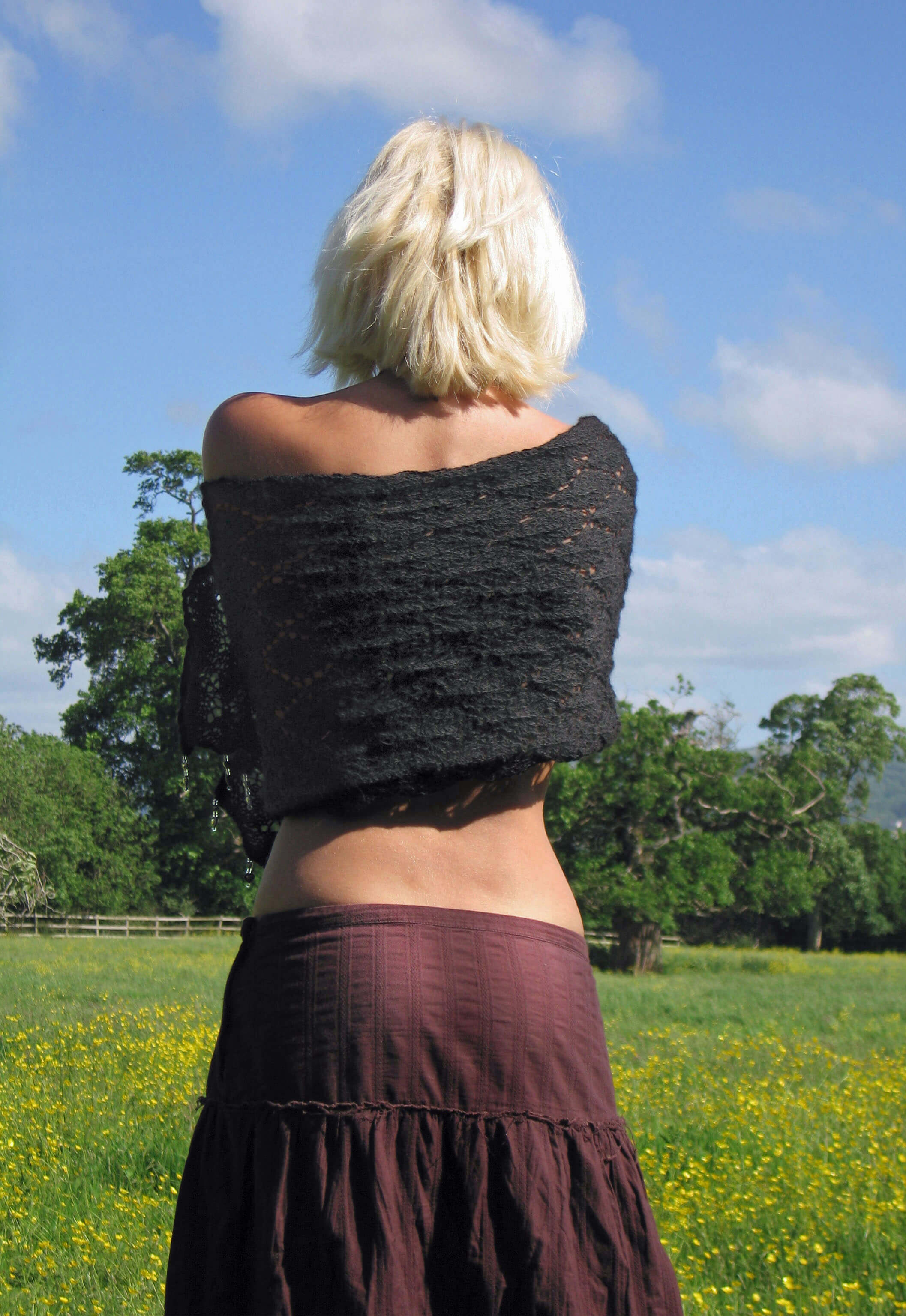 Right: Alpaca shawl
Right: Alpaca shawl
I knew that the Ghyllas
alpacas are bred for their fibre,
to be made into blankets, rugs,
cardigans, shawls and so on, and
I could tell that each individual
alpaca was a beloved member of
the family. Nevertheless, I had
the temerity to ask about alpaca
meat. It is, apparently, a tender, succulent meat, long considered
a delicacy in South America. Here, of course, it is a rarity, or non-existent, on our menus.
The owner said that his alpacas are a domesticated form of
the guanaco, one of the two wild South American camelid. I was
vaguely uncertain about this, but I didn’t have my notes with me,
and he knows much more about alpacas than I will ever need to.
But, now that I am home, I read that until 2001 the alpaca, then
called Lama pacos, was indeed considered to be descended from the
guanaco. However, DNA analysis showed it to be descended from
the vicuña, and it was renamed Vicugna pacos [1]. (The details of this
DNA analysis are incomprehensible to me but I have included the
paper’s web address below in case you’d like to discuss the matter
with Ghyllas.)
This shows that I ought to regard species classifications as
provisional - and also that alpaca farmers have more important
things to worry about than the philosophy of speciation. In
particular, they must keep alpacas fed during the winter, when, of
course, the grass doesn’t grow. He was busy (until interrupted)
unloading many bales of hay.
Alpacas live at 4000m in the Andes, so they have no difficulty
in coping with the rigours of a Rawtheydale winter. However,
they are not well adapted to survive severe conditions alone. In
2013 about 250,000 alpacas in Peru died when their farmers were
caught unprepared by a sudden blast of snow and ice. The Ghyllas
alpacas do though find our winters somewhat gloomy compared to
the Andes and therefore need vitamin supplements. I know how
they feel.
[1]. M. Kadwell et al (2001). “Genetic analysis reveals the wild ancestors
of the llama and the alpaca”. Proceedings of the Royal Society B:
Biological Sciences 268 (1485): 2575–2584, at
http://www.ncbi.nlm.nih.gov/pmc/articles/PMC1088918/
24. Hares at Winmarleigh Moss
April 2015
Nobody visits the Winmarleigh Moss SSSI without great
determination and a good reason. I had both. Winmarleigh
Moss lies - and I mean lies - about three miles east of
Pilling in the middle of the flat expanse of the Fylde. It can only
be reached by walking for some time to get to Crawley’s Dyke and
then following the dyke to cross diagonally over the Moss.
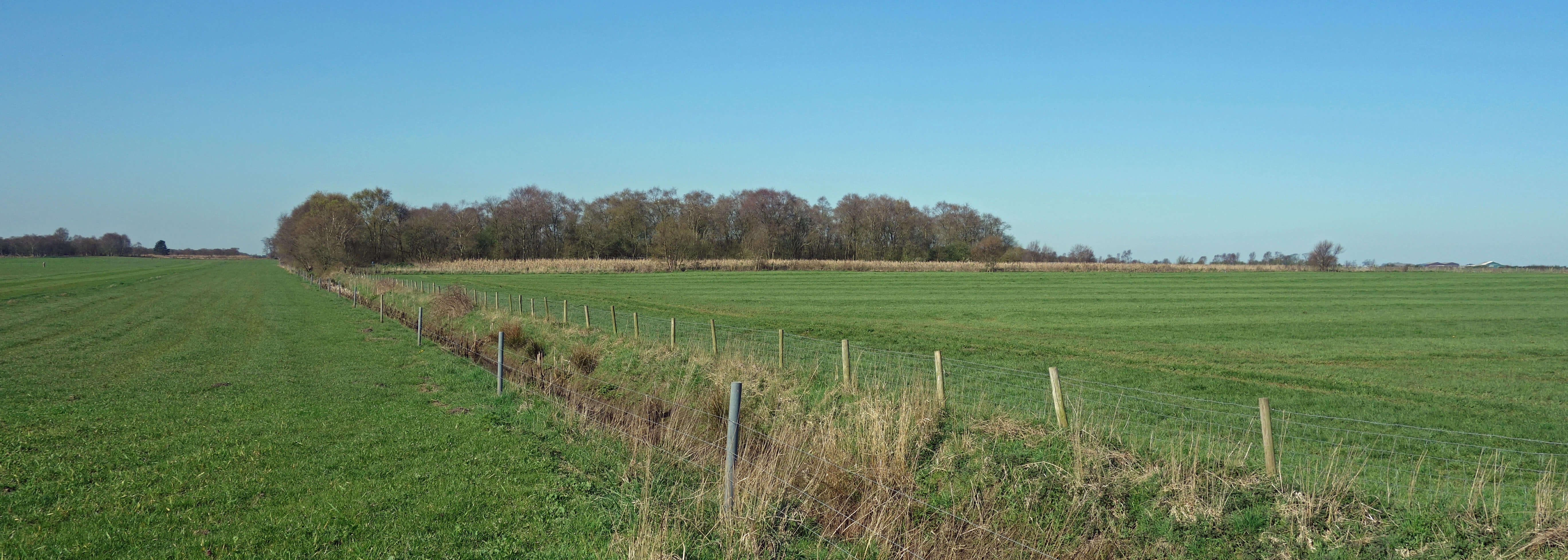 Right: Approaching Winmarleigh Moss by Crawley’s Dyke
Right: Approaching Winmarleigh Moss by Crawley’s Dyke
The SSSI is all less than 10m above sea level but even so it is
a metre or so above the surrounding fields. Those fields have all
been drained to provide rich farmland. Winmarleigh Moss is a
remnant of the vast bog of Pilling Moss that was here until a couple
of centuries ago. The SSSI is not large, only 90 hectares or so, but it
is the largest area of lowland raised bog remaining in Lancashire.
A few millennia ago the region was covered with trees. Once
the trees had been chopped down it gradually became a bog. Today
the process is in reverse: trees are re-growing and the bog is drying
out. The reason that I went to Winmarleigh Moss was to see what
was being done about this.
This presumes that something should be done about it. Why
don’t we just let nature take its course? Well, it is too late for that.
We have already prevented nature taking its course, by chopping
down trees and draining fields. We have so mutilated the natural
environment everywhere that we no longer know what ‘natural’
is. We tend to assume that what we have recently destroyed was
natural - and therefore we feel an obligation to restore it.
Pilling Moss was never scenically attractive. Restoring the
bog of Winmarleigh Moss will not bring tourists flocking. It will
not bring any economic benefit either, unlike the surrounding
farmland. The main reason for preventing the bog disappearing is
that it provides a distinctive ecological niche that several rare plants
and insects depend upon.
The Lancashire Wildlife Trust, which owns most of Winmarleigh
Moss, proposed to tackle the problem in four ways. First, all the
trees and scrubs, except some on the periphery, would be removed.
Long ago the bog was inadvertently created by removing trees;
now the bog was to be deliberately re-created by removing trees.
The ditches on the eastern half of the Moss would be filled in, to
prevent water draining away. Then, bunds, that is, low mounds of
peat, would be built on the western edges, to hold water in. Finally,
overflow pipes would be used to manage water levels in different
areas of the Moss. Thus, it was hoped, the Moss would be re-wetted
in a controllable fashion, without harming nearby farmland.
The proposal I had seen had the work scheduled for September
2014 to March 2015. So I walked to the Moss to see how they had
got on. I also hoped to see some of the wildlife for which the Moss is
known - not the plants and insects, as it was the wrong time of year
for most of them, but specifically the brown-hare Lepus europaeus
which is fairly common in the region. Nationally, however, the
number of hares in Britain has dropped by 80% in the last century.
We may attribute this drop to disease or increased predation by
foxes but the likelihood is that, as usual, we are to blame.
The hare is the only British game species that does not have a
close season. Britain and Ireland are the only European countries
not to ban the shooting of hares in the breeding season. This means
that it is not illegal - when it surely should be - to kill a mother hare,
thereby causing its young to die of starvation (the father hare takes
no interest in its young). The leverets are accustomed to being left
alone in their ‘forms’ for all but a few minutes every day, but if the
mother does not return at all then they will, of course, die. It is
thought that 40% of our hares are shot every year.
In 2013 the government rejected an attempt to introduce a hare
close season, considering it unnecessary. Perhaps it thinks that the
venerable Hare Preservation Act of 1892 is sufficient. This made it
illegal to have hare on the menu between March and July. As hares
are not really agricultural pests, the only reason to shoot them is
for ‘fun’. At least, hare-coursing (where hares are run down by
dogs) has been banned since the Hunting Act of 2004, although its
supporters say that the aim of ‘the noblest of field sports’ is not to
kill hares but to provide competition between dogs. Those hares
that die are unfortunate: the rest, being merely severely stressed,
are lucky.
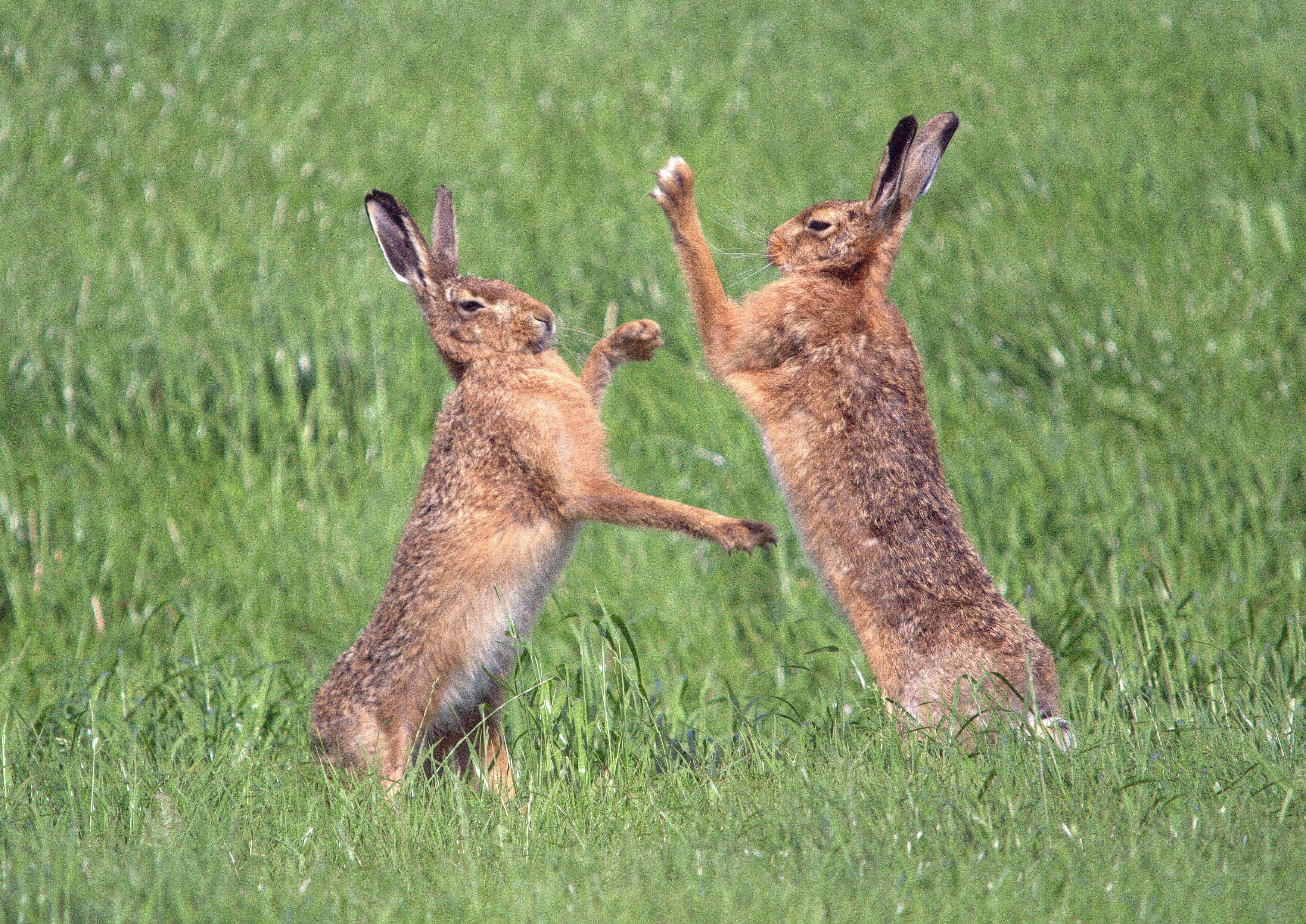 Left: Brown-hares (Alex Eames)
Left: Brown-hares (Alex Eames)
The hare has probably suffered less from direct persecution than
it has indirectly from changes to farming practice. Hares do not
hibernate or migrate and therefore need a food supply, of a variety
of grass and herb species, throughout the year. This was naturally
available before agriculture and even after it, until recently, with
traditional hay meadows and crop rotation. Nearly all such
meadows have now been lost, replaced by grassland, usually of a
single species, for silage production. The hare has fared particularly
badly in western regions that are predominantly dairy farming.
Moreover, the hare’s decreased food supply tends to be badly
timed. More autumn sown crops are now planted, causing a food
shortage when the energy needs are highest, that is, during the
breeding season. The removal of hedgerows and the increase in
stock densities deprives hares of places to ‘lie up’ during the day
and to safely leave leverets. Many leverets are killed by silage
machinery as they wait for their mothers to return at dusk.
If this all seems rather depressing then, according to the
Hare Preservation Trust,
“after the long winter months there can be
few sights more uplifting to the human spirit than the spring-time
boxing antics of these delightful creatures”.
That may be so, until
one learns that this is not, as used to be assumed by analogy with
many other species, male hares being macho before mating. It is
usually females trying to deter over-amorous males: that is, violence
to ward off sexual assault. Ah well.
Although the hare is considered to be a lowland animal I
regularly see hares on the Bowland fells, for example, on my nearest
hill of Caton Moor. Once I watched for some time four hares
running around the moor. They ran in great loops, up, down and
around the moor, for no obvious purpose. They simply seemed to
be enjoying themselves. Occasionally, they would come across one
another on their loops and would engage in a brief encounter but it
was more like passing high-fives than a serious boxing match.
Approaching Winmarleigh Moss from the east, it seemed that
the planned work had not begun, or it had finished if it had (there
was no sign of ongoing work). The birch trees still stood and the
Moss looked like a parched island surrounded by green fields. At
closer quarters, however, a new bund at the eastern end was found
to be holding water back, and trees and shrubs by the Crawley’s
Dyke footpath had been cleared, with a raised ridge creating peaty
pools to the south. Overall, though, most of the Moss seemed
unchanged.

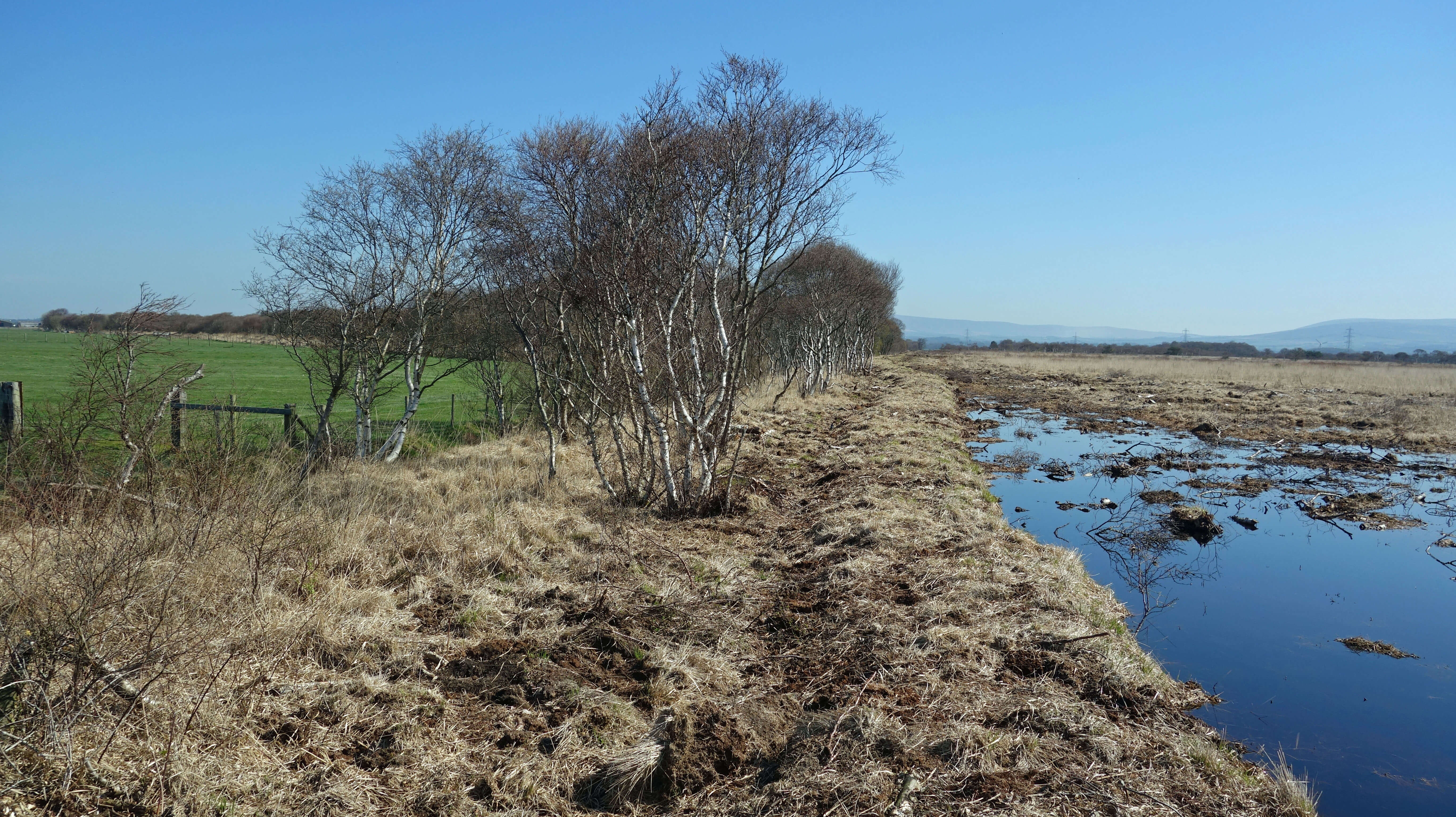 Left: Work on the eastern bund of Winmarleigh Moss.
Left: Work on the eastern bund of Winmarleigh Moss.
Right: The footpath by Crawley’s Dyke, showing the contrast between the green
farm fields and the dry Winmarleigh Moss, with new pools.
Standing on this dry island, perched a metre above the
surrounding luxuriant farmland that has sunk through drainage
and peat extraction, it is easy to see the difficulty of converting the
region back into wet moss. At the moment, it is a strange unnatural
mixture of peaty pools and dry vegetation. Still, a start has been
made, and it is appreciated by the snipe, at least. I came across
a group of seven, which diminished as the snipe left one-by-one,
each with a disapproving ‘snip’ call. On the walk I saw my first
swallow, wheatear and orange-tip-butterfly of the year and also, to
my surprise, in this exposed region, a roe-deer.
It was silent apart from the contented chittering of many birds
- until I became aware of the low hum of the motorway, five miles
away. Try as I might, I cannot escape humanity. Having been
brought back to reality, I noticed a tractor spraying a nearby field
with who-knows-what and then another tractor levelling the soil
of a recently de-grassed field. Nearby, the Bay Flying Club airfield
and the Moss Side Racing Stables have replaced our rare lowland
raised bog.
On this occasion I saw only one hare and this was not on
Winmarleigh Moss itself. At least, having seen only one, I was
spared the fisticuffs. I expect that the dry grass and heather and
the peaty pools of the Moss are not to its liking. I doubt that the
surrounding green fields are ideal habitat either. If the hare needs a
variety of grasses then it won’t find it here. The large, flat, open fields
of sheep-cropped grass, surrounded by fences, hawthorn hedges
and sometimes wide ditches, provide little cover and protection
for the hare and their young. They must lead a life of perpetual
furtive trepidation. They will never experience the exuberance of
the Caton Moor hares.
25. Lesser-Black-Backed-Gulls by Wolfhole Crag
May 2015
The River Roeburn rises deep within the Forest of Bowland
between Mallowdale Fell and Greenbank Fell below the
knobbly peaks of Wolfhole Crag. This is a wild moorland
area crossed by the rough track of Hornby Road (the Old Salt Road)
that attracts only the occasional cyclist, horse-rider or walker. One
of whom was me, some years ago, when I attempted to walk upon
the Wolfhole Crag ridge. I was surprised to find my anticipated
peace and solitude ruined by the cacophony of a huge colony of
nesting gulls.
This colony, I subsequently read, was of the lesser-black-backed-gull
Larus fuscus, one of eleven species of gull to be seen
in Britain (up till then I had not really bothered to distinguish one
gull from another). They may be ‘lesser’ to an ornithologist, at least
with respect to the great-black-backed gull Larus marinus, but they
are still of some size, with a wingspan of 60cm or so. It was an
unnerving experience to confront thousands of them determined to
prevent an invasion of their territory.
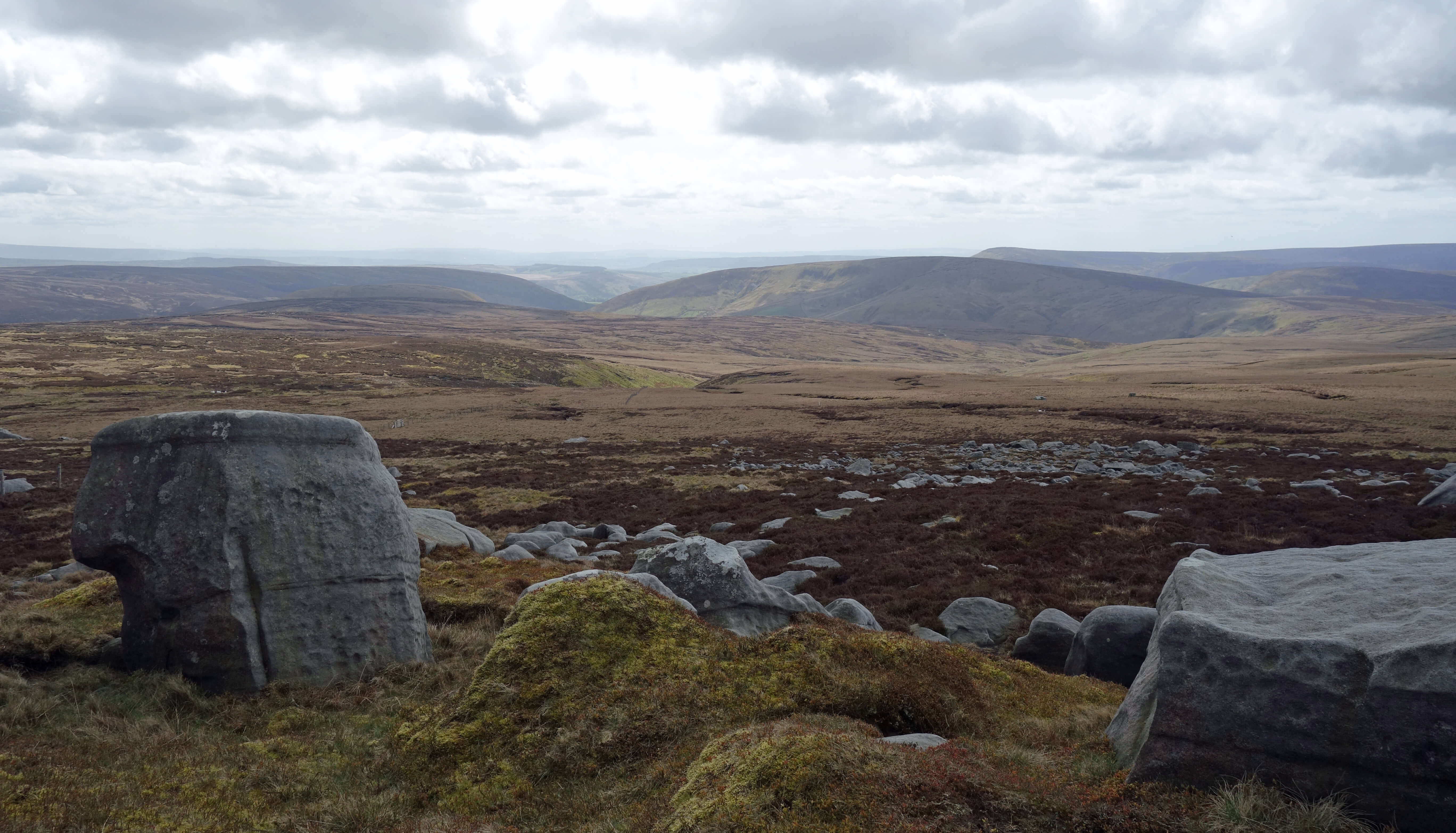 Left: Brennand Fell from Wolfhole Crag
Left: Brennand Fell from Wolfhole Crag
The majority of the gulls were nesting on Brennand Fell, in a
large, sheltered, secluded bowl south of Wolfhole Crag. The lesser-black-backed-gull is
said to have begun to breed in the Forest of
Bowland in 1938. By 1959 there were 1,000 pairs. According to a
2005 book, the colony continued to grow “to become the largest
known lesser black-backed colony in the world” and in 1979 “the
colony held 25,500 pairs and it continues to thrive” [1].
I recently re-walked the region and I was not surprised to find
that the colony is no longer thriving. I had read about it in the national press [2].
.
It had become a matter of public interest because
the history of the gulls’ colonisation of the Bowland Fells illustrates
some of the difficulties of conservation policies.
Gulls are few people’s favourite bird. To most of us gulls are
familiar as scavengers of seaside chips. They are noisy, aggressive
birds, and there are, it seems, too many of them. The lesser-black-backed-gull,
in particular, has grown rapidly in urban areas, where
it is considered a pest.
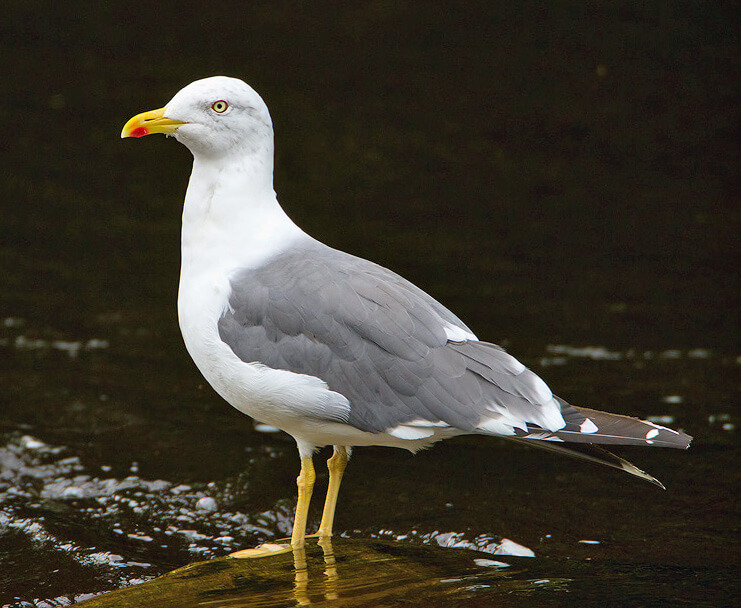 Right: Lesser-black-backed-gull (Kevin Agar)
Right: Lesser-black-backed-gull (Kevin Agar)
However, looked at dispassionately, gulls are bona fide members
of the avian world and
the lesser-black-backed-gull is quite a handsome
specimen. It is, in fact,
not so numerous. A little
over 100,000 pairs breed
in the UK. So, at its peak,
the Bowland colony held
about a quarter of all UK
lesser-black-backed-gulls.
The UK is home to 40% of
the European population
but most of those birds are
found at fewer than ten
sites. For these reasons, the
lesser-black-backed-gull is
on the Amber List.
Now that we have established that we should be concerned about
the lesser-black-backed-gull, we can ask: Why has the Bowland
colony fallen from 25,500 pairs in 1979 to about 2,000 pairs now?
That is a fall of over 90% in just 35 years. If a colony of, say, avocets
had fallen 90% there would be a campaign to find out why.
In general, the lesser-black-backed-gull increased in numbers
throughout its European range in the 20th century [3].
These increases
are thought to be due to increased food availability from fish
discards and landfill sites. Since 2000 the population has declined a
little, probably because of a reversal of the reasons for the previous
increase. These fluctuations, however, do not approach the 90%
drop found in Bowland and therefore its explanation would seem
to be specific to Bowland.
One thing that has changed in Bowland since 1979 is that the
region has been made ‘open access’ land. We are all now free to
wander at will to disturb the nesting gulls. I do not visit Brennand
Fell often enough to know whether this is a factor. I doubt it
because very few walkers would be sufficiently determined to visit
this remote emptiness and if a walker were to come accidentally
upon the colony they would, I’m sure, soon retreat, as I did.
I am not aware of any changes to the local flora and fauna that
could explain the decline. Like most gulls, the lesser-black-backed-gull
will eat almost anything - mice, eggs, young birds, worms,
chips, and so on. Whatever they need must have been in sufficient
supply to support 25,500 pairs and their young.
Apart from the noise, another thing that I recall from my first
visit to the colony is the smell. Fifty thousand birds and their
young, all within a fairly small area, create a large concentration
of excrement. All of this gets washed down through the drinking
water extraction equipment on the River Dunsop.
I can, therefore, well understand that there was concern that
all these gulls might pollute the water supply and that in the 1970s
a licence was granted to enable the culling of some of the gulls. A
2011 Natural England report says that “an estimated 50,000 were
killed and tens of thousands of clutches destroyed at the Bowland
Fells colony in 1978-82, reducing the colony from 25,000 to less than
10,000 pairs” [4].
It also says that “there is no information available
on the numbers or distribution of lesser-black-backed-gulls killed
in England in 2010 because there is no reporting requirement under
the relevant general licences”.
I don’t know the details of the licence that was granted; I don’t
know why there is no reporting requirement for lesser-black-backed-gulls
when there appears to be for great-black-backed gulls;
I don’t know how many gulls might be considered safe as far as
water pollution is concerned. I do know that the culling continued
after 1982 with the licence being renewed several times.
In 2001 the lesser-black-backed-gull’s conservation status
changed to endangered and the Bowland Fells were declared a
Special Protection Area (SPA). However, the official SPA citation
document was never updated to reflect the fact that the gull was
now legally protected. This ‘oversight’ meant that the culling could
continue - and it did. It may not be immediately obvious why anyone
would continue to kill thousands of birds annually (by poisoning,
cannon-netting, gas gun, shooting and the use of stupefying drugs),
at some expense and with no element of ‘sport’, when the original
justification, to protect the water supply, no longer held.
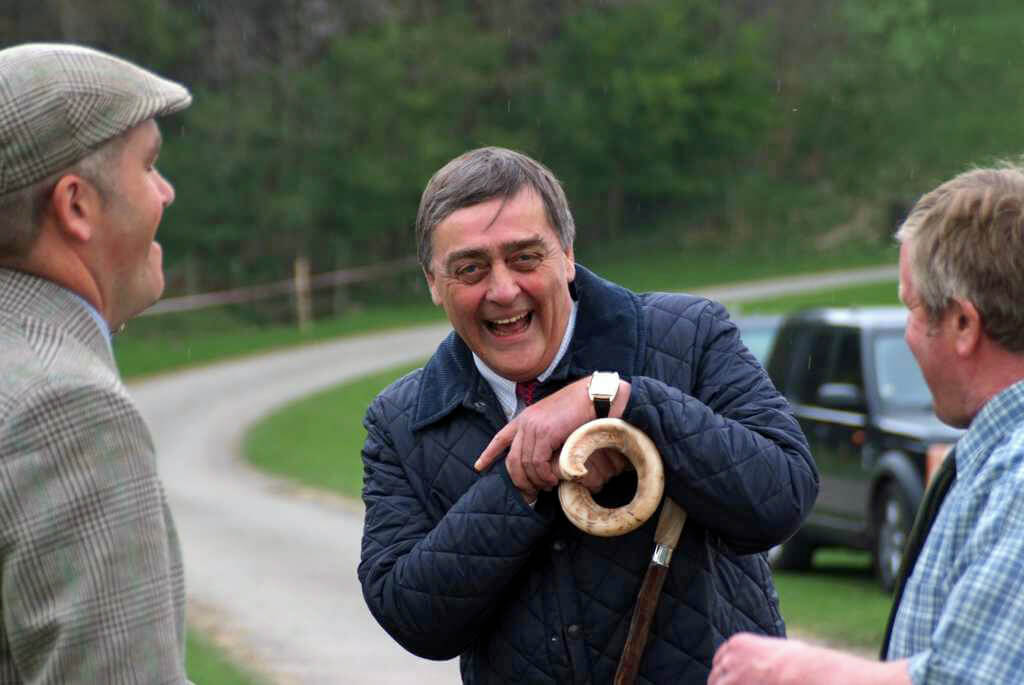 Right: Duke of Westminster (Chris Holmes)
Right: Duke of Westminster (Chris Holmes)
The licence to cull the gulls
was granted to the Grosvenor
Estate (Abbeystead), owned
by the Duke of Westminster.
The lesser-black-backed-gulls
occupied moorland that could
otherwise be used by grouse.
Moreover, the gulls eat grouse
eggs and young. For years the
Abbeystead Estate continued
to kill gulls within what should
have been a Special Protection
Area, with the acquiescence
or ignorance of the government body, Natural England, that was
responsible for overseeing such areas. Obviously, this killing was
to improve the supply of grouse for grouse-shooters.
In 2011 the culling licence expired and was (at last) not renewed.
Nevertheless, a Natural England survey reported “significant
and widespread culling and disturbance measures across the
Abbeystead-Tarnbrook Fell colony in 2012”. It seems that the 2012
culling was illegal, but nobody was prosecuted.
Natural England said (in 2013) in response to concerns about
the gull colony that it seeks “the cessation of the current regime
of disturbance and culling at Bowland Fells ... Working through
agreement remains Natural England’s preferred approach ... we
pursue any modifications to existing consents on a voluntary
basis with the aim of achieving a negotiated position with owner
occupiers. Natural England’s policy is to use enforcement as a last
resort as, in most circumstances, it is a much lengthier and more
costly process and can be subject to appeal” [2].
The tone of their comment indicated that they wanted the
culling to stop. Of course, Natural England would prefer to follow
the path of ‘agreement’, ‘voluntary basis’, ‘negotiated position’, and
so on rather than ‘enforcement’. Would they follow it quite so far if
they would not otherwise have to confront one of England’s richest
land-owners and the powerful grouse-shooting fraternity?
However, Natural England’s strategy seems to be a wise one
because their report of June 2013 said that “this year no culling or
disturbance has taken place on Brennand Fell and Whitendale Fell
(west) adjacent and accordingly the number of nesting gulls has
risen ... Lesser black backed gull nests with eggs in the Abbeystead/Tarnbrook
colony doubled to 2,140 in 2013 (1,046 in 2012) following
voluntary cessation of culling during 2013” [5].
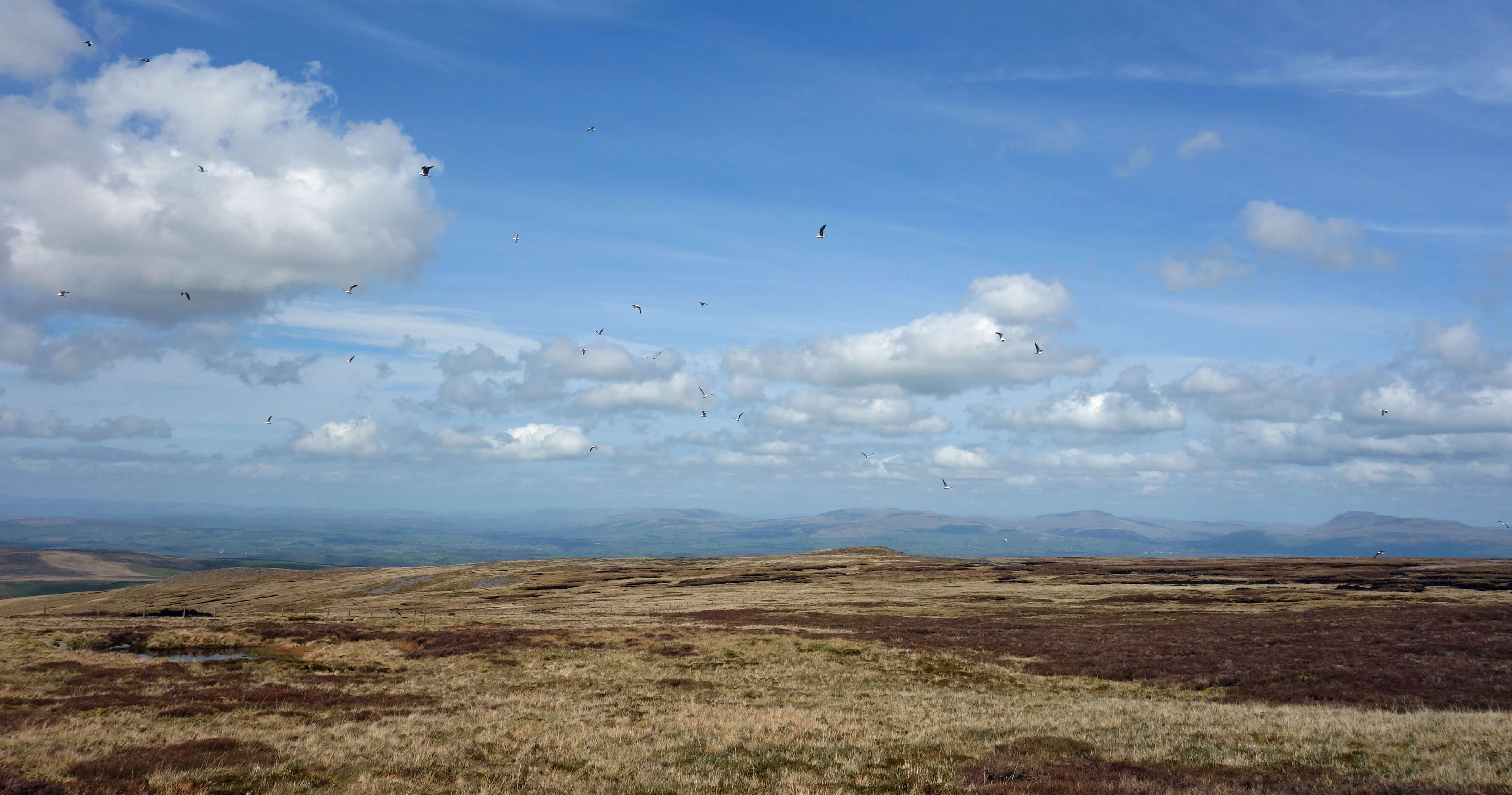 Left: Gulls at High Stephen’s Head, with Whernside and Ingleborough beyond
Left: Gulls at High Stephen’s Head, with Whernside and Ingleborough beyond
Natural England has over 4,000 SSSIs and other protected areas
to monitor. It cannot possibly inspect every one every year. But it
seems to have surveyed Abbeystead in 2012, 2013 and 2014. This in
itself is a comment on its lack of trust that the lapse of consent for
culling would be obeyed. So, the prestigious estate of Abbeystead
needs continued monitoring in order to protect the lesser-black-backed-gull
colony from the grouse-shooting industry.
At all events, a May walk in the Wolfhole Crag region is now a
different experience. The only sound is still that of gulls, redolent
of the seaside and, at first, anomalous on a moorland, but it is no
longer an agitated, aggressive discord. They kaw as they glide on
the breeze and chatter beside their nests. There are far fewer of
them, and they seem contented, perhaps because they have ample
space to spread their wings and perhaps because they are no longer
in fear of extermination. They seem to have distributed themselves
more evenly across the vast moor. For example, I came across a
hundred or so above High Stephen’s Head, where I have not noticed
gulls before. It is sensible of the gulls to nest outside the drinking
water catchment because that makes it hard to find an excuse for
killing them. Perhaps the grouse moors will become gull moors.
[1]. Andy Brown and Phil Grice (2005), Birds in England, Poyser: England.
[2]. Guardian report.
[3]. Defra report.
[4]. Natural England report (2011), The potential impacts of licensed control of
large gulls in England on conservation status and Special Protection Areas.
[5]. At the time of writing Googling “SSSI 1018211” - the reference number
for this Bowland Fells SSSI unit - yields the information given above
but this is liable to be replaced by reports of later inspections.
26. Red-Deer in Wasdale
May 2015
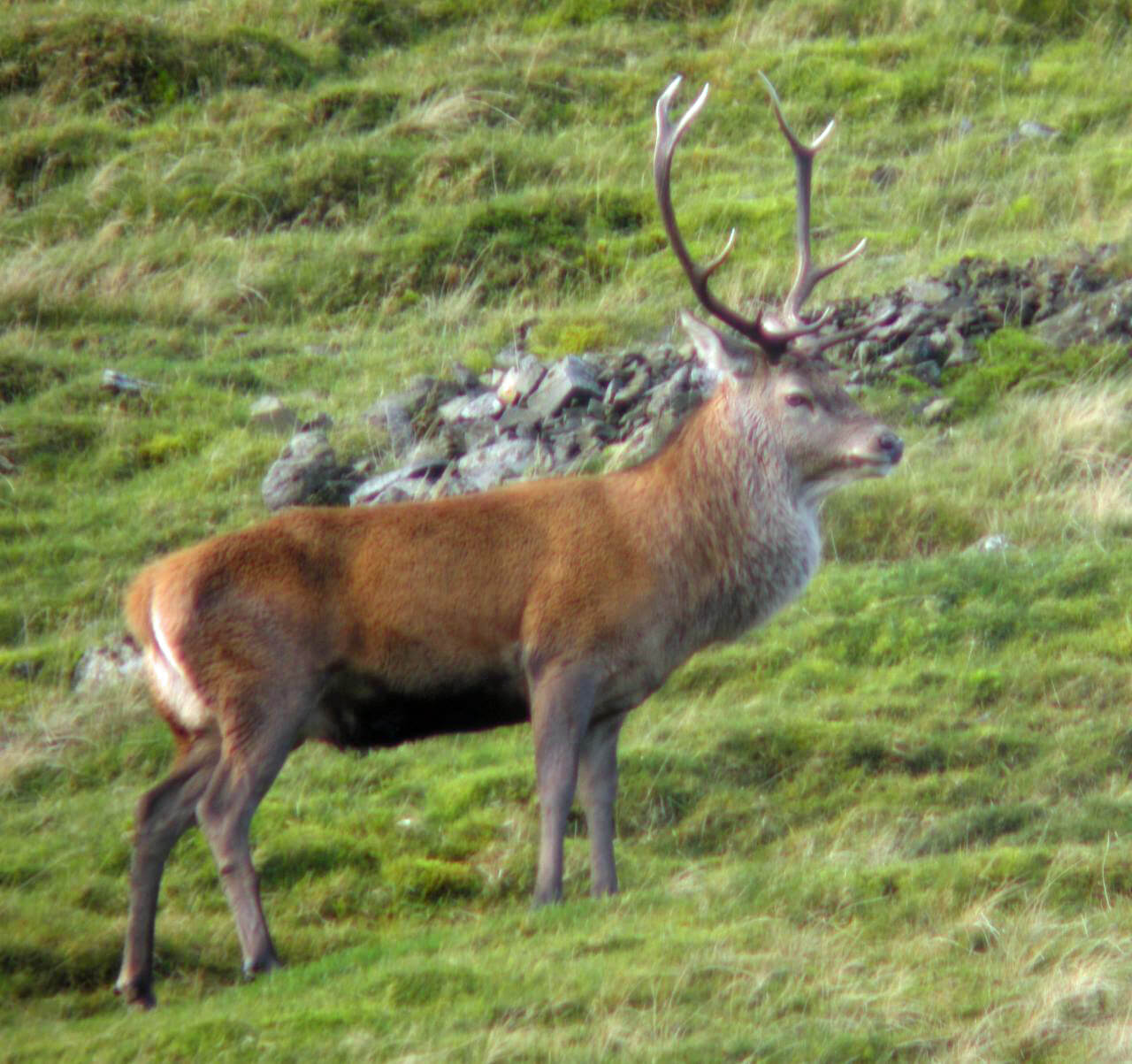 Right: Red-deer stag (Matt Carr)
Right: Red-deer stag (Matt Carr)
There is only one place to
go in Loyne if you want to
set off with a reasonable
expectation of seeing red-deer Cervus elaphus. That is
Wasdale. I don’t mean the
famous Wasdale in the western
Lake District, where we can
all take fine photographs of
Great Gable and Scafell across
the deep lake of Wastwater, a
view recently voted the very
best in England. I mean the
virtually unknown Wasdale
in the eastern Lake District,
where nobody has ever taken a fine photograph. Implausible as
it may seem, this Wasdale belongs to Loyne because the waters of
Wasdale Beck, which set off northeast, eventually swing east and
then south to become Birk Beck and to join the Lune near Tebay.
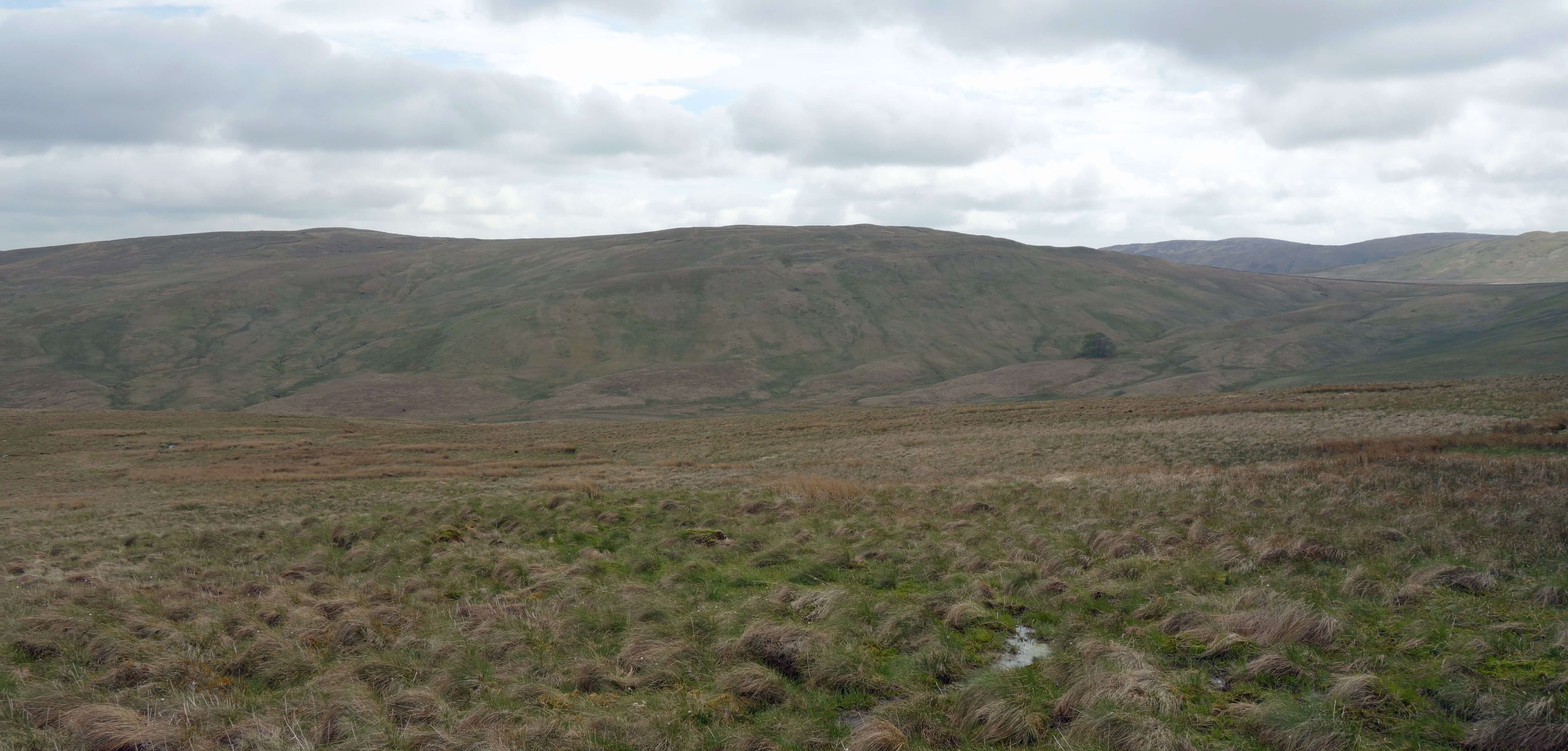 Left: Wasdale
Left: Wasdale
I have visited the Wasdale region four times in the last three
decades. On three of those occasions I saw red-deer. On one of
those occasions I saw a solitary human. I deduce, on the basis of
this modest data set, that you are more likely to see red-deer than
people in Wasdale.
If four visits seems rather scanty experience upon which to form
such a generalisation, I apologise, but if you’ve been to Wasdale once
then you’ll know that going four times shows a real commitment
to seek out every nook and cranny of the Loyne region. There are
no nooks and few crannies in Wasdale. There’s nothing that would
appeal to the serious Lake District walker. If you were to ask one
of them if they have walked in our Wasdale, then it would be very
likely that they have never heard of it, let alone walked in it.
Lake District walkers expect to walk upon rough, craggy
mountains, with steep cliffs and deep gills within which sparkling
becks run down to serene tarns and lakes. The Shap Fells of the
eastern Lake District, however, have smooth, grassy ridges, with
very few rocky outcrops and many peat bogs within which water
seeps reluctantly eastwards. There are no lakes, unless you count
the reservoir of Wet Sleddale.
There is desolation but it’s not without appeal, if you like
solitude. There is, for example, a good path by the wall over
Whatshaw Common, Little Yarlside and Great Yarlside to the
large, delicate cairn of Harrop Pike, where there is a grand view,
not so much to the west (to the Lake District) but to the east (to the
Pennines and Howgills).
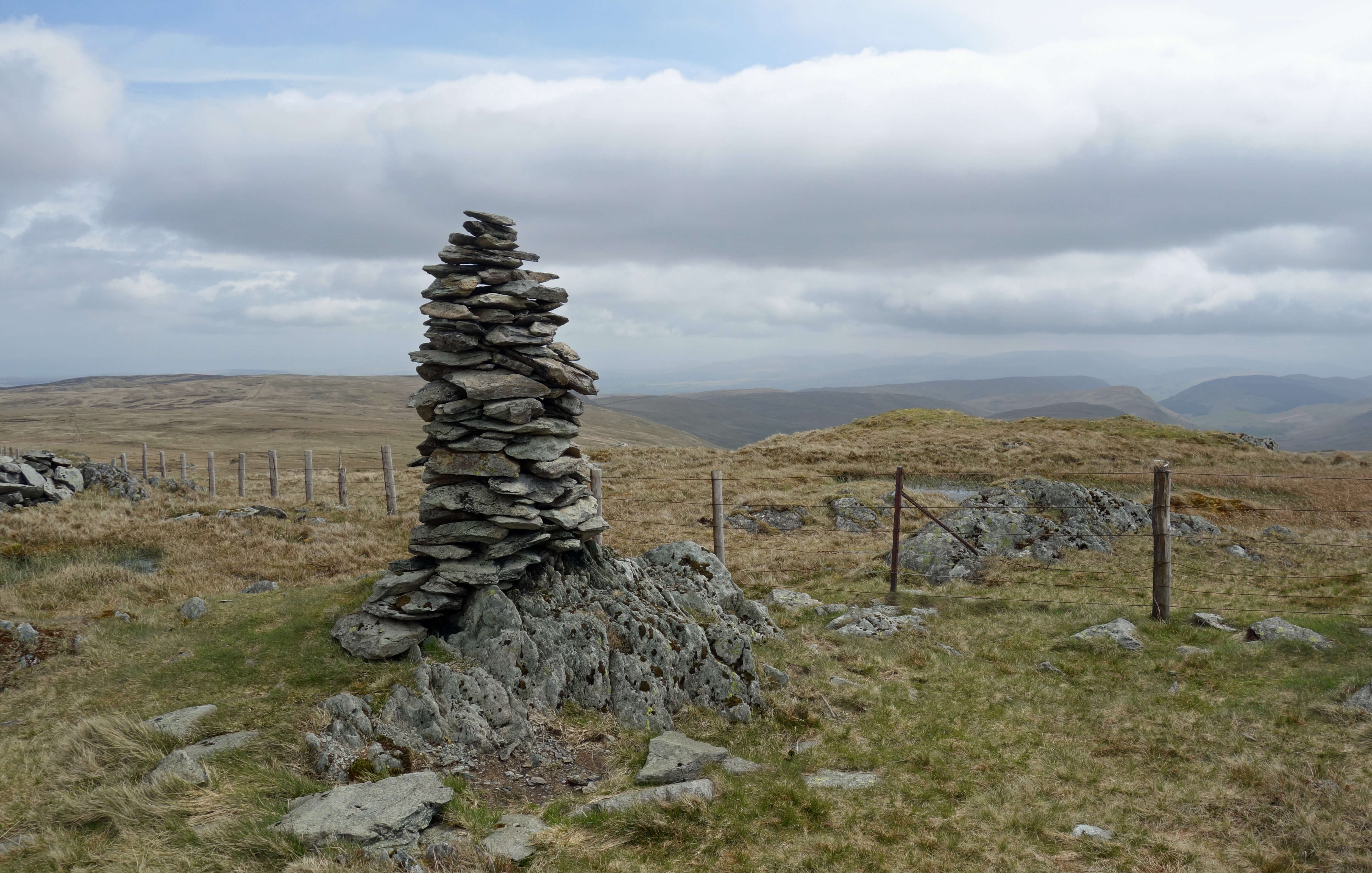 Right: The Harrop Pike cairn
Right: The Harrop Pike cairn
The Shap Fell ridges are separated by the valleys of, from the
north, Wet Sleddale, Wasdale, Crookdale, upper Borrowdale and
Bannisdale. The middle three belong to Loyne, with Crookdale and
upper Borrowdale flowing through the picturesque valley of lower
Borrowdale to join the Lune at Borrowbridge. Visitors are rare in
all these Shap Fell valleys apart from Wet Sleddale, where film
enthusiasts make a pilgrimage to Uncle Monty’s cottage of Withnail
and I.
The absence of people is, of course, one of the reasons that
red-deer may be seen around Wasdale. These deer are part of the
herds of the eastern Lake District, based at the Martindale Estate
but free to wander at will, undisturbed, around these empty hills.
They are thought to be England’s only deer to be descendants of
local wild animals. The red-deer found now in the New Forest, in
Norfolk, in Wales and on Exmoor are probably descendants of deer
reintroduced or escaped from captivity.
The red-deer is Britain’s largest land mammal. Stags are
considerably taller (shoulder height about 120 cm) and much
heavier (about 200 kg) than the roe-deer stags (about 70 cm and
25 kg) that are more familiar in our region. Red-deer hinds are
slightly less tall and about half as heavy as the stags. Red-deer
moved into Britain after the last Ice Age and provided food, skin
and tools for Mesolithic people. As the trees were cleared, the deer,
originally animals of woodland, adapted to the open moors. Their
numbers declined although some red-deer were protected within
hunting forests, which had few trees. The increase in woodland in
the 20th century led to an expansion in the range and number of
red-deer. Red-deer no longer have any natural predators and their
populations therefore need careful management for a sustainable
balance within the environment. They do, of course, have some
commercial value, for hunting and for their venison.
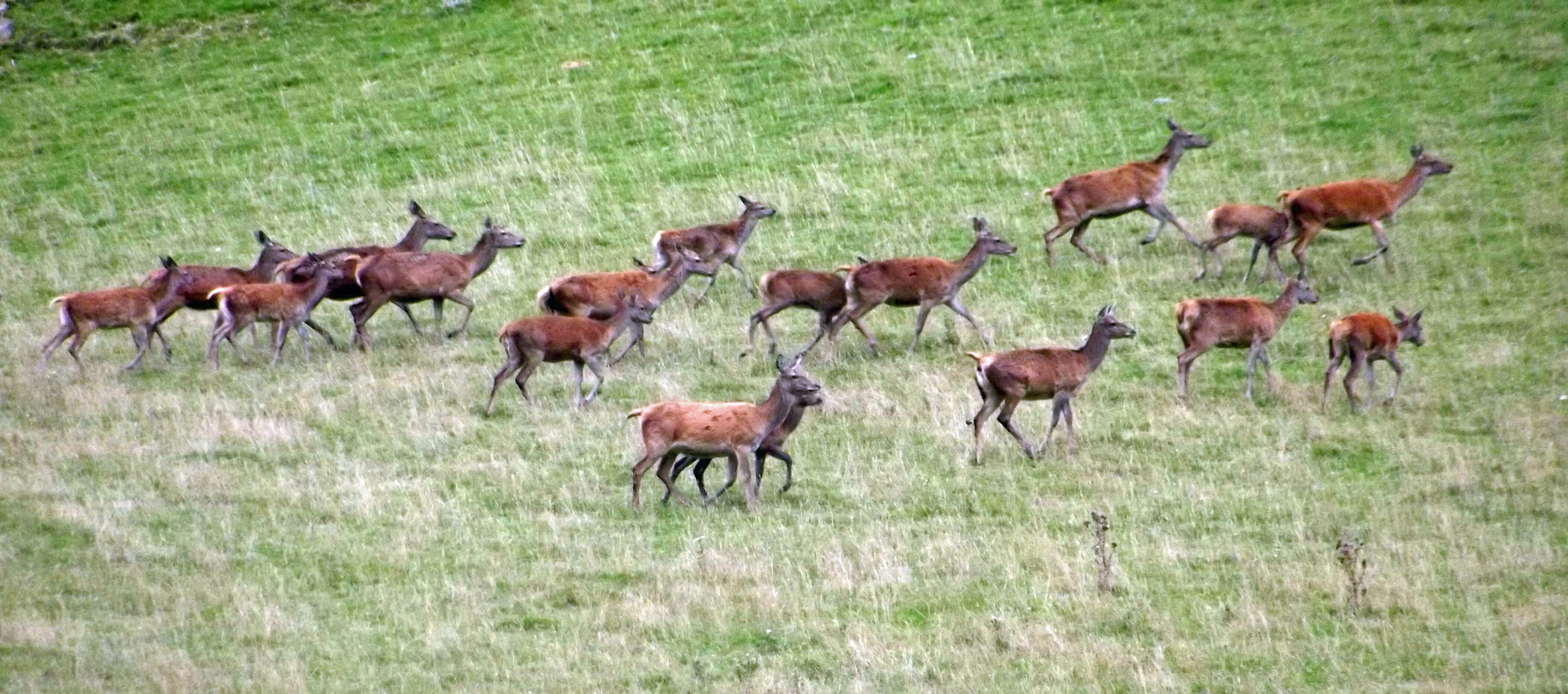 Left: Red-deer hinds (James Common)
Left: Red-deer hinds (James Common)
On my most recent visit to Wasdale, we first glimpsed a few deer
crossing from Wet Sleddale, as we sat near Wasdale Pike, having a
snack, with a view of the M6 traffic far away. Then, as we dropped
into Wasdale, we saw a herd of fifty or more deer browsing on the
slopes below Little Yarlside and Great Yarlside. We watched them
from afar with binoculars.
As we moved on, they became aware of our presence and
traversed around the hillside, in an elegant, leisurely fashion, not
with the nervous bounding gait of alarmed roe-deer. They made
their way around to Gargill Pike and then, as they realised that
their path was now bringing them closer to where we were heading
(to the layby on the A6), they thought better of it and turned back.
Some disappeared over the ridge skyline into Crookdale; others
settled back on the slopes of Little Yarlside. It felt a privilege to
share this wilderness with the red-deer.
27. Buzzards at Wandale Hill
June 2015
Our wildlife is not very scary, compared to that of most other
countries. It presents little danger to us - unless it perceives
that we are a danger to it. Or, more likely, to its young,
for if the perceived danger is to itself it will probably skedaddle.
But when it comes to protecting vulnerable young, parents will, if
necessary, resort to violence.
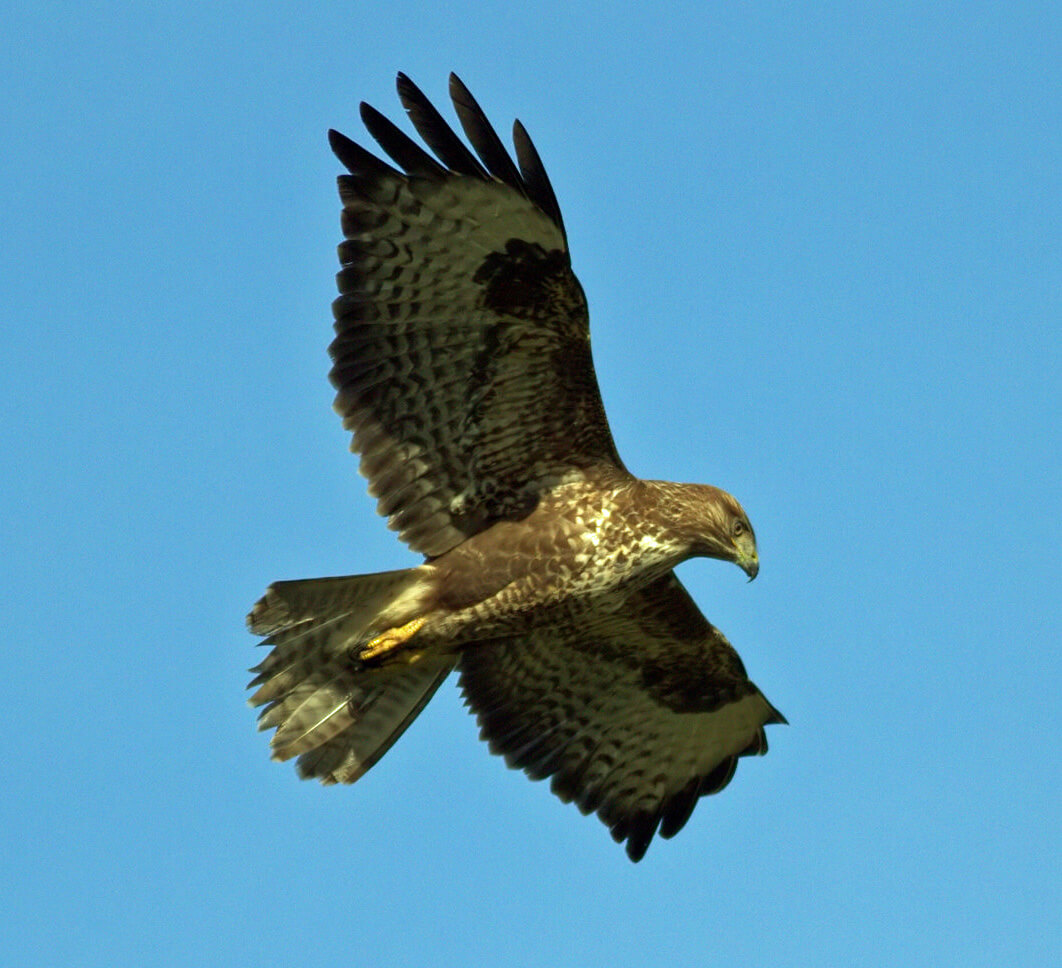 Left: Buzzard (Neil Rolph)
Left: Buzzard (Neil Rolph)
I assume this to be the reason why I was attacked by common-buzzards Buteo buteo
while walking in the eastern Howgills. Above
the farm of Murthwaite, between Wandale Hill and Harter Fell, I
became aware of the familiar, distinctive mewing of two buzzards
circling above. As I walked on, the mewing gradually became more
agitated and closer. It no longer had the tone of a distant, reassuring
accompaniment. It sounded more like a threat.
And then suddenly there was a great whoosh as a buzzard
swooped within a couple of yards of me. And again, and again. I
looked up to see the buzzard preparing for the next assault (I didn’t
check if one or both buzzards joined in). It began from about a
hundred yards up, at about 45 degrees, and headed straight for me
at great speed. It was like standing on a railway line as a train
approached, but knowing that the train would serve away at the
last moment. At least, I assumed that the buzzard would swerve
away. It surely wouldn’t want to hit anything, even me, at that
speed. It was not an assumption easy to put to the test. The instinct
is to throw arms up, duck and turn away.
This experience was certainly scary. Apart from the assault itself,
the difficulty was in determining how to end it. If the buzzards
were protecting their young then I didn’t know where they were
and therefore where to hurry to escape bombardment. Buzzards
nest in trees or on crag ledges. They don’t nest on the ground on the
open moor, as many birds do. Therefore the logical thing is to head
for the open moor, away from trees and crags. It may be logical
but it is not easy to expose oneself as a standing target. Anyway,
that is what I did. I headed for the slopes of Harter Fell. And I was
relieved that eventually the buzzards relented.
Four hours later I returned towards Wandale Hill from Yarlside:
I had to get back to the car somehow. Sure enough, as I scrambled
down the slopes, two buzzards could be heard mewing above. And
then there was the now familiar whoosh as one swooped by. This
time, however, the buzzards didn’t develop any ferocity into their
fly-pasts and after a few reconnaissance sorties they moved away
down the valley of Backside Beck.
I don’t know if they were the same buzzards as earlier. Like
other raptors, buzzards do not nest communally, but one pair could
have been nesting to the east and one to the west of Wandale Hill.
It is not something I feel like investigating closely. A group of
buzzards is called a ‘wake’ although I have never seen such a group.
They are family birds and are usually seen singly or in pairs. They
pair for life and do not usually move far from home. Occasionally,
a small group may be seen circling above but this will be parents
with their juveniles.

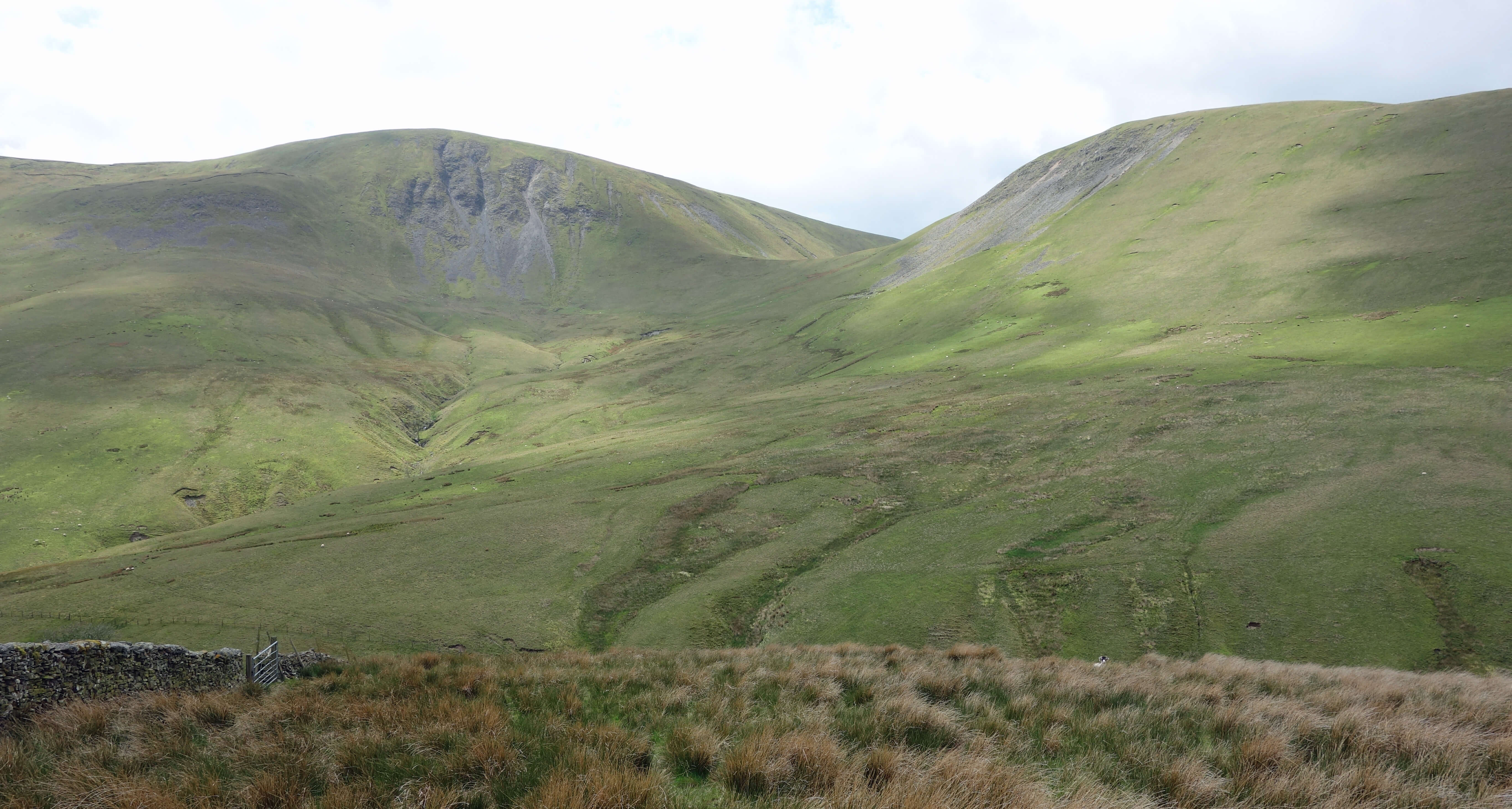 Left: Wandale Hill from Yarlside
Left: Wandale Hill from Yarlside
Right: Yarlside and Kensgriff from Wandale Hill
The common-buzzard is indeed common in Britain. It is the
bird of prey most likely to be heard and seen (except perhaps the
kestrel if you spend most of your time driving on the motorway).
Incidentally, the mewing sound doesn’t always mean that a buzzard
will be seen in the sky as the sound may also be made by a buzzard
perched in a tree. It is a medium-sized raptor - although it doesn’t
seem medium-sized when it swoops towards you. I wish now that
I had taken a photograph of the approaching buzzard to prove it to
you, but I was in a hurry to skedaddle myself.
The buzzard is one of our few birds whose numbers have
increased significantly in recent decades. There are now around
60,000 breeding pairs in the UK. In 1970 only two pairs were
breeding in Lancashire; by 2000 this had increased to 70 pairs;
it is now approaching 500 pairs. It is natural to suspect that the
increase in buzzards may have contributed to the general decrease
in songbirds. This, however, is not the case because buzzards are
not particularly partial to songbirds. They prefer small mammals
(voles, mice and rabbits) and carrion. Songbirds have declined even
where there are no buzzards.
Nonetheless, the fact that buzzards do indeed eat birds has led
to some surreptitious attempts, even by government agencies, to
reduce the numbers of buzzard, especially by estates that would
prefer other birds to be shot rather than eaten (as the buzzard-poisoning
case, mentioned in Chapter 20, indicates). In 2012 DEFRA
proposed to set up a research programme, using public money, of
course, to control buzzards around shooting estates. They soon
withdrew the proposal after widespread public objections.
In 2013 Natural England granted a licence for buzzard eggs to
be destroyed on a pheasant shooting estate but kept the permission
secret, for reasons unknown.
This was somewhat unusual, if not
unique, considering that raptors are legally protected. Again, public
protests led to a governmental back-down, at least in the sense that
no further licences to destroy buzzard eggs have been granted, as
far as I am aware.
It is good to know that the public has developed such a fondness
for these fine birds of prey. I am sure that this fondness would
only be enhanced by a closer familiarity, as I developed at Wandale
Hill. To be swooped upon by aggressive buzzards is one of life’s
experiences not to be missed. I thoroughly recommend it.
28. Ferns on Leck Fell
July 2015
Robert Macfarlane’s revelation (mentioned in Chapter 19) that
wildness can be found in the small, familiar and close-at-hand, as
well as in the large, rarely-visited and distant, came
to him while peering into a grike on the limestone pavements of
The Burren in Ireland. Perhaps it is time I took up peering into
grikes, an activity which I had postponed in Chapter 3.
I prefer to set myself a specific, if difficult, objective rather than
set off in the vague hope of spying something interesting. So I
decided to look for rigid-buckler-fern Dryopteris villarii on the slopes
of Leck Fell. This fern, I read in Natural England’s description of
the Leck Beck Head Catchment Area SSSI, is rare in the UK but also
locally frequent (if one knows where to look!) on Leck Fell.
It is in fact found only in the crevices of limestone rocks in northwest
England and north Wales.
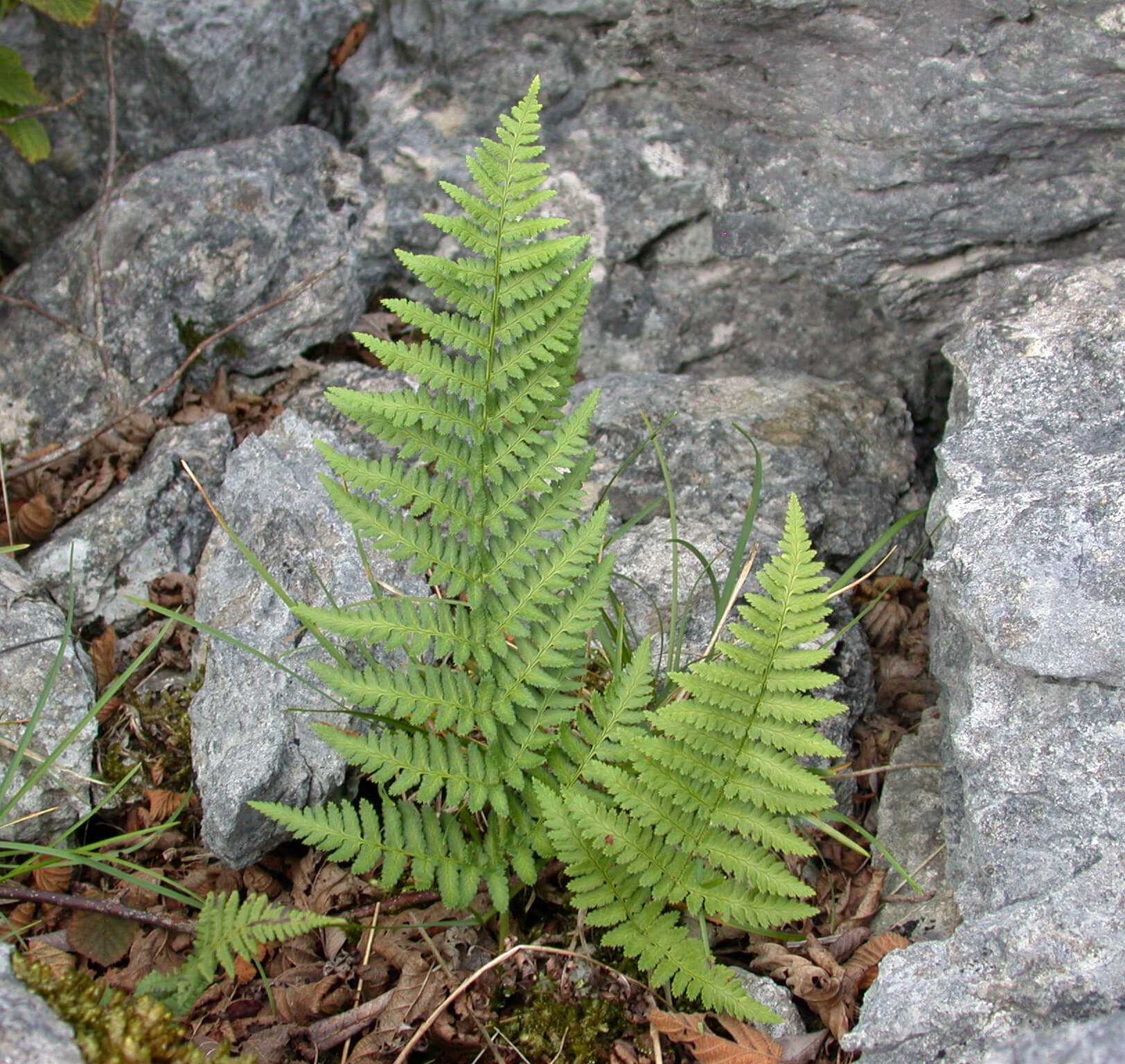 Right: Rigid-buckler-fern (Tim Melling).
Right: Rigid-buckler-fern (Tim Melling).
Fifteen species of fern have been found on Leck Fell, which doesn’t
sound too daunting a number to tackle. Worldwide, however,
there are about 12,000 species
of fern, the majority of which
are leptosporangiate ferns,
meaning that their spore-cases
derive from a single cell. Ferns
are venerable species, being
found in the fossil records of
360 million years ago, long
before the first flowers of 130
million years ago. Ferns are
plants belonging to a group
known as Pteridophyta.
The study of ferns is called
pteridology and pteridomania
refers to the Victorian craze of
collecting ferns and artefacts
relating to ferns.
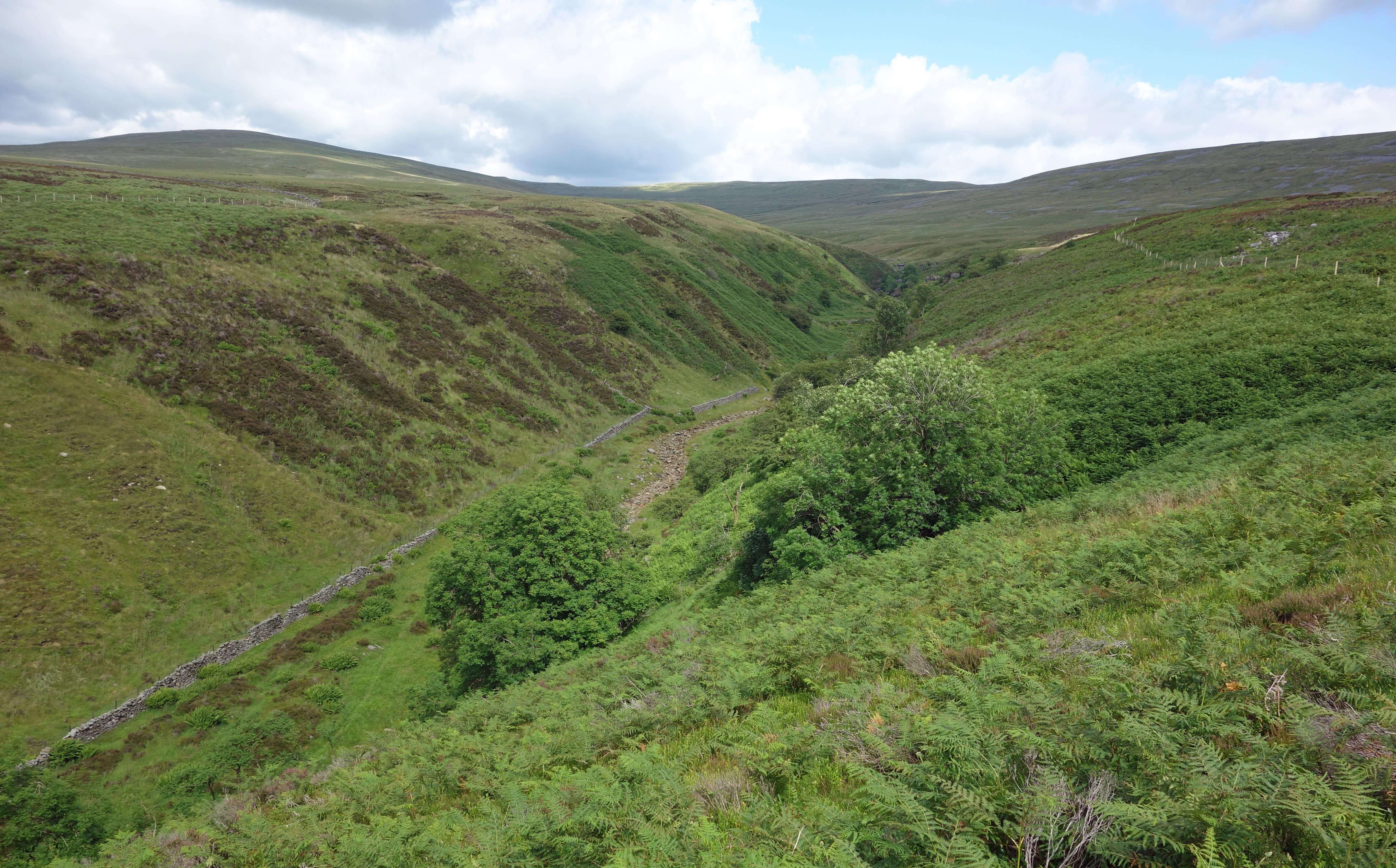 Left: Leck Fell, near The Crumbles, with rampant bracken
Left: Leck Fell, near The Crumbles, with rampant bracken
Ferns, unlike mosses, are vascular plants, having roots, stems
and leaves, but they reproduce via spores and not seeds or flowers.
It is the spores which provide the main way for a beginner to identify
ferns. Superficially, ferns seem to fall into two groups: those (the
majority, which includes rigid-buckler-fern) with green, triangular
fronds and those with various less elegant shapes, such as hart’s-tongue, maidenhair-fern and several spleenworts.
In the first group, each frond has a number of green leaves
growing more or less symmetrically in pairs from the stem and
each leaf has a number of what I will call leaflets (the proper name
is pinnae) growing in pairs from the stem of the leaf. The shapes of
the frond, the leaf and the leaflet vary between species - but not by
much, to my eyes.
The spores are produced on the underside of the fronds in a
structure called a sorus. The sori considerately arrange themselves
into distinctive shapes for the different species. In the case of the
rigid-buckler-fern, the sori are dark, round or kidney-shaped,
relatively large and positioned in pairs on either side of the stem of
the leaflets. The spores are, of course, ripe for only part of the year,
in July and August for the rigid-buckler-fern.
Now, where to look? The SSSI report says that the key area for
rigid-buckler-fern is “at the Crumbles”. Unfortunately, no Crumbles
are marked on the Ordnance Survey map. However, the
Red Rose
Cave and Pothole Club
refers to a pothole called ‘The Crumbles’ at
grid reference 666803, which is within the region described in the
SSSI report. So, I set out to begin the search there.
On reaching the region, two problems became obvious. First,
the whole place seemed overrun with bracken. Bracken is a fern -
but not the fern I want to see. From a distance, it looks (like other
ferns) somewhat similar to rigid-buckler-fern. The prospect of
searching through thousands of ferns that are, in fact, bracken in
order to find the rare rigid-buckler-fern did not appeal much.
However, bracken does not grow on limestone. So I needed
to restrict my search to the limestone areas. The second problem
was that the limestone did not really form the pavements that I had
envisaged. It occurred as small cliff outcrops and scree. Therefore,
there were, sadly, few grikes for me to peer into.
After you’ve looked at thousands of ferns that all look like
bracken every fern looks like bracken. However, I did eventually
find, within a crevice between two limestone boulders, a fern that I
managed to convince myself was not bracken.
It appeared to differ from
bracken in several respects:
its stem had some small red
‘hairs’ and was not smooth
like bracken’s stem; the stem
was rather more flexible; in
colour the leaves were a lighter
green; the leaflets were more
rounded than the pointed
leaflets of bracken (more
like human incisors than the
bracken’s crocodile teeth).
For all I know, bracken might
occur in natural variations that
would encompass both these
specimens (I won’t forget my
experience with bogbean,
described in Chapter 2). The
photograph below shows a frond
of bracken and of the mystery
fern side-by-side.
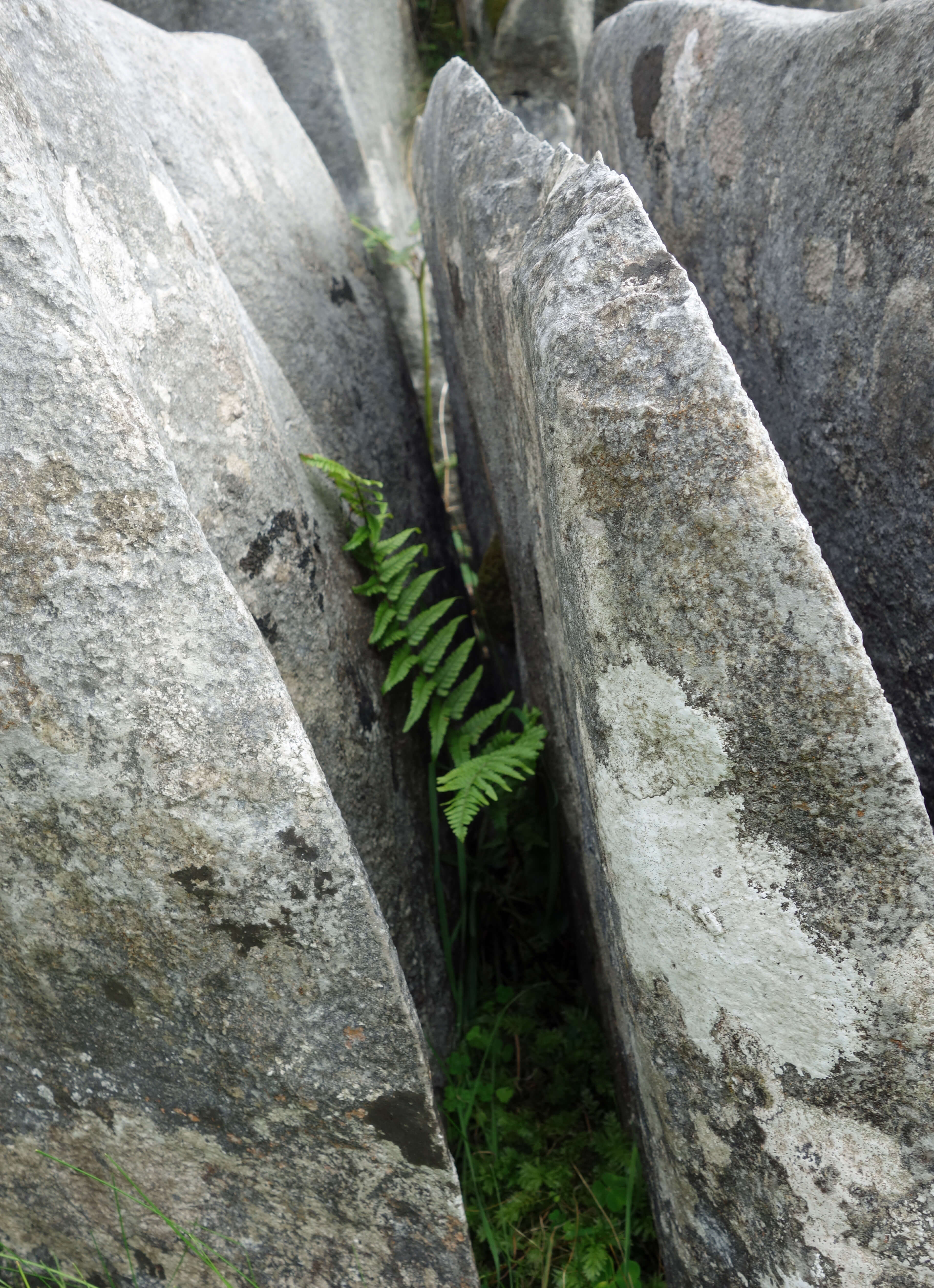 Further left: The fern within the limestone crevice
Further left: The fern within the limestone crevice
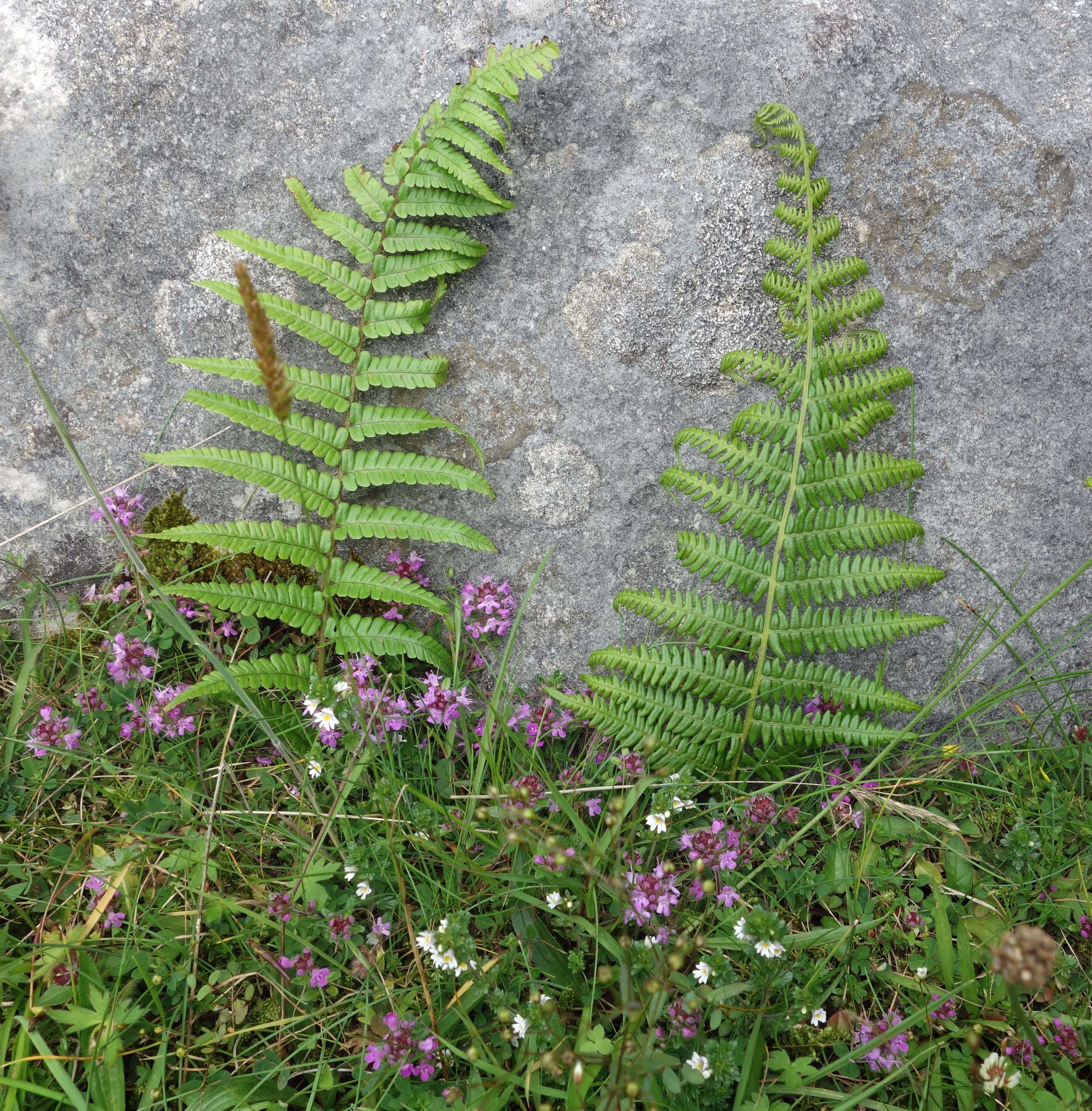
Right: A frond of bracken (on the right) and a
frond of the other fern (on the left)
I eagerly turned the leaves
over to see the distinctive sori.
Unfortunately, there were
none, on both specimens. In
fact, very few of the ferns
around had sori. I deduce
that an individual fern plant
does not produce sori every
year, although I haven’t been
able to confirm this from
the guidebooks. Sadly, the
specimen that was perhaps
not bracken did not really
look like the rigid-buckler-fern shown above either. In some
frustration, I could not face any more bracken-like ferns. As I left, I
grabbed a bracken frond that did have sori on it in order to compare
them with the illustrations in
the books at home.
 Right: The frond with its sori
Right: The frond with its sori
To my surprise, these sori
turned out not to be those of
bracken. Bracken’s sori form
a thin line around the fringe
of the leaflets (the sori with
the fringe?). The sori of my
specimen were large and white
with, typically, two or three on
both sides of the leaflet’s stem.
I’d have a stab that the fern
is male-fern Dryopteris filix-mas, which I read is common
in damp and shady places.
The sexist name is thought
to be because this fern was considered more robust and vigorous
than the ‘female ferns’ called lady-fern or maiden-fern, so called,
presumably, because they look relatively delicate and graceful.
Perhaps the fern that was probably not bracken was a male-fern or
a relative such as scaly-male-fern, dwarf-male-fern or mountain-male-fern.
So, who would have thought it? All those ferns that I had
dismissed as that invasive nuisance, bracken, were not all bracken
at all!
What do these ferns think they are playing at, masquerading as
bracken? They’ve had ample time (360 million years) to develop
a bit of character but, no, they pretend to be bracken. Where’s the
point in that? Species conservation is all very well but do we really
need 12,000 species of fern if most of them insist on looking like
bracken? My frustration is, I feel, fully warranted. They could have
made more of an effort to help me out.
I am tempted to return to Leck Fell to carry out a more careful
investigation, or to search for rigid-buckler-fern in proper grikes,
such as those around Ingleborough. But I have little enthusiasm
to do so. An ability to distinguish the various species of ferns is
not one that I am anxious to acquire. It may be useful or, at least,
interesting to know the difference between, say, snake’s-head-fritillary and silver-washed-fritillary but I cannot foresee much
need to distinguish the various fern species. With relief, I leave
them to the pteridologists.
29. Yellow-Horned-Poppies at Middleton Sands
September 2015
To mark the official end of this fitful summer I decided to visit a
sandy beach. Unfortunately, although Loyne is blessed with
a variety of habitats, from upland peat moors and limestone
cliffs through flood-plains to salt marshes, it doesn’t really have any
sandy beaches. However, the Environment Agency considers the
Lune estuary to end on a line from Knotts End to Heysham, and so
to include Middleton Sands. This sounded promising, as it forms
part of the Morecambe Bay Special Protection Area and Special
Area of Conservation.
Sadly, I was too late to appreciate Middleton Sands at its natural
best. At least 200 years too late. The 1848 OS map shows a pristine
coast between Potts Corner and Red Nab. Inland it marks only
a ‘Middleton Tower’, an early 19th century sandstone folly with
battlements. North of Red Nab the coast is shown to continue
straight to Near Naze on Half Moon Bay.
I was drawn to Middleton Sands because I had read a 2008
report that stated that there was “a tiny (0.4 ha) dune remnant at
Potts Corner, Middleton Sands”.
Sand dunes exist nowhere else
within Loyne and, since they provide a distinctive habitat that suits
particular species, they deserve a visit. 0.4 hectares may sound tiny
but it is 4,000 square metres and that surely cannot be missed.
In 2008 the Middleton Sands dunes made a small contribution
to the estimated 88.7 ha of sand dunes that remained in north
Lancashire. This 88.7 ha represented an 84% decline of the sand
dunes at the time of the 1848 map, when dunes ran more-or-less
continuously from Lytham to Fleetwood. Today, of course, the
dunes have been largely replaced by houses, shops, roads and
leisure amenities or subsumed by golf courses.
Sand dune is now a scarce habitat in Britain and, rather
belatedly, has been made a Priority Habitat for conservation in
the UK Biodiversity Action Plan. This new-found respect for sand
dunes is not entirely for reasons of biodiversity. It is now realised
that dunes provide an important defence against floods, both as a
barrier and as a means to reduce wave action during storms. This
natural defence is much cheaper and often more efficient than sea
walls and other hard coastal defences.
The walk along Middleton Sands was not disappointing. It was
much worse than that. It was depressing to see how, in less than
200 years, we had so utterly changed this short stretch of ordinary
coastline.
There was a beach, of a sort, between the mud of Morecambe
Bay and the banks of the fields inland, and even a narrow strip
of sand, too pebbly to allow the building of sand castles, I expect.
Above the sand the pebbles became stones and rocks piled up below
the modest banks.
Not much grew on this narrow beach. I came across a few
yellow-horned-poppies Glaucium flavum, which are rather straggly
plants as they have every right to be, living in a salty wind. There
were also some clumps of sea-holly, sea-sandwort and lyme-grass.
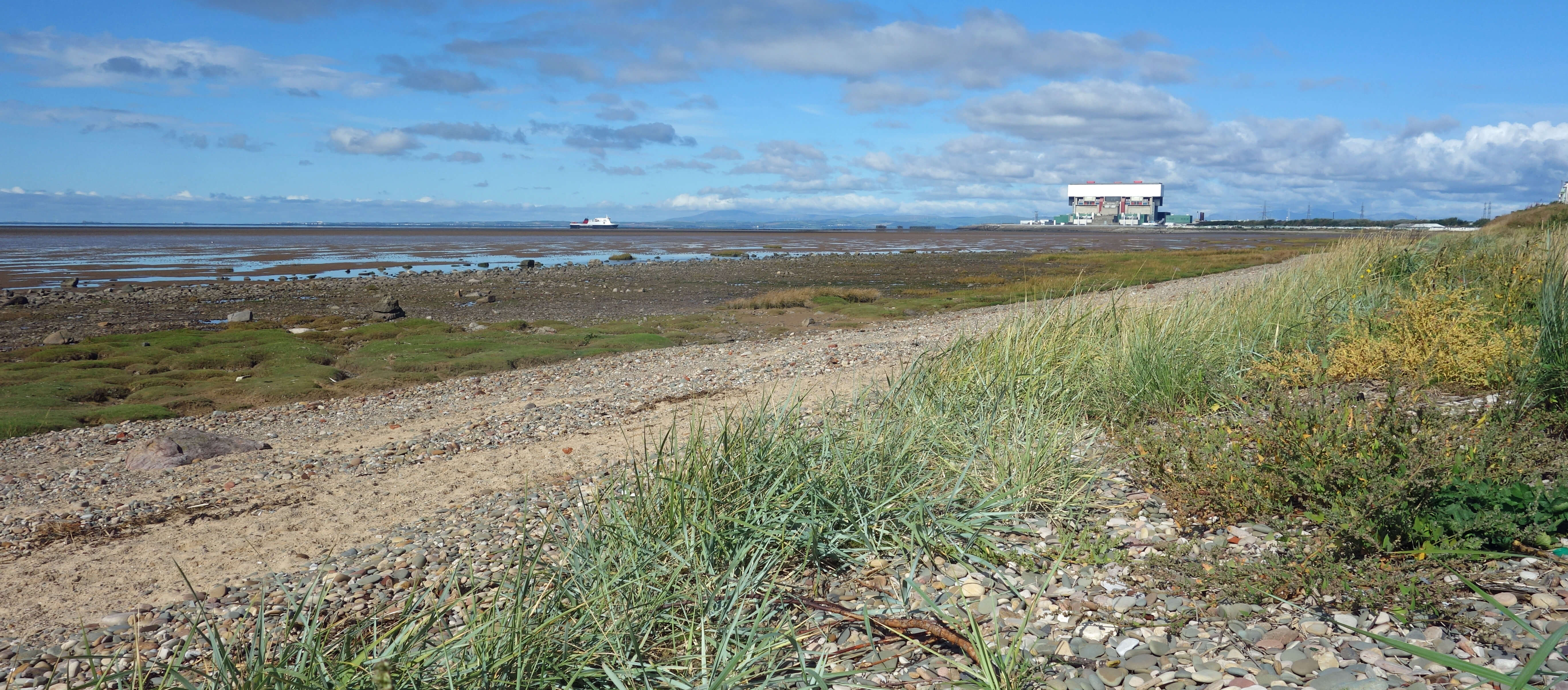
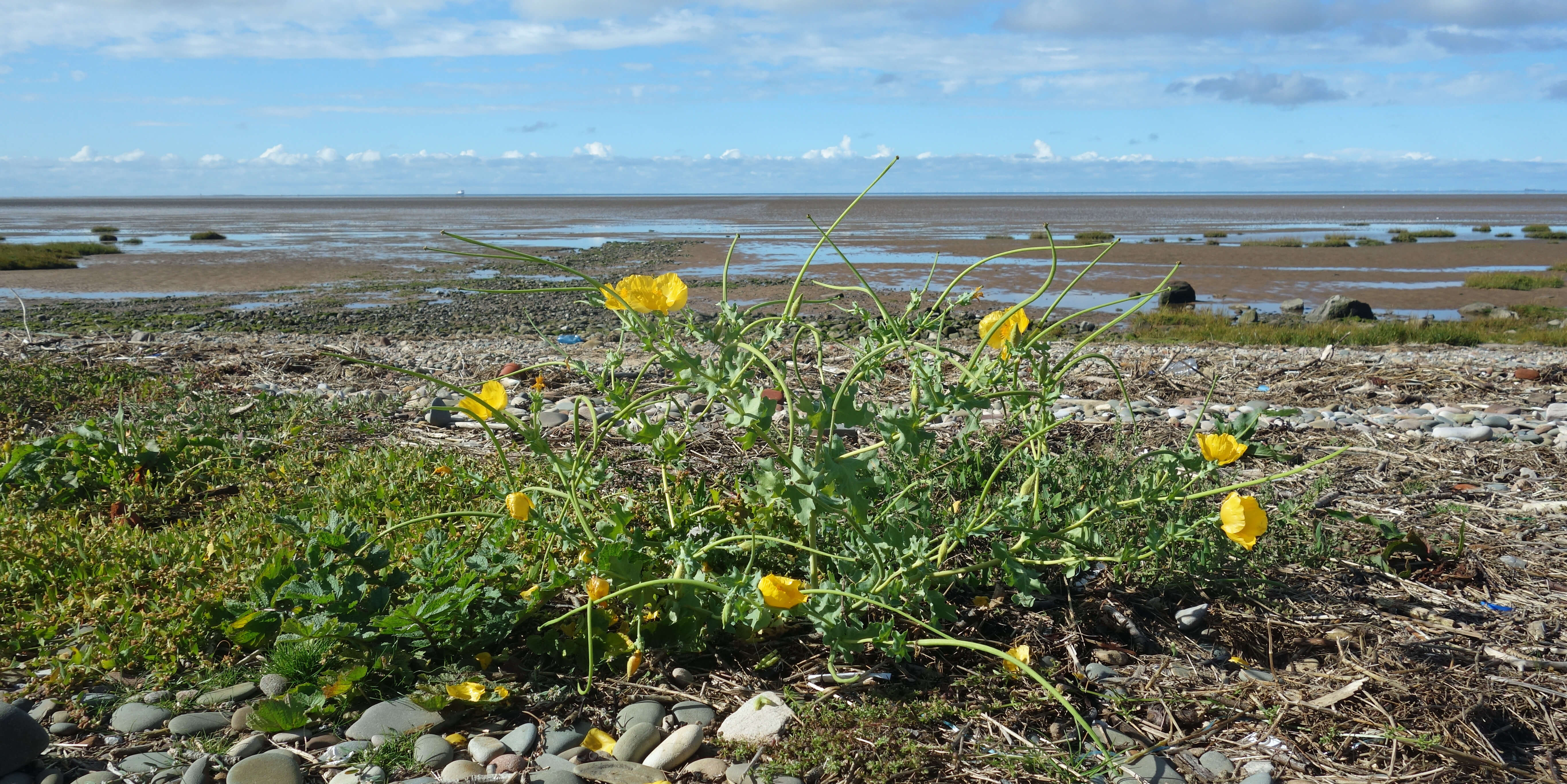 Left: Middleton Sands beach
Left: Middleton Sands beach
Right: Yellow-horned-poppy
I expect that the definition of ‘dune’ is rather flexible. It would,
I feel, be bending it too far to describe any of this beach as a dune. A
dune is built from wind-blown sand. There is just not enough sand
here for the wind to blow into dunes. Dunes are characterised by
their dynamic nature - how they change shape in response to wind
and waves. There is no chance of this at Middleton Sands as the
dunes, if they existed, would soon encounter the bank defences. So,
despite my best hope, I could not point to 1 square metre (let alone
4,000 of them) of what I would consider to be sand dune.
The overriding impression, as one walks along the Middleton
Sands ‘beach’, is of human detritus, of the everyday rubbish and
scruffiness that we have become too familiar with to notice. Amongst
the seaweed and shells is all sorts of junk. Many of the pebbles
and rocks are not even pebbles and rocks - they are old scraps of
concrete and bricks, from buildings and defences that have fallen
into the sea. On most of the old bricks I could read “Claughton
Manor Brick Co Caton”. So the eyesore of Claughton Quarry on my
local hill of Caton Moor has been created in order to make bricks
to be transported here for buildings that end up disfiguring this
beach. How futile it all seems!
Above the banks one sees the backsides of the campsites that
line the coast. ‘Campsites’ is a misnomer: these are now sites for
‘mobile homes’ that never move and are bestowed with names such
as Wywurry. Those homes nearest the sea are positioned to within
an inch of the bank edge. As a result the owners live in fear of
bank erosion. From the beach there’s a parade of ad-hoc defences
of concrete, fence, wire and rubble, in varying states of disrepair.
Between the campsites lies a region where, if you clamber up
the bank to have a look, you are confronted with ‘private’ signs
and warnings that CCTV is surveying your every move. This is
Middleton Towers, which would be a ‘retirement village’ if it were
ever completed. There were intended to be 650 dwellings, with self-contained amenities, including a nursing home and free transport
to escape from the site. The builders went into administration with
only a fraction of the dwellings completed.
 Right: Middleton Tower holiday camp
Right: Middleton Tower holiday camp
Middleton Towers is on the site of the old Middleton Tower
Holiday Camp, which could house up to 3,000 holidaymakers. It
was built in 1939 and closed in 1994. I can imagine 3, but not 3,000,
holidaymakers on Middleton Sands beach, although, looking at the
old postcard, there seems to have been more sand a while ago (and
maybe even a fringe of sand dune). They must have found all the
entertainment they needed on
the site, mainly in the theatre
built like an old liner.
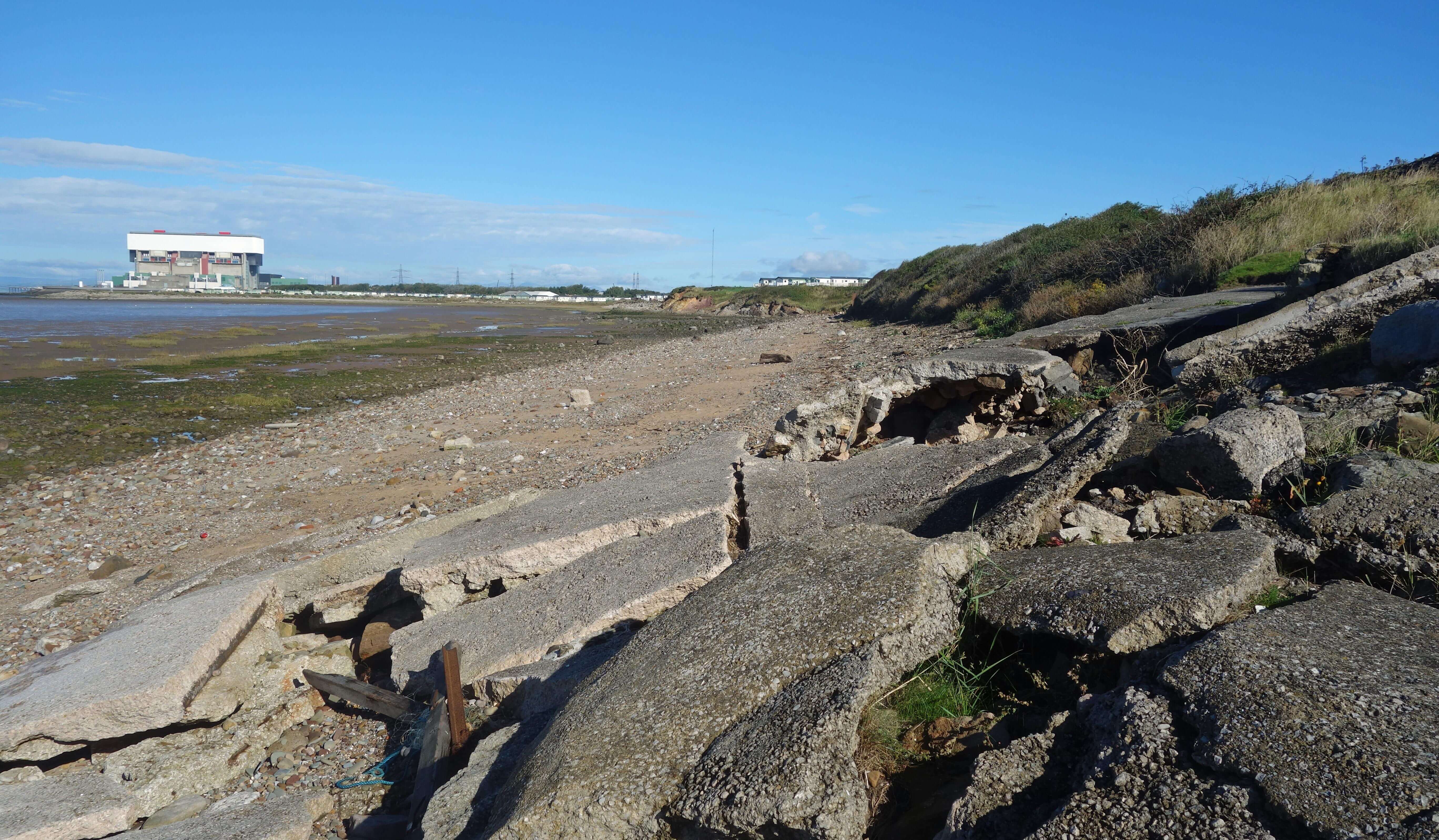
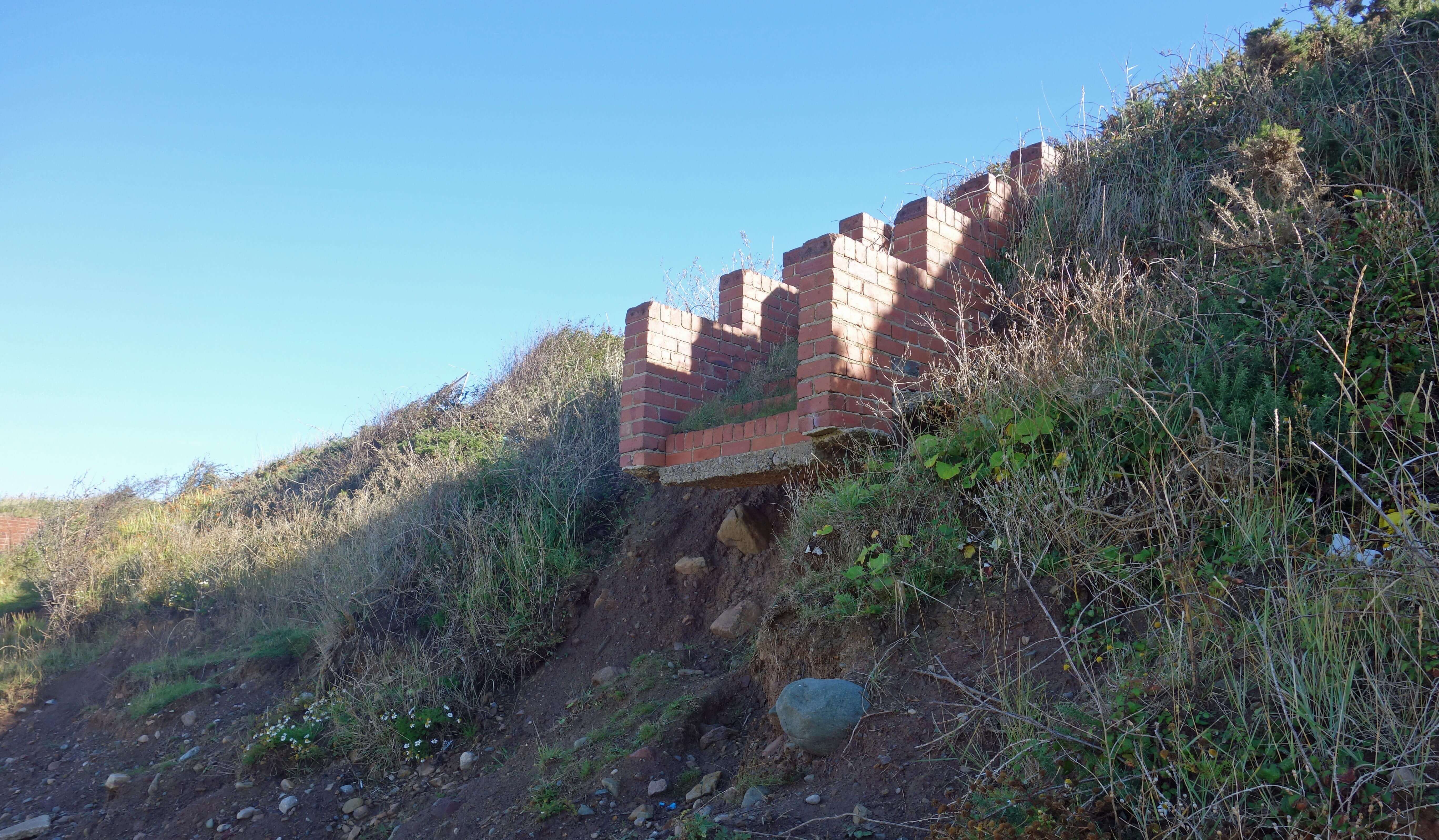 Left: The old jetty and steps
Left: The old jetty and steps
From the beach today
one sees various remains: an
old jetty or ramp (was there
ever enough water to launch
boats in?); old steps that end
mid-air with the bottom steps
washed away; old drainage
pipes sticking far from the
bank (presumably indicating
the degree of erosion); an old
brick building of indeterminate
function half washed away.
Above them all, Middleton
Tower still stands, preserved
as a Grade-II listed structure,
although it has no aesthetic or
historic merit that I can see.
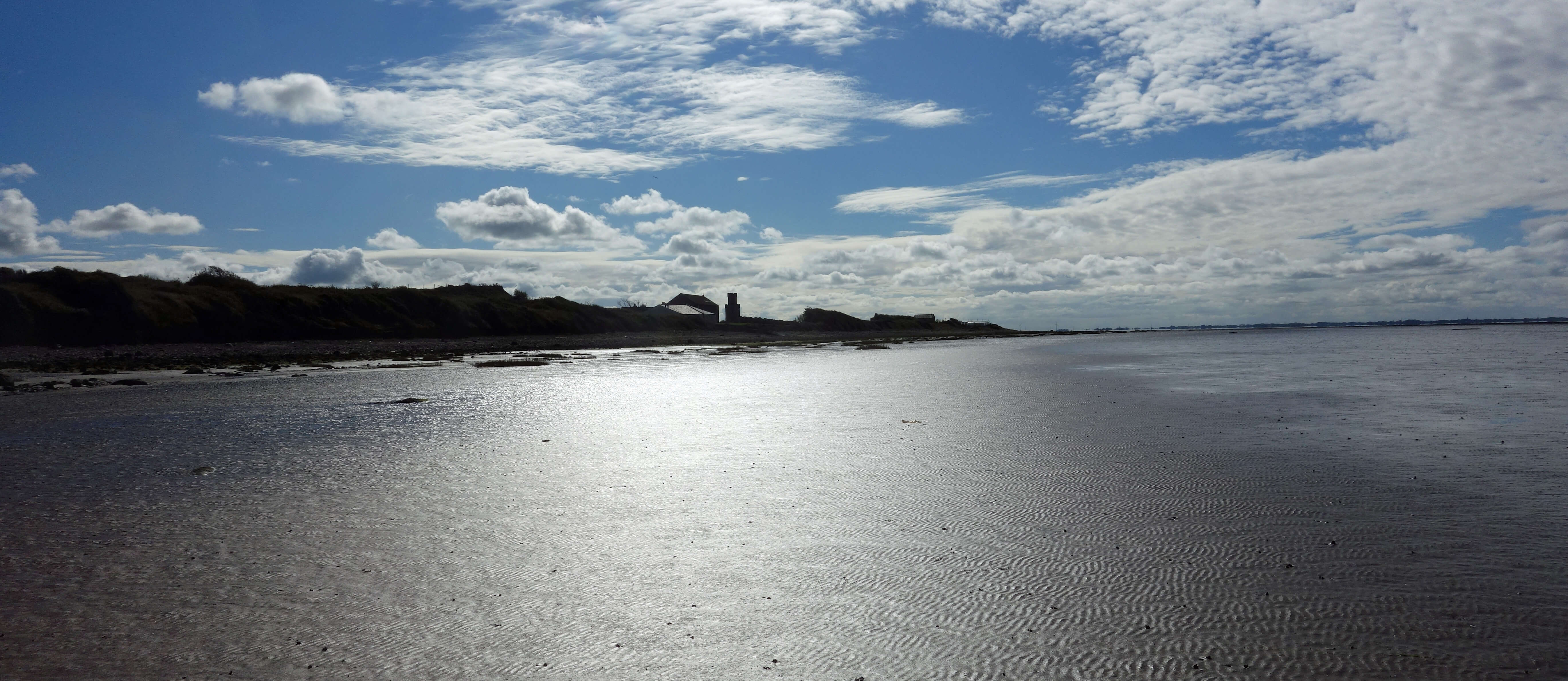 Left: On the mud of Middleton Sands
Left: On the mud of Middleton Sands
All the time, as one walks
along the beach, one is faced
with the dominating presence
of Heysham power station.
It does not produce the noise
and smoke of old factories but
there is a permanent hum that
provides comfort to the mobile
homers nestling in its bosom.
Its bulk prevents any view of
the Lake District hills across
the bay. As the 1848 map
shows, the power station is on an artificial promontory built out
between Red Nab and Near Naze.
The thought of walking back past the dereliction on the beach
did not appeal. The tide being out, I walked instead onto the mud
of Middleton Sands. Here I hoped to find some natural solitude.
On the horizon I could see wind turbines. Many of them. I
tried to count them: at least 200, I think. It was hard to be precise
because, due to the curvature of the earth, many of the blades of the
turbines seemed to disappear into the sea.
Nuclear power station behind me; hundreds of wind turbines
ahead of me. To my right, Barrow, making nuclear submarines;
to my left, Blackpool. What are we doing? Have we made all this
necessary? A 4x4 was driven onto the mud, around in several loops,
and off. I turned to the Lake District hills for consolation. Four sets
of wind turbines were visible.
As I walked back to Potts Corner I was met by a herd of thirty
or so cows and bullocks migrating from the south. They were
munching through what little vegetation they could find. Shortly
after, two lads, who I assume to be farmhands but could have been
youths having fun, judging by their lack of expertise, drove the
cattle, with shambolic shouting and running, across the mud and
ditches back to where I suppose they belonged.
When even farmers treat such a potentially special environment
with disrespect what hope is there?
30. Badgers in Lawson’s Wood
September 2015
The recent government decision to extend the badger culling
programme prompted me to visit our local badgers in order
to reassure them that the guns are moving south, to Dorset.
The badger Meles meles is Britain’s largest carnivore (apart from
Homo sapiens). The nation’s ambivalent attitude towards badgers
is discussed in a recent book by Patrick Barkham [1].
The badger is fondly loved, even by the many who have never seen one, thanks to
The Wind in the Willows and Rupert Bear books and to the display of
its frolics on Springwatch TV programmes, sadly spoiled recently
when a badger misbehaved by eating avocet chicks. This leads to
the other view, of the badger as a farmer-annoying, disease-carrying
pest that deserves to be persecuted, as it has been for centuries, and
to be the target of eradication programmes.
They do at least deserve their privacy, so we don’t pester them
often. This was only the third visit in about ten years. We set off
before dusk for Lawson’s Wood (part of Aughton Woods). We
take only peanuts, which we sprinkle by some large holes in the
grounds. We settle ourselves downwind to wait.
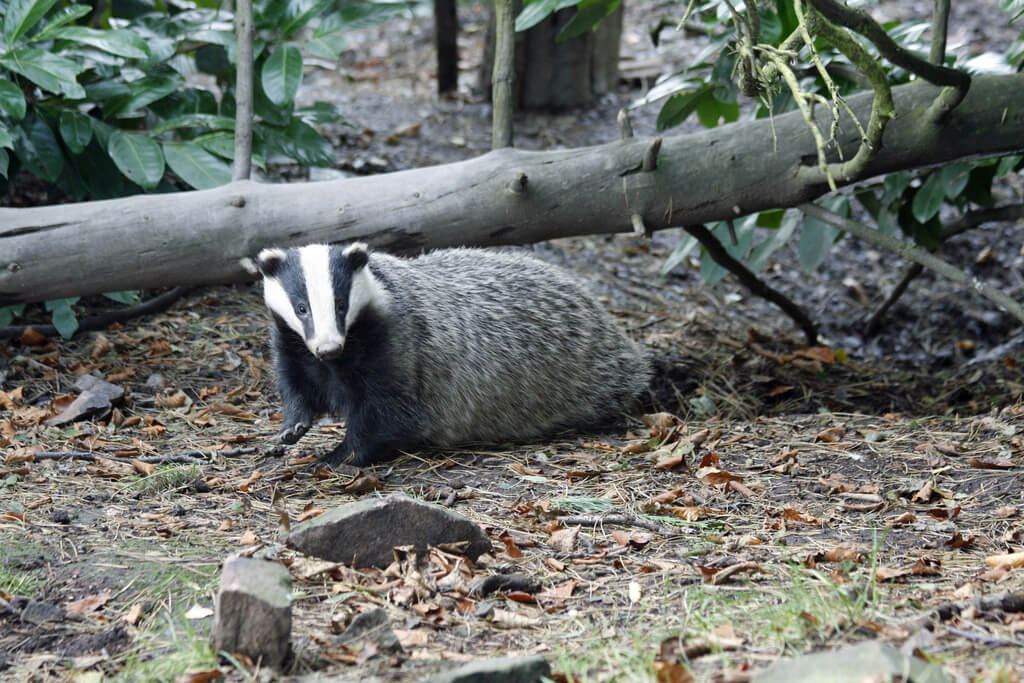 Right: Badger (Ben Tutton)
Right: Badger (Ben Tutton)
The first visit yielded only some vague snufflings in the dark
undergrowth, both unnerving and unsatisfying. The second visit
was more productive. Before daylight had faded and before we
had settled some ten yards away, out popped a badger to look
straight at us. The badger seemed quite calm about the situation,
which was a relief as it can be fierce if it feels in danger. Its head,
in a direct view, was thinner than I had expected from photos but
overall he seemed a remarkable specimen to have living wild in
woods within a mile or so of our home.
We looked at the badger for a few seconds, and maybe it
looked at us. Its sense of sight is poor compared to that of smell
and hearing. If it saw us, it was unperturbed. It continued rooting
about, popping in and out of its home, enticing one or two of its
friends out, and enjoying the special treat of peanuts.
In the dark, one becomes more aware of the badgers’ sounds.
According to the
Wildlife Conservation Research Unit
“the badger has a surprisingly diverse vocal repertoire which may relate to both
their nocturnal habits and the relative complexity of their social
structure”.
The Unit lists sixteen distinct sounds - churrs, purrs,
wails, chitters, keckers, growls, snarls, yelps, squeaks, snorts, barks,
clucks, hisses, coos, chirps and grunts - and provides audio files
and an interpretation of their meaning. These should be thoroughly
studied before a nocturnal visit in order to understand fully what is
going on. Whatever was going on we left them to it.
The badger belongs to the family of mammals named Mustelidae
(possessing musk glands), commonly called the weasel family. This
also includes the otter and stoat. Badgers live in groups of ten or
so within networks of tunnels and chambers known as setts. They
usually live within woodland and spend the day underground. It
is difficult therefore to know how many badgers there are in the
country. The Lancashire Badger Group estimates that there are a
thousand or so setts in Lancashire.
The verb ‘to badger’ is an odd one. Badgers don’t badger; they
are badgered. The word comes from when dogs were set upon
badgers. After a comprehensive set of enactments - the Badger Act
(1973), the Wildlife and Countryside Act (1981) and the Protection
of Badgers Act (1992) - such an activity is no longer legal. However,
it still occurs. Some owners of hunting dogs consider badgers a
more worthy challenge than rabbits. Other people destroy, perhaps
even set fire to, the setts. And it is estimated that 50,000 badgers a
year - that is, about one-seventh of all badgers - die on our roads.
Farmers are not fond of badgers. As one local farmer told us,
badgers damage land, fencing and crops and eat eggs and small
livestock (although their diet is primarily worms, grubs, fruit and
nuts). At this point it would take an effort of will, which I lack, to
avoid the controversy of badger culling. The least that can be said is
that you would expect there to be convincing evidence that badgers
are indeed responsible for the spread of bovine tuberculosis (bTB)
before approval is given to otherwise illegal activities.
Prince Charles was already convinced in 2005 when he wrote to
the Prime Minister asserting “all the evidence is that TB is caused
and spread by badgers” [2]. I can understand ‘spread’ - but I am
perplexed that badgers ‘cause’ bTB. Anyway, the only evidence
he mentioned was a “recent study in the Republic of Ireland which
proved that badger culling is effective in ridding cattle of TB”.
As is invariably the case, the facts are less clear-cut. The
general opinion is that, with many other factors involved, there is
no conclusive evidence that badger culling led to the decrease in
bTB in Ireland. The Irish government claim only that culling “has
contributed” to the decrease. Nonetheless, Prince Charles felt able
to conclude “I do urge you to look again at introducing a proper
cull of badgers where it is necessary”. Clearly, there was and no
doubt still is a powerful lobby for badger culling.
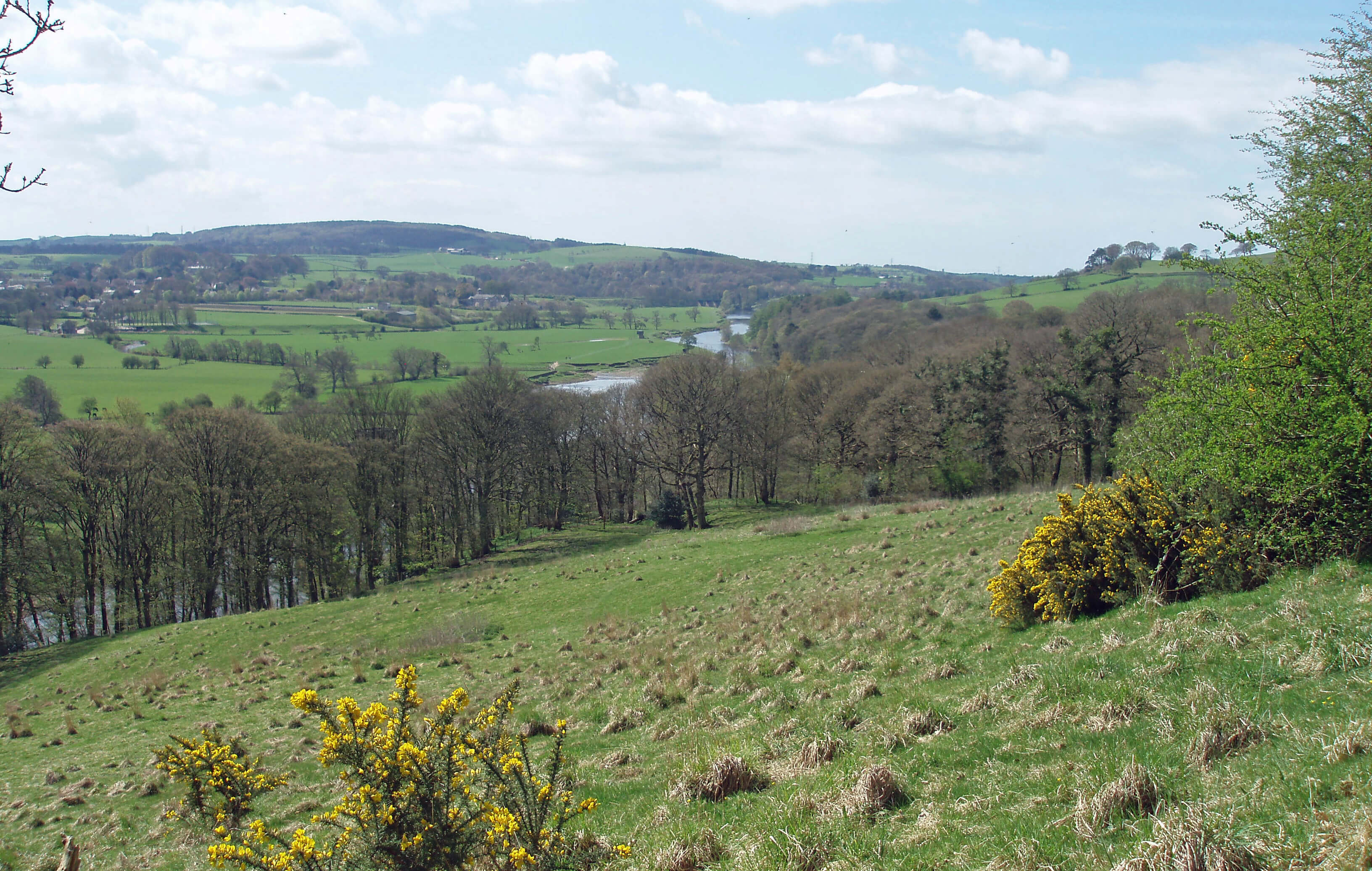 Left: The Lune from Lawson’s Wood
Left: The Lune from Lawson’s Wood
The Independent Scientific Group (ISG)’s 289-page report of
2007, written after 11,000 badgers had been killed between 1998
and 2005, concluded that “Badger culling can make no meaningful
contribution to cattle TB control in Britain ... It is highly unlikely
that reactive culling could contribute other than negatively to future
TB control strategies ... Proactive culling is unlikely to contribute
effectively to the future control of cattle TB ... We consider it likely
that licensing farmers (or their appointees) to cull badgers would not
only fail to achieve a beneficial effect, but would entail a substantial
risk of increasing the incidence of cattle TB” [3].
That sounds conclusive. Has anything changed since 2007? The
government has changed even if the scientific evidence hasn’t. The
government is now more sympathetic to the rural vote.
In fact, things changed in 2007, with the Labour government.
Presumably not content with ISG’s conclusions, it immediately
asked its Chief Scientific Adviser to review the ISG final report.
Analysing the same data, he duly and dutifully arrived at a different
interpretation. He concluded that culling “would have a significant
effect on reducing TB in cattle” [4].
ISG then wrote a final final report in which it said that “It appears
that the main conclusions of the two reports differ mainly because
the ISG concluded that it was not practically or economically feasible
to carry out culling on the scale necessary to gain beneficial effects.
[The adviser]’s group of experts did not include the practicalities or
costs of culling in its considerations” [5].
The ISG then felt obliged to
concede “that under certain well-defined circumstances it is possible
that culling could make a contribution towards the reduction in
incidence of cattle TB in hot spot areas.”
A priori, it seems unlikely that badgers are so obviously
responsible for the spread of bTB that their mass slaughter is
justified. A badger only wanders a mile or two from its sett in its
whole life. They are much less mobile than other bTB carriers such
as deer and rats. Cattle themselves carry bTB and, as we realised
during the 2001 foot-and-mouth epidemic, they get around the
country with alarming ease (because farmers move them). Perhaps
badgers acquire the disease from infected cattle rather than vice
versa. Perhaps farmers are biassed towards attributing blame to
a silent scapegoat rather than to cattle mismanagement. Certainly,
badgers are not necessary for the spread of bTB since the disease
exists in parts of the world where there are no badgers.
The 2013-2014 badger culling programme was limited to
Somerset and Gloucestershire. The Independent Expert Panel,
commissioned by DEFRA, found that the programme was inhumane
and ineffective: many of the 1,861 badgers killed died a painful
and lingering death, and less than half the number intended were
killed. It was not part of the panel’s brief to comment on any effect
in reducing bTB, as the programme’s aim was to investigate the
feasibility of the culling activity, not to reduce bTB. Nevertheless
the National Farmers Union claimed that the culling programme
did lead to a decrease in bTB. (In fact, bTB rates are falling in
England anyway, mainly, it is thought, as a result of tightening
cattle measures.)
Again, the government was disinclined to accept the conclusions
of its independent experts. Although a motion in March 2014 to
end badger culling was passed by 219 votes to 1, the Environment
Minister introduced a bTB strategy in February 2015: “Our 25-year
strategy includes cattle movement controls, vaccination in edge
area and culling where the disease is rife. This strategy has worked
in Australia and is working in New Zealand and Ireland ... We will
not let up, whatever complaints we get from protest groups” [6].
The minister is either confused or disingenuous. There are
no badgers in Australia and New Zealand. She was presumably
referring to programmes to eradicate two alien species, water-buffalo and possum, that the governments wanted to eliminate
regardless of any impact on cattle. There are, of course, many
other differences between UK badger culling and the antipodean
programmes. After meeting with the minister, the Badger Trust
(one of those pesky ‘protest groups’) considered that they were
“better briefed and had a clearer understanding of TB policy than
the Secretary of State who is responsible for its implementation”.
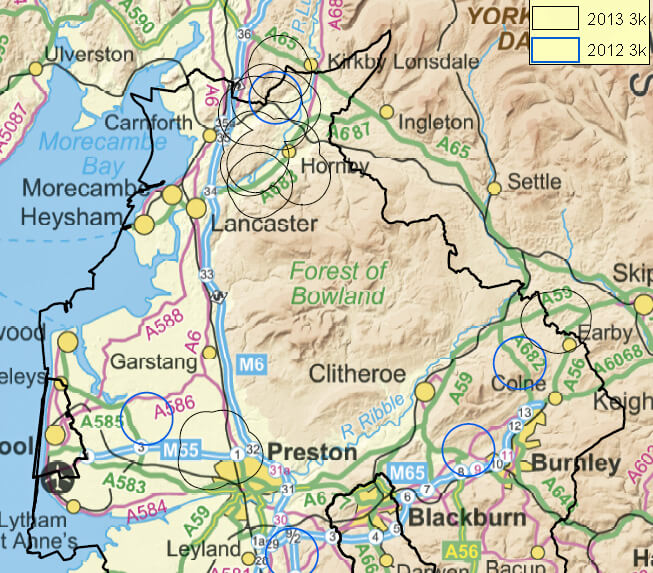 Right: Lune Valley bTB cases 2012-2013
Right: Lune Valley bTB cases 2012-2013
Still, a 25-year programme sounds impressive. During it,
the culling programme will be rolled out to where it is deemed
necessary. Will it, in due course, roll out to Loyne? According to
a Farm Northwest newsletter, there have been cases of bTB in the
Lune valley between Lancaster and Kirkby Lonsdale, with more
cases in 2013 (the last year reported) than in 2012.
It is not clear from the map (shown to the right) whether what looks
like the single 2012 case in the Lune valley was a new case. Anyway,
as can be seen, the Lune valley cases are twenty miles from the
nearest other outbreaks. How could badgers be responsible for the
spread of bTB into the Lune valley? Nonetheless, the fact that we
have bTB here is bad news for any badgers in Lawson’s Wood.
On our latest visit to the wood we had difficulty finding the
sett where we had watched the badgers a few years ago. It was
overgrown with brambles and bracken. There was no sign of
recent badger activity. We waited until after dark but there were
no badgers.
Do badgers ever voluntarily abandon a sett? As they have
invested decades of work in creating their home it is hard to see
why they would. The local farmer mentioned above would no
doubt be pleased that the badgers have gone. More generally, the
government’s culling programme has, as was predicted by DEFRA,
been seen as a green light for the illegal killing of badgers. Such
activities have more than doubled in recent years, according to the
Badger Trust.
Despite the title of this section, you didn’t really think that I
would broadcast the fact that there are badgers in Lawson’s Wood,
did you? If I knew that there were any there, I would keep it secret.
[1]. Patrick Barkham (2013), Badgerlands: The Twilight World of Britain’s Most
Enigmatic Animal, London: Granta.
[2]. Prince of
Wales correspondence.
[3]. Bovine TB: The Scientific Evidence, Final Report of the Independent Scientific
Group on Cattle TB (2007).
[4]. Sir David King (2007), Tuberculosis in Cattle and Badgers: A Report by the
Chief Scientific Adviser.
[5]. Badgers
and cattle TB: the final report of the Independent Scientific Group
on Cattle TB (2008).
[6]. Daily
Telegraph report (2015).
31. Salmon in the Lune
October 2015
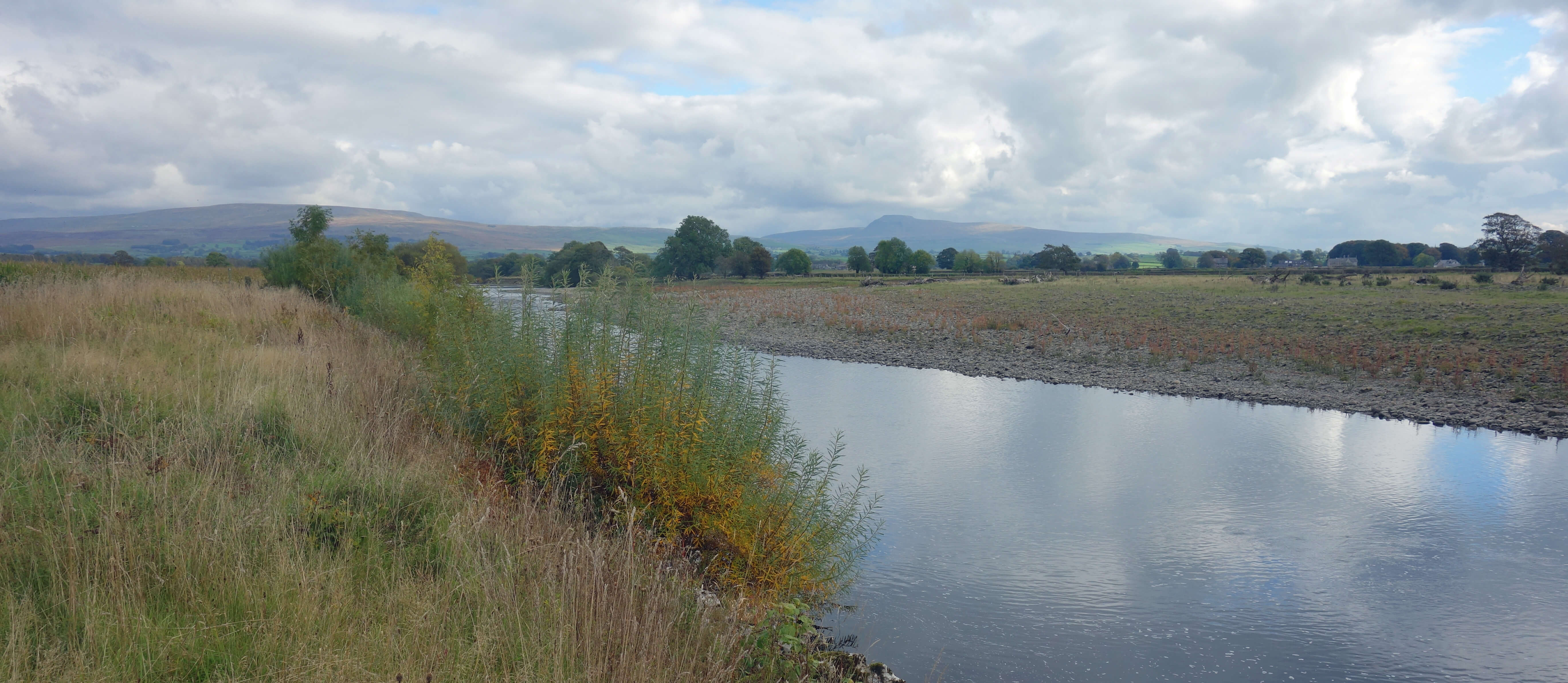 Right: The Lune north of Arkholme
Right: The Lune north of Arkholme
A walk along the Lune Valley Ramble on the west bank of
the River Lune between Kirkby Lonsdale and Arkholme
is far from roads and houses. It is likely to be in silence,
disturbed, if you’re lucky, only by the sound of salmon Salmo salar
splashing as they leap from the water.
It is not known why salmon leap when in calm, flat water. We
can understand their need to leap over weirs and waterfalls but why
do they leap unnecessarily? Are they exercising for more difficult
leaps later? Are they trying to rid themselves of the parasites they
acquire as they move upriver? Are they somehow preparing for
their crucial breeding stages? Are they checking that there are no
anglers about?
I like to imagine that they leap in exultation, at the thought
that their life’s hazardous journey is nearing its end. These salmon
were born some ten years ago in the Lune. They stayed in the Lune
for up to five years (as parr) and then travelled (as smolt) to deep
sea feeding areas where they remained for up to four years. They
then returned to the Lune to spawn and, in most cases, to die (as
kelt). Their homing behaviour depends on their olfactory memory
- and therefore we must not change the smell of the Lune! One
female creates several shallow depressions (called redds) and lays
up to 5,000 eggs in each. The mortality rate is obviously high and
therefore each individual salmon that completes the journey has
good cause to celebrate.
The number of salmon recorded at the Forge Weir, Halton
counter since 2004 is shown in this table [1]:
2004 2005 2006 2007 2008 2009 2010 2011 2012 2013 2014
12781 9824 7443 11166 9420 8289 8315 6318 4273 4514 3544
Clearly, the
numbers have declined significantly in recent years. And judging
by accounts of Lune salmon fishing many decades ago the numbers
now are far lower than they once were.
Although there is the occasional good news of salmon being seen
in previously polluted rivers, such as the Mersey and Derbyshire
Derwent, overall the picture is gloomy. Only 19 of the 64 principal
salmon rivers in England and Wales reached their conservation
targets in 2013, compared to 42 in 2011, according to Salmon & Trout Conservation UK.
In Scotland the number
of rod-caught salmon fell by 50% between 2009 and 2014, with
the 2014 figure being the lowest since records began in 1952, a loss considered to be a
cultural catastrophe.
The Tweed, one of Scotland’s iconic salmon rivers, recorded a near 50%
fall just from 2013 to 2014.
With so many salmon rivers failing it is natural to infer that the
causes are to be found at sea rather than within individual rivers.
It doesn’t logically follow, of course, because it could be that all the
rivers suffer from the same problem, or maybe different problems
that have the same effect. Nonetheless, it may be a consolation to
some to be able to attribute the causes elsewhere, even if that makes
them harder to eliminate.
It could be that climate change has caused those species that
the salmon prey upon, and that prey upon the salmon, to move.
Perhaps the sea lice that plague salmon farms along the Scottish
coast are also affecting wild salmon. Perhaps the sea is too polluted,
or over-fished, or has too much traffic. Whatever the cause, it is not
easy to see what can be done about it.
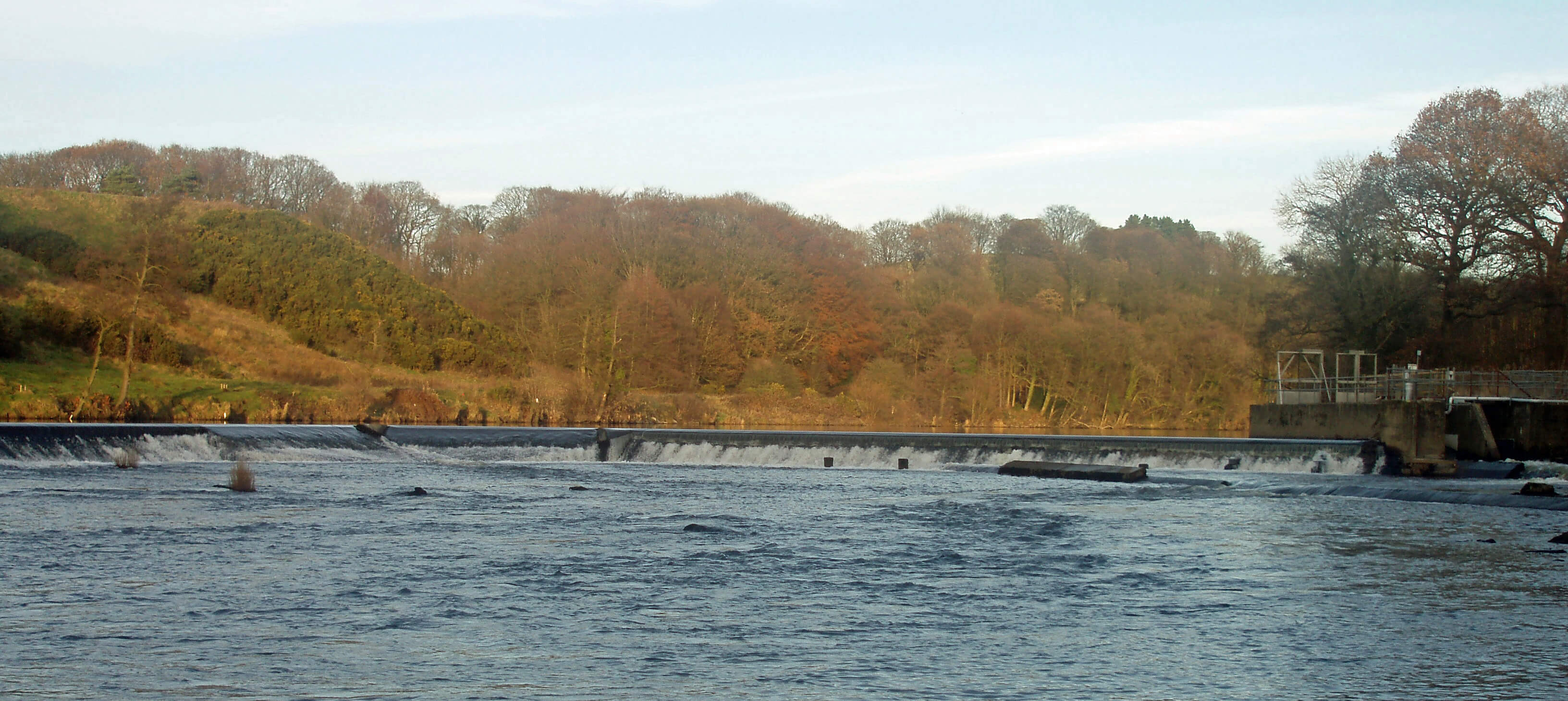 Left: Forge Weir
Left: Forge Weir
All this seems to let the Lune anglers off the hook. Nonetheless,
with so few salmon and so many anglers, I am bound to ask the
question: do the anglers harm the salmon?
Even allowing for the fact that not all salmon pass through the
Forge Weir counter (some leap the weir), it seems that only a few
thousand salmon swim up the Lune each year. Such a small number
of fish needs careful nurturing. I see anglers lining the banks of the
Lune from the estuary up to Tebay. There are several angling clubs
that own stretches of the Lune and its tributaries, as well as many
large estates that fish the river. The total number of anglers must
run into hundreds.
Of course, anglers will dismiss the notion that they are in any
way to blame for the disappearing salmon. For one thing, a byelaw
says that a Lune angler may only kill four salmon a year. Only? If
every angler were to take his share of four there might be no salmon
left. Actually, now that the number of salmon has fallen below the
Lune’s conservation target it is likely that anglers will soon not be
permitted to kill a single salmon. They will be required to catch-and-release fish, that is, immediately return caught salmon to the
river with the least possible injury.
The declared salmon catch for England and Wales in 2012 was
26,297 fish (8,508 caught by net, 17,789 caught by rod).
This was over 10,000 less than the 2007-2011 mean of 36,659. Of the 17,789
rod-caught salmon in 2012, 6,275 were killed. If I have understood
the mass of data correctly, the number of rod-caught salmon on
the Lune in 2012 was 624. This may not sound many but it is still
a significant proportion of the total salmon. Does this volume of
fishing have an effect on the salmon?
I recall a classic experiment that impressed me decades ago [2].
Some perch and some minnows were placed in a tank. Ordinarily,
the perch would eat the minnows but a sheet of glass in the tank
separated the perch from the minnows. After bumping into the
glass a few times, the perch stopped doing so. When the glass was
removed the perch still stayed in their half of the tank. When the
minnows swam to the perch’s end the perch no longer ate them.
I don’t know if this experiment has been replicated or
invalidated but anyway it is now generally accepted that fish are
able to remember and adapt their behaviour on the basis of their
memories. A number of studies have shown that fish form mental
maps (and so can navigate changing environments), recognise
companions, and avoid places where they met a predator or were
caught on a hook. No doubt this applies to Lune salmon too.
One interpretation of the experiment is that the perch feel pain
when they bump into the glass and thereafter seek to avoid it. The
question of whether fish feel pain is, of course, controversial and the
usual groups immediately jump to the expected side of the fence.
According to the RSPCA, “There are a number of studies which
we believe provide enough evidence to show that fish do feel pain
and this remains our view” [3].
The People for the Ethical Treatment
of Animals (PETA) group say “Numerous studies in recent years
have demonstrated that fish feel and react to pain ... Anglers may
not want to think about it, but fishing is nothing more than a cruel
blood sport. When fish are impaled on an angler’s hook and yanked
out of the water, it’s not a game to them. They are scared and in
pain and fighting for their lives.” On the other side, the head
of the Anglers’ Trust, says
“This debate about fish feeling
pain has always been a red
herring, so to speak. Anglers
care passionately about the
protection of fish stocks and do
more than any other group to
protect and improve freshwater
and marine environments” [3].
Caring about fish stocks is
not the same as caring about
fish. Let me explain with
a different example. I once
went to a talk about dragon-flies. It turned out to be about
the photography of dragon-flies. The speaker was more
interested in the photography
than the dragon-flies, which he
knew little about. If dragon-flies were to become scarce he would
be in no position to give advice. If he did so he might be particularly
focussed on photogenic dragon-flies. He no doubt cared about
‘dragon-fly stocks’ but he did not care much about dragon-flies.
Photographing dragon-flies is less harmful to dragon-flies than
fishing salmon is to salmon. I doubt that the typical angler worries
overmuch what a salmon experiences, whether it is pain or not,
when it is hooked or gasping on the bank. It’s possible to care about
fish and fish stocks and not care about fishing. I do, for one.
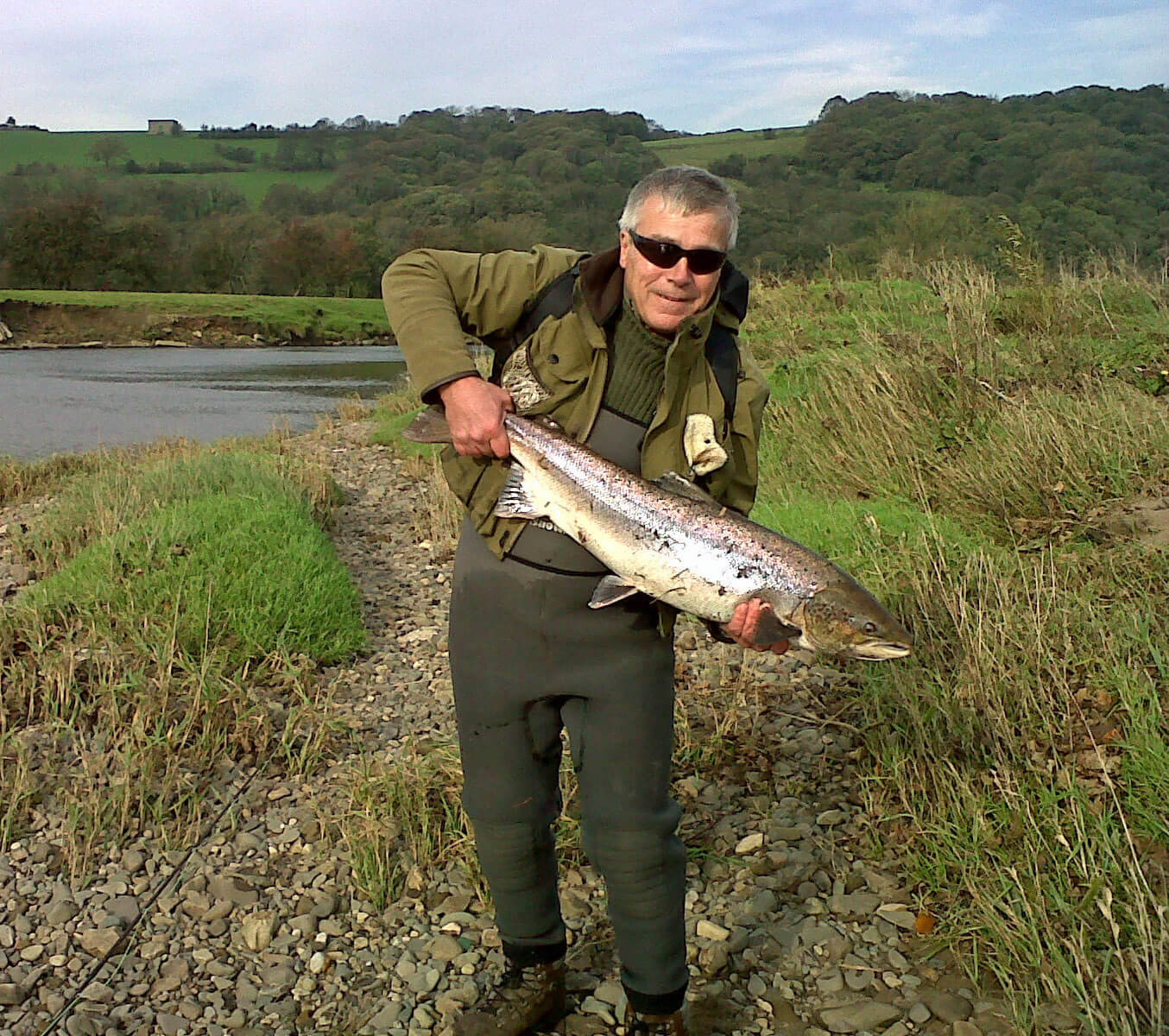 Right: One proud Lune angler; one dead Lune salmon.
Right: One proud Lune angler; one dead Lune salmon.
When there is a contentious topic with entrenched attitudes it is
good to turn to a detached, neutral, scientific view. Unfortunately, in
this case it is hard to find, because researchers are usually funded by
some agency, which may colour their view. For example, Professor
Arlinghaus asserts “Fish do not have the neuro-physiological
capacity for a conscious awareness of pain ... behavioural reactions
by fish to seemingly painful impulses were evaluated according to
human criteria and were thus misinterpreted ... There is no proof
that fish can feel pain” [3].
That sounds authoritative. But he works
for the Leibniz Institute of Freshwater Ecology and Inland Fisheries,
which hardly sounds neutral.
Discussions of the fish-pain question get bogged down in three
ways. First, there’s a philosophical debate about what exactly ‘pain’
is, which leads to the intractable issues of emotion and consciousness.
Second, there’s the question of how, or even whether, we can avoid
anthropomorphising about pain. After all, although I know when
I feel pain, I cannot know about your pain and therefore I have to
project my thoughts onto you - and it is hard not to do likewise for
fish. Third, there’s the neurobiological basis for pain. Are the fish
brain and nervous system so different from ours that it could be
argued that fish are physically incapable of experiencing pain?
However, the fish-pain question is not the one I want to ask.
Reflecting on a salmon’s internal processes, if any, may not help. I
have a more straightforward question: Does the experience of being
fished affect the subsequent behaviour of the salmon?
Before considering this, I’d like to mention the response of a
coalition of concerned angling groups to the salmon crisis.
In 2014 Salmon & Trout Conservation UK
wrote to the government “to demand urgent implementation of
a five point action plan to halt the sharp decline in salmon stocks.”
Yes, demand, yes, urgent. Here is the plan (in brief):
1. The Government needs to speed up action to remove or bypass
barriers.
2. The Government and the water industry need to take the action
necessary to maintain adequate flows in all rivers with stocks
of migratory salmonids.
3. Measures are needed to ensure that farmers follow best practice,
through raising awareness and targeted use of incentives.
4. Funding for river restoration work should be increased.
5. A limit on the maximum number of fish that can be taken in
the North-East coast net fisheries should now be introduced.
These five actions would no doubt be worthwhile but you may
notice that they share one characteristic: they are all actions to be
carried out by someone else, that is, not by anglers. Meanwhile and
thereafter anglers may carry on as always with their sacrosanct
activity. Later, not within the action plan, the coalition does concede
that “on vulnerable rivers the Environment Agency should consider
making catch and release compulsory.” If the salmon situation is
so serious that angling groups must demand urgent action then the
least we might expect of them is that they stop killing salmon.
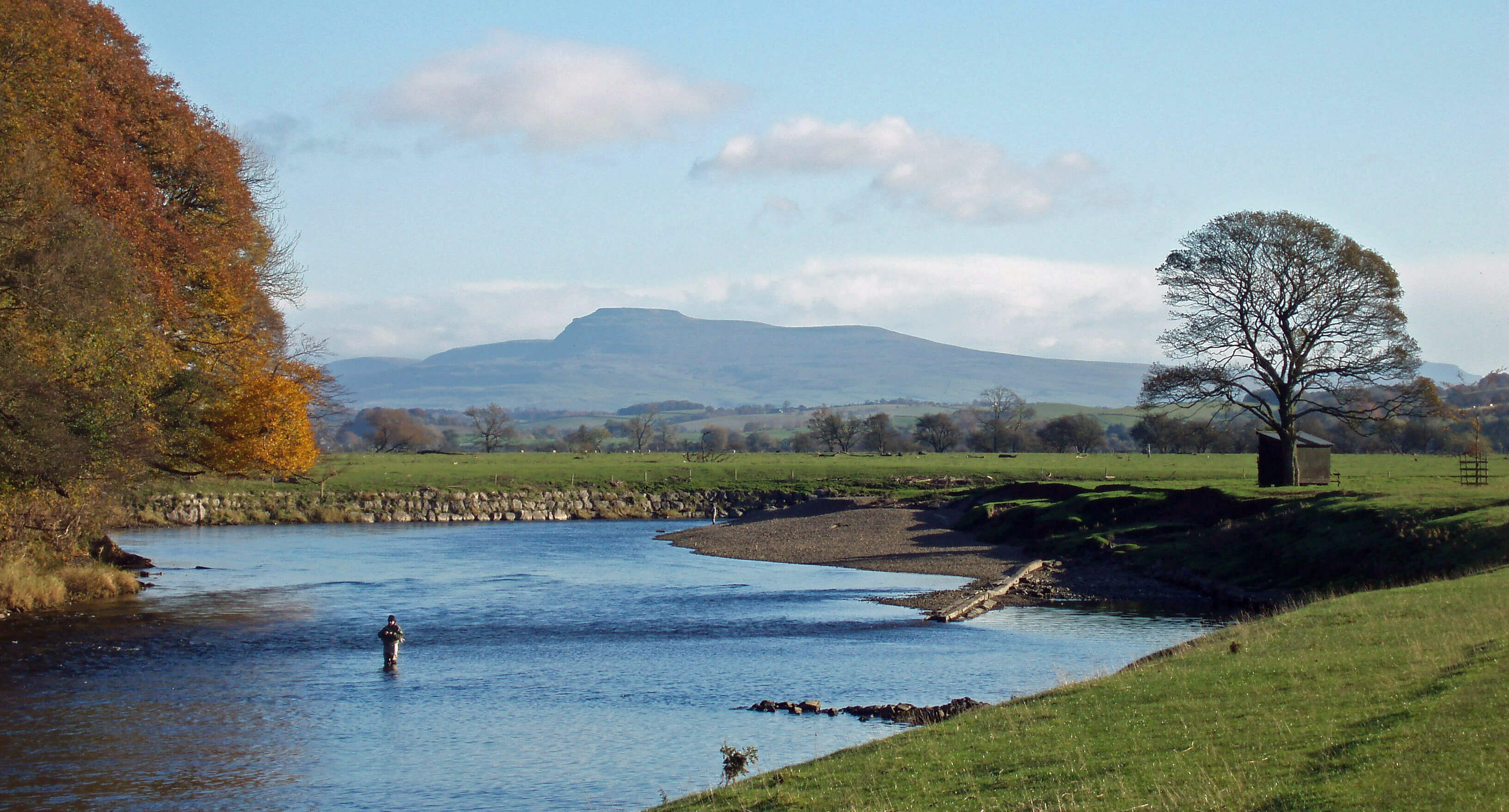 Left: Angler at Aughton Woods
Left: Angler at Aughton Woods
So I will assume that all salmon fishing is, or should be, catch-and-release and on that basis I return to my question: Does the
experience of being fished affect the subsequent behaviour of the
salmon? (It certainly does if the salmon is not released.)
This is a simple question to which I have not been able to find a
simple answer. Left alone, salmon would swim up the Lune where
they wished and would eat what they wished. Does the experience
of being hooked out of the river cause them to avoid places where
they would otherwise choose to be (like the perch in the tank)?
Does the fact that this hooking occurs while they are attempting to
feed make them wary of feeding (like the perch in the tank)?
I did find a Norwegian study that reported that salmon which
had suffered repeated capture, hooking in the throat, bleeding from
a hook wound, increased playing time, increased handling time, or
exposure exhibited increased stress and unnatural behaviour when
released, conditions which have been shown to increase mortality
in other fish species.
If anglers truly cared for salmon then they
would surely not simply deny or ignore such a finding.
A DEFRA report of 2103 said “No data are available
on the mortality of salmon incurred during normal angling
activities” (which is a pity) and “Whilst the use of catch-and-release
is likely to result in some fish dying through exhaustion or damage,
studies have demonstrated that if fish are appropriately handled,
mortality following capture is low and a large proportion of fish
survive to spawn.”
So catch-and-release does harm salmon - but
only to an acceptable (to DEFRA) degree.
Clearly, the salmon situation is at crisis point. Any possible
negative influence ought to be avoided. The angling groups have
insisted upon a legal requirement that any proposed work in or by
a river should be backed up by evidence that it will not harm fish.
It should be the same for anglers, and everyone else. Anyone who
interferes with salmon in any way should be required to prove that
this interference does not have a negative effect upon the salmon.
If angling were not supported by centuries of tradition and by the
‘sporting’ establishment would a proposal for a new activity that
involved yanking salmon out of the river on a hook be approved?
Ten years ago when I had my sandwiches by the Lune near
Newton I was treated to a continuous saltatory display by the salmon.
This autumn, under similar (as far as I can recall) conditions, I saw
only two fish leap. The river seemed silent, moribund. Perhaps
the lack of heavy rain this year has prevented the salmon moving
upstream. I did at least see a kingfisher and a few heron - and
they must have fish to eat, albeit small ones compared to breeding
salmon. No doubt they would eat young salmon, given the chance.
If they are not careful they might appear in an item 6 on the anglers’
action plan.
[1]. Lune Rivers Trust’s annual report (2015). This report does not include
the December 2014 figure so I have added the average December
figure for 2010-2013 to the 2014 total given there.
[2]. Popular Science Monthly (August 1927, p33).
[3]. The Telegraph (13 Jan 2013), Fish cannot feel pain say scientists. (No longer on-line)
32. White Stoats on Caton Moor
January 2016
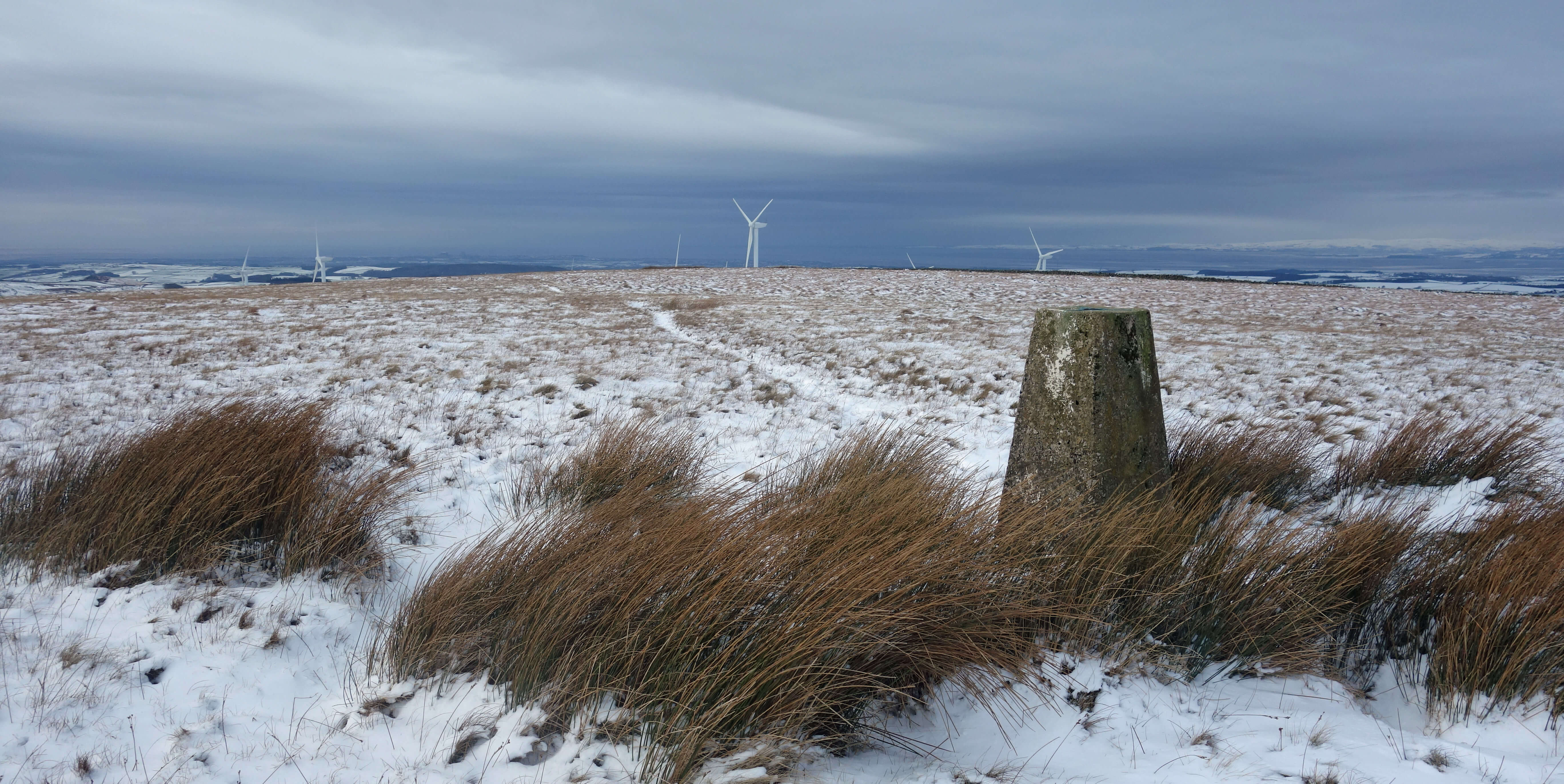 Right: Caton Moor
Right: Caton Moor
You can’t really set out to see a stoat. Stoats are seen by chance,
if they are seen at all. But I had resolved that when the first
snow of the winter fell on Caton Moor then I would set off in
search of a white stoat [1].
By chance I have, during occasional visits in the last 35 years,
seen two white stoats on Caton Moor. I don’t know if I am lucky
to have seen as many as two, or unlucky to have seen only two. I
just don’t know how common white stoats are on Caton Moor. I
have also seen several brown stoats not on snow. I’ve never seen
a white stoat without snow nor, I think, a brown stoat with snow.
These observations, scanty though they are, provoke a number of
questions in my febrile mind.
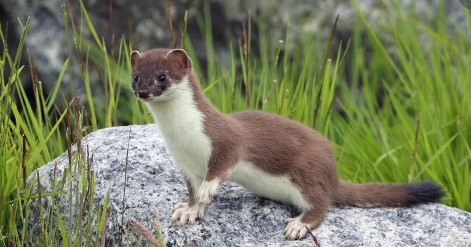 Left: Brown stoat
Left: Brown stoat
As is well known, stoats in places where there is plenty of snow,
such as the Cairngorms, turn white in winter and stoats in places
where there is little snow, such as Dorset, do not turn white. But
how does the mechanism work in intermediate places like Loyne,
where snow is patchy and unpredictable?
What causes the change? Is it in anticipation of snow, or in
response to it? Does it occur gradually or quickly (like human hair
that turns white overnight as the result of some trauma)? Is it an
adaptation to the environment, like that of a chameleon? Does
turning white occur once each winter, or could a stoat turn white,
then brown, then white in response to snowy periods? If you took
a Dorset stoat to the Cairngorms would it turn white? If you took a
Cairngorms stoat to Dorset would it turn white? If turning white is
such a nifty strategy, then do other species adopt it? Do all stoats in
a particular location turn white or do they all not turn white? If not,
why not? Are the numbers of white stoats decreasing, in response
to climate change?
I have found the answers to some of these questions in a book
by Carolyn King and Roger Powell [2].
It seems that the white stoat
provides a pristine case study on the interaction between genes and
the environment.
First of all, some preliminaries. Stoats are members of the
Mustelidae family, which also includes weasels, minks, ferrets,
martens, badgers and otters. The stoat Mustela erminea and weasel
Mustela nivalis are within the Mustela genus of this family. Ermine
is an alternative name for the stoat, usually used for the white stoat
and for its fur.
In the United States, Mustela erminea (our stoat) is called the
short-tailed-weasel and Mustela nivalis (our weasel) is called the
least-weasel or common-weasel. They also have a long-tailed-weasel. In Ireland Mustela erminea
(our stoat) is usually called the
weasel. There are no Mustela nivalis (our weasel) in Ireland. You
could say that there are no weasels in Ireland, but the Irish might
say that there are no stoats. Clearly, outside the UK, the weasel is
not so easily distinguished and the poor stoat is totally confused.
Stoat and weasel have a huge range, across the whole northern
hemisphere from western North America to eastern Asia. Within
that range there are many climatic zones with prolonged snow
cover. Some stoats and weasels live at 3000m in permanent snow.
Snow is not a problem for stoats, as it is for many animals. With
its long, thin, sinuous body the stoat is well-adapted to burrowing
in grass and small tunnels and is therefore equally well-adapted to
burrowing within snow, where it may seek prey, find safety from
predators, and take refuge from the cold.
 Left: Stoat versus rabbit (Brian Stevenson)
Left: Stoat versus rabbit (Brian Stevenson)
A stoat has quite an appetite, needing to eat up to one third of
its body weight every day. This is because it leads such a frenetic
life: it is alert, with rapid movements; its pulse runs at 500 beats per
minute; it digests and defecates within two hours; and it doesn’t
sleep for long.
It can kill rabbits twice its
weight. I once saw a stoat doing
a strange leaping dance beside
a hedge. I then noticed that it
had at its feet a dead rabbit. It
was leaping up trying to get the
rabbit into the hedge but it was
too heavy and the stoat lost its
grip. It eventually succeeded.
On another occasion I saw a
stoat disappear into a stone
wall. I stood by the wall and eventually the stoat popped its head
out, stared at me, squeaked, and went back inside. It repeated this
performance every minute or so. The squeaks became gradually
more threatening so, bearing in mind what a vicious killer the stoat
is, I thought I had better move on.
The stoat does not hibernate in winter. With its slim, fat-free
body, it needs twice as much energy to retain its body heat in
winter as it does in summer. It is therefore essential that the stoat
be adapted to survive harsh winters.
Now we can consider the change to white. Stoats moult twice
a year, in spring and autumn. The new fur, replacing the old, is
brown except for autumn moults in cold climates, when it is white.
The moult does not occur instantaneously and therefore stoats may
be seen at an intermediate brown-white stage. In mild climates
(such as here) the moult can take a month; in the Arctic it takes a
few days.
The moult is triggered by the hours of daylight. This is easily
demonstrated by manipulating the lighting over the cages of captive
stoats. They can be induced to moult at any time of the year, even if
the temperature is not consistent
with the apparent sunlight. In
this respect, the stoat is similar
to other animals that moult.
In the United States it was
found that the boundary between
white and brown winter stoats
was at points where there was
at least one inch of snow for fifty
days of winter. In Britain stoats
whiten in somewhat milder
winters (Caton Moor normally
has an inch of snow for only a few
days of winter). The boundary
line divides Wales, Scotland
and parts of northern England
from the rest of England - but of
course it is not a precise, single
line, as mountain-top stoats are
more likely to whiten than low-level ones. Caton Moor, with a
highest point of 361m, is hardly
a mountain-top.
If the temperature or some
other environmental factor were
the sole determinant then stoats
transferred across the boundary
(say, from the Cairngorms to
Dorset) would turn white or not
according to the conditions in
their new home - but they don’t.
They moult at the usual time but into the ‘wrong’ coat. So the colour
of the new fur is controlled mainly, if not entirely, by heredity.
British weasels do not turn white. Swedish weasels do - or at
least those in north Sweden do while those in south Sweden stay
brown (rather like the British stoat divide). However, the two sets
of Swedish weasels are two different sub-species (the two sets of
British stoats are not). British weasels belong to the same sub-species as the south Sweden weasels. Therefore the reason that
British weasels don’t turn white may be more to do with their genes
and evolutionary history than the climate.
 Right: The lady with the ermine (by Leonardo de Vinci)
This nature study shows that
Italian stoats are considerably
more cuddle-able than British
stoats. Moreover they seem to
turn white, or at least off-white, in
milder climates because the lady is
not suitably attired for an outing on
snowy Caton Moor. (Some experts
believe Leonardo to be mistaken
and that the animal is in fact a
white ferret. Or perhaps Leonardo
was a poor painter of ermine.)
Right: The lady with the ermine (by Leonardo de Vinci)
This nature study shows that
Italian stoats are considerably
more cuddle-able than British
stoats. Moreover they seem to
turn white, or at least off-white, in
milder climates because the lady is
not suitably attired for an outing on
snowy Caton Moor. (Some experts
believe Leonardo to be mistaken
and that the animal is in fact a
white ferret. Or perhaps Leonardo
was a poor painter of ermine.)
The boundary between white stoats and brown stoats is not a
line but a transition zone. Within that zone (which includes Caton
Moor) more or less stoats turn more or less white. Transition zone
stoats are usually pied, rather than fully-white or fully-brown
(actually, fully-white stoats are not fully white: they retain the
black tail tip). This suggests that our stoats are a hybrid of northern
fully-white genes and southern fully-brown genes. The colder or
snowier a region normally is, the more pied stoats there are (and, I
would guess, the more white they are).
In the transition zone female stoats are more likely to turn white
than male ones. Perhaps the gene that determines whitening is
dominant in one sex and recessive in the other. This would ensure
a genetic polymorphism so that the population always has some
individuals with every combination, in which case some will benefit
whatever the weather conditions turn out to be.
 Left: Stoat in ermine
Left: Stoat in ermine
The reason that stoats turn white is obvious. It confers a clear
evolutionary advantage. Stoats have much to gain by being able to
live in snowy conditions but the penalty for being brown against
a white background or white against a dark background is large.
They become much more visible to their predators - hawks, owls
and foxes. Other species, such as the mountain-hare, arctic-fox,
ptarmigan and caribou, also turn white in winter. It is also clear
how this is a self-regulating mechanism. Those stoats that moult to
an inappropriate colour are more likely to be predated and therefore
less likely to pass on their ‘inappropriate’ genes.
I have found no discussion of the effect of climate change on the
transition zone for stoat-whitening - but I would expect the zone to
be moving north. When we came to the region nearly forty years
ago there were ‘ski-orienteering’ events organised on the Howgills.
The organisers could be confident that there would be enough snow.
Today, the odds are that a winter date would see no or little snow
on the Howgills. Ski-orienteers are now more commonly found
further north. I expect white stoats are too.
So my expedition to snowy Caton Moor was made not in the
belief that the brown stoats would suddenly have turned white in
response to the fresh snow. My hope was that, after this exceptionally
mild and wet winter (so far), those stoats unfortunate to have genes
that have turned them white would have sufficient self-awareness
to have hidden themselves away over the last few weeks in order
not to make an easily-predated spectacle of themselves but that,
now that the snow has fallen, they would be gambolling about, in
their element.
Unfortunately, it proved not to be the case. I saw no stoats,
white or brown. On reflection, given the decreasing occurrence of
snow on Caton Moor, I think it unwise for any stoat to turn white
there. I suspect that white stoats have disappeared but I will keep
looking and if I see one I’ll let you know.
[1]. Since my convention (which I recommend) is to hyphenate what are to
others multi-word common names for species, it is clear that “white
stoat” refers to a stoat that is white, not to a species that would be
called white-stoat by me and white stoat or White Stoat by everyone else.
[2]. Carolyn King and Roger Powell (2007), The Natural History of Weasels
and Stoats, Oxford: Oxford University Press.
33. Rhododendron at Kitmere
February 2016
Now that most trees and shrubs are without their leaves it
is a good time to appreciate those that aren’t. I went to
see the rhododendron Rhododendron ponticum at Kitmere, a
small lake five miles north of Kirkby Lonsdale. Here the saga of our
rhododendron is clearly displayed for us.
 Right: Middleton Fell from near Kitmere
Right: Middleton Fell from near Kitmere
Kitmere is an artificial tarn created in the 1880s to provide a
head of water for one of the country’s first hydroelectric schemes at
Rigmaden Park, some 100 metres below on the slopes to the Lune.
Anyone with the resources for such a scheme would naturally
turn the lake into a private leisure amenity, with a boathouse, and
would, as was the fashion, encircle the lake with exotic plants such
as rhododendron, thereby masking the fine views of Middleton Fell
to the east and the somewhat bleaker surroundings to the west.
Rhododendron was introduced into the UK in the 18th century
and was especially popular on country estates, such as Rigmaden.
Rhododendron is a genus of over a thousand species, most of which
have thick, dark green foliage and bright, showy flowers. It is native
to southern Europe and across Asia to China, pausing to become
the national flower of Nepal. It thrives in mild, wet climates on
poor, acidic soils.
When you arrive in search of Kitmere, the first impression is
that there is no Kitmere. It is possible to walk the footpath north
of the lake without being aware of the lake because it is hidden
by high, deep, impenetrable thickets. However, a short trespass
from the east enables the lake and boathouse to be seen and, with a
concentrated effort of mind (ignoring the new wind turbines to the
west), the scene in its prime to be imagined.
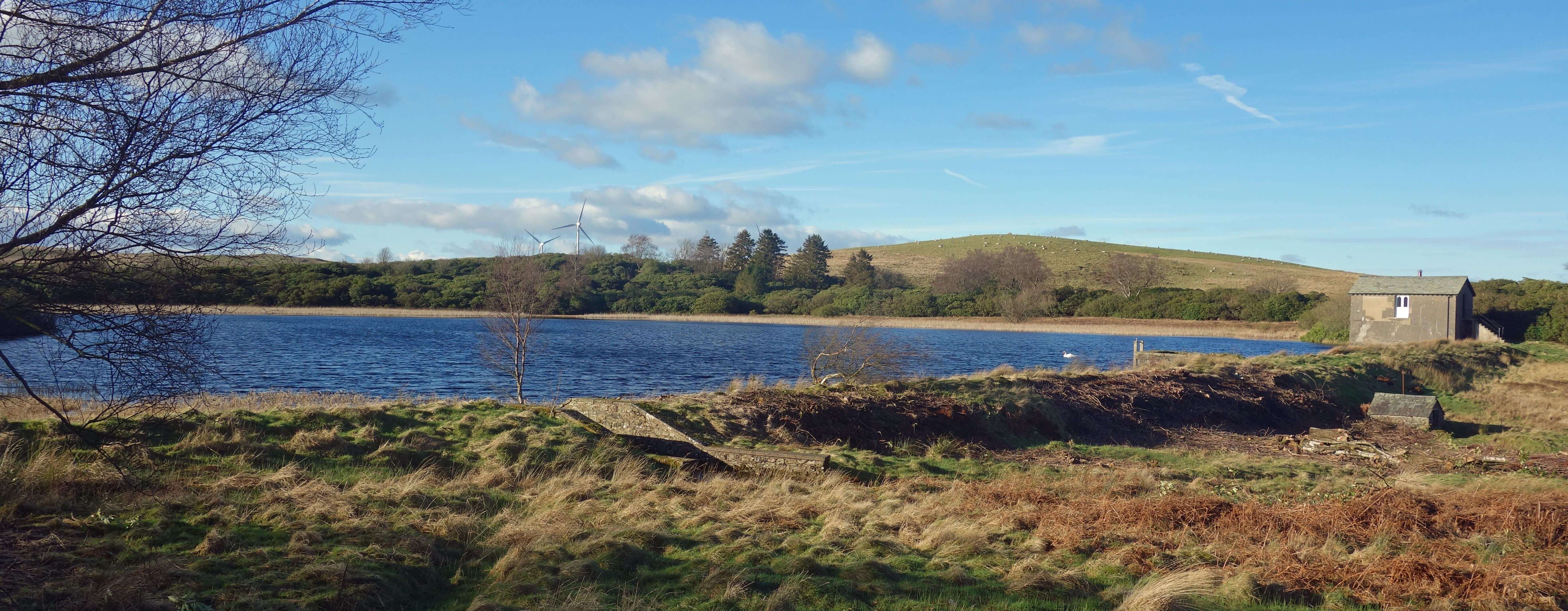 Left: Kitmere from the dam
Left: Kitmere from the dam
Unfortunately, Rigmaden Park, like many country estates, ran
into difficulties in the early 20th century and was left unoccupied
from 1948. No doubt, Kitmere was abandoned to its fate at the same
time, if not before. What we see now, therefore, is the outcome of
letting rhododendron do as it wishes for seventy years or so, or
more.
Rhododendron spreads in two ways, by seed and by rooting from
branches that touch the ground. The original rhododendron was
presumably confined within the boundary wall or fence around the
lake. The effect of seed dispersion can be seen on the surrounding
rough moorland, where shrubs of rhododendron are spreading
outwards from Kitmere. With each flower head producing up
to 7,000 seeds, all the rhododendron around the lake creates vast
numbers of seeds to waft over the moorland every year.
The effect of rooting from branches can be appreciated if you
try to move within the rhododendron by the lake. The stems of the
original rhododendron are all now surrounded by many metres of
thickly interlaced branches, forming an impenetrable barrier almost
around the whole lake. The bushes reach a height of ten metres or
more, with a canopy of the dark leaves letting very little light in.
The natural understory has disappeared. There is insufficient
light and nutrient for the original native plant species to survive. If
there were still any native flowering plants here then they would
have difficulty attracting pollinating insects because they would be
drawn to the blooms of the rhododendron instead. And, as can be
seen, there are, apart from a group of Scots pine at the northeast
corner, no other bushes or trees in or above the rhododendron
canopy, because no seedlings can become established under
it. So, there are very few plants around Kitmere other than the
rhododendron.
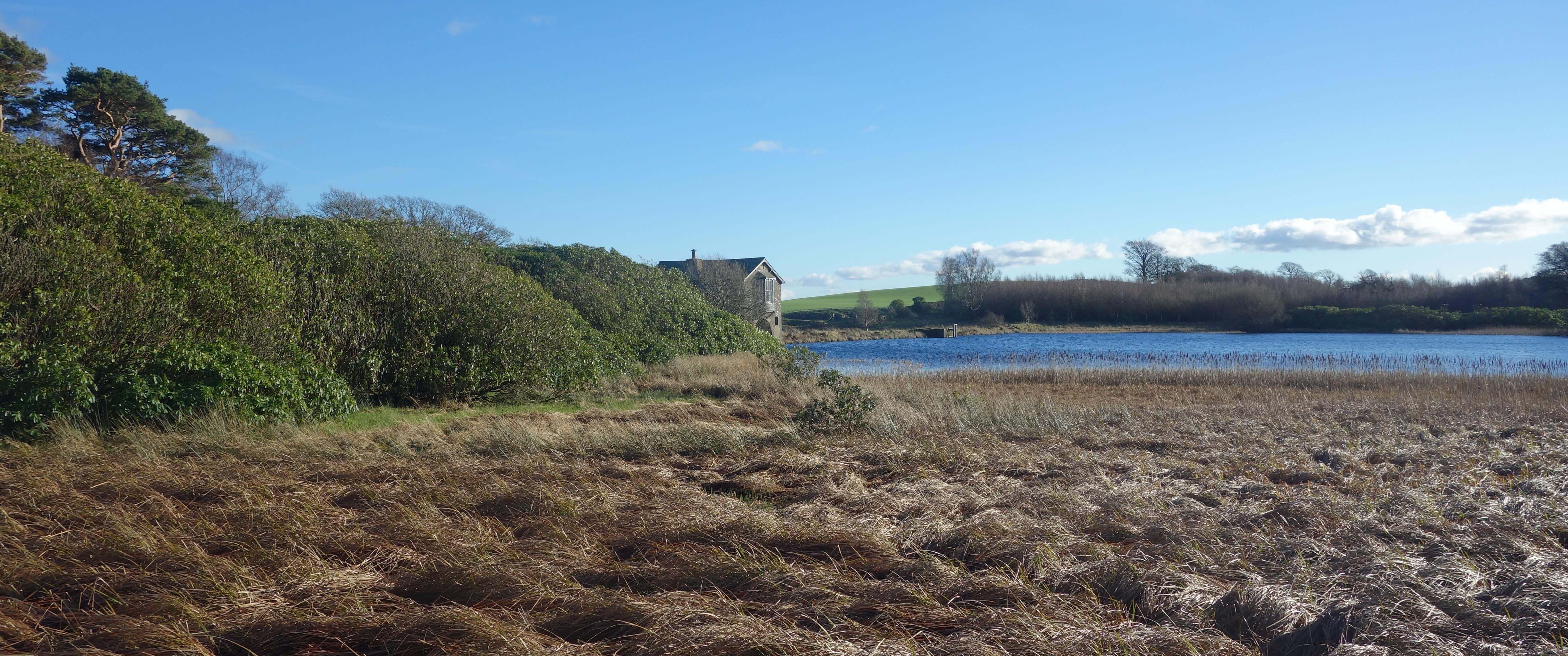 Right: A view of the Kitmere boathouse obtainable only by intrepid trespassers
Right: A view of the Kitmere boathouse obtainable only by intrepid trespassers
Therefore there are very few animal species other than any that
can live off the rhododendron. In a normal old British woodland, we
have mosses and lichens on the ground, with grasses and flowers,
shrubs like hazel and gorse and mature trees such as ash and oak.
Each of these layers supports a range of small species, which in
turn support many larger species. None of them will be found in
the rhododendron thickets. Consequently, there will be few birds
in and above the rhododendron, for there is little for them to feed
upon. (There may, of course, be birds upon the lake: on my last
visit two swans asserted their ownership of the water.)
Rhododendron is toxic to almost all native species and, of course,
since rhododendron is alien none of our species depend upon it.
There is some evidence that this toxicity inhibits the germination
and growth of adjacent plant species. A few insects and herbivores
may try to eat the leaves, and may die as a result, but they are liable
to become toxic for any predator. Rhododendron is extremely
dangerous for horses, although most horses have the sense to avoid
it unless very peckish. It is not so good for us either: people have
become ill from eating honey from bees that have feasted upon
rhododendron.
So, all in all, despite the apparently luxuriant growth, the land
around Kitmere has a very impoverished flora and fauna compared
to native habitats. Essentially, we have a single alien species.
Moreover, if you try to walk around the edge of Kitmere you will
find it impossible to do so because in places the rhododendron
has grown to hang far over the lake. It shades out the edge of the
lake, to the detriment of any life there. As can be imagined, if the
rhododendron were by a flowing beck (as it is in many places in
Loyne) then it would eliminate the native invertebrates that would
otherwise fall into the beck and that fish such as trout depend
upon.
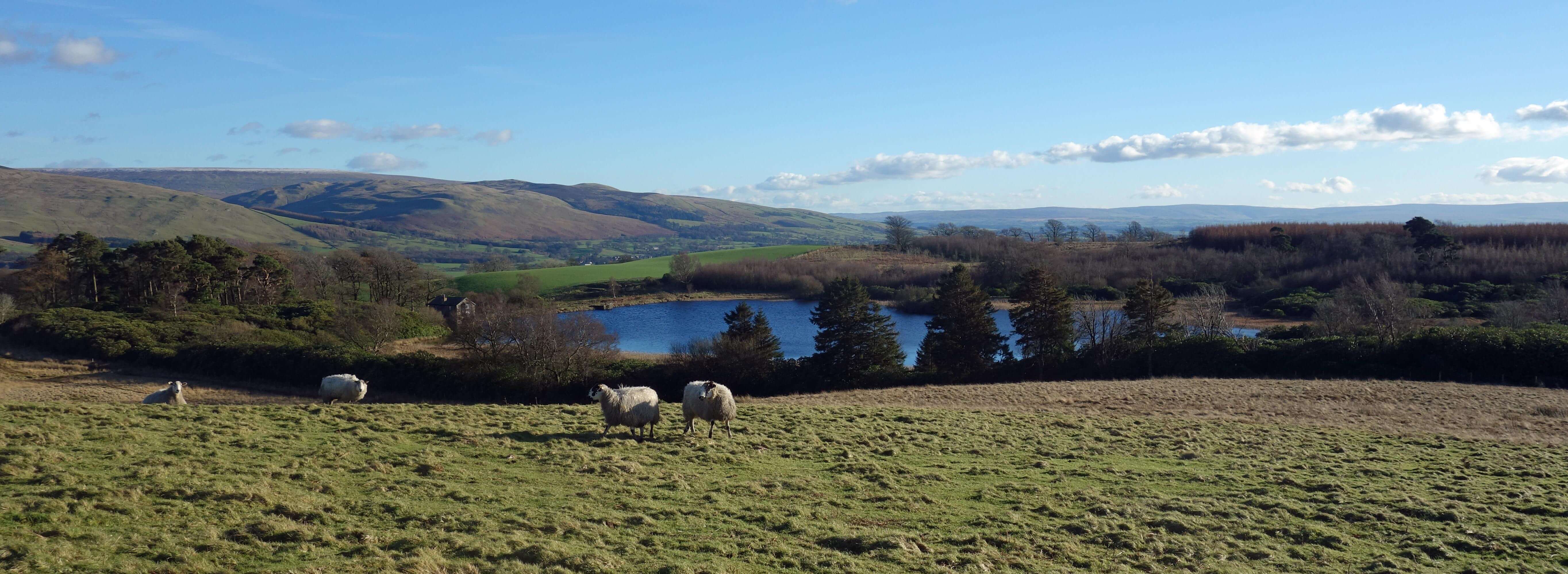 Left: Kitmere from Talebrigg Hill
Left: Kitmere from Talebrigg Hill
The spread of rhododendron cannot be controlled by grazing
animals, such as the sheep on the adjacent moors, as they won’t eat
it. Indeed, the toxic chemicals, such as phenols, are produced most
by the young leaves, which protects growing rhododendron from
herbivores. The leaves themselves are coated in a sticky exudate to
deter small insects from eating the buds. Mature rhododendron is,
of course, rather tough for chewing.
To get rid of rhododendron we must therefore do it ourselves
(and it serves us right for introducing it). Herbicides are of little
use as, even if they can get into the waxy leaves, they do not
satisfactorily penetrate the vast root systems, from which new shoots
will appear. We just have to dig the stuff out, using mechanical
diggers, if possible. We have to dig all of it out, including from the
surrounding moors, or it will return from any remaining roots. It
will return anyway, from some of the millions of seeds in the soil,
and therefore the rhododendron must be re-removed for several
years. The toxic cuttings and humus layer must, of course, be
cleared away.
At Kitmere there has been some recent cutting and burning of
rhododendron near the lake’s dam but this can only be a temporary
measure. Otherwise, there is little sign of any attempt to eradicate
the rhododendron. Rigmaden Park itself was renovated and re-inhabitated in the 1990s and I assume that the estate still owns
Kitmere. As rhododendron is listed under the Wildlife and
Countryside Act of 1981, it is an offence to plant or otherwise cause
this species to grow in the wild. Perhaps it should be an offence to
allow it to spread further in the wild.
Kitmere and its rhododendrons are in an out-of the-way location.
Out of sight, out of mind, perhaps. But not entirely. In the recent
discussions about extending the Dales National Park westwards,
the proposal was to make the new boundary lie along the Lune’s
western watershed, more or less along the Old Scotch Road. This
would have included the Kitmere rhododendrons. The National
Park didn’t want them, and I don’t blame it.
34. Lapwings on Swarth Fell
March 2016
After a few months hunkering down in the Loyne valleys
in order to avoid the icy blasts over the hill-tops, it is time
to begin frolicking in the brisk moorland sunshine. The
lapwings agree with me. Some of them have begun their move
up towards their breeding grounds. They are still silent, however.
Indeed, the moors are eerily quiet at the moment, with only the
occasional curlew attempting a tentative warble.
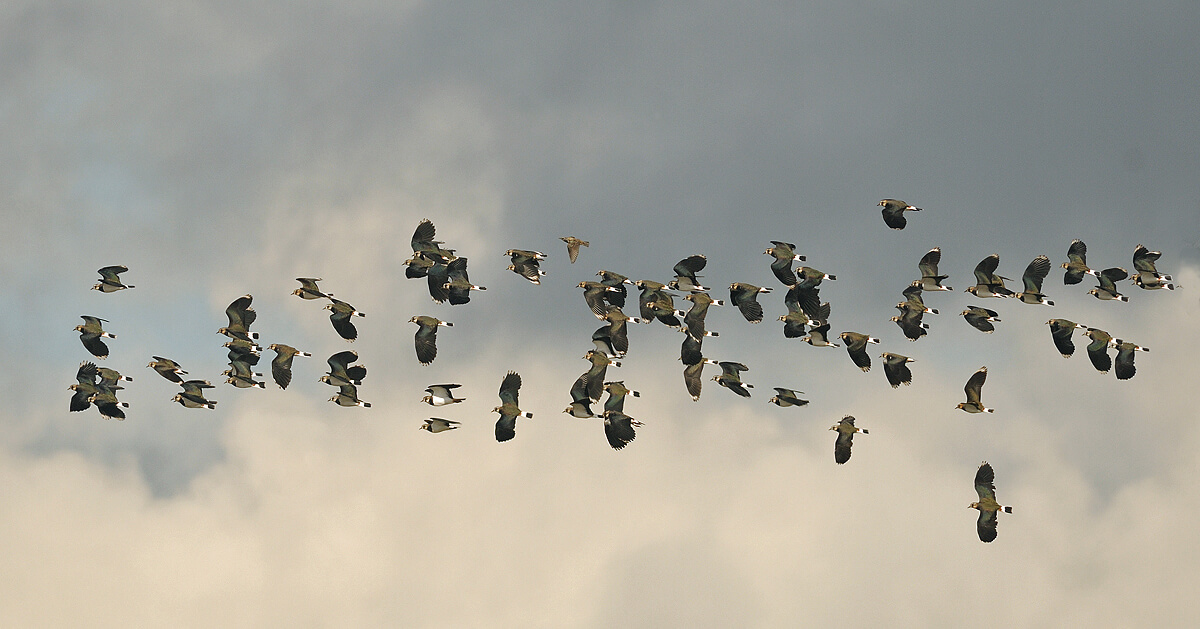 Left: Lapwings (Jackie Moreton)
Left: Lapwings (Jackie Moreton)
In the winter months lapwings (more properly, Northern
lapwings Vanellus vanellus, and also called peewits or green-plovers)
congregate in large numbers on the Lune floodplain and around
Morecambe Bay. They sometimes swirl around in ominous, silent
clouds, all black, it seems, until they tilt as one to show their white
undersides.
These lapwings are not necessarily the ones now moving onto
the moors. In the winter most lapwings migrate south, some as
far as Africa. Most of our winter lapwings have arrived here from
further north. I assume that lapwings, like most birds, breed in the
same region every year and that most of the lapwings that I see on
the moor now have recently returned from their winter travels.
I am puzzled why the lapwing is a bird of ill-repute. It always
seems an exuberant bird to me, especially in spring, with its
playful, tumbling aerobatical exhibitionism and its humorous call
that always reminds me of those old birthday ‘party blowers’ (that
unravelled like an absurd lizard’s tongue). The lapwing certainly
doesn’t look menacing, with its elegant crest and attractive bottle-green and
iridescent purple colourings - although I admit that it is
quite fearsome in its swooping attacks to defend its nest.
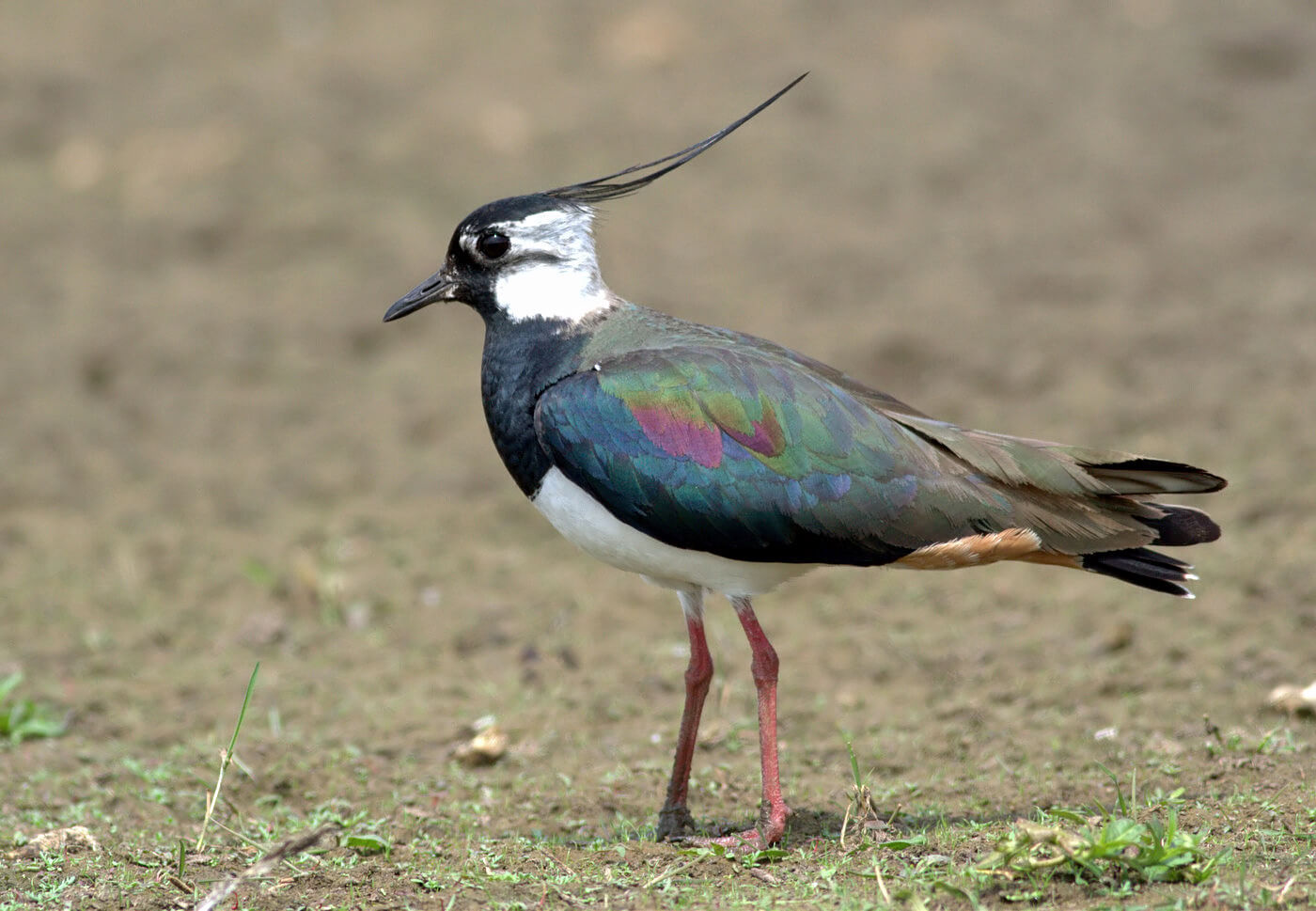 Right: Lapwing (Neil Rolph)
Right: Lapwing (Neil Rolph)
A flock of lapwings is called a ‘deceit’ but whether that name
preceded or followed their reputation I don’t know. Peter Tate
records a number of myths relating to the lapwing [1].
One story has
the lapwing, along with the stork and swallow, appearing at the
crucifixion of Jesus. The stork cried “Strengthen him! Strengthen
him!”; the swallow tried to remove the thorns from his crown;
but the lapwing flew around shrieking “Let him suffer! Let him
suffer!”. Naturally, the stork and swallow were duly blessed but
the lapwing was condemned for eternity.
A Swedish tale has a handmaid to the Virgin Mary caught
stealing some scissors and, as punishment, turned into a lapwing
with a forked tail that looked like it had been snipped by scissors and
compelled to cry “Tyvit, tyvit” (“I stole, I stole”). A Danish story has
a greedy woman who angered Jesus turned into a lapwing, doomed
to weep between heaven and earth forever. A Russian myth has the
lapwing refusing to obey God’s order to carry water to fill the lakes
and rivers at Creation time and as a result being compelled to drink
from puddles rather than lakes and rivers. Apparently, in rural
areas of Britain it used to be believed that lapwings were the souls
of the dead who remained on earth because something troubled
them. Chaucer’s poem of 1382 The Parliament of Fowls refers to “the
false lapwing, ful of trecherye”.
So, overall, the poor lapwing was not a bird regarded with
any fondness. Two of Shakespeare’s characters are disparaged
as lapwings. In Comedy of Errors he writes “far from his nest the
lapwing cries away”, which refers to the lapwing’s practice of
pretending to trail a broken wing to distract predators away from
the nest. And in Hamlet “this lapwing runs away with the shell on
his head” alludes to the fact that lapwing chicks leave their nest
much more promptly than other birds.
Clearly, Shakespeare assumed that his audience knew about
lapwings. Today’s audience would probably be flummoxed by such
similes. All most of us know about lapwings is that there aren’t so
many of them as there used to be. At least, southern ornithologists
bemoan that it is so. There, the low meadows that once thronged
with lapwing are now empty of them, because modern farming
practices have destroyed their former breeding sites. Since 1960
lapwing numbers in England and Wales are thought to have
declined by 80%, which places the lapwing on the Red list.

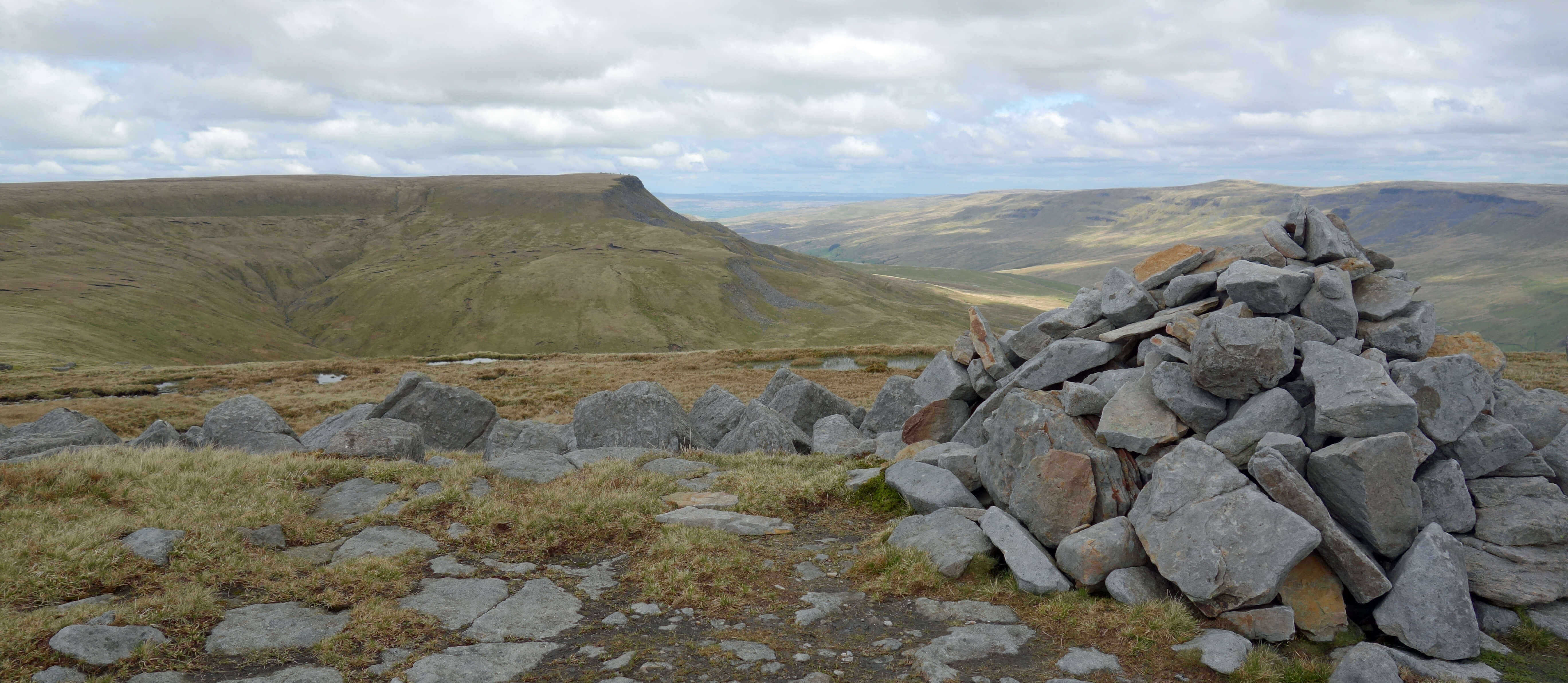 Left: Lapwing eggs
Left: Lapwing eggs
Right: Swarth Fell northern cairn, looking to Wild Boar
Fell and Mallerstang
Here in the north, however, the numbers of lapwing seem to be
holding up, although perhaps lowland farming has driven them to
nest higher on the moors. I’d expect that lapwings that nest on the
top of our mountains do so later in the year than lowland nesters.
Last year, in the middle of May, I came across a lapwing nest, with
the usual four eggs arranged neatly with their pointy ends inward,
at 670m on Swarth Fell, south of Wild Boar Fell.
Lapwings’ eggs were considered a delicacy in Victorian Britain.
In Brideshead Revisited Sebastian Flyte’s refined world is captured
by a scene describing the peeling of lapwing eggs sent to him by
Lady Marchmain, for whom the lapwings obligingly laid their eggs
early. But lapwing eggs were not a delicacy just for the rich. Paul
Evans mentions that in 1845 a single egger in Norfolk gathered
nearly 2,000 lapwing eggs in one day [2].
Which prompts a question:
which disappeared first, the lapwing or the egg?
The Lapwing Act of 1926 made it illegal to gather lapwing eggs
but in any case I felt no impulse to sample the eggs I found on
Swarth Fell. I, for one, wish the lapwing parents well.
[1]. Peter Tate (2009), Flights of Fancy: Birds in Myth, Legend and Superstition,
London: Random House.
[2]. Paul Evans (2015), Field Notes From The Edge, London: Rider.
35. Belted-Beauty-Moths at Sunderland Point
April 2016
Nature imposes humility upon its observers. I have noticed
that wildlife writers, experts though they are, rarely consider
themselves expert enough. They often seek advice or help
from those who are even more expert.
For example, the authors of recent books about butterflies, otters
and birds, when they want to see a white-letter-hairstreak, or otters
in the Somerset Levels, or a stone-curlew, they do not just set off in
the hope of doing so [1, 2, 3]. They contact a local or national expert on
white-letter-hairstreaks, otters, or stone-curlews and persuade him
or her to lead them to the best spot.
This could be because professional authors do not have the time
to waste on fruitless searches - unlike me, for whom the search,
whether successful or not, is part of the point of the exercise. Of
course, I would like to see a stone-curlew but there seems little
satisfaction or achievement in just being taken by an expert to see
one. It’s not much better than just looking in a book or on Youtube.
It had not occurred to me before to pester an expert to lead me to
Geyer’s-whorl-snail, to marsh-gentians and so on, but then you do
need a threshold level of competence before the expert will not tell
you where to go.
The real reason that authors seek help is that they recognise that
the natural world is so broad and complex that a ‘generalist’ cannot
possibly have the depth of knowledge that a specialist has acquired
after a lifetime’s focussed study. The Swedish entomologist Fredrik
Sjöberg writes eloquently about how a person can become focussed
upon, obsessed even, with a tiny part of the natural world [4].
He himself is a world-recognised expert on Swedish hoverflies. When
I say ‘world-recognised’ I mean recognised by the score or so people
in the world who are interested in Swedish hoverflies. The other
7.4 billion minus a score or so of us are perplexed that anyone can
find Swedish hoverflies so fascinating, as Sjöberg is well aware.
The obsession may arise because of a professional necessity
to find a niche within which to establish a reputation by means
of academic papers. These papers are, of course, read only by a
score or so. A whole book on Swedish hoverflies would not be
read by many more - unless it is turned into a wry philosophical
study of “finding happiness in the little things”, in which case it
may become a bestseller. But really the obsession derives, as with
physical exploration, from a desire to discover the unknown and
to establish some mastery over a necessarily tiny domain, such as
hoverflies on a small Swedish island.
I did not ask for help to see a belted-beauty-moth Lycia zonaria.
I had read that a group of lepidopterists planned to carry out their
annual survey of belted-beauty-moths at Sunderland Point so I
arranged to just happen to be there at the time.
The belted-beauty-moth is one of England’s rarest moths with
the colony at Sunderland Point thought to be our only remaining
healthy population. It was first found here in 1975. Occasional
moths were recorded in later years but it was not until recently that
the size of the colony was established. The peak count was over
1,500 moths but more normal totals are around 200.
At Sunderland Point the moth is attempting to survive on a
saltmarsh whereas in other countries it breeds in sandy coastal
areas. The moth has disappeared from other English sites because
of coastal construction and, so as not to be out of step with this
tradition, here at Sunderland Point an energy company has obtained
approval for taking its wind-turbine cables through the site. By
tagging along with the lepidopterists I hoped to have a perhaps
final opportunity to see a belted-beauty-moth in our region.
The name of the belted-beauty-moth suggests that it is a rather
fine moth, as moths go. These particular moths don’t go far. The
female belted-beauty-moth doesn’t fly at all. It is therefore to be
found on the ground or on plants or posts. The male belted-beauty-moth
does fly but not very far if it’s got any sense, as it won’t find
any females further afield.
Below: Belted-beauty-moths (male, left; female, right) (Tim Melling)
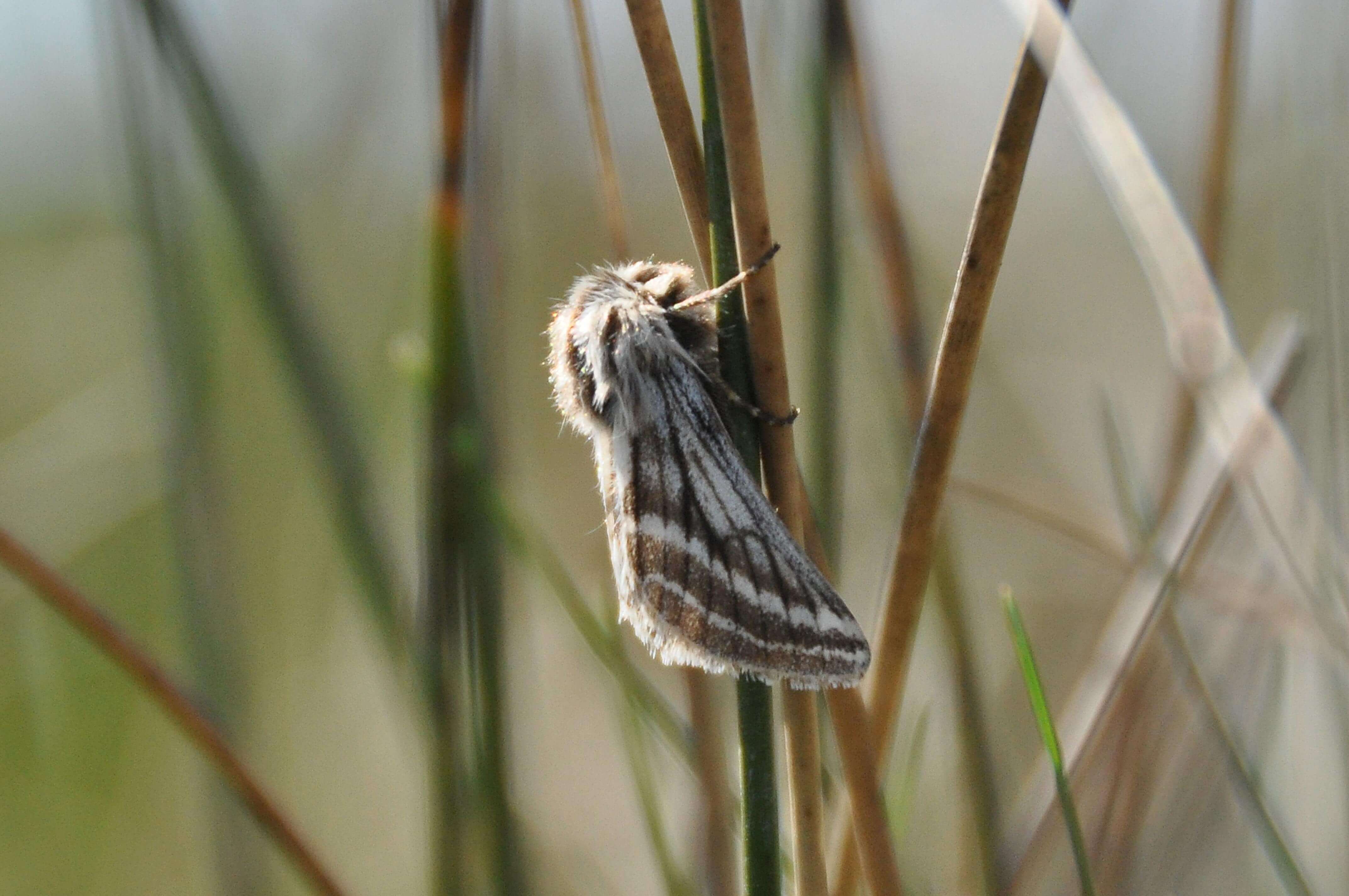
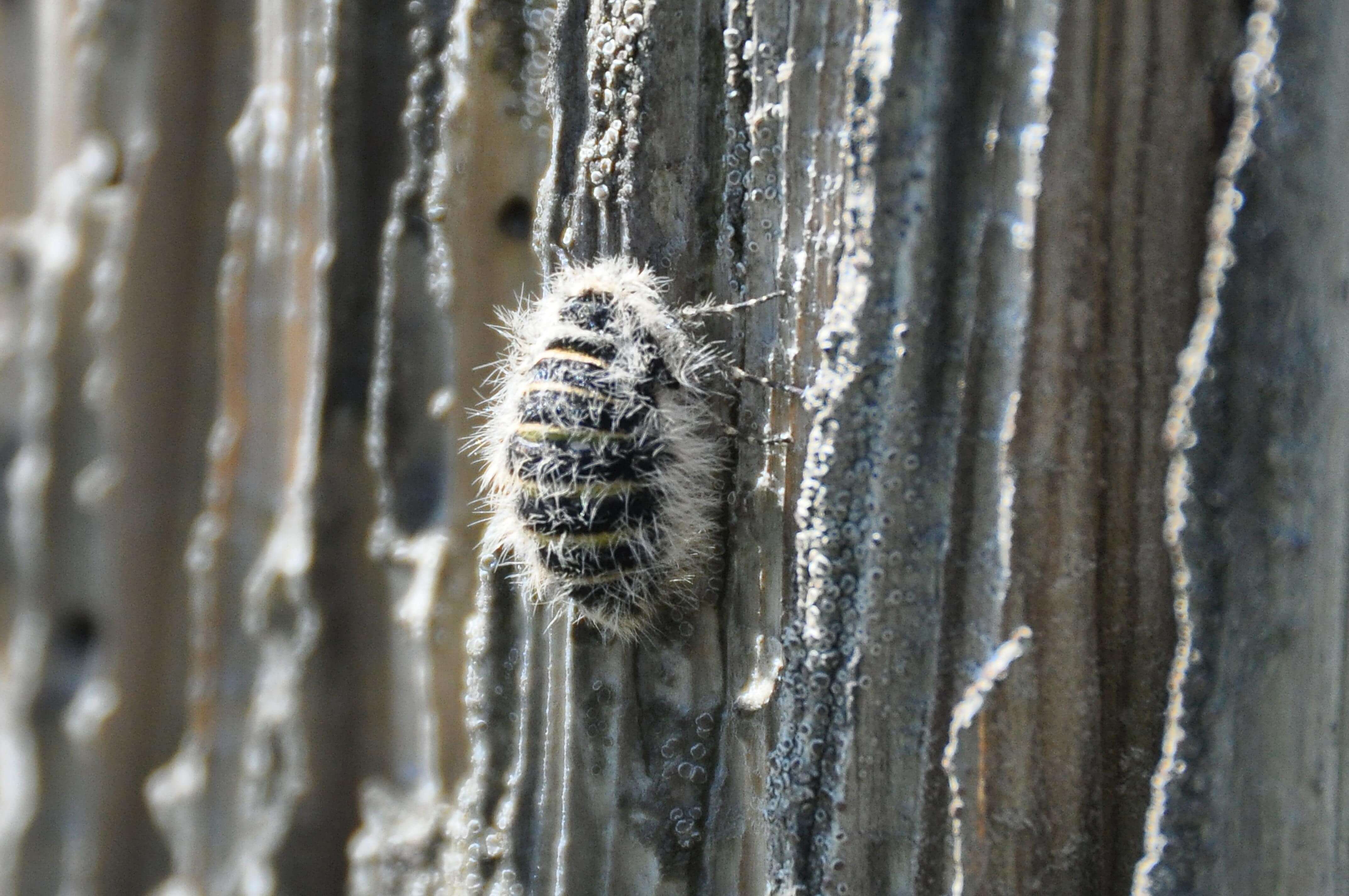 I have had little success in the past identifying moths. Whenever
I have tried to look one up in the catalogue there always seemed
to be too many moths and not enough differences. However, the
belted-beauty-moth looks fairly distinctive. It is a small, dumpy
moth, the males being triangular with grey and pale brown stripes
and the female being oval, dark grey with narrow horizontal stripes.
If there were any to be found, I was optimistic that my new friends
would find them.
I have had little success in the past identifying moths. Whenever
I have tried to look one up in the catalogue there always seemed
to be too many moths and not enough differences. However, the
belted-beauty-moth looks fairly distinctive. It is a small, dumpy
moth, the males being triangular with grey and pale brown stripes
and the female being oval, dark grey with narrow horizontal stripes.
If there were any to be found, I was optimistic that my new friends
would find them.
The sun had evaporated the frost from the lawn by the time
I set off for Sunderland Point but the nip in the air would not, I
feared, encourage the moths to venture forth. From Potts Corner I
could see the moth-hunters dotted about the marsh, hunched over
like figures in a Lowry painting as they peered and poked into the
grasses. My first thought was that this was the very area where
on my last visit (Chapter 29) I had seen cows rampaging over the
marsh. I wonder how many belted-beauty-moths the cows munch
and trample.
 Right: Moth-hunters at work
Right: Moth-hunters at work
I edged closer to the moth-hunters but they seemed so earnest
and intent in their searches that I did not intervene. I strolled further
south and then returned on the seaward side of the marsh, the tide
being far out.
I asked a young lad - the
only young person in the group
- if he had seen any moths.
“Only one, a female” he replied,
a little grumpily, I thought, and
wandered on. He stopped after
two yards, exclaiming “here’s
another one”. I joined him to
have a close look.
The female belted-beauty-moth is not (to me) the most
impressive specimen. Having
no wings, it looked like a
bundle of grey fluff. I am
tempted to say that it reminded
me of what I find in my belly
button but that would suggest
that I don’t bathe often enough.
I did my best to pay due respect to this very rare (in England, at
least) moth.
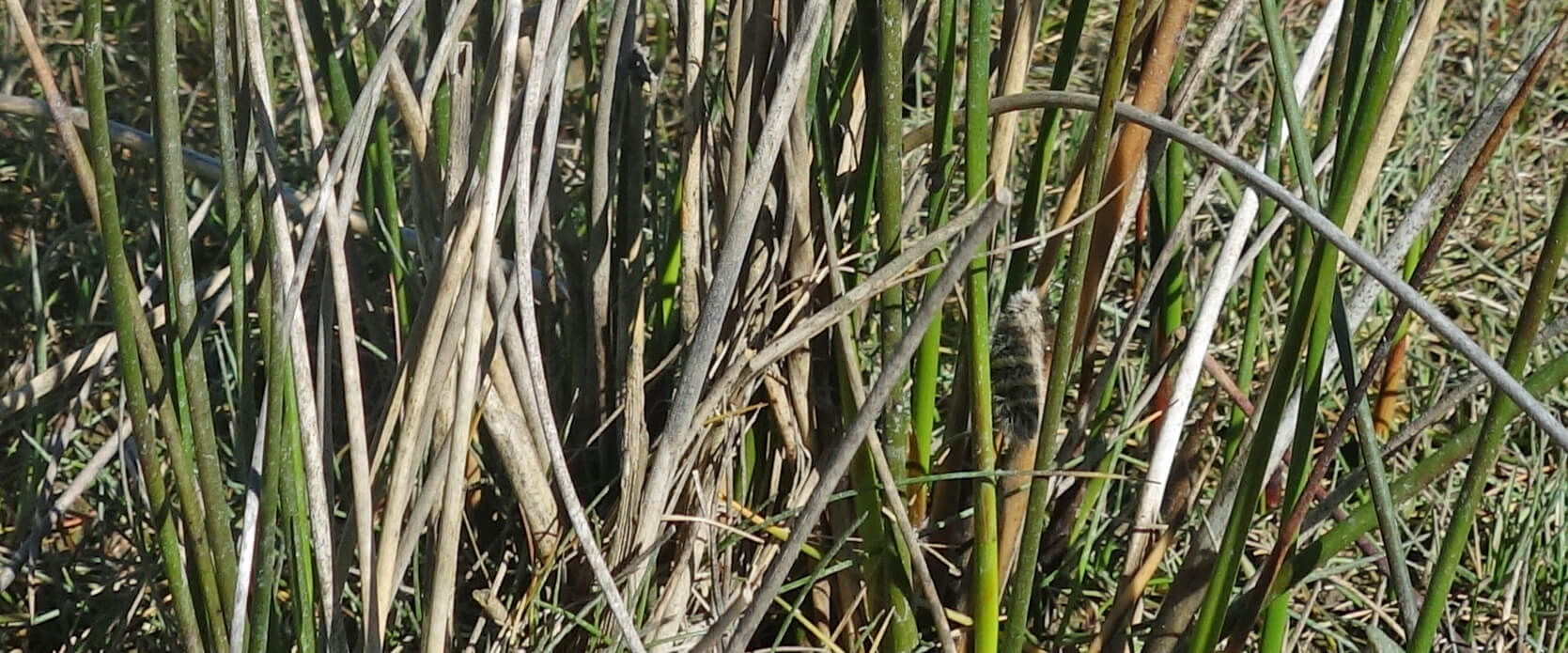 Left: My first belted-beauty-moth
(included only to show how hard
they are to find - it’s about halfway up, one-third in from the right).
Left: My first belted-beauty-moth
(included only to show how hard
they are to find - it’s about halfway up, one-third in from the right).
After a while the lad wandered on and within another couple
of yards he’d found another one. It was clear that my presence was
having a beneficial effect upon the search, so I mingled among the
other moth-hunters, to give them a hand too.
I had gained the impression that the female belted-beauty-moth
was a second prize. It was the male belted-beauty-moth that the
moth-hunters preferred to find. I suppose that, with wings, at least
it looks more like a moth. I asked a lady moth-hunter, a regular on
these surveys, if she often saw the male belted-beauty-moth flying,
as that would make it easier to observe than all this peering into the
long grass. She said “I’ve only ever seen one flying - and that was
snaffled by a bird”.
The moth-hunters continued in near silence. I don’t think
they were finding many moths. Occasionally, there would be a
gathering, including the photographers among the group, where I
assume a male had been found. I didn’t join them. Thanks to the
lady, my attention had drifted to the birds, for there were plenty
of them, with the skylarks in particularly frisky form. I left the
intrepid moth-hunters to it.
An activity such as this prompts the question: Why is it
important to save the belted-beauty-moth at Sunderland Point?
There are about 160,000 species of moth. Would just one of them
really be missed? In any case, we are not talking about saving the
moth from extinction because there are plenty of belted-beauty-moths elsewhere in the world.
Many of the reasons given for protecting species do not, it seems
to me, apply to our belted-beauty-moth. The belted-beauty-moth
is not an iconic species, such as the black-rhino, which, if it were to
disappear, we would regret and perhaps feel ashamed about, since
we would have been the cause. Very few people appreciate the
belted-beauty-moth. Hardly anyone living in Loyne even knows
that it exists at Sunderland Point - indeed, nobody did until recently.
It therefore contributes very little to our own sense of well-being.
But it is not there to please us. Nor is it there to provide us
any other service (such as providing food or medicine), which
conservationists claim is or may be the case with other disappearing
species. I am not aware that belted-beauty-moths serve any other
species either. As the lady moth-hunter indicated, birds eat them
but I doubt that belted-beauty-moths form an essential part of any
bird’s diet. It is sometimes said that all species form a crucial part
of the complex natural world that we do not fully understand and
that if any component disappeared then the whole eco-system may
become vulnerable as the links between food chains became broken.
I would need convincing that the Loyne eco-system would collapse
without the belted-beauty-moth.
I think we are left only with ethical arguments: the will to protect
nature demonstrates the value of a society; if we cannot save other
species perhaps we won’t be able to save ourselves; we do not have
the right to eliminate species that future generations might like
to see; all species are a part of nature and have a right to survive.
Much more could be said but I fear that I will not be persuaded,
in the case of the belted-beauty-moth of Sunderland Point. In the
past many millions of species have, despite their ‘right to survive’,
disappeared (from a particular region or from everywhere), and
relatively few of them because of us. It is a natural process that
species disappear.
It is, I expect, the fate of the belted-beauty-moths at Sunderland
Point to disappear. This is not to say, of course, that we should
knowingly eliminate them by, for example, laying wind-turbine
cables across their domain unless, after due consideration, it is on
balance thought right to do so. I just suspect that the colony is too
small and fragile to survive and, although I know I shouldn’t admit
it, I won’t lament its loss overmuch. Sadly, I have not yet acquired
the humility of a true wildlife conservationist, for whom every
single species is special.
[1]. Patrick Barkham (2010), The Butterfly Isles, London: Granta.
[2]. Miriam Darlington (2012), Otter Country: In Search of the Wild Otter,
London: Granta.
[3]. Charlie Elder (2009), While Flocks Last, London: Corgi.
[4]. Fredrik Sjöberg (2014), The Fly Trap, London: Penguin.
36. Bluebells on Middleton Fell
May 2016
The Peregrine (1967) by J.A. Baker is often named as the best
nature book of the 20th century [1].
I cannot say whether it is in
fact the best but I can say that it is one of the strangest.
Ten years of diligent observations within a small region of Essex
were presented as if they were made within a single October-to-April period.
This creates the impression that Essex was a teeming
cornucopia of wildlife, with owls asleep in every other tree and
peregrines a-plenty to gaze upon. Anybody with the observant eye
of Baker who repeatedly patrols the same patch will learn where
the owls sleep and the peregrines fly, and will therefore see much
more than the casual observer. Even so, anybody who sets out in
search of wildlife knows that it is elusive and secretive. Anything
rare, such as a peregrine in Loyne, is naturally hard to find and
sensibly so, as otherwise it would become rarer still.
Baker spent many years drafting, re-drafting, polishing
and re-polishing the text of The Peregrine. He also wrote a second
book The Hill of Summer (1969), which is less highly regarded but
similarly presented precise observations in a lyrical style. It is not
often that an author presents a masterpiece (or two, if you wish)
and very little else. It is like a composer writing a symphony (or
two), carefully labouring over every single chord for many years in
order to get everything just so, without bothering with trifles such
as overtures, suites, rhapsodies, tone-poems, and so on.
A particular aspect of Baker’s style has been revealed by a
study of his drafts. It seems that he kept a count of the number of
metaphors and similes on every page. It is not known why he kept
this count. He may have had a target in mind for the number of
metaphors and similes on the page in order to achieve his desired
style. Or perhaps he had a threshold that he wanted to ensure
that he didn’t cross, to avoid the text appearing too flowery. At all
events, it is apparent that Baker felt that metaphors and similes
were crucial to the literary effect that he sought. The outcome is
a dense, allusive text that causes the reader to pause after almost
every sentence to reflect upon the metaphors and similes within.
Why were metaphors and similes so important to Baker,
and perhaps to all nature-writers? The Peregrine includes dozens of
descriptions of the peregrine and its flight. An unadorned factual
account might be interesting enough but not on the umpteenth
reading. It needs to be embellished afresh each time, preferably
with an insightful new perspective.
So, the peregrine (a bird with “blue-grey upperparts and dark
blue wings and head” as blandly noted in the RSPB handbook) has,
in three successive sentences of Baker, a head “like a hooked
pike glaring from reeds”, bars on the head “like strips of polished
leather” and eyes that glinted “like wet flint” (p103). And the
peregrine swoops “like a falling head, a shark’s head dropping
from the sky” making a sound “like the wind harping through
high wires” (p154). The flight of the peregrine, as with much else
in nature, cannot be adequately conveyed by a mere description
(just as attempts to capture the bouquet of wines have to resort to
metaphors and similes).
It is, then, part of the nature-writer’s art to find piquant
metaphors and similes for aspects of nature for which a factual
description is inadequate or impossible. It is not a skill that I have
sought to develop although I can appreciate its difficulty. Imagine
seeing, say, a magpie, and try to think of an original metaphor or
simile that would enliven its description.
In the case of the bluebell it is perhaps an unnecessary skill
because the name itself is a metaphor, as it is for many plants
(arrowhead, bird’s-foot, cigar-flower, dragon’s-teeth, eyebright,
flaming-sword, ghost-tree, hart’s-tongue-fern, iron-cross-begonia,
jacob’s-coat, kingfisher-daisy, lipstick-plant, monarch-of-the-east,
necklace-poplar, old-man’s-beard, parrot’s-bill, queen-of-the-night,
red-hot-poker, sunflower, trumpet-gentian, umbrella-pine,
velvet-plant, wedding-cake-tree, yellow-kangaroo-paw, zebra-plant).
Generations of poets and writers have extolled the virtues
of Britain’s best-loved flower, the bluebell. It is pointless for me to
strive to find a metaphor that nobody has previously thought of in
order to say something new about such a familiar flower.
Instead, I have two questions to ask. First, how come the
bluebell turns the lower slopes of Middleton Fell such a startling
blue in May?

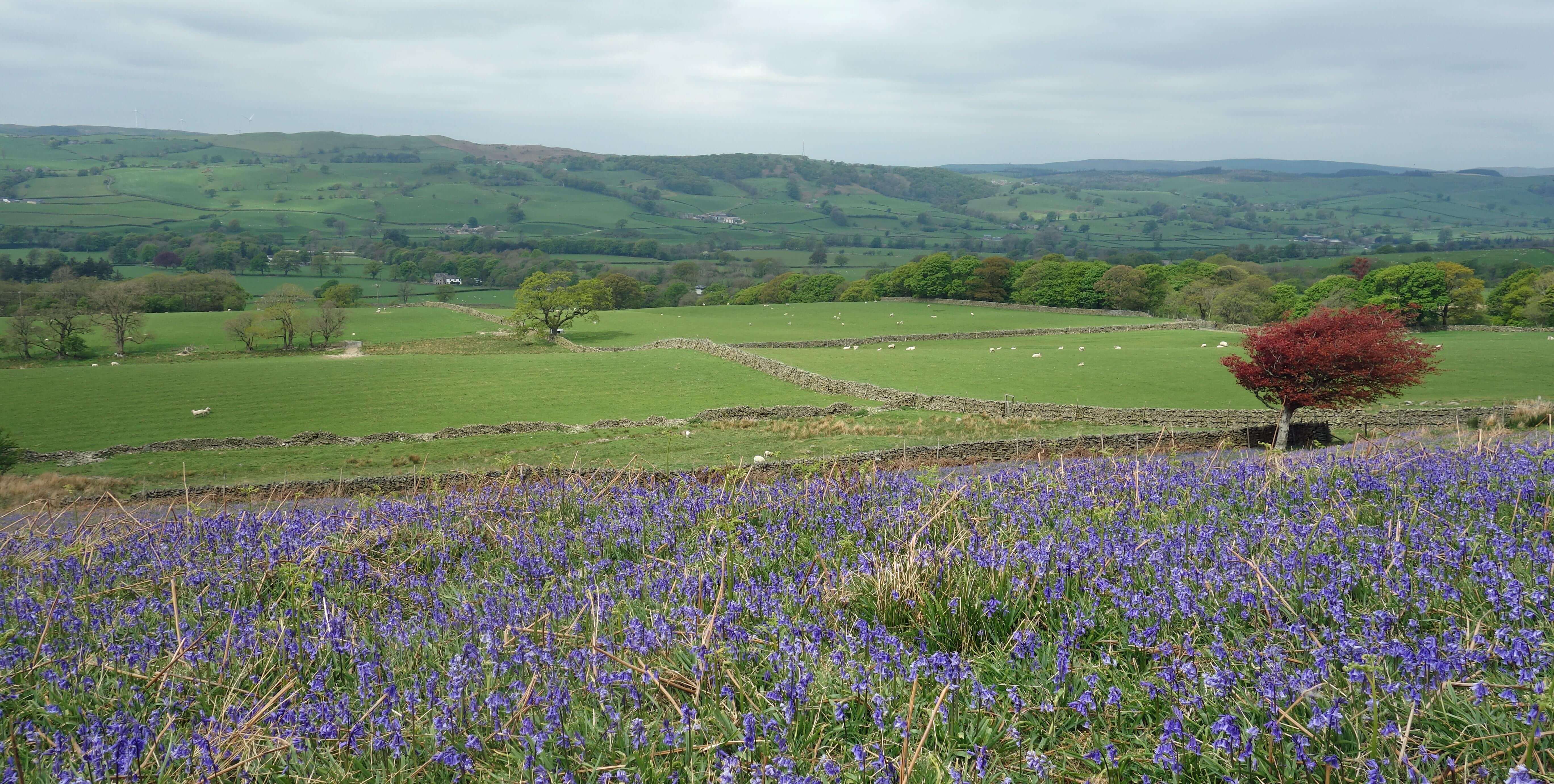 Left: Bluebells on Middleton Fell
Left: Bluebells on Middleton Fell
Right: Bluebells, copper-beech and Lune valley
The bluebell is, as we all know, a flower of dappled woodland.
We expect to have to walk into our woodlands in order to appreciate
at close quarters the fine violet-blue carpets. (Is that a metaphor? It
depends on your definition of ‘carpet’. I picture J.A. Baker agonising
through the night to get his count absolutely correct.). And yet on
Middleton Fell, overlooking the Lune valley, the bluebells are out
in the open, painting the hills blue, much as heather paints some
of them purple in the autumn. These bluebells provide, from the
A683 north of Barbon, the finest long-distance view of bluebells in
the region.
As the bluebells are on the western, shady side of the fell they
don’t have to cope with the full force of our spring sunlight, such as
it is. That , however, cannot be the full answer because bluebells are
not seen on other open, shady hill-sides. My conjecture is that these
bluebells were not always out in the open but were once protected
by trees that have been removed, leaving the bluebells to struggle
on, amongst the bracken and grass.
Of course, I felt an obligation to check out such a conjecture and
I duly tramped up for a close investigation of the bluebells south
of Brow Gill. There were a few straggly trees within the field but,
I admit, I did not find evidence that a woodland had been felled.
However, I did notice some old, overgrown, isolated rhododendron
nearby, together with a couple of copper-beech, a cultivated variety
of beech that is not native to the region. I wonder if, some time ago,
somebody created a recreational woodland here?
I persevered. I found an 1862 OS map - and this does indeed
show the present bluebell region as woodland. In fact, it is shown
as joined up with the woodland named as Heartside Plantation
on today’s map. Moreover, the two fields further south (west of
Howegill Head) where there is now a profusion of bluebells in the
open are also shown as woodland in 1862.
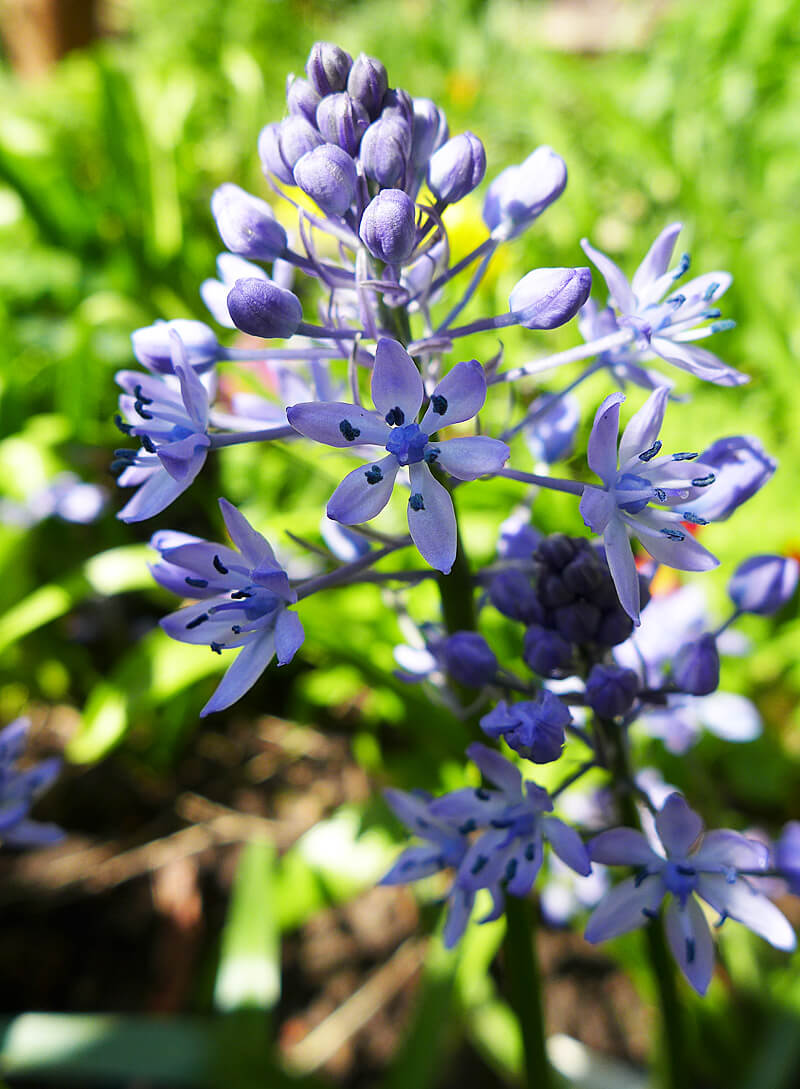
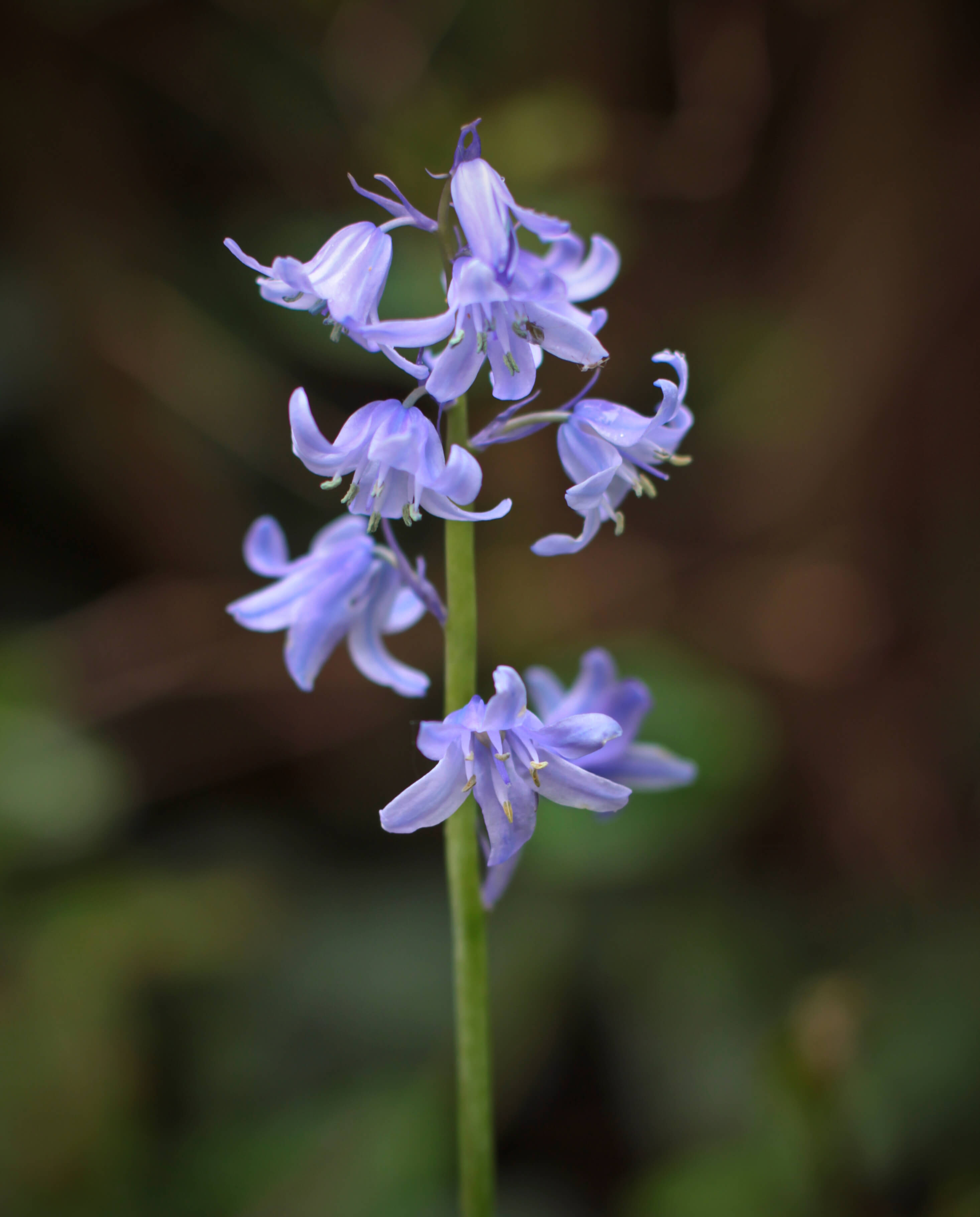
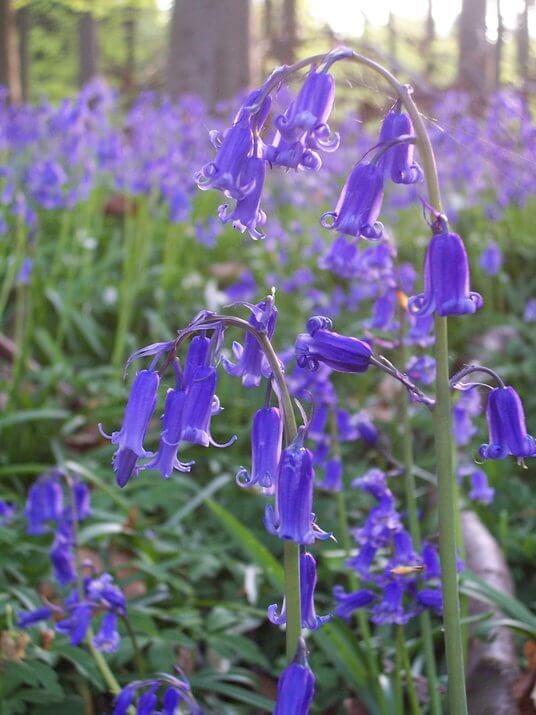
Right: Bluebells (from the left: English, Spanish and Italian)
My second question is: What can be done to protect the native
bluebell Hyacinthoides non-scripta?
As is sadly the case with some
other native species, the bluebell is
under threat from introduced species,
in this case, the Spanish bluebell
Hyacinthoides hispanica and the Italian
bluebell Hyacinthoides italica. The
alien species have been brought to
our gardens and allowed to spread
into neighbouring woods, where they
out-compete our less vigorous native
bluebell or hybridise with it, producing,
generation-by-generation, a less British
bluebell. It is a great shame because
our native bluebell, with its delicate
deep-blue curves, expresses a patriotic
British-ness to which our pale Latin
interlopers can only aspire.
We surely cannot continue to allow
these continental upstarts into our
country to vanquish our natives. The
forthcoming referendum is our chance
to put a stop to this, once and for all.
[1]. J.A. Baker (1967), The Peregrine, London:
Collins.
37. Swifts on Gragareth
July 2016
Of the few birds that we are guaranteed to see every year,
the swift Apus apus is the most mysterious. This is because,
although it is familiar, it is usually seen high in the sky,
flying higher than its friends, the swallow and house-martin.
We never see swifts on the bird-table or perched in a tree or on a
telegraph wire. Swifts so rarely land that their feet have evolved
away but not quite to nothing (despite apus meaning ‘no feet’).
The swift only lands to nest. Even then, the swift is secretive
compared to the swallow and house-martin, which nest openly
in barns and under eaves. The swift has, at least in this country,
largely abandoned its original nesting sites of caves and holes in
trees to nest, for example, under the tiles of our roofs, entering
through crevices. Unfortunately for the swift, modern building
methods aim to insulate and seal our houses and therefore eliminate
such crevices. To help the swifts, sympathetic builders nowadays
include ‘swift bricks’ in the walls for them to nest in.
It is possible to include one-way windows (like those in police
interview rooms) to view and film the swift’s nesting activities.
Its habits have therefore been thoroughly studied. We know, for
example, that the swift, and its young, enter a kind of hibernation
state if bad weather prevents feeding. Nestlings may live for five
days without food. The swift has a more efficient breeding regime
than the swallow, as is indicated by the fact that the swift has a
single brood of usually two eggs, whereas the swallow has two or
three broods of usually four eggs. The young swift flies straight
from the nest and stays airborne for two or three years flying to and
from Africa before, at last, alighting briefly to nest.
Fascinating though they may be, these nesting studies do not
reveal the real swift. Swifts are in their element in the air. To
appreciate swifts fully you need to get in amongst them, that is, close
to them while they are flying. To this end, I recommend visiting
the Three Men of Gragareth. The Three Men are large cairns on
the slopes of Gragareth, overlooking the remote farm of Leck Fell
House. The Three Men are not unaccompanied. There are several
other cairns nearby, haphazardly constructed and positioned.
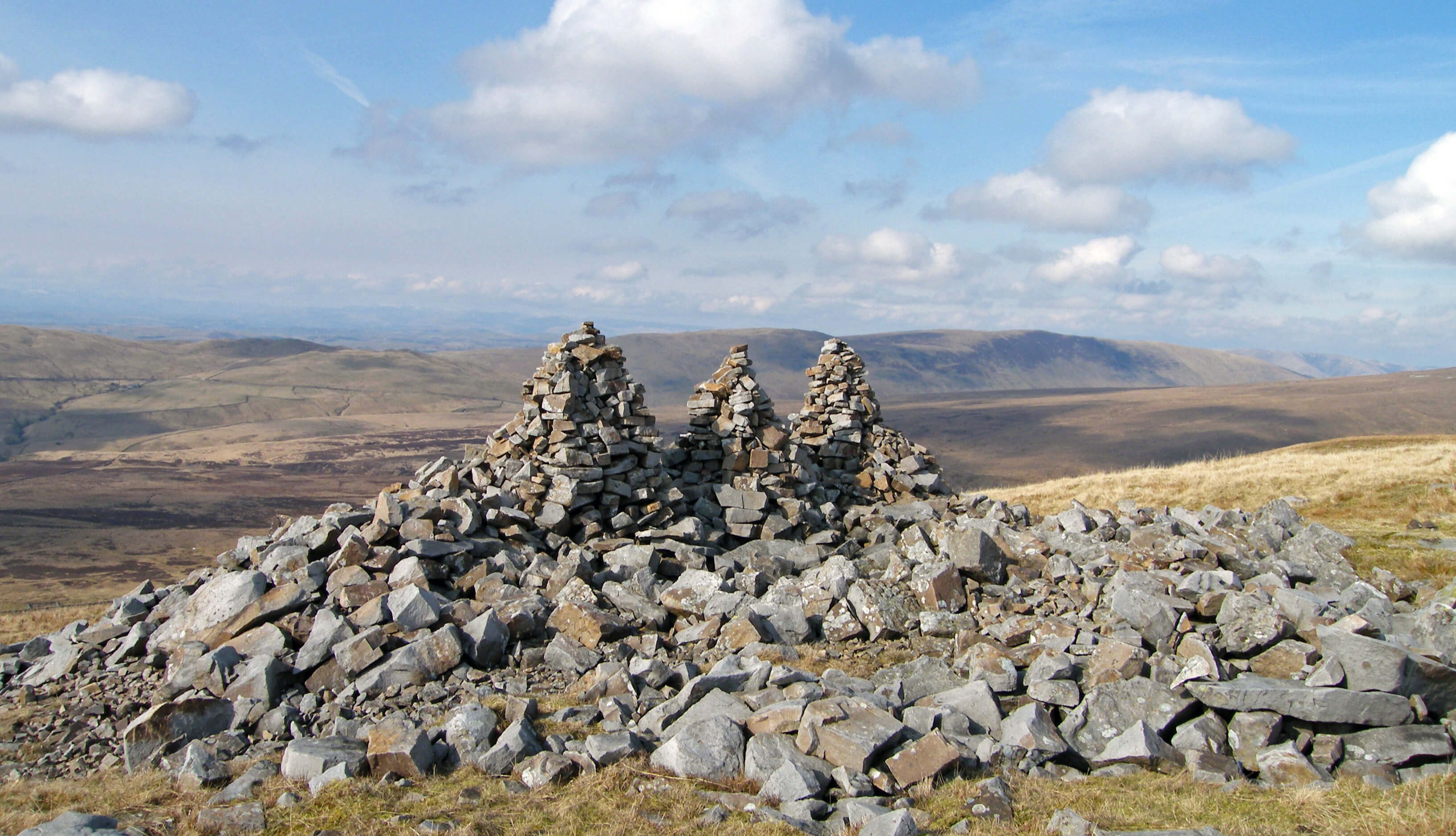 Left: The Three Men of Gragareth (Colin Gregory)
Left: The Three Men of Gragareth (Colin Gregory)
In the summer swifts like to swoop around the various cairns,
skimming the ground and soaring above. Therefore, if you stand
still as an extra man by the Three Men the swifts will swoop around
you. Then you will appreciate the great speed at which they fly.
They can reach over 100 mph, which is thought to be beaten only
by birds such as the hobby and peregrine. The merest flick of its
wings enables it to change course and to glide for some distance at
such speeds. You’ll see the elegance of its manoeuvres around the
cairns. However, it can be somewhat unnerving to have the swifts
zoom so closely by. Their wing shape has been likened to a scythe
or scimitar or boomerang - and you wouldn’t like to be hit by any
of those at that speed. The swifts will, of course, not hit you, even
if you try to get out of their way.
As you stand by the Three Men of Gragareth, you will know
that the swifts’ aeronautical display is not for you. And yet it
seems to be a display. If you stand, say, a hundred yards away
from the cairns, you will not be surrounded by swirling swifts. I
see no reason why the insects that the swifts need should be more
abundant by the cairns than elsewhere. I conclude that the swifts
just enjoy zooming around the cairns. I know I would, if I were a
swift. The swifts fly every day, all day and all night (apart from
when nesting), and at some speed. The oldest known swift was 21
years old and is estimated to have flown over 3 million miles!
At the Three Men you will
have the rare opportunity to
look, at close quarters, down
as well as up at the swifts.
You will be able to study the
colouring of the birds from all
angles. There will probably
also be a few swallows joining
the swifts and this intimate
acquaintance with the birds will
enable you to develop the skill
of distinguishing between swifts
and swallows.
 Right: Swift
Right: Swift
The swift has longer, more
curved wings; the swallow has
a more forked tail; the swift
flies and glides faster with a
screaming call; the swift is, apart
from a pale throat, plain brown
all over (appearing black in
flight), while the swallow is light underneath, with a glossy blue-black head.
Overall, though, the two species provide a good example
of convergent evolution, whereby two unrelated species evolve
towards similar appearance and behaviour through occupying
the same ecological niche. The swift’s nearest relative is in fact
the humming-bird of America. The swift group (the Apodidae)
separated from all other birds about 65 million years ago.
Whereas I (in Chapter 12) expressed a preference for
the sand-martin as the harbinger of the new summer, for many people -
including the poet, Ted Hughes - it is the swift:
Fifteenth of May. Cherry blossom. The swifts
Materialise at the tip of a long scream
Of needle. ‘Look! They’re back! Look!’ And they’re gone
On a steep
Controlled scream of skid
Round the house-end and away under the cherries.
Gone.
Suddenly flickering in sky summit, three or four together,
Gnat-whisp frail, and hover-searching, and listening
For air-chills – are they too early? With a bowing
Power-thrust to left, then to right, then a flicker they
Tilt into a slide, a tremble for balance,
Then a lashing down disappearance
Behind elms.
They’ve made it again,
Which means the globe’s still working, the Creation’s
Still waking refreshed, our summer’s
Still all to come –
The globe is still working - but not as well as it was. The swift
is among the birds listed in Chapter 14 as suffering the most rapid
decline in recent years: 40% between 1994 and 2007. There are,
however, still about 85,000 swifts nesting in the UK.
In the past swifts were known as ‘the devil’s bird’, presumably
because of its mysterious nature and the somewhat ominous dark
swirling and thin screaming (as of lost souls) above us. A close
encounter, such as that at Gragareth, will, I think, remove such
negativity and provoke instead some affection for these magnificent
aeronauts.
38. White-Clawed-Crayfish and Red-Squirrels around the Upper Lune
October 2016
The white-clawed-crayfish Austropotamobius pallipes is Britain’s
only native crayfish. Crayfish are, of course, not fish. They
are freshwater crustaceans, related to lobsters, their marine
cousins. In fact, they are our largest native freshwater crustaceans,
although usually less than 10 cm from snout to tail-plate. I have
never seen one in the wild, a state of affairs that I would like to
remedy. So, where and when to search?
Females overwinter with a clutch of a hundred eggs or so held
beneath their tail. Juveniles are released in the summer and, if
very lucky, may live for ten years or so. They can live in a variety
of watercourses, from a few centimetres to two metres deep, and
in still or fast-flowing streams, provided that there are refuges.
During winter the crayfish may move into deeper water or burrow
into banks.
White-clawed-crayfish are especially sensitive to changes in
their environment. They require a food supply and unpolluted
water, rich in oxygen and slightly alkaline (and therefore peat-free).
Crayfish also need sufficient calcium to grow their carapace. They
usually spend the day hidden among cobbles and tree roots in the
river’s bed and forage mainly at night, feeding on a wide range of
food, from leaf litter to live or dead fish. Crayfish use undercut banks
and overhanging trees as refuges, which are particularly important
for young and moulting adult crayfish vulnerable to predation
by birds, otter and fish. Some river structures, such as weirs and
fast-flowing culverts, may form barriers to white-clawed-crayfish,
leading to isolated and unsustainable populations. Crayfish are
also liable to be washed away in spate floods.
The secretive and unexciting lifestyle of crayfish has led to their
neglect in popular culture. If there are any stories, myths, legends
or nursery rhymes about crayfish then I must have missed them.
As a result, most of us know little about crayfish beyond that some
people consider them to be a delicacy. Which is unfortunate, both
for the crayfish, which needs our protection, and for us, because
they are a ‘sentinel species’ capable of indicating problems with the
health of our river systems.
The white-clawed-crayfish has declined significantly recently
throughout Britain and mainland Europe. This is mainly because
of competition from non-native crayfish, particularly the signal-crayfish
Pacifastacus leniusculus, and a lethal disease (crayfish plague)
that it carries. So, not satisfied with out-competing our native
crayfish, signal-crayfish also carry a plague which is harmless to
them but not to white-clawed-crayfish. There are five other species
of non-native crayfish that have escaped into British rivers.
Spores of crayfish plague and signal-crayfish eggs may be
inadvertently transferred on, for example, fishing gear from a
watercourse with signal-crayfish to another with white-clawed-crayfish.
Signal-crayfish may also walk short distances over land
to a new watercourse.
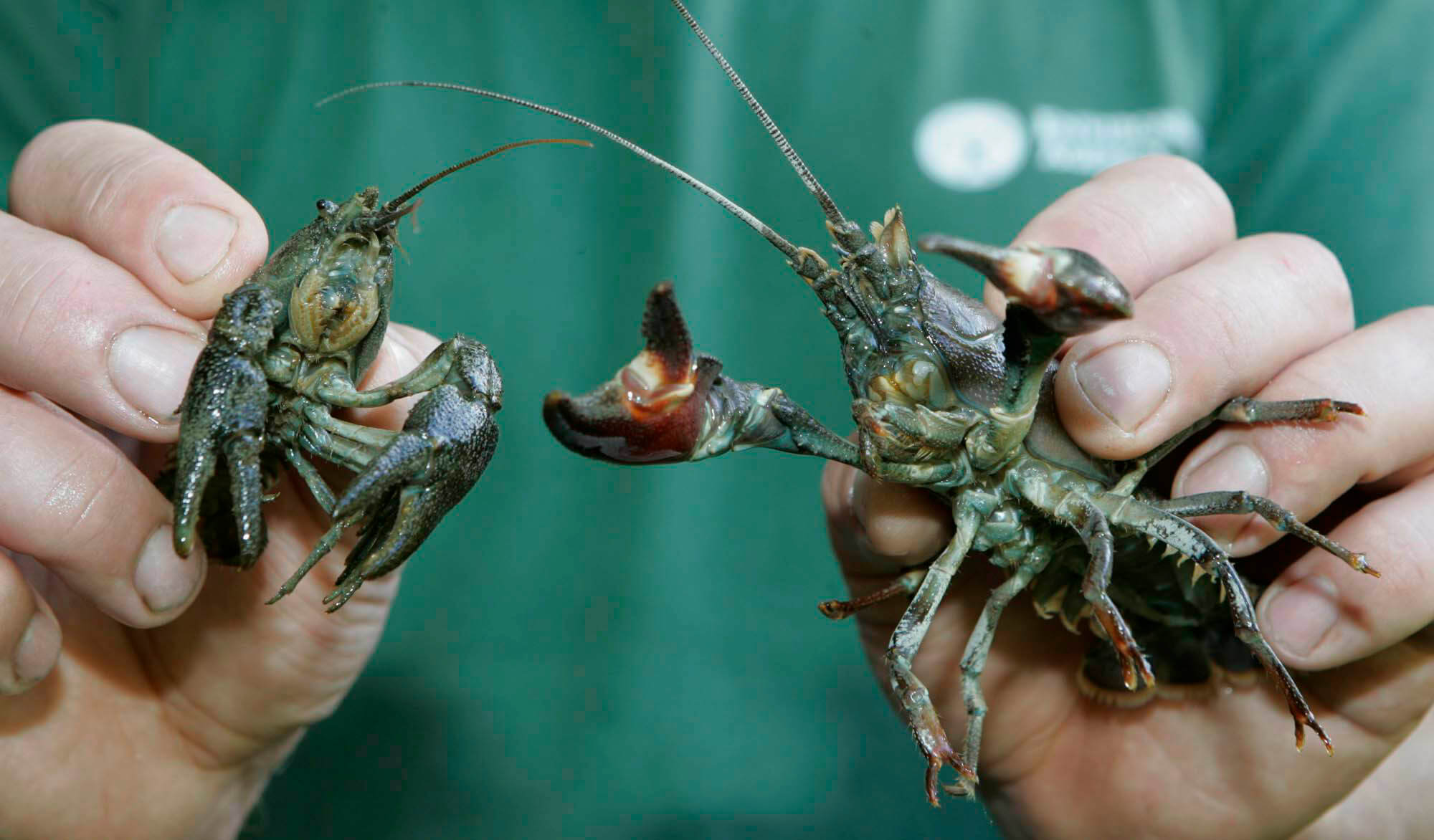 Right: White-clawed-crayfish and signal-crayfish (Environment Agency)
Right: White-clawed-crayfish and signal-crayfish (Environment Agency)
The signal-crayfish, a relatively large edible crayfish, was
introduced from North America in the 1970s in order to create new
markets. Inevitably, it seems, some signal-crayfish escaped and
then spread rapidly through our rivers and ponds. No doubt, some
signal-crayfish were deliberately introduced into rivers so that their
populations could grow and then be harvested.
Signal-crayfish are larger and more aggressive than white-clawed-crayfish.
Although they can co-exist for a while, signal-crayfish will soon (typically, in about four years) out-compete over
food and refuges. Moreover, male signal-crayfish will mate with
both female species, with the products of inter-species matings
being sterile.
The white-clawed-crayfish may be most easily distinguished
from the signal-crayfish by their undersides: the former is pinkish-white; the latter’s
claws are red. From above, the former tends to
look brown-olive and the latter red-brown.
The devastation of the white-clawed-crayfish population has
been even more drastic in mainland Europe than it has been in the
UK. So, even though it is now found in only limited areas of the
UK, this still constitutes about a quarter of the world’s population.
There are now very few UK river catchments that contain white-clawed-crayfish and not signal-crayfish.
At the moment, the Lune catchment is one of them. The latest
Environment Agency report that I have seen says that the white-clawed-crayfish
may be found at thirteen locations around the
upper Lune, although it sensibly doesn’t say precisely where. I did,
however, see a noticeboard at Orton which said that white-clawed-crayfish
were to be found in nearby becks although not in the beck
that it was standing beside. So I wandered around the surrounding
becks of Orton on the lookout for white claws.
I did not look very conscientiously because I had also read from
the Environment Agency that white-clawed-crayfish are a protected
species. It is illegal to handle them without a licence and these are
normally only given to those who are authorised to monitor their
populations. I half-heartedly turned over a few cobbles, hoping not
to disturb any crayfish. I was content to see their habitat, if not the
crayfish themselves.
I was pleased to see that the becks were crystal clear, as the
crayfish no doubt prefer, but I fear that it is only a matter of time
before the Lune has signal-crayfish, introduced deliberately or
inadvertently over its watershed. They are to be found now in, for
example, the River Keer through Carnforth. Currently, there is no
effective method to prevent signal-crayfish spreading throughout
a catchment once it is present. Even without signal-crayfish, the
number of Lune white-clawed-crayfish has greatly diminished,
mainly because of pollution and loss of habitat.
As I strolled around the Orton and Tebay region I saw road
signs advertising the presence of red-squirrels Sciurus vulgaris, so I
thought that I’d look out for those too. The red-squirrel is a species
with a sadly similar story to that of the white-clawed-crayfish. It
too has seen its population plummet due to the loss of its native
habitat but mainly because of the introduction of an alien species
also from North America, the grey-squirrel Sciurus carolinensis.
Greys were first released in Britain in 1876 and by the 1920s had
become a plague. A bounty scheme in the 1950s killed a million
greys - but still they spread. Grey-squirrels are now classified as
vermin.
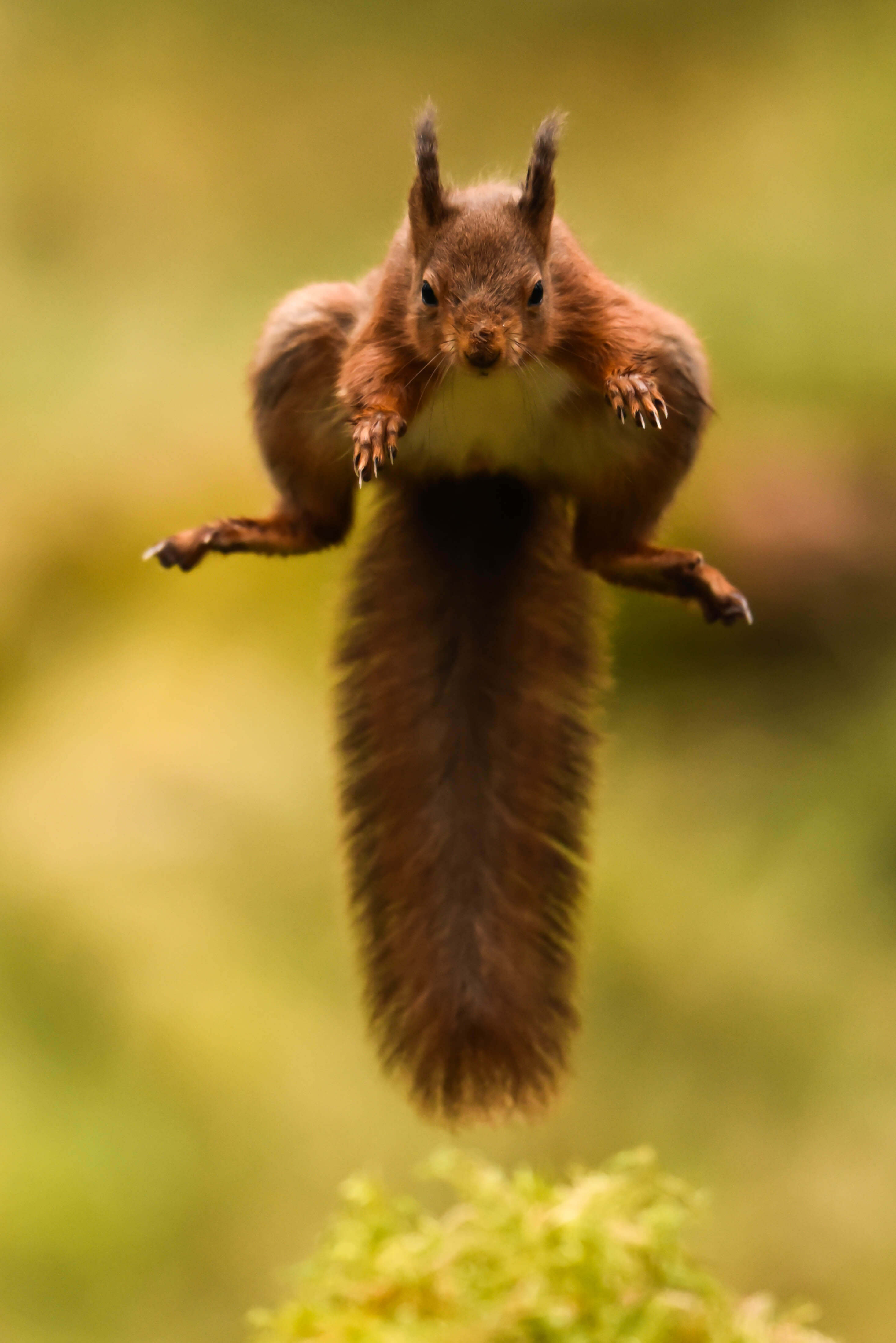
 Left: Red squirrel (Andrew O’Brien)
and grey squirrel (Steve Ransome).
Left: Red squirrel (Andrew O’Brien)
and grey squirrel (Steve Ransome).
The native red-squirrels and introduced grey-squirrels do not
directly compete but greys monopolise the available food and also
carry a disease (parapoxvirus) that does not seem to affect them
but often kills reds (again similar to the crayfish situation). In 2011
a five-year government-backed conservation project Red Squirrels
Northern England was launched. In 2013 this project felt able to
report a 7% increase in the number of red-squirrels in the north of
England, the first increase after 150 years of decline. According to
the latest report of the local Red-Squirrel Officer, red-squirrels are
“doing well on the River Lune .. down river .. to near Sedbergh”,
thanks to a programme of trapping and killing the greys. Some
reds have been reported south of Middleton. Judging by the road
signs, at least, red-squirrels are certainly around the upper Lune.
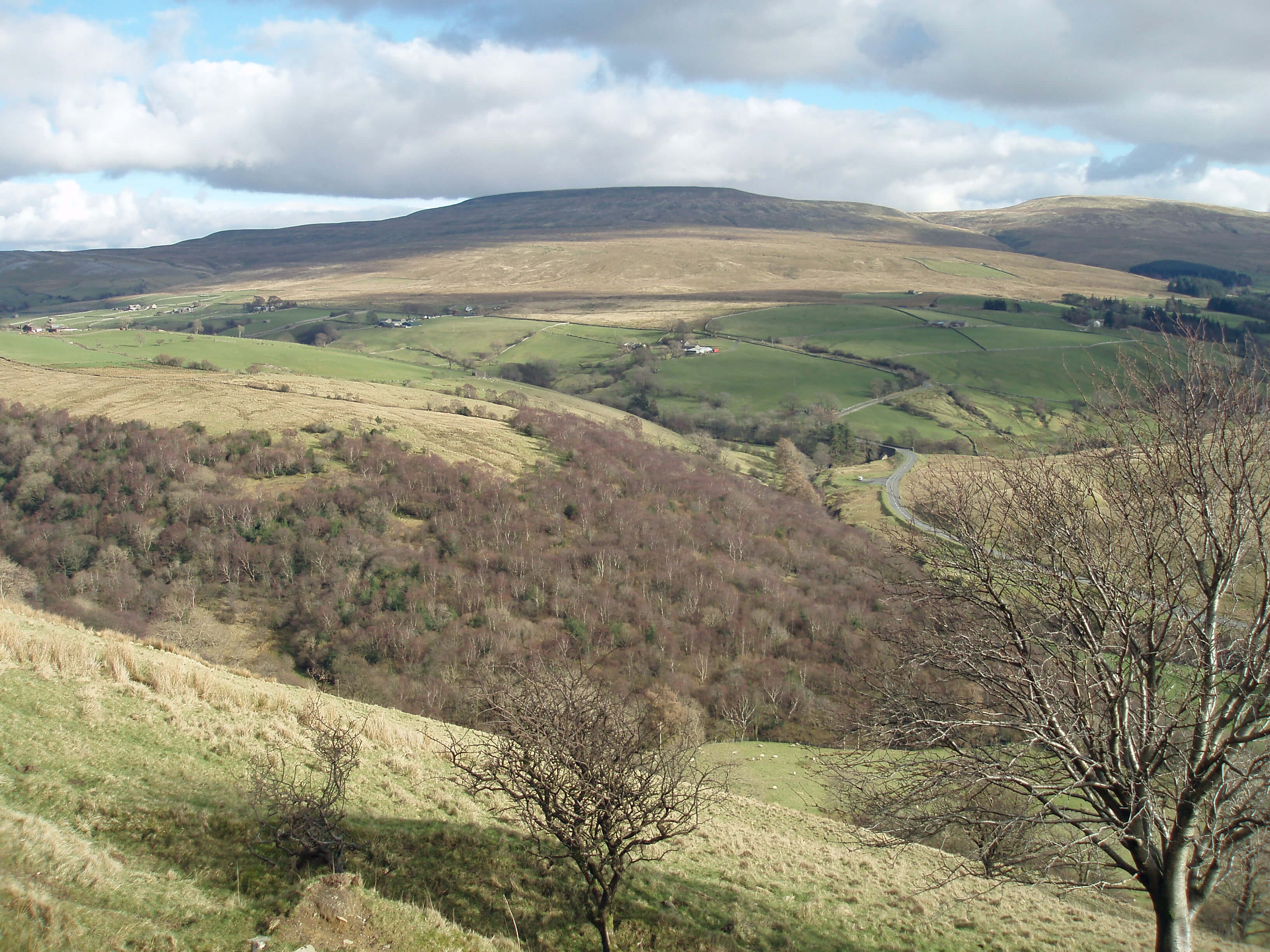 Right: Murthwaite Park with Wild Boar Fell beyond
Right: Murthwaite Park with Wild Boar Fell beyond
However, I have not been lucky in observing red-squirrels in the
Loyne region. I have seen more red-squirrel road signs than I have
red-squirrels. To be precise, I have seen only three red-squirrels in recent years, on
two occasions in Murthwaite Park at Cautley by the River Rawthey
and once running on the road between Murthwaite Park and the
Cross Keys Inn.
Murthwaite Park is a SSSI because, although it is small, it is
the largest area of ancient woodland in the Howgills. It is mainly
birch and hazel, with oak, sycamore, alder, holly and willow. It
is not a park in the modern sense of the word but a very scrubby,
sparse wood with few trees of any great height, apart from those on
the fringes. It is sometimes said that red-squirrels prefer conifers
to broad-leaved trees. This conception may have arisen because
red-squirrels cope better within mature conifer plantations. In
fact, native red-squirrels should feel at home, naturally, in native
woodland such as Murthwaite Park.
Within the wood it seemed eerily silent on my last visit. I
could hear no birds apart from the occasional distant mewing of a
buzzard, but then it wasn’t the season for birds to chirrup. It takes
an effort of will to imagine the whole of the Howgills covered in
such scrubland. We know that before the sheep were introduced
the Howgill hills were forested. Where we now stride out on grassy
slopes with distant views it would once have been a challenging
scramble through undergrowth, in silence and with no views, much
like Murthwaite Park today.
At the Cross Keys Inn we learned from the proprietor that the
red-squirrel that had become a friendly visitor there was no more,
having been run over on the A683. If it was the one that I saw on the
road then I am not surprised. And if it was the same red-squirrel
that I saw (twice) in Murthwaite Park then perhaps the entire local
population has been extinguished. So I hope that the red-squirrel
spotters around Sedbergh and beyond are reliable.
Although I began this exploration of local wildlife, four years
ago, in a light-hearted frame of mind, I have been unable to sustain
it through this catalogue of woes facing our species. I am sorry
about that but a rational appraisal of the situation is too depressing
to allow anything else.
39. Red-Grouse at Ward's Stone
November 2016
To escape from my worries about local wildlife I have been
reading a book about India published in 1822 [1].
It was written by Daniel Johnson, who was a “surgeon in the honorable East
India Company’s service and resident many years [up to 1809] at
Chittrah in Ramghur”. The title of the book is difficult to determine
as the title page has, as was the custom of the time, many words,
in various sizes and fonts. However, the words up to the first full-stop
are “Sketches of field sports as followed by the natives of India
with observations on the animals”.
And that is a fair description of the book’s contents. As the pages
make clear, there was a profusion of wildlife in India two hundred
years ago - and this life really was wild. There were, for example,
“an immense number of venomous snakes in all parts of India”
such that “apprehension and fear attend every step”. Johnson also
writes that “the number of persons bitten by mad dogs, and mad
jackals, that came under my care while surgeon at Chittrah would
appear almost incredible, were they to be stated here”. He describes
his experiments - almost always unsuccessful - to find remedies for
those bitten by snakes or suffering from hydrophobia (or rabies).
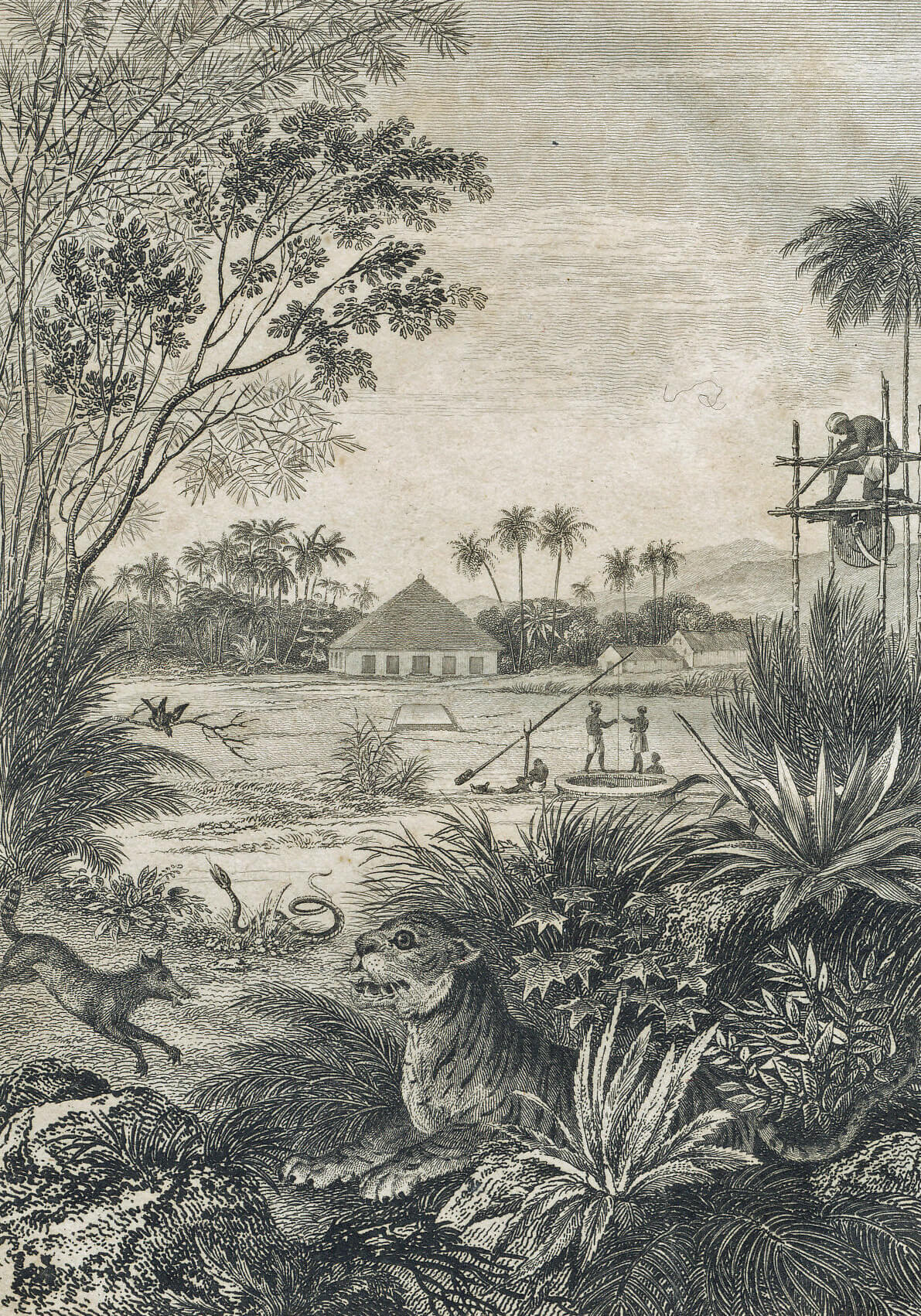 Right: Frontispiece of “Sketches of field sports ...”
Right: Frontispiece of “Sketches of field sports ...”
I am sure that no surgeon could have saved those attacked by
tigers, which were plentiful in many parts of India. An attack by a
tiger seemed to be accepted by the natives as a fact of life (or death).
He mentions a tigress that “during two months, killed a man almost
every day, and on some days two”. It was facilitated in this by the
Indians’ “thorough belief in predestination” which meant that after
an attack those remaining would just carry on in much the same
way thereafter.
The pages repeatedly mention the overwhelming abundance of
dangerous wildlife: “Black bears are common throughout the hills
and very numerous in Rogonautpore and Geldah” ... “Wolves are
found in all parts of India” ... “Leopards and panthers are numerous
throughout the jungles” ... “Wild hogs are plentiful in every part of
India” ... “Hyenas are common on all the south side of the river
Ganges” ... “Wild buffaloes
are plentiful in many parts
of Bengal” ... “Elephants are
numerous on the north side
of the river Ganges near the
mountains from Chittagong to
Hardwar”. In addition, there
appears to have been vast
numbers of game animals,
such as deer, partridge, duck
and hare.
As a consequence, some
Indian natives made it their
business to become expert
in catching specific animals.
The book contains detailed
descriptions of their various
contrivances, from elaborate
tiger traps to techniques for
catching snakes. For example,
to catch ducks they would first
float large pots on the lake
until the ducks became familiar with them and would then put a
similar pot, with two eye-holes, over their head and surreptitiously
move into the lake with only their head (in the pot) above water.
When a duck came close it would be grabbed.
Inevitably, it seems, the catching and killing of animals for the
two original reasons - for food and for protection - evolved into a
third - for amusement. This was, of course, a pastime that could
only be indulged in by the few Indian natives of wealth. Johnson
describes a ‘hunquah’, a sport of minor rajahs. First, a part of the
jungle was selected where the hunquah was to occur, and shortly
before it fires were lit ten miles or more all around to compel the
animals within to shelter in the targeted jungle.
The day before the hunquah, several hundred people were
sent to the leeward side of the jungle to fix a mile-long series of
nets. Beside each net platforms were raised where the rajah and his
friends could sit and wait. On the morning of the hunquah ten to
twenty thousand people assembled and arranged themselves into
a line many miles long on the other side of the jungle. They then
walked forward, making “a most hideous noise”, in whatever way
they could (guns, fireworks, pots-and-pans, and so on), forcing the
animals towards the nets. There the animals would be trapped
and/or shot by the rajah and his friends.
The word ‘hunquah’ comes from the verb ‘hunkna’, meaning ‘to
drive’. Hold on ... that reminds me of something. Oh yes, driven
grouse shooting, our gentry’s sport of choice on our northern moors.
It too uses fire, not to entrap the quarry but to burn the heather so
that it may be eaten by grouse. There is also a team of ‘beaters’,
although only a handful of them compared to the vast numbers
for a hunquah, both sets of beaters being of a lowly class relative to
those doing the actual shooting. There is also the equivalent of the
platforms in the form of grouse butts, spaced out across the moor,
where the rajah-equivalent and his friends await the grouse. So
perhaps the concept of driven grouse shooting was not an original
brainwave but was brought back from India by some British
gentleman?
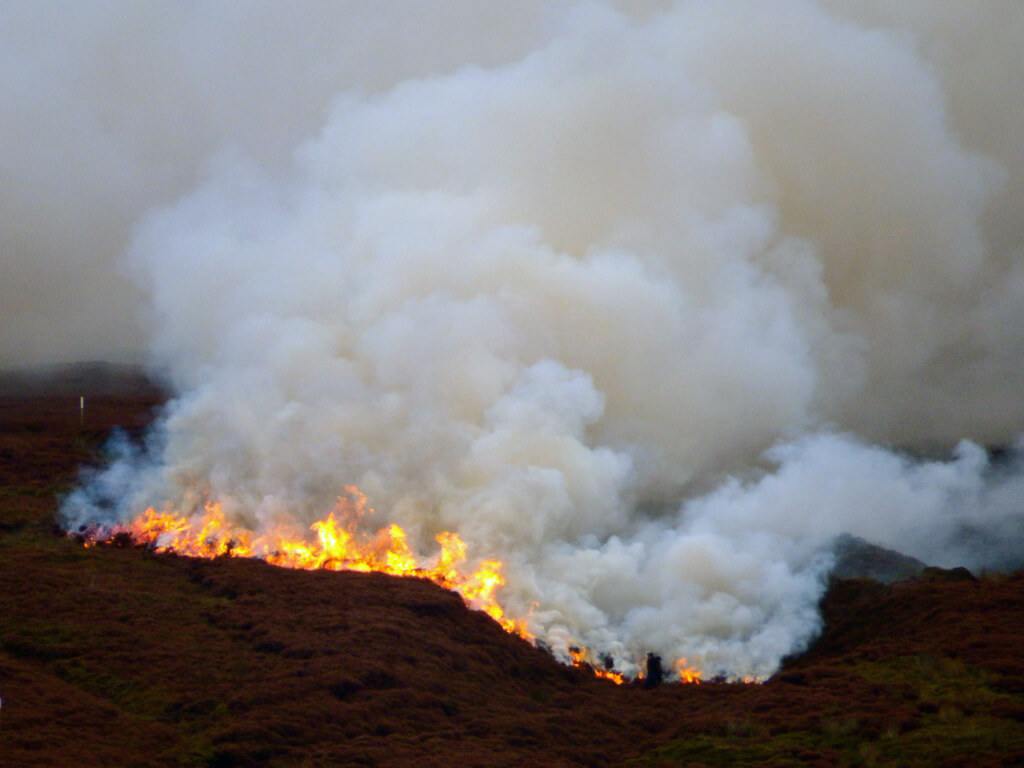 Left: Heather burning (Victoria Buchan-Dyer)
Left: Heather burning (Victoria Buchan-Dyer)
The practice of driven grouse shooting began in the 1850s after
the invention of the breech-loading rifle. It is therefore not the long-standing
rural tradition that is claimed by those who engage in
driven grouse shooting (who, for brevity, I will call grousers). The
new rifle enabled a grouser to keep up a more or less continuous
volley of fire, especially if he had a minion standing nearby to
reload his rifle (or rifles) all day, as shown in
videos on youtube.
The quantity of birds shot was what mattered. It certainly wasn’t
the variety, because unlike the hunquah, which trapped all species,
large and small, driven grouse shooting was focussed upon a single
species, the red-grouse Lagopus lagopus.
Red-grouse are a subspecies of the willow-grouse found across
northern continents. They feed largely on young shoots of heather.
Unfortunately for them, they are rather numerous on the moors,
somewhat plump, considered tasty by some, and have a mildly
erratic flight that provides a challenge to grousers but not too much,
as, say, a snipe would. They are therefore shot in their thousands
every autumn.
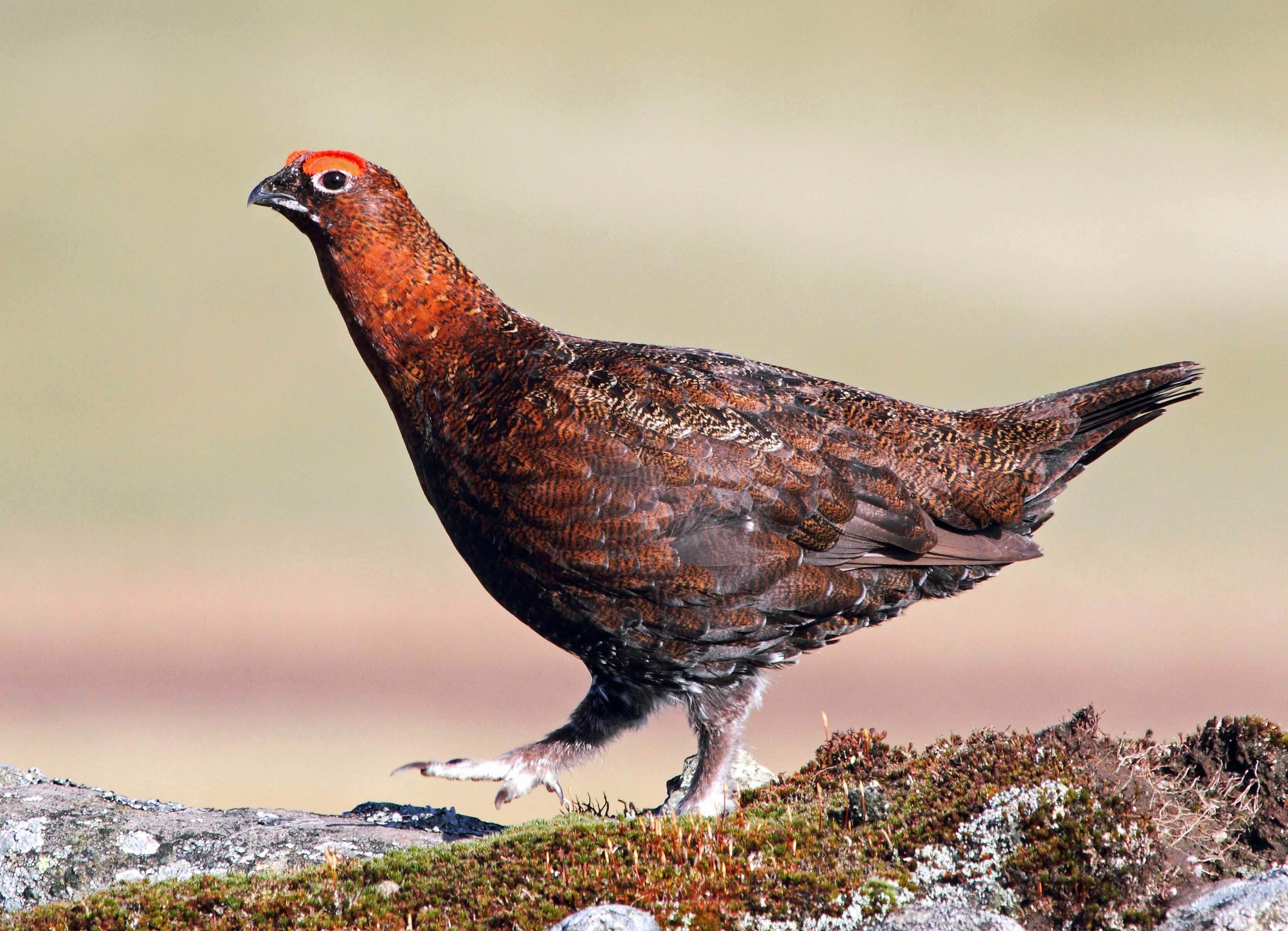 Right: Red-grouse (Sam Linton)
Right: Red-grouse (Sam Linton)
A couple of weeks ago there was a debate in parliament on a
petition to ban driven grouse shooting, now recorded in
Hansard.
The MP introducing the debate (Mr Double, MP for St Austell
and Newquay) did not beat about the heather. He agreed with a
fellow Tory (Mr Bellingham, MP for North West Norfolk), who had
immediately intervened, that the petition was “extremely ignorant
and misleading” and that it was “illogical” to seek to ban driven
grouse shooting but not walked-up grouse shooting. The latter
involves walking up the moor with a gun and perhaps a dog and
shooting the occasional grouse that happens to be disturbed.
These two MPs were either exceedingly dim or deliberately
untruthful (or both, of course). Nobody who attended or listened
to the preceding evidence session or had read any of the documents
submitted (as MPs beginning a debate surely would, or should,
have done) could be unaware of the differences between the two
forms of grouse shooting, such that it may make sense to ban one
but not necessarily the other [2].
Driven grouse shooting has, unlike the walked-up form, many
features that raise significant environmental and social concerns:
• large numbers of birds are killed or wounded ‘for fun’ in a
slaughter unfit for the 21st century;
• in order to provide an excess of red-grouse to shoot, birds of
prey, such as the hen-harrier, are illegally persecuted and many
species of ‘vermin’ (even mountain-hares) are killed;
• the practice of heather burning leaves many upland moors in
poor condition, causes carbon loss, decreases water quality
and may increase flood risk downstream;
• lead shot is left on the moor or in grouse to be eaten (there is
no legal limit on the amount of lead allowed in grouse, unlike
other meat: what possible reason can there be for this?).
All this is for just a few thousand grousers. Meanwhile the wealthy
moor-owners receive large payments of government, that is, our,
money under the Common Agricultural Policy.
Several MP grousers spoke in the debate. As they mellifluously
extolled the benefits (mainly to them and their friends) of driven
grouse shooting, disregarded any possible problems, and insulted
those with the temerity to seek a ban, my mind wandered off. I
imagined their words being spoken by the magnificent eight, the
group of men who on August 12th 1915 set the world record for
the number of grouse shot in one day (2,929) on the slopes below
Ward’s Stone, the highest point of the Forest of Bowland and within
ten miles of where I live.
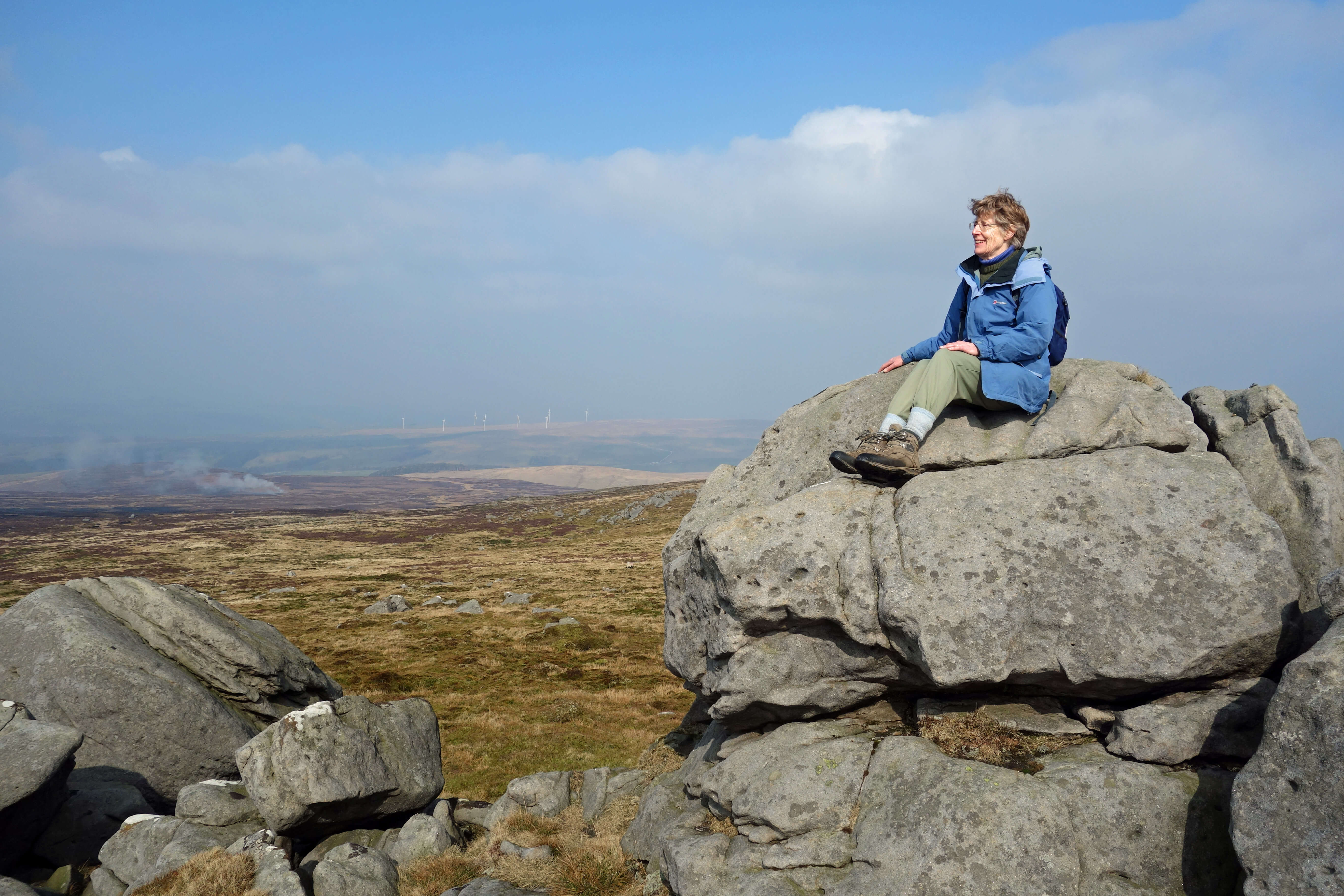 Left: Ward’s Stone, with native local fauna, plus heather burning in
the distance
Left: Ward’s Stone, with native local fauna, plus heather burning in
the distance
2,929 grouse is 366 per grouser. I don’t know how long a grouse
shoot lasts, but let’s assume that a generous luncheon and the need
to be back in time for a gracious tea on the lawn restricted it to
six hours. Then every grouser would have killed a grouse every
minute for six hours. That’s on average, of course: the nature of
driven grouse shooting is to have periods of waiting and then feasts
of killing.
That’s 2,929 grouse on one day. Lord Ripon (1852-1923) killed
97,503 grouse in his lifetime, until he fittingly fell dead upon the
heather [3].
I note the pride and precision of these records. It’s as if
grouse killing were a sport like cricket and they were recording the
runs of W.G. Grace. I don’t know how many innings, or shoots, Lord
Ripon had but he was, I’m sure, twice the sportsman W.G. Grace
was, so his average was probably about 80 (grouse per shoot). That
would mean over 1,200 grouse shooting days. Altogether he killed
556,813 animals, including 229,976 pheasants in one 28 year period.
So that’s many thousands of shooting days in total. It is important
that our great men do not have so many duties and commitments
that they haven’t time for a spot of recreational killing.
Even after nearly a lifetime of a relative lack of interest in wildlife
I cannot imagine myself killing a single bird without feeling shame
and remorse and with no iota of pleasure or achievement, let alone
one every minute for six hours or over 300,000 in total. What do the
grousers feel? They say that we should not hark back a hundred
years, because grouse shooting is different nowadays. But then I
think of the video that I referred to above. This advertises grouse
shooting on the Coverdale estate but with none of the usual guff
about an exhilarating day in a moorland paradise. It shows nothing
but cold, relentless, remorseless killing.
I was disturbed from my reverie by speakers referring to a bird
new to me, the golden-pullover. It apparently flourishes on the
idyllic moors created by the “careful custodianship“ (Mr Whittaker,
MP for Calder Valley) of those “unsung heroes of conservation”
(Mr Soames, MP for Mid Sussex), that is, the gamekeepers. I heard
that “hen-harriers need gamekeepers as much as grouse do” (Mr
Double). This summer there were exactly 0 hen-harriers and
approximately 300 red-grouse per sq km of English grouse moor.
Yes, hen-harriers need gamekeepers ... to stop killing them. Ah, the
golden-pluvver.
My mind wandered back again to August 12th 1915. It was,
of course, during the First World War. The magnificent eight -
two Majors, two Captains, two ‘the Hon’s, one Earl and one plain
Mr - included four military men and yet they felt able to disport
themselves on the moors killing thousands of grouse, whilst at
the same time thousands of their countrymen (of a lower class, of
course) were being killed in like manner on the fields of Europe.
It is particularly poignant to note that on that very day, all 250
men of E Company of the 5th Territorial Battalion the Royal Norfolk
Regiment - who had all been co-opted from the Royal Estate of
Sandringham - were killed in the Dardanelles, their bodies never
being found. Today, the royal family, despite professed concern for
wildlife through involvement in organisations such as the WWF,
are happy to shoot grouse. Do I sense a lack of empathy on the part
of the grouser, and not only towards grouse?
But 97,503 grouse? Pah! That’s a big number, but small game.
Johnson reports that Mr Henry Ramos, judge of the circuit of Bahar,
killed over 360 tigers. That’s more like it. If our royalty considers
hunting - even if it is only of red-grouse and in reality involves just
standing in a butt all day - to be a worthy part of its social calendar,
then it ought to make a real spectacle of it, as Prince Nawaub Vizier
Asop-ul-Dowlah did.
His hunting expeditions involved “about ten thousand Cavalry,
nearly the same number of Infantry, thirty or forty pieces of Artillery,
and from seven to eight hundred elephants”. His Highness and
fellow dignitaries marched this huge cavalcade for up to twenty
days towards the designated hunting arena, accompanied by a
travelling market of “forty to sixty thousand persons”. They, that
is, his Highness and fellow dignitaries, would then spend up to a
month hunting. Then they would all troop back to his palace.
Clearly, the Prince was absurdly wealthy, especially for a country
where almost everybody else was very poor. He had “more than a
hundred gardens, twenty palaces, twelve hundred elephants, three
thousand fine saddle horses, ...” but “possessed no great mental
powers” and was “without taste or judgement”. He was, however,
an excellent marksman. He practised his skill by firing from his
palace at pots of water carried on the heads of passing people. He
said that it was of little consequence if he killed anyone, having
plenty of subjects in his country. That’s the spirit! Likewise, who
cares about a grouse being killed? There are plenty more where it
came from.
I know even less about wildlife in India today than I do about
our own wildlife but I would bet that there are considerably fewer
snakes, jackals, tigers, bears, wolves, leopards, panthers, hogs,
hyenas, buffaloes, elephants, deer, partridge, duck and hare than
there used to be - but considerably more people. So my worries
about local wildlife have now been extended to cover wildlife
worldwide.
[1]. Daniel Johnson (1822), Sketches of field sports ...
[2]. Mark Avery (2015), Inglorious: Conflict in the Uplands, London: Bloomsbury.
[3]. Martin Stephens (2013), The Sportsman’s Library - Grouse Shooting,
London: Read Books.
40. Wrens in Our Garden
December 2016
I am looking forward to Christmas. On Christmas Eve I will
join some friends and, according to tradition, ramble about the
village all night, visiting the various hostelries, until the church
bells strike midnight. Then we will hunt for wren, which, having
found and killed, we’ll fixed to the top of long poles. We’ll then
proceed to the homes of the wealthy where we’ll sing, with cheerful
menace:
The wren, the wren, the king of all birds,
St Stephen’s Day was caught in the furze;
Although he is little, his family’s great,
I pray you, good landlady, give us a treat.
The good landlady would be unlikely to decline as she knows that
otherwise we will bury the wren on the estate in order to place a
curse upon it. Thus a merry time will be had by all. Apart from
the wrens.
My great-great-great-great-great-great-great-great-grandfather
might have written the above words - apart from “apart from the
wrens” because I am sure that he, like his contemporaries, would
have been indifferent to the casual callousness of his wren-killing.
He didn’t just have it in for the wren. He caged skylarks and
blinded them to make them sing better. On Shrove Tuesday he
tethered cockerels and stoned them to death. He killed kingfishers
to hang them up so that they could predict the direction the wind
would blow.
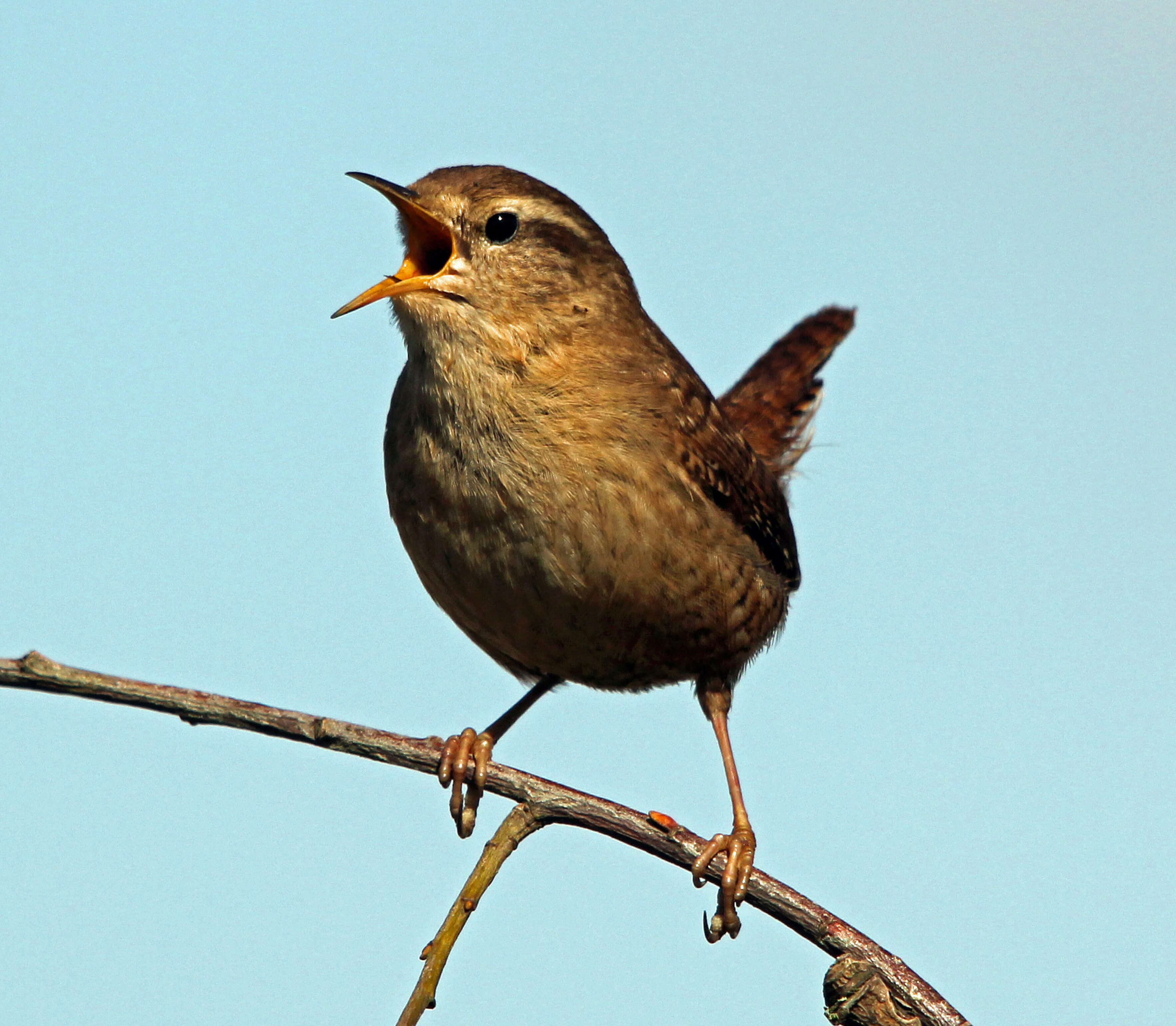 Right: Wren (Nick Wakeling)
Right: Wren (Nick Wakeling)
When I began this exploration of local wildlife I subconsciously
assumed that I was belatedly attempting to rediscover an empathy
with the wildlife around me. This empathy, I assumed, had been
lost by the increased urbanisation or, at least, suburbanisation of
my previous generations. In the distant past, surely, we lived in
harmony with wildlife, because we lived so much closer to it.
However, it seems that it was more complicated than that. At
one time we thought nothing of impaling a wren on a pole. It is hard
now to comprehend how such gratuitous brutality was acceptable.
Were wrens so abundant that
the odd impaling was neither
here nor there? Well, wrens
are abundant now and nobody
goes around impaling them.
Dare I ask whether our
brutality had a religious
foundation? The wren custom
itself, a form of which persists
today with the ‘Wren Boys’ in
Ireland, is thought to have its
origin in early religious rites, according to
Sligo Heritage.
Genesis 1 says that God
gave man “dominion over the
fish of the sea and over the
birds of the heavens and over
the livestock and over all the
earth and over every creeping
thing”. Then, after the Flood (Genesis 9), God blessed Noah and his
sons: “The fear of you and the dread of you shall be upon every beast
of the earth and upon every bird of the heavens, upon everything
that creeps on the ground and all the fish of the sea. Into your hand
they are delivered”.
I can see no suggestion of empathy or compassion there: every
beast must be in fear of man. Contrast this with Buddhism, which
considers all animals to be sentient beings that should not be
harmed or killed. Admittedly, this is partly because the animals
are considered to be reincarnations, possibly of our own relatives,
and nobody would want to harm their predecessors. However,
as the previous Chapter showed, it was not only Christianity that
encouraged man’s dominion over nature.
The relationship between the human species and all other species
on the planet, and our effect upon them, is clearly complex. At the
least, the great increase in human numbers, with its demand upon
the Earth’s finite resources, is bound to have had an effect upon
many species. It is easy to see, for example, how the hedgehog will
find it difficult to adapt to the many more buildings and roads. And
also that changes in intensive farming practice will harm farmland
birds. Today, wherever I look I see less: fewer wildflowers, fewer
bees, fewer fish, fewer birds, fewer frogs, fewer butterflies, ...
It is not that we have any ill-will towards the hedgehog,
farmland birds and the many other species affected by the spread
of humanity. Their problems are but an unfortunate side-effect of
our actions. However, there are many other kinds of side-effect
where it is arguable that they really ought to have been anticipated.
For example, it should hardly have been a surprise that pesticides
had harmful effects on the environment, as described by Rachel
Carson in her influential book of 1962 [1].
And could it really not have
been foreseen that introducing non-native species such as Japanese-knotweed and grey-squirrel was not a good idea?
In some cases, the remedy, or attempted remedy, is clear: ban
the pesticides, eradicate the grey-squirrel, help the hedgehog by
providing refuges and safer ways of getting about. In other cases,
the side-effects are so sweeping and the causes so complex that our
response is unclear. For example, if climate change is causing the
arrival of cuckoos to be out of phase with the caterpillars that they
feed upon, what should we do about it?
Humanity’s affect upon the environment is so profound that
many species now, sadly for them, depend upon our careful
custodianship (to borrow a phrase) of the planet. Much of the
natural world cannot now find the natural balance that it found in
the past. It needs us perpetually to adjust the scales, to achieve the
balance that we, if not they, prefer.
There is an increased awareness of the need to deal with the
unintended consequences of our various actions. However, during
the course of my investigations I have been surprised by the degree
to which we continue to justify deliberate actions harmful to
nature.
No doubt, in the past, our attitude to animals was coloured by
the fact that we had to kill them to eat in order to survive. Our
predecessors did, in fact, eat skylarks but I doubt that there would
have been much nourishment from a wren. As we were killing
birds to impale on a stake to roast over a fire it is not such a leap to
accept impaling wrens in order to obtain food indirectly.
 Left: Wrens among the sweet peas.
Left: Wrens among the sweet peas.
However, nowadays, hunting is for fun rather than food.
Society’s attitude towards hunting seems not to have changed much
since the days of Gilbert White (1720-1793), regarded as England’s
first ecologist after his detailed studies of the nature around him [2].
He wrote as if in awe of hunters, regarding the need to hunt as
‘inherent’ and the practice of it an essential rite of passage towards
manhood: “Most men are sportsmen by constitution; and there is
such an inherent spirit for hunting in human nature, as scarce any
inhibitions can restrain ... Unless he was a hunter ... no young person
was allowed to be possessed of manhood or gallantry”. (Females
were not considered.)
I have learned during the course of this exercise that wildlife
cannot be considered in isolation, unfortunately. People and politics
inevitably play a part. How else can one make sense of the fact that
the RSPB (for the Protection of Birds, remember) can support the
killing of birds for fun? How else can one understand how DEFRA
can approve the killing of a protected native species (the buzzard)
in order that thousands of non-native birds (pheasants) can be
killed for fun?
We have, I suppose, made progress in one sense at least:
wanton cruelty towards animals, apart from during certain forms
of hunting, is now illegal and indeed society considers such actions
deplorable. Thus, the wren is no longer impaled. Indeed, I will
overcome my despondency at the travails of our wildlife by ending
this manuscript by adopting the wren as a symbol of natural
resilience, representing the hope that despite our worst endeavours,
nature will win, in the end.
Despite the impalers, the Eurasian-wren Troglodytes troglodytes
is now probably our most common bird, with over eight million
breeding pairs, although numbers may fall drastically during a
long, harsh winter. Not only is it our most numerous bird but it is
also our most widespread, being resident in all habitats throughout
the UK, apart from the highest hilltops.
The wren is not so easy to spot, being such a small bird. It is, in
fact, the third smallest British bird, after the goldcrest and firecrest.
If it isn’t seen, then it may well be heard because perhaps the most
extraordinary thing about the wren is the loud song that emerges
from its tiny body and, moreover, it does not restrict its joyful song
to the breeding season, as most birds do. However, in our garden,
at least, the wren is relatively quiet in December.
One summer wrens must have nested nearby for a family of
them delighted in frolicking among the sweet peas by the window.
The wren is a very energetic bird
- at least, the male is! He builds
half a dozen nests in the spring
and then the female may deign
to choose one of them. She lays
up to eight eggs and there’s often
a second brood (I hope that she
doesn’t insist upon another half a
dozen nests to choose from). With
all these eggs, the wren population
soon recovers after any harsh
winter. Most wrens do not move
far from their birthplace and tend
to defend their winter territory.
So perhaps our present wrens
are descendants of the sweet pea
family.
One fine summer day I sat
for a while by upper Barbon Beck
watching several wrens flitting in
and out of the rock crevices beside
the beck. We tend to think of wrens
as birds of the shrubbery because normally we glimpse them as
they nervously dart into the bushes while we move by, mowing
the lawn or walking in the woods. However, they seemed more
in their element out in the open by Barbon Beck. They seemed
perkily content disappearing into the beck-side crannies hunting
for insects (I assume) or just playing (perhaps). I could see where
their scientific name came from. It was a pleasure and privilege to
be able to watch them.
And so I'll end thinking of the indomitable wren, hoping that it
will serve as a beacon of hope for nature.
[1]. Rachel Carson (1962), Silent Spring, Houghton Miffin.
[2]. Gilbert White (1795), A Naturalist’s Calendar, with observations in various
branches of natural history, London: B. & J. White.
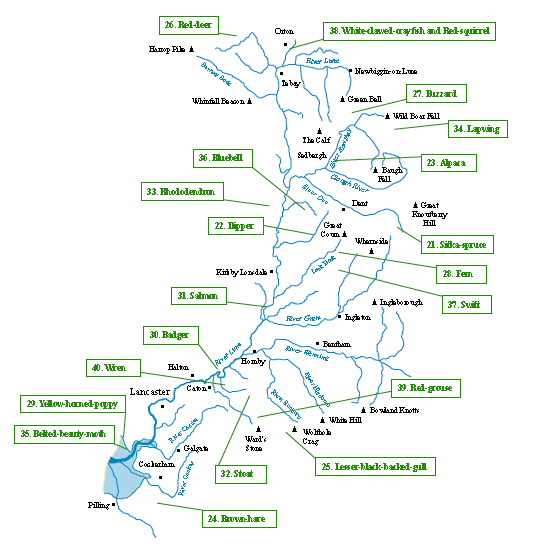

Plover Scar lighthouse
from Sunderland Point, where the Lune disappears into
Morecambe Bay
© John Self, Drakkar Press

 Introduction
Introduction

 Right: The view from the source of the Lune on Green Bell
Right: The view from the source of the Lune on Green Bell
 Left: The first trees of Loyne
Left: The first trees of Loyne
 Right: A curlew chick (Andrew Martin)
Right: A curlew chick (Andrew Martin)

 Left: The Green Bell trig point, looking towards Randygill Top
Left: The Green Bell trig point, looking towards Randygill Top
 Right: Sunbiggin Tarn
Right: Sunbiggin Tarn
 Left: Geyer’s whorl snail (Wikipedia)
Left: Geyer’s whorl snail (Wikipedia)

 Left: Great Asby Scar
Left: Great Asby Scar
 Right: Looking towards Orton from Great Asby Scar
Right: Looking towards Orton from Great Asby Scar

 Left: Bluebell on Great Asby Scar
Left: Bluebell on Great Asby Scar
 Left: Ingleborough from Edith’s Wood
Left: Ingleborough from Edith’s Wood
 Left: The young tree (field maple?) in Edith’s Wood
Left: The young tree (field maple?) in Edith’s Wood
 Right: Beech in Greta Wood
Right: Beech in Greta Wood
 Left: Sycamore by Greta Wood
Left: Sycamore by Greta Wood

 Left and Right: Heysham Moss
Left and Right: Heysham Moss
 Left: A ditch in Little Fylde (with ducklings)
Left: A ditch in Little Fylde (with ducklings)
 Right: Cinnabar moth caterpillars on ragwort
Right: Cinnabar moth caterpillars on ragwort

 Left: Marsh gentian (Tim Melling)
Left: Marsh gentian (Tim Melling)


 Right: Aughton Woods, Lune, Ingleborough and hot air balloon
Right: Aughton Woods, Lune, Ingleborough and hot air balloon
 Right: The leaves of small-leaved lime
Right: The leaves of small-leaved lime
 Left: The weir at Hornby
Left: The weir at Hornby
 Right: The Hornby eel pass
Right: The Hornby eel pass
 Right: Heron by the eel pass on Hornby weir
Right: Heron by the eel pass on Hornby weir
 Right: A delicacy?
Right: A delicacy?
 Right: The lone tree on Fell End Clouds
Right: The lone tree on Fell End Clouds
 Left: Fell End Clouds
Left: Fell End Clouds
 Right: Limekiln on Fell End Clouds
Right: Limekiln on Fell End Clouds
 Right: The Wyre-Lune Sanctuary from Lane Ends
Right: The Wyre-Lune Sanctuary from Lane Ends
 Left: Pink-footed goose (Greg Froude)
Left: Pink-footed goose (Greg Froude)
 Left: Shelduck (Ashley Cohen)
Left: Shelduck (Ashley Cohen)
 Right: Beware armed trespassers
Right: Beware armed trespassers
 Left: A swirl of geese
Left: A swirl of geese
 Right: Bewick’s ‘old woman and ducks’
Right: Bewick’s ‘old woman and ducks’

 Left: Ingleborough from Whernside
Left: Ingleborough from Whernside
 Left: The old landslip on Ingleborough
Left: The old landslip on Ingleborough
 Right: Purple saxifrage on Ingleborough (Brian Rafferty)
Right: Purple saxifrage on Ingleborough (Brian Rafferty)
 Left: The River Lune from the Crook o’Lune
Left: The River Lune from the Crook o’Lune
 Right: Sand martins (Sergey Yeliseev)
Right: Sand martins (Sergey Yeliseev)

 Left: Fell ponies on Roundthwaite Common
(Mitch McFarlane)
Left: Fell ponies on Roundthwaite Common
(Mitch McFarlane)
 Right: Roundthwaite Common
Right: Roundthwaite Common
 Left: Borrowdale
Left: Borrowdale
 Right: Baines Cragg, with the Lakeland hills beyond
Right: Baines Cragg, with the Lakeland hills beyond
 Left: The cuckoo in flight (Nick Ford)
Left: The cuckoo in flight (Nick Ford)
 Right: Littledale
Right: Littledale
 Right: Small pearl-bordered fritillary (Andrew Webber)
Right: Small pearl-bordered fritillary (Andrew Webber)

 Left: Pearl-bordered fritillary; Right: Small pearl-bordered fritillary
(Nigel Kiteley)
Left: Pearl-bordered fritillary; Right: Small pearl-bordered fritillary
(Nigel Kiteley)

 Left: The Lawkland Moss meadow, where the small-pearls were seen
Left: The Lawkland Moss meadow, where the small-pearls were seen
 Left: Kingfisher and queenfisher (Ken Jensen)
Left: Kingfisher and queenfisher (Ken Jensen)
 Right: Bull Beck
Right: Bull Beck
 Left: Himalayan-balsam
Left: Himalayan-balsam
 Right: Footbridge at Tebay, from under the M6 bridge
Right: Footbridge at Tebay, from under the M6 bridge
 Left: Lune’s Bridge
Left: Lune’s Bridge
 Right: Salterwath Bridge, with Grayrigg Pike beyond
Right: Salterwath Bridge, with Grayrigg Pike beyond
 Left: Crook of Lune Bridge
Left: Crook of Lune Bridge
 Left: Juniper on Moughton, looking towards Ingleborough
Left: Juniper on Moughton, looking towards Ingleborough
 Left: Dead juniper, with Pen-y-Ghent beyond
Left: Dead juniper, with Pen-y-Ghent beyond
 Right: Moughton Scars with Moughton beyond
Right: Moughton Scars with Moughton beyond
 Right: Loyn Bridge, Hornby
Right: Loyn Bridge, Hornby
 Left: Arctosa cinerea
(Steven Falk)
Left: Arctosa cinerea
(Steven Falk)
 Right: The Lune near Thrush Gill Island, where Loyne’s Arctosa cinerea were first
recorded in 1976
Right: The Lune near Thrush Gill Island, where Loyne’s Arctosa cinerea were first
recorded in 1976
 Left: Japanese-knotweed and Himalayan-balsam up river from Loyn Bridge
Left: Japanese-knotweed and Himalayan-balsam up river from Loyn Bridge

 Left: Hen-harrier (Mike Barth)
Left: Hen-harrier (Mike Barth)
 Right: Black Clough, near Abbeystead
Right: Black Clough, near Abbeystead
 Left: Weasel trap
Left: Weasel trap

 Right: Looking west along Dentdale from Great Knoutberry Hill,
with the plantation of Low Langshaw Moss on the slopes of Whernside
(John Shepherd)
Right: Looking west along Dentdale from Great Knoutberry Hill,
with the plantation of Low Langshaw Moss on the slopes of Whernside
(John Shepherd)
 Left: The partially felled plantation of Hazel Bottom,
with the Settle-Carlisle railway on the slopes of Great Knoutberry Hill
Left: The partially felled plantation of Hazel Bottom,
with the Settle-Carlisle railway on the slopes of Great Knoutberry Hill

 Left: The partially replanted plantation of Mossy Bottom,
with the Settle-Carlisle railway line disappearing into Bleamoor Tunnel
Left: The partially replanted plantation of Mossy Bottom,
with the Settle-Carlisle railway line disappearing into Bleamoor Tunnel
 Right: Dipper (Margaret Holland)
Right: Dipper (Margaret Holland)

 Right: Barbon Beck, looking north (left) and looking south (right)
Right: Barbon Beck, looking north (left) and looking south (right)
 Left: Alpaca
Left: Alpaca
 Right: Some of the inquisitive Ghyllas alpacas
Right: Some of the inquisitive Ghyllas alpacas
 Right: Alpaca shawl
Right: Alpaca shawl
 Right: Approaching Winmarleigh Moss by Crawley’s Dyke
Right: Approaching Winmarleigh Moss by Crawley’s Dyke
 Left: Brown-hares (Alex Eames)
Left: Brown-hares (Alex Eames)

 Left: Work on the eastern bund of Winmarleigh Moss.
Left: Work on the eastern bund of Winmarleigh Moss.
 Left: Brennand Fell from Wolfhole Crag
Left: Brennand Fell from Wolfhole Crag
 Right: Lesser-black-backed-gull (Kevin Agar)
Right: Lesser-black-backed-gull (Kevin Agar)
 Right: Duke of Westminster (Chris Holmes)
Right: Duke of Westminster (Chris Holmes)
 Left: Gulls at High Stephen’s Head, with Whernside and Ingleborough beyond
Left: Gulls at High Stephen’s Head, with Whernside and Ingleborough beyond
 Right: Red-deer stag (Matt Carr)
Right: Red-deer stag (Matt Carr)
 Left: Wasdale
Left: Wasdale
 Right: The Harrop Pike cairn
Right: The Harrop Pike cairn
 Left: Red-deer hinds (James Common)
Left: Red-deer hinds (James Common)
 Left: Buzzard (Neil Rolph)
Left: Buzzard (Neil Rolph)

 Left: Wandale Hill from Yarlside
Left: Wandale Hill from Yarlside
 Right: Rigid-buckler-fern (Tim Melling).
Right: Rigid-buckler-fern (Tim Melling).
 Left: Leck Fell, near The Crumbles, with rampant bracken
Left: Leck Fell, near The Crumbles, with rampant bracken
 Further left: The fern within the limestone crevice
Further left: The fern within the limestone crevice

 Right: The frond with its sori
Right: The frond with its sori

 Left: Middleton Sands beach
Left: Middleton Sands beach
 Right: Middleton Tower holiday camp
Right: Middleton Tower holiday camp

 Left: The old jetty and steps
Left: The old jetty and steps
 Left: On the mud of Middleton Sands
Left: On the mud of Middleton Sands
 Right: Badger (Ben Tutton)
Right: Badger (Ben Tutton)
 Left: The Lune from Lawson’s Wood
Left: The Lune from Lawson’s Wood
 Right: Lune Valley bTB cases 2012-2013
Right: Lune Valley bTB cases 2012-2013
 Right: The Lune north of Arkholme
Right: The Lune north of Arkholme
 Left: Forge Weir
Left: Forge Weir
 Right: One proud Lune angler; one dead Lune salmon.
Right: One proud Lune angler; one dead Lune salmon.
 Left: Angler at Aughton Woods
Left: Angler at Aughton Woods
 Right: Caton Moor
Right: Caton Moor
 Left: Brown stoat
Left: Brown stoat
 Left: Stoat versus rabbit (Brian Stevenson)
Left: Stoat versus rabbit (Brian Stevenson)
 Right: The lady with the ermine (by Leonardo de Vinci)
This nature study shows that
Italian stoats are considerably
more cuddle-able than British
stoats. Moreover they seem to
turn white, or at least off-white, in
milder climates because the lady is
not suitably attired for an outing on
snowy Caton Moor. (Some experts
believe Leonardo to be mistaken
and that the animal is in fact a
white ferret. Or perhaps Leonardo
was a poor painter of ermine.)
Right: The lady with the ermine (by Leonardo de Vinci)
This nature study shows that
Italian stoats are considerably
more cuddle-able than British
stoats. Moreover they seem to
turn white, or at least off-white, in
milder climates because the lady is
not suitably attired for an outing on
snowy Caton Moor. (Some experts
believe Leonardo to be mistaken
and that the animal is in fact a
white ferret. Or perhaps Leonardo
was a poor painter of ermine.)
 Left: Stoat in ermine
Left: Stoat in ermine
 Right: Middleton Fell from near Kitmere
Right: Middleton Fell from near Kitmere
 Left: Kitmere from the dam
Left: Kitmere from the dam
 Right: A view of the Kitmere boathouse obtainable only by intrepid trespassers
Right: A view of the Kitmere boathouse obtainable only by intrepid trespassers
 Left: Kitmere from Talebrigg Hill
Left: Kitmere from Talebrigg Hill
 Left: Lapwings (Jackie Moreton)
Left: Lapwings (Jackie Moreton)
 Right: Lapwing (Neil Rolph)
Right: Lapwing (Neil Rolph)

 Left: Lapwing eggs
Left: Lapwing eggs

 I have had little success in the past identifying moths. Whenever
I have tried to look one up in the catalogue there always seemed
to be too many moths and not enough differences. However, the
belted-beauty-moth looks fairly distinctive. It is a small, dumpy
moth, the males being triangular with grey and pale brown stripes
and the female being oval, dark grey with narrow horizontal stripes.
If there were any to be found, I was optimistic that my new friends
would find them.
I have had little success in the past identifying moths. Whenever
I have tried to look one up in the catalogue there always seemed
to be too many moths and not enough differences. However, the
belted-beauty-moth looks fairly distinctive. It is a small, dumpy
moth, the males being triangular with grey and pale brown stripes
and the female being oval, dark grey with narrow horizontal stripes.
If there were any to be found, I was optimistic that my new friends
would find them.
 Right: Moth-hunters at work
Right: Moth-hunters at work
 Left: My first belted-beauty-moth
(included only to show how hard
they are to find - it’s about halfway up, one-third in from the right).
Left: My first belted-beauty-moth
(included only to show how hard
they are to find - it’s about halfway up, one-third in from the right).

 Left: Bluebells on Middleton Fell
Left: Bluebells on Middleton Fell



 Left: The Three Men of Gragareth (Colin Gregory)
Left: The Three Men of Gragareth (Colin Gregory)
 Right: Swift
Right: Swift
 Right: White-clawed-crayfish and signal-crayfish (Environment Agency)
Right: White-clawed-crayfish and signal-crayfish (Environment Agency)

 Left: Red squirrel (Andrew O’Brien)
and grey squirrel (Steve Ransome).
Left: Red squirrel (Andrew O’Brien)
and grey squirrel (Steve Ransome).
 Right: Murthwaite Park with Wild Boar Fell beyond
Right: Murthwaite Park with Wild Boar Fell beyond
 Right: Frontispiece of “Sketches of field sports ...”
Right: Frontispiece of “Sketches of field sports ...”
 Left: Heather burning (Victoria Buchan-Dyer)
Left: Heather burning (Victoria Buchan-Dyer)
 Right: Red-grouse (Sam Linton)
Right: Red-grouse (Sam Linton)
 Left: Ward’s Stone, with native local fauna, plus heather burning in
the distance
Left: Ward’s Stone, with native local fauna, plus heather burning in
the distance
 Right: Wren (Nick Wakeling)
Right: Wren (Nick Wakeling)
 Left: Wrens among the sweet peas.
Left: Wrens among the sweet peas.

